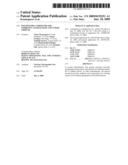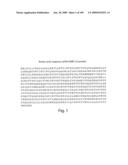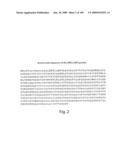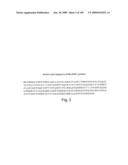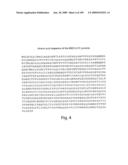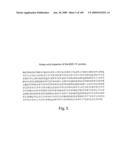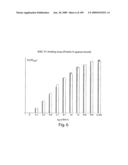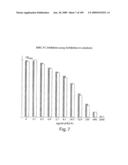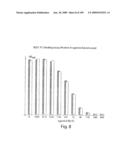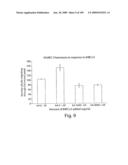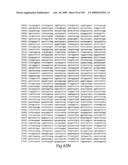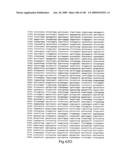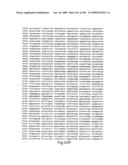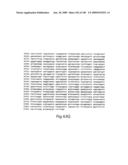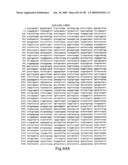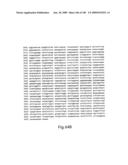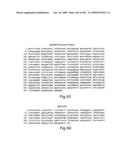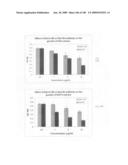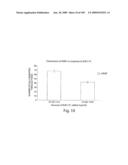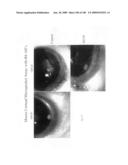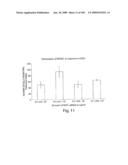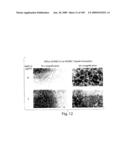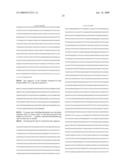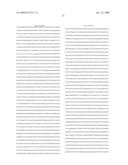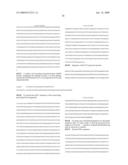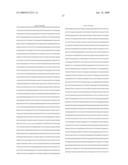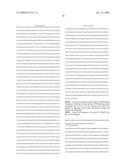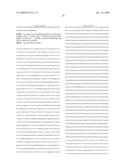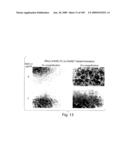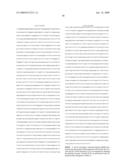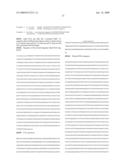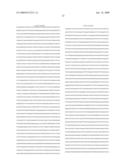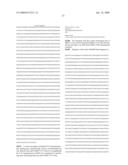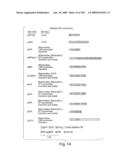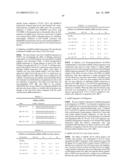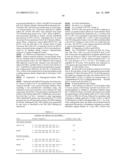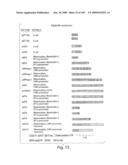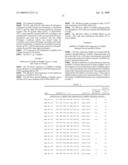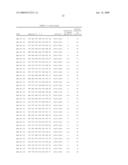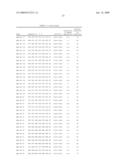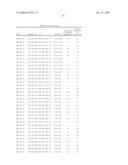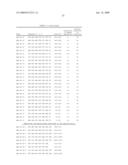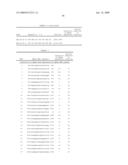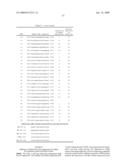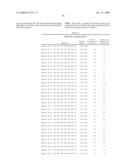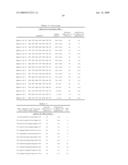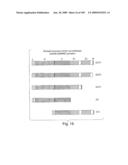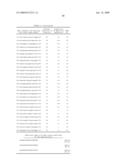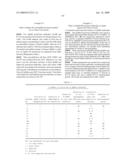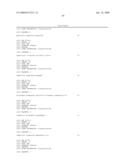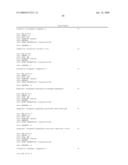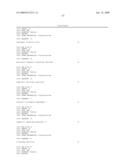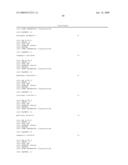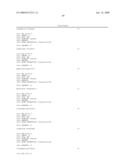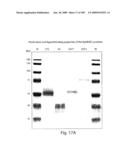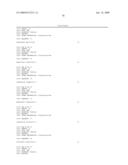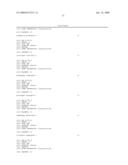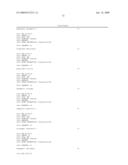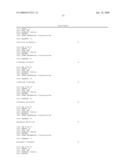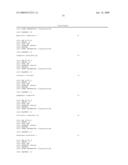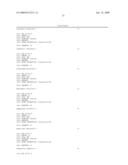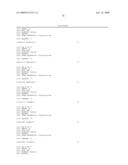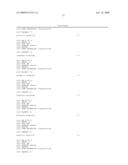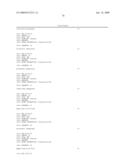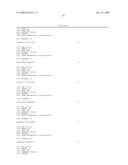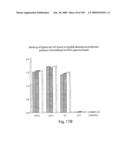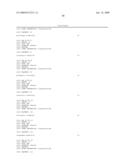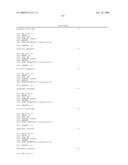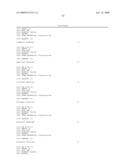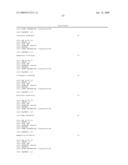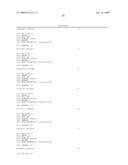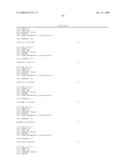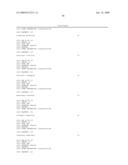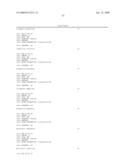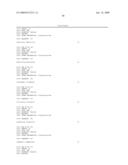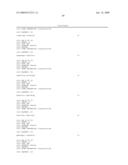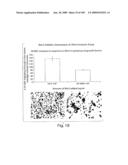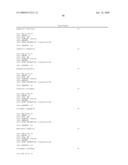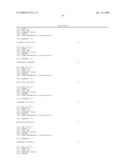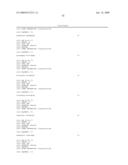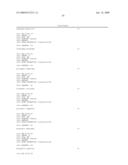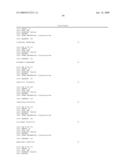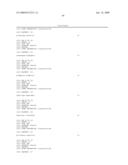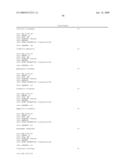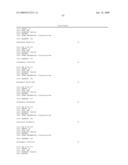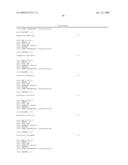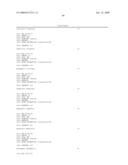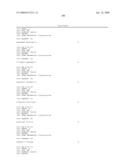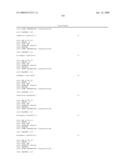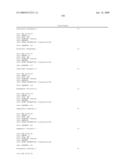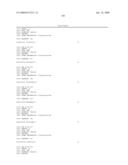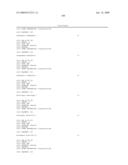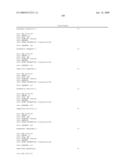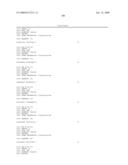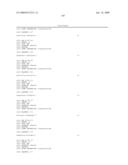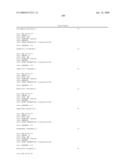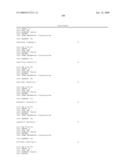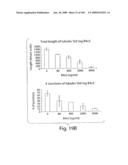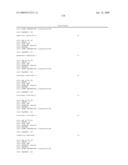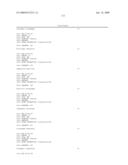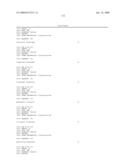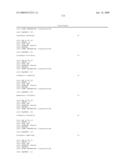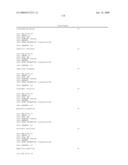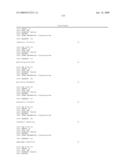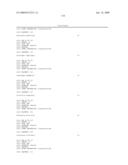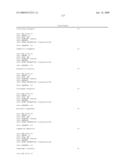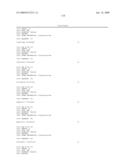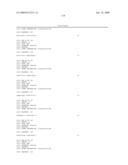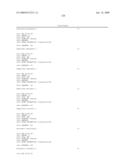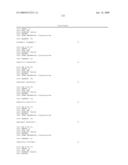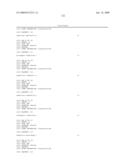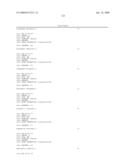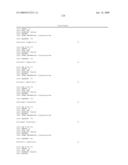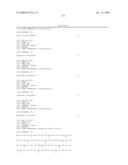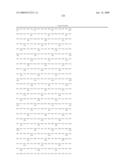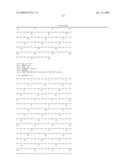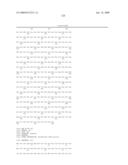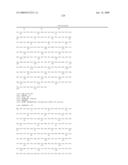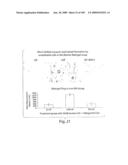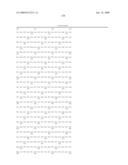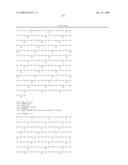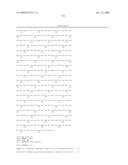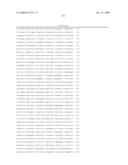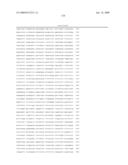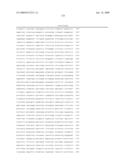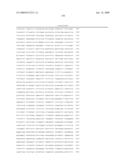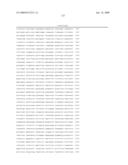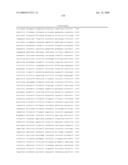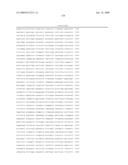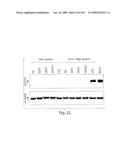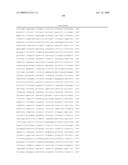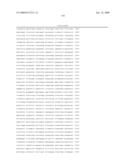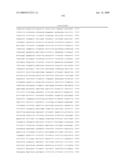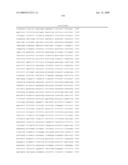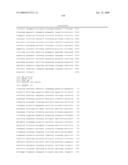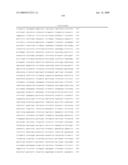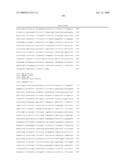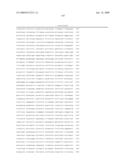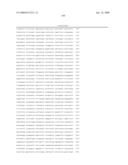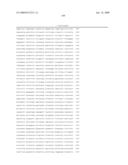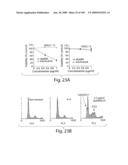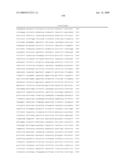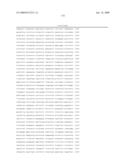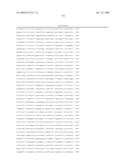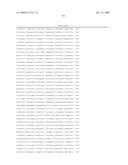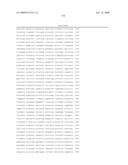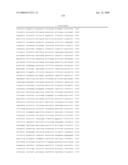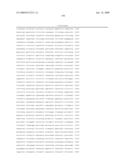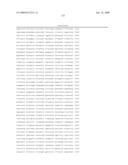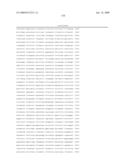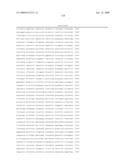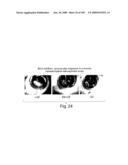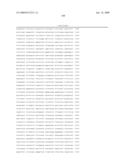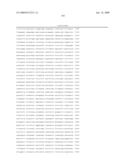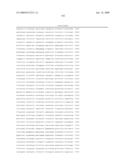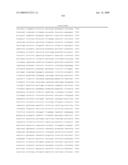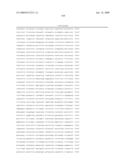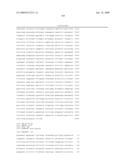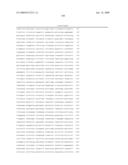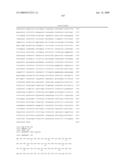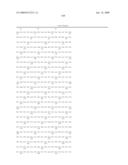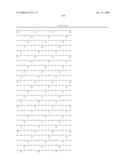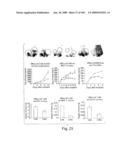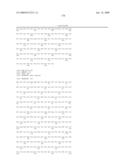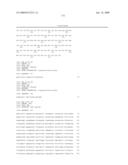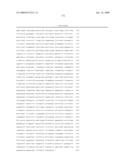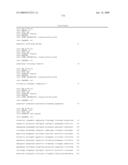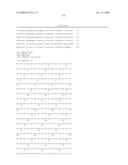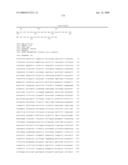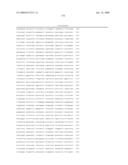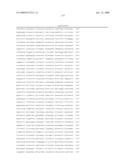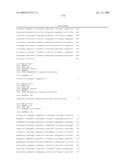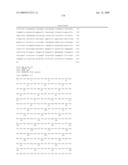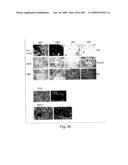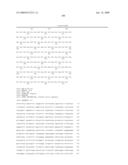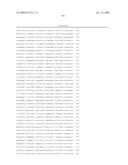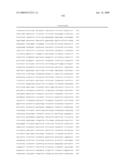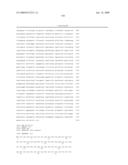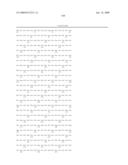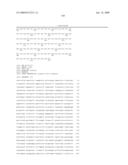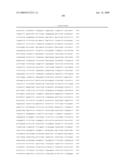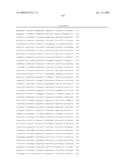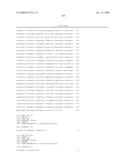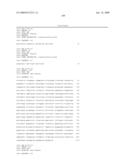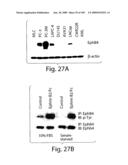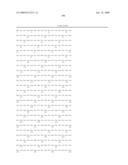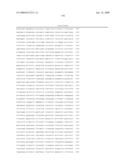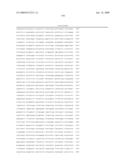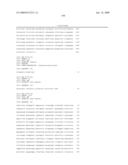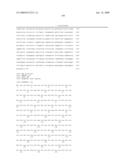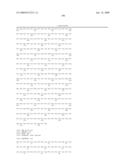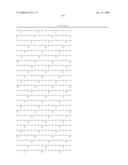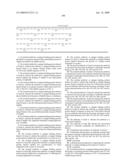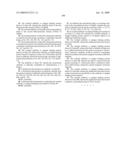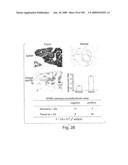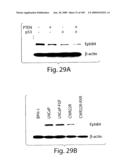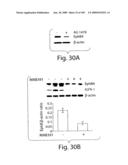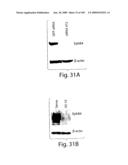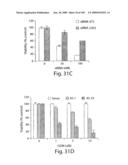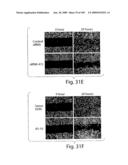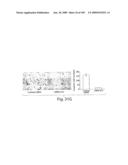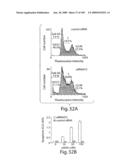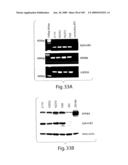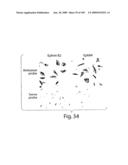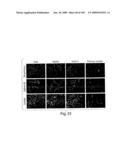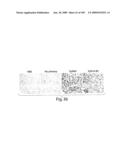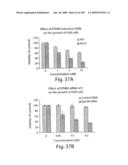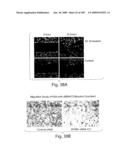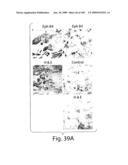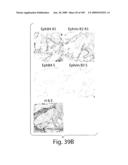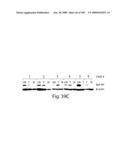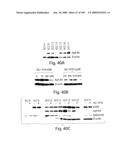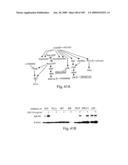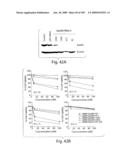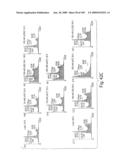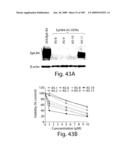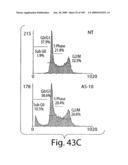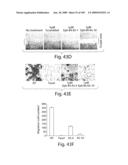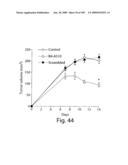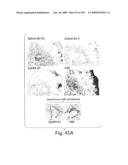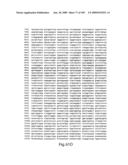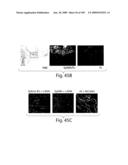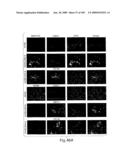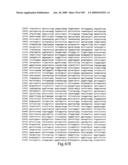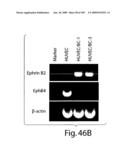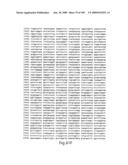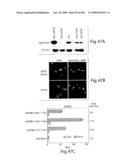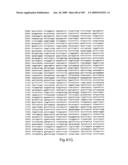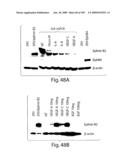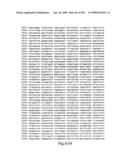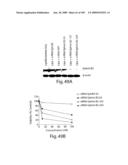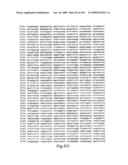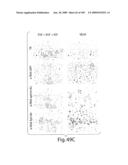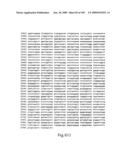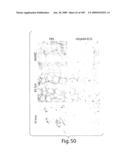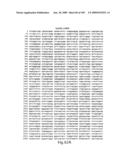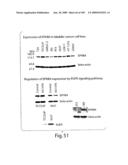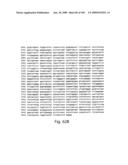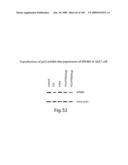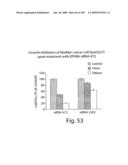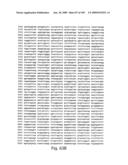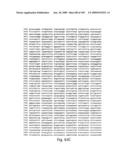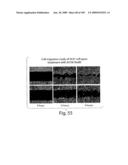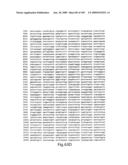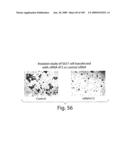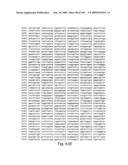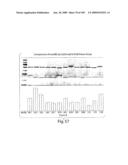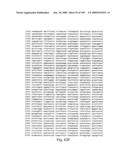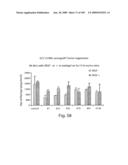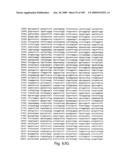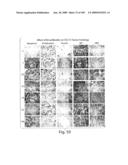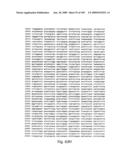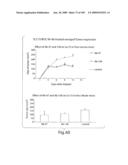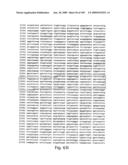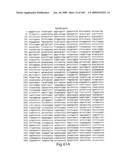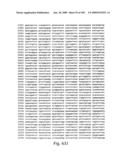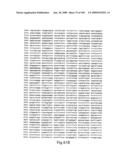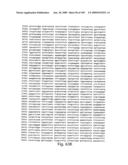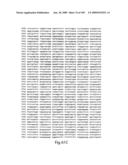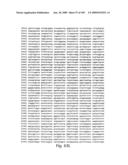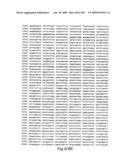Patent application title: Polypeptide compounds for inhibiting angiogenesis and tumor growth
Inventors:
Valery Krasnoperov (South Pasadena, CA, US)
Valery Krasnoperov (South Pasadena, CA, US)
Sergey Zozulya (San Diego, CA, US)
Nathalie Kertesz (Agoura Hills, CA, US)
Nathalie Kertesz (Agoura Hills, CA, US)
Ramachandra Reddy (Conshohocken, PA, US)
Parkash Gill (Agoura Hills, CA, US)
Parkash Gill (Agoura Hills, CA, US)
Assignees:
VasGene Therapeutics, Inc.
IPC8 Class: AA61K39395FI
USPC Class:
4241331
Class name: Drug, bio-affecting and body treating compositions immunoglobulin, antiserum, antibody, or antibody fragment, except conjugate or complex of the same with nonimmunoglobulin material structurally-modified antibody, immunoglobulin, or fragment thereof (e.g., chimeric, humanized, cdr-grafted, mutated, etc.)
Publication date: 2009-06-18
Patent application number: 20090155251
Claims:
1. An isolated antibody or antigen binding portion thereof that binds to
an epitope situated in the extracellular portion of EphB4 and inhibits an
EphB4 activity.
2. The isolated antibody or antigen binding portion thereof of claim 1, wherein the antibody or antigen binding portion thereof binds to an epitope situated within amino acids 16-198 of the EphB4 sequence of FIG. 1.
3. The isolated antibody or antigen binding portion thereof of claim 2, wherein the antibody or antigen binding portion thereof inhibits the binding of EphB4 to the extracellular portion of EphrinB2.
4. The isolated antibody or antigen binding portion thereof of claim 1, wherein the antibody or antigen binding portion thereof binds to an epitope situated within amino acids 327-427 or 428-537 of the EphB4 sequence of FIG. 1.
5. The isolated antibody or antigen binding portion thereof of claim 4, wherein the antibody or antigen binding portion thereof inhibits the formation of EphB4 dimers or multimers.
6. The isolated antibody or antigen binding portion thereof of claim 3, wherein the antibody or antigen binding portion thereof binds to the first fibronectin-like domain (FND1) of EphB4.
7. The isolated antibody or antigen binding portion thereof of claim 3, wherein the antibody or antigen binding portion thereof binds to the second fibronectin-like domain (FND2) of EphB4.
8. The isolated antibody or antigen binding portion thereof of claim 1, wherein the antibody or antigen binding portion thereof inhibits the EphrinB2-stimulated autophosphorylation of EphB4.
9. The isolated antibody or antigen binding portion thereof of claim 1, wherein the antibody or antigen binding portion thereof inhibits the formation of tubes by cultured endothelial cells.
10. The isolated antibody or antigen binding portion thereof of claim 1, wherein the antibody or antigen binding portion thereof inhibits the vascularization of a tissue in vivo.
11. The isolated antibody or antigen binding portion thereof of claim 10, wherein the antibody or antigen binding portion thereof inhibits the vascularization of tissue implanted in the cornea of an animal.
12. The isolated antibody or antigen binding portion thereof of claim 10, wherein the antibody or antigen binding portion thereof inhibits the vascularization of a Matrigel tissue plug implanted in an animal.
13. The isolated antibody or antigen binding portion thereof of claim 1, wherein the antibody or antigen binding portion thereof decreases the growth of a human tumor xenograft in a mouse.
14. The isolated antibody of claim 2, wherein the antibody is selected from the group consisting of antibodies denoted herein as No. 001, No. 023, No. 035, and No. 079.
15. The isolated antibody of claim 2, wherein the antibody is a humanized version of an antibody selected from the group consisting of antibodies denoted herein as No. 001, No. 023, No. 035, and No. 079.
16. The isolated antibody or antigen binding portion thereof of claim 2, wherein the antibody or antigen binding portion thereof comprises at least one CDR portion derived from an antibody selected from the group consisting of antibodies denoted herein as No. 001, No. 023, No. 035, and No. 079.
17. The isolated antibody of claim 4, wherein the antibody is selected from the group consisting of antibodies denoted herein as No. 047, No. 057, No. 85H, No. 098, and No.
18. The isolated antibody of claim 4, wherein the antibody is a humanized version of an antibody selected from the group consisting of antibodies denoted herein as No. 001, No. 023, No. 035, and No. 079.
19. The isolated antibody or antigen binding portion thereof of claim 4, wherein the antibody or antigen binding portion thereof comprises at least one CDR portion derived from an antibody selected from the group consisting of antibodies denoted herein as No. 001, No. 023, No. 035, and No. 079.
20. The antibody of claim 1, wherein the antibody is a monoclonal antibody.
21. The antibody of claim 20, wherein the monoclonal antibody is clinically acceptable for administration to a human.
22. A hybridoma that produces an antibody of claim 1.
23. A hybridoma that produces an antibody selected from the group consisting of antibodies denoted herein as No. 001, No. 023, No. 035, No. 079, No. 047, No. 057, No. 85H, No. 098, and No. 138.
24-29. (canceled)
30. A pharmaceutical preparation comprising the isolated antibody or antigen binding portion thereof of claim 1.
31-32. (canceled)
33. An isolated antibody or antigen binding portion thereof that binds to an epitope situated within amino acids 327-427 or 428-537 of the EphB4 sequence of FIG. 1 and stimulates EphB4 kinase activity.
34. The isolated antibody or antigen binding portion thereof of claim 33, wherein the antibody binds to the first fibronectin-like domain (FND1) of EphB4.
35. The isolated antibody of claim 34, wherein the antibody binds to the second fibronectin-like domain (FND2) of EphB4.
36. The isolated antibody of claim 33, wherein the antibody is selected from the group consisting of antibodies denoted herein as No. 85L, No. 091, No. 121, and No. 131.
37. The isolated antibody of claim 33, wherein the antibody is a humanized version of an antibody selected from the group consisting of antibodies denoted herein as No. 85L, No. 091, No. 121, and No. 131.
38. The isolated antibody or antigen binding portion thereof of claim 33, wherein the antibody or antigen binding portion thereof comprises at least one CDR portion derived from an antibody selected from the group consisting of antibodies denoted herein as No. 85L, No. 091, No. 121, and No. 131.
39. The antibody of claim 33, wherein the monoclonal antibody is clinically acceptable for administration to a human.
40. A hybridoma that produces an antibody of claim 33.
41. A hybridoma that produces an antibody selected from the group consisting of antibodies denoted herein as No. 001, No. 023, No. 035, No. 079, No. 047, No. 057, No. 85H, No. 098, and No. 138.
42-47. (canceled)
48. A pharmaceutical preparation comprising the isolated antibody or antigen binding portion thereof of claim 33.
49-50. (canceled)
51. An antibody that specifically binds to an epitope situated in the extracellular portion of EphB4, wherein the antibody is selected from the group consisting of Nos. 1, 23, 35, 47, 57, 79, 85L, 85H, 91, 98, 121, 131, and 138.
52. An isolated antibody or antigen binding portion thereof of claim 1 or claim 33, wherein the isolated antibody or antigen binding portion thereof is covalently linked to an additional functional moiety.
53. The isolated antibody or antigen binding portion thereof of claim 52, wherein the additional functional moiety is a label.
54. The isolated antibody or antigen binding portion thereof of claim 53, wherein the label is suitable for detection by a method selected from the group consisting of: fluorescence detection methods, positron emission tomography detection methods and nuclear magnetic resonance detection methods.
55. The isolated antibody or antigen binding portion thereof of claim 54, wherein the label is selected from the group consisting of: a fluorescent label, a radioactive label, and a label having a distinctive nuclear magnetic resonance signature.
56. The isolated antibody or antigen binding portion thereof of claim 52, wherein the additional functional moiety confers increased serum half-life on the antibody or antigen binding portion thereof.
57. The isolated antibody or antigen binding portion thereof of claim 56, wherein the additional functional moiety comprises a polyethylene glycol (PEG) moiety.
Description:
RELATED APPLICATIONS
[0001]This application is a continuation-in-part of U.S. patent application Ser. No. 10/800,350, filed Mar. 12, 2004, which claims the benefit of priority of U.S. Provisional Application No. 60/454,300 filed Mar. 12, 2003 and U.S. Provisional Application No. 60/454,432 filed Mar. 12, 2003. The entire teachings of the referenced Applications are incorporated herein by reference in their entirety.
BACKGROUND OF THE INVENTION
[0002]Angiogenesis, the development of new blood vessels from the endothelium of a preexisting vasculature, is a critical process in the growth, progression, and metastasis of solid tumors within the host. During physiologically normal angiogenesis, the autocrine, paracrine, and amphicrine interactions of the vascular endothelium with its surrounding stromal components are tightly regulated both spatially and temporally. Additionally, the levels and activities of proangiogenic and angiostatic cytokines and growth factors are maintained in balance. In contrast, the pathological angiogenesis necessary for active tumor growth is sustained and persistent, representing a dysregulation of the normal angiogenic system. Solid and hematopoietic tumor types are particularly associated with a high level of abnormal angiogenesis.
[0003]It is generally thought that the development of tumor consists of sequential, and interrelated steps that lead to the generation of an autonomous clone with aggressive growth potential. These steps include sustained growth and unlimited self-renewal. Cell populations in a tumor are generally characterized by growth signal self-sufficiency, decreased sensitivity to growth suppressive signals, and resistance to apoptosis. Genetic or cytogenetic events that initiate aberrant growth sustain cells in a prolonged "ready" state by preventing apoptosis.
[0004]It is a goal of the present disclosure to provide agents and therapeutic treatments for inhibiting angiogenesis and tumor growth.
SUMMARY OF THE INVENTION
[0005]In certain aspects, the disclosure provides polypeptide agents that inhibit EphB4 or EphrinB2 mediated functions, including monomeric ligand binding portions of the EphB4 and EphrinB2 proteins and antibodies that bind to and affect EphB4 or EphrinB2 in particular ways. As demonstrated herein, EphB4 and EphrinB2 participate in various disease states, including cancers and diseases related to unwanted or excessive angiogenesis. Accordingly, certain polypeptide agents disclosed herein may be used to treat such diseases. In further aspects, the disclosure relates to the discovery that EphB4 and/or EphrinB2 are expressed, often at high levels, in a variety of tumors. Therefore, polypeptide agents that downregulate EphB4 or EphrinB2 function may affect tumors by a direct effect on the tumor cells as well as an indirect effect on the angiogenic processes recruited by the tumor. In certain embodiments, the disclosure provides the identity of tumor types particularly suited to treatment with an agent that downregulates EphB4 or EphrinB2 function.
[0006]In certain aspects, the disclosure provides soluble EphB4 polypeptides comprising an amino acid sequence of an extracellular domain of an EphB4 protein. The soluble EphB4 polypeptides bind specifically to an EphrinB2 polypeptide. The term "soluble" is used merely to indicate that these polypeptides do not contain a transmembrane domain or a portion of a transmembrane domain sufficient to compromise the solubility of the polypeptide in a physiological salt solution. Soluble polypeptides are preferably prepared as monomers that compete with EphB4 for binding to ligand such as EphrinB2 and inhibit the signaling that results from EphB4 activation. Optionally, a soluble polypeptide may be prepared in a multimeric form, by, for example, expressing as an Fc fusion protein or fusion with another multimerization domain. Such multimeric forms may have complex activities, having agonistic or antagonistic effects depending on the context. In certain embodiments the soluble EphB4 polypeptide comprises a globular domain of an EphB4 protein. A soluble EphB4 polypeptide may comprise a sequence at least 90% identical to residues 1-522 of the amino acid sequence defined by FIG. 65. A soluble EphB4 polypeptide may comprise a sequence at least 90% identical to residues 1-412 of the amino acid sequence defined by FIG. 65. A soluble EphB4 polypeptide may comprise a sequence at least 90% identical to residues 1-312 of the amino acid sequence defined by FIG. 65. A soluble EphB4 polypeptide may comprise a sequence encompassing the globular (G) domain (amino acids 29-197 of FIG. 65), and optionally additional domains, such as the cysteine-rich domain (amino acids 239-321 of FIG. 65), the first fibronectin type 3 domain (amino acids 324-429 of FIG. 65) and the second fibronectin type 3 domain (amino acids 434-526 of FIG. 65). Preferred polypeptides described herein and demonstrated as having ligand binding activity include polypeptides corresponding to 1-537, 1-427 and 1-326, respectively, of the amino acid sequence shown in FIG. 65. A soluble EphB4 polypeptide may comprise a sequence as set forth in FIG. 1 or 2. As is well known in the art, expression of such EphB4 polypeptides in a suitable cell, such as HEK293T cell line, will result in cleavage of a leader peptide. Although such cleavage is not always complete or perfectly consistent at a single site, it is known that EphB4 tends to be cleaved so as to remove the first 15 amino acids of the sequence shown in FIG. 65. Accordingly, as specific examples, the disclosure provides unprocessed soluble EphB4 polypeptides that bind to EphrinB2 and comprise an amino acid sequence selected from the following group (numbering is with respect to the sequence of FIG. 65): 1-197, 29-197, 1-312, 29-132, 1-321, 29-321, 1-326, 29-326, 1-412, 29-412, 1-427, 29-427, 1-429, 29-429, 1-526, 29-526, 1-537 and 29-537. Such polypeptides may be used in a processed form, such forms having a predicted amino acid sequence selected from the following group (numbering is with respect to the sequence of FIG. 65): 16-197, 16-312, 16-321, 16-326, 16-412, 16-427, 16-429, 16-526 and 16-537. Additionally, a soluble EphB4 polypeptide may be one that comprises an amino acid sequence at least 90%, and optionally 95% or 99% identical to any of the preceding amino acid sequences while retaining EphrinB2 binding activity. Preferably, any variations in the amino acid sequence from the sequence shown in FIG. 65 are conservative changes or deletions of no more than 1, 2, 3, 4 or 5 amino acids, particularly in a surface loop region. In certain embodiments, the soluble EphB4 polypeptide may inhibit the interaction between Ephrin B2 and EphB4. The soluble EphB4 polypeptide may inhibit clustering of or phosphorylation of Ephrin B2 or EphB4. Phosphorylation of EphrinB2 or EphB4 is generally considered to be one of the initial events in triggering intracellular signaling pathways regulated by these proteins. As noted above, the soluble EphB4 polypeptide may be prepared as a monomeric or multimeric fusion protein. The soluble polypeptide may include one or more modified amino acids. Such amino acids may contribute to desirable properties, such as increased resistance to protease digestion.
[0007]In certain aspects, the disclosure provides soluble EphrinB2 polypeptides comprising an amino acid sequence of an extracellular domain of an EphrinB2 protein. The soluble EphrinB2 polypeptides bind specifically to an EphB4 polypeptide. The term "soluble" is used merely to indicate that these polypeptides do not contain a transmembrane domain or a portion of a transmembrane domain sufficient to compromise the solubility of the polypeptide in a physiological salt solution. Soluble polypeptides are preferably prepared as monomers that compete with EphrinB2 for binding to ligand such as EphB4 and inhibit the signaling that results from EphrinB2 activation. Optionally, a soluble polypeptide may be prepared in a multimeric form, by, for example, expressing as an Fc fusion protein or fusion with another multimerization domain. Such multimeric forms may have complex activities, having agonistic or antagonistic effects depending on the context. A soluble EphrinB2 polypeptide may comprise residues 1-225 of the amino acid sequence defined by FIG. 66. A soluble EphrinB2 polypeptide may comprise a sequence defined by FIG. 3. As is well known in the art, expression of such EphrinB2 polypeptides in a suitable cell, such as HEK293T cell line, will result in cleavage of a leader peptide. Although such cleavage is not always complete or perfectly consistent at a single site, it is known that EphrinB2 tends to be cleaved so as to remove the first 26 amino acids of the sequence shown in FIG. 66. Accordingly, as specific examples, the disclosure provides unprocessed soluble EphrinB2 polypeptides that bind to EphB4 and comprise an amino acid sequence corresponding to amino acids 1-225 of FIG. 66. Such polypeptides may be used in a processed form, such forms having a predicted amino acid sequence selected from the following group (numbering is with respect to the sequence of FIG. 66): 26-225. In certain embodiments, the soluble EphrinB2 polypeptide may inhibit the interaction between Ephrin B2 and EphB4. The soluble EphrinB2 polypeptide may inhibit clustering of or phosphorylation of EphrinB2 or EphB4. As noted above, the soluble EphrinB2 polypeptide may be prepared as a monomeric or multimeric fusion protein. The soluble polypeptide may include one or more modified amino acids. Such amino acids may contribute to desirable properties, such as increased resistance to protease digestion.
[0008]In certain aspects, the disclosure provides antagonist antibodies for EphB4 and EphrinB2. An antibody may be designed to bind to an extracellular domain of an EphB4 protein and inhibit an activity of the EphB4. An antibody may be designed to bind to an extracellular domain of an Ephrin B2 protein and inhibit an activity of the Ephrin B2. An antibody may be designed to inhibit the interaction between Ephrin B2 and EphB4. An antagonist antibody will generally affect Eph and/or Ephrin signaling. For example, an antibody may inhibit clustering or phosphorylation of Ephrin B2 or EphB4. An antagonist antibody may be essentially any polypeptide comprising a variable portion of an antibody, including, for example, monoclonal and polyclonal antibodies, single chain antibodies, diabodies, minibodies, etc.
[0009]In certain aspects, the disclosure provides pharmaceutical formulations comprising a polypeptide reagent and a pharmaceutically acceptable carrier. The polypeptide reagent may be any disclosed herein, including, for example, soluble EphB4 or EphrinB2 polypeptides and antagonist antibodies. Additional formulations include cosmetic compositions and diagnostic kits.
[0010]In certain aspects the disclosure provides methods of inhibiting signaling through Ephrin B2/EphB4 pathway in a cell. A method may comprise contacting the cell with an effective amount of a polypeptide agent, such as (a) a soluble polypeptide comprising an amino acid sequence of an extracellular domain of an EphB4 protein, wherein the EphB4 polypeptide is a monomer and binds specifically to an Ephrin B2 polypeptide; (b) a soluble polypeptide comprising an amino acid sequence of an extracellular domain of an Ephrin B2 protein, wherein the soluble Ephrin B2 polypeptide is a monomer and binds with high affinity to an EphB4 polypeptide; (c) an antibody which binds to an extracellular domain of an EphB4 protein and inhibits an activity of the EphB4; or (d) an antibody which binds to an extracellular domain of an Ephrin B2 protein and inhibits an activity of the Ephrin B2.
[0011]In certain aspects the disclosure provides methods for reducing the growth rate of a tumor, comprising administering an amount of a polypeptide agent sufficient to reduce the growth rate of the tumor, wherein the polypeptide agent is selected from the group consisting of: (a) a soluble polypeptide comprising an amino acid sequence of an extracellular domain of an EphB4 protein, wherein the EphB4 polypeptide is a monomer and binds specifically to an Ephrin B2 polypeptide; (b) a soluble polypeptide comprising an amino acid sequence of an extracellular domain of an Ephrin B2 protein, wherein the soluble Ephrin B2 polypeptide is a monomer and binds with high affinity to an EphB4 polypeptide; (c) an antibody which binds to an extracellular domain of an EphB4 protein and inhibits an activity of the EphB4; and (d) an antibody which binds to an extracellular domain of an Ephrin B2 protein and inhibits an activity of the Ephrin B2. Optionally, the tumor comprises cells expressing a higher level of EphB4 and/or EphrinB2 than noncancerous cells of a comparable tissue.
[0012]In certain aspects, the disclosure provides methods for treating a patient suffering from a cancer. A method may comprise administering to the patient a polypeptide agent selected from the group consisting of: (a) a soluble polypeptide comprising an amino acid sequence of an extracellular domain of an EphB4 protein, wherein the EphB4 polypeptide is a monomer and binds specifically to an Ephrin B2 polypeptide; (b) a soluble polypeptide comprising an amino acid sequence of an extracellular domain of an Ephrin B2 protein, wherein the soluble Ephrin B2 polypeptide is a monomer and binds with high affinity to an EphB4 polypeptide; (c) an antibody which binds to an extracellular domain of an EphB4 protein and inhibits an activity of the EphB4; and (d) an antibody which binds to an extracellular domain of an Ephrin B2 protein and inhibits an activity of the Ephrin B2. Optionally, the cancer comprises cancer cells expressing EphrinB2 and/or EphB4 at a higher level than noncancerous cells of a comparable tissue. The cancer may be a metastatic cancer. The cancer may be selected from the group consisting of colon carcinoma, breast tumor, mesothelioma, prostate tumor, squamous cell carcinoma, Kaposi sarcoma, and leukemia. Optionally, the cancer is an angiogenesis-dependent cancer or an angiogenesis independent cancer. The polypeptide agent employed may inhibit clustering or phosphorylation of Ephrin B2 or EphB4. A polypeptide agent may be co-administered with one or more additional anti-cancer chemotherapeutic agents that inhibit cancer cells in an additive or synergistic manner with the polypeptide agent.
[0013]In certain aspects, the disclosure provides methods of inhibiting angiogenesis. A method may comprise contacting a cell with an amount of a polypeptide agent sufficient to inhibit angiogenesis, wherein the polypeptide agent is selected from the group consisting of: (a) a soluble polypeptide comprising an amino acid sequence of an extracellular domain of an EphB4 protein, wherein the EphB4 polypeptide is a monomer and binds specifically to an Ephrin B2 polypeptide; (b) a soluble polypeptide comprising an amino acid sequence of an extracellular domain of an Ephrin B2 protein, wherein the soluble Ephrin B2 polypeptide is a monomer and binds with high affinity to an EphB4 polypeptide; (c) an antibody which binds to an extracellular domain of an EphB4 protein and inhibits an activity of the EphB4; and (d) an antibody which binds to an extracellular domain of an Ephrin B2 protein and inhibits an activity of the Ephrin B2.
[0014]In certain aspects, the disclosure provides methods for treating a patient suffering from an angiogenesis-associated disease, comprising administering to the patient a polypeptide agent selected from the group consisting of: (a) a soluble polypeptide comprising an amino acid sequence of an extracellular domain of an EphB4 protein, wherein the EphB4 polypeptide is a monomer and binds specifically to an Ephrin B2 polypeptide; (b) a soluble polypeptide comprising an amino acid sequence of an extracellular domain of an Ephrin B2 protein, wherein the soluble Ephrin B2 polypeptide is a monomer and binds with high affinity to an EphB4 polypeptide; (c) an antibody which binds to an extracellular domain of an EphB4 protein and inhibits an activity of the EphB4; and (d) an antibody which binds to an extracellular domain of an Ephrin B2 protein and inhibits an activity of the Ephrin B2. The soluble polypeptide may be formulated with a pharmaceutically acceptable carrier. An angiogenesis related disease or unwanted angiogenesis related process may be selected from the group consisting of angiogenesis-dependent cancer, benign tumors, inflammatory disorders, chronic articular rheumatism and psoriasis, ocular angiogenic diseases, Osler-Webber Syndrome, myocardial angiogenesis, plaque neovascularization, telangiectasia, hemophiliac joints, angiofibroma, wound granulation, wound healing, telangiectasia psoriasis scleroderma, pyogenic granuloma, cororany collaterals, ischemic limb angiogenesis, rubeosis, arthritis, diabetic neovascularization, fractures, vasculogenesis, and hematopoiesis. An polypeptide agent may be co-administered with at least one additional anti-angiogenesis agent that inhibits angiogenesis in an additive or synergistic manner with the soluble polypeptide.
[0015]In certain aspects, the disclosure provides for the use of a polypeptide agent in the manufacture of medicament for the treatment of cancer or an angiogenesis related disorder, wherein the polypeptide agent is selected from the group consisting of: (a) a soluble polypeptide comprising an amino acid sequence of an extracellular domain of an EphB4 protein, wherein the EphB4 polypeptide is a monomer and binds specifically to an Ephrin B2 polypeptide; (b) a soluble polypeptide comprising an amino acid sequence of an extracellular domain of an Ephrin B2 protein, wherein the soluble Ephrin B2 polypeptide is a monomer and binds with high affinity to an EphB4 polypeptide; (c) an antibody which binds to an extracellular domain of an EphB4 protein and inhibits an activity of the EphB4; and (d) an antibody which binds to an extracellular domain of an Ephrin B2 protein and inhibits an activity of the Ephrin B2.
[0016]In certain aspects, the disclosure provides methods for treating a patient suffering from a cancer, comprising: (a) identifying in the patient a tumor having a plurality of cancer cells that express EphB4 and/or EphrinB2; and (b) administering to the patient a polypeptide agent selected from the group consisting of: (i) a soluble polypeptide comprising an amino acid sequence of an extracellular domain of an EphB4 protein, wherein the EphB4 polypeptide is a monomer and binds specifically to an Ephrin B2 polypeptide; (ii) a soluble polypeptide comprising an amino acid sequence of an extracellular domain of an Ephrin B2 protein, wherein the soluble EphrinB2 polypeptide is a monomer and binds with high affinity to an EphB4 polypeptide; (iii) an antibody which binds to an extracellular domain of an EphB4 protein and inhibits an activity of the EphB4; and (iv) an antibody which binds to an extracellular domain of an Ephrin B2 protein and inhibits an activity of the Ephrin B2. Optionally, a method may comprise identifying in the patient a tumor having a plurality of cancer cells having a gene amplification of the EphB4 and/or EphrinB2 gene.
[0017]In certain aspects, the disclosure provides methods for identifying a tumor that is suitable for treatment with an EphrinB2 or EphB4 antagonist. A method may comprise detecting in the tumor cell one or more of the following characteristics: (a) expression of EphB4 protein and/or mRNA; (b) expression of EphrinB2 protein and/or mRNA; (c) gene amplification of the EphB4 gene; or (d) gene amplification of the EphrinB2 gene. A tumor cell having one or more of characteristics (a)-(d) may be suitable for treatment with an EphrinB2 or EphB4 antagonist, such as a polypeptide agent described herein.
[0018]In certain aspects, the disclosure provides polypeptide agents that inhibit EphB4 mediated functions, including antibodies and antigen binding portions thereof that bind to and affect EphB4 in particular ways. As demonstrated herein, EphB4 and EphrinB2 participate in various disease states, including cancers and diseases related to unwanted or excessive angiogenesis. Accordingly, certain polypeptide agents disclosed herein may be used to treat such diseases. In further aspects, the disclosure relates to the discovery that EphB4 and/or EphrinB2 are expressed, often at high levels, in a variety of tumors. Therefore, polypeptide agents that downregulate EphB4 or EphrinB2 function may affect tumors by a direct effect on the tumor cells as well as an indirect effect on the angiogenic processes recruited by the tumor. In certain embodiments, the disclosure provides the identity of tumor types particularly suited to treatment with an agent that downregulates EphB4 or EphrinB2 function.
[0019]In certain aspects, the disclosure provides an isolated antibody or antigen binding portion thereof that binds to an epitope situated in the extracellular portion of EphB4 and inhibits an EphB4 activity. The isolated antibody or antigen binding portion thereof may binds to an epitope situated within amino acids 16-198 of the EphB4 sequence of FIG. 1. For example, the epitope may be situated within the Globular Domain (GD) of EphB4 that binds to EphrinB2. The isolated antibody or antigen binding portion thereof may inhibit the binding of EphB4 to the extracellular portion of EphrinB2. The isolated antibody or antigen binding portion thereof may bind to an epitope situated within amino acids 327-427 or 428-537 of the EphB4 sequence of FIG. 1. For example, the isolated antibody or antigen binding portion thereof may bind to the first fibronectin-like domain (FND1) or the second fibronectin-like domain (FND2) of EphB4. The isolated antibody or antigen binding portion thereof may inhibit EphB4 dimerization or multimerization and may optionally inhibit the EphrinB2-stimulated autophosphorylation of EphB4. The isolated antibody or antigen binding portion thereof may inhibit the formation of tubes by cultured endothelial cells, the vascularization of a tissue in vivo, the vascularization of tissue implanted in the cornea of an animal, the vascularization of a Matrigel tissue plug implanted in an animal, and/or the growth of a human tumor xenograft in a mouse. Preferred antibodies that bind to an epitope situated within amino acids 16-198 of the EphB4 sequence of FIG. 1 include antibodies denoted herein as No. 001, No. 023, No. 035, and No. 079. Preferred antibodies that bind to an epitope situated within amino acids 428-537 of the EphB4 sequence of FIG. 1 include antibodies denoted herein as No. 047, No. 057, No. 85H, No. 098, and No. 138.
[0020]In certain aspects, the disclosure provides an isolated antibody or antigen binding portion thereof that binds to an epitope situated in the extracellular portion of EphB4 and stimulates EphB4 kinase activity. For example, described herein are isolated antibodies or antigen binding portion thereof that bind to an epitope situated within amino acids 327-427 of the EphB4 sequence of FIG. 1 and stimulate EphB4 kinase activity. The isolated antibody or antigen binding portion thereof may bind to the first fibronectin-like domain (FND1) of EphB4. The antibody may be selected from the group consisting of antibodies denoted herein as No. 85L, No. 091, No. 121, and No. 131.
[0021]The disclosure provides humanized versions of any of the antibodies disclosed herein, as well as antibodies and antigen binding portions thereof that comprise at least one CDR portion derived from an antibody disclosed herein, particularly the CDR3. In preferred embodiments, the antibody is a monoclonal antibody that is immunocompatible with the subject to which it is to be administered, and preferably is clinically acceptable for administration to a human.
[0022]In certain aspects, the disclosure provides a hybridoma that produces an antibody disclosed herein, and particularly a hybridoma that produces an antibody selected from the group consisting of antibodies denoted herein as No. 001, No. 023, No. 035, No. 079, No. 047, No. 057, No. 85H, No. 098, No. 138, No. 085L, NO. 091 and No. 131. Hybridomas producing antibody No. 098 (epitope within amino acids 428-537), antibody No. 091 (kinase activating antibody; epitope within amino acids 327-427), antibody No. 023 (epitope within amino acids 16-198) and antibody No. 138 (epitope within amino acids 428-537) were deposited in the American Type Culture Collection (ATCC), 10801 University Boulevard, Manassas, Va. 20110-2209 on Sep. 14, 2004.
[0023]Surprisingly, antibodies that inhibit ligand binding, antibodies that inhibit EphB4 kinase activation and antibodies that activate EphB4 kinase activity all inhibit EphB4 mediated events in bioassays. Accordingly, the disclosure provides a method of treating cancer, the method comprising administering to a patient in need thereof an effective amount of an isolated antibody or antigen binding portion thereof that binds to an epitope situated in the extracellular portion of EphB4 and either inhibits an EphB4 activity or activates EphB4 kinase activity. Optionally the patient has been diagnosed with a cancer selected from the group consisting of colon carcinoma, breast tumor, mesothelioma, prostate tumor, squamous cell carcinoma, Kaposi sarcoma, and leukemia. The isolated antibody or antigen binding portion thereof may be administered systemically or locally. Additionally, the disclosure provides methods of inhibiting angiogenesis in a patient, the method comprising administering to a patient in need thereof an effective amount of an isolated antibody or antigen binding portion thereof that binds to an epitope situated in the extracellular portion of EphB4 and inhibits an EphB4 activity or activates an EphB4 kinase activity. Optionally, the patient is diagnosed macular degeneration.
[0024]In certain aspects, the disclosure provides a pharmaceutical preparation comprising any of the isolated antibodies or antigen binding portions thereof disclosed herein, as well as the use of such antibodies or antigen binding portions thereof to make a pharmaceutical preparation for treating cancer. Optionally, the cancer is selected from the group consisting of colon carcinoma, breast tumor, mesothelioma, prostate tumor, squamous cell carcinoma, Kaposi sarcoma, and leukemia.
[0025]In certain aspects, the antibodies disclosed herein may be covalently linked (or otherwise stably associated with) an additional functional moiety, such as a label or a moiety that confers desirable pharmacokinetic properties. Exemplary labels include those that are suitable for detection by a method selected from the group consisting of: fluorescence detection methods, positron emission tomography detection methods and nuclear magnetic resonance detection methods. Labels may, for example, be selected from the group consisting of: a fluorescent label, a radioactive label, and a label having a distinctive nuclear magnetic resonance signature. Moieties such as a polyethylene glycol (PEG) moiety may be affixed to an antibody or antigen binding portion thereof to increase serum half-life.
BRIEF DESCRIPTION OF THE DRAWINGS
[0026]FIG. 1 shows amino acid sequence of the B4ECv3 protein (predicted sequence of the precursor including uncleaved Eph B4 leader peptide is shown).
[0027]FIG. 2 shows amino acid sequence of the B4ECv3NT protein (predicted sequence of the precursor including uncleaved Eph B4 leader peptide is shown).
[0028]FIG. 3 shows amino acid sequence of the B2EC protein (predicted sequence of the precursor including uncleaved Ephrin B2 leader peptide is shown).
[0029]FIG. 4 shows amino acid sequence of the B4ECv3-FC protein (predicted sequence of the precursor including uncleaved Eph B4 leader peptide is shown).
[0030]FIG. 5 shows amino acid sequence of the B2EC-FC protein (predicted sequence of the precursor including uncleaved Ephrin B2 leader peptide is shown).
[0031]FIG. 6 shows B4EC-FC binding assay (Protein A-agarose based).
[0032]FIG. 7 shows B4EC-FC inhibition assay (Inhibition in solution).
[0033]FIG. 8 shows B2EC-FC binding assay (Protein-A-agarose based assay).
[0034]FIG. 9 shows chemotaxis of HUAEC in response to B4Ecv3.
[0035]FIG. 10 shows chemotaxis of HHEC in response to B2EC-FC.
[0036]FIG. 11 shows chemotaxis of HHAEC in response to B2EC.
[0037]FIG. 12 shows effect of B4Ecv3 on HUAEC tubule formation.
[0038]FIG. 13 shows effect of B2EC-FC on HUAEC tubule formation.
[0039]FIG. 14 is a schematic representation of human Ephrin B2 constructs.
[0040]FIG. 15 is a schematic representation of human EphB4 constructs.
[0041]FIG. 16 shows the domain structure of the recombinant soluble EphB4EC proteins. Designation of the domains are as follows: L--leader peptide, G--globular (ligand-binding domain), C--Cys-rich domain, F1, F2--fibronectin type III repeats, H--6×His-tag.
[0042]FIG. 17 shows purification and ligand binding properties of the EphB4EC proteins. A. SDS-PAAG gel electrophoresis of purified EphB4-derived recombinant soluble proteins (Coomassie-stained). B. Binding of Ephrin B2-AP fusion to EphB4-derived recombinant proteins immobilized on Ni-NTA-agarose beads. Results of three independent experiments are shown for each protein. Vertical axis--optical density at 420 nm.
[0043]FIG. 18 shows that EphB4v3 inhibits chemotaxis.
[0044]FIG. 19 shows that EphB4v3 inhibits tubule formation on Matrigel. A displays the strong inhibition of tubule formation by B4v3 in a representative experiment. B shows a quantitation of the reduction of tube-length obtained with B4v3 at increasing concentrations as well as a reduction in the number of junctions, in comparison to cells with no protein. Results are displayed as mean values ±S.D. obtained from three independent experiments performed with duplicate wells.
[0045]FIG. 20 shows that soluble EphB4 has no detectable cytotoxic effect as assessed by MTS assay.
[0046]FIG. 21 shows that B4v3 inhibits invasion and tubule formation by endothelial cells in the Matrigel assay. (A) to detect total invading cells, photographed at 20× magnification or with Masson's Trichrome Top left of A B displays section of a Matrigel plug with no GF, top right of A displays section with B4IgG containing GF and lower left section contains GF, and lower right shows GF in the presence of B4v3. Significant invasion of endothelial cells is only seen in GF containing Matrigel. Top right displays an area with a high number of invaded cells induced by B4IgG, which signifies the dimeric form of B4v3. The left upper parts of the pictures correspond to the cell layers formed around the Matrigel plug from which cells invade toward the center of the plug located in the direction of the right lower corner. Total cells in sections of the Matrigel plugs were quantitated with Scion Image software. Results obtained from two experiments with duplicate plugs are displayed as mean values ±S.D.
[0047]FIG. 22 shows tyrosine phosphorylation of EphB4 receptor in PC3 cells in response to stimulation with EphrinB2-Fc fusion in presence or absence of EphB4-derived recombinant soluble proteins.
[0048]FIG. 23 shows effects of soluble EphB4ECD on viability and cell cycle. A) 3-day cell viability assay of two HNSCC cell lines. B) FACS analysis of cell cycle in HNSCC-15 cells treated as in A. Treatment of these cells resulted in accumulation in subG0/G1 and S/G2 phases as indicated by the arrows.
[0049]FIG. 24 shows that B4v3 inhibits neovascular response in a murine corneal hydron micropocket assay.
[0050]FIG. 25 shows that that SCC15, B16, and MCF-7 co-injected with sB4v3 in the presence of matrigel and growth factors, inhibits the in vivo tumor growth of these cells.
[0051]FIG. 26 shows that soluble EphB4 causes apoptosis, necrosis and decreased angiogenesis in three tumor types, B16 (melanoma), SCC 15 (head and neck carcinoma), and MCF-7 (breast carcinoma). Tumors were injected premixed with Matrigel plus growth factors and soluble EphB4 subcutaneously. After 10 to 14 days, the mice were injected intravenously with fitc-lectin (green) to assess blood vessel perfusion. Tumors treated with control PBS displayed abundant tumor density and a robust angiogenic response. Tumors treated with sEphB4 displayed a decrease in tumor cell density and a marked inhibition of tumor angiogenesis in regions with viable tumor cells, as well as tumor necrosis and apoptosis.
[0052]FIG. 27 shows expression of EphB4 in prostate cell lines. A) Western blot of total cell lysates of various prostate cancer cell lines, normal prostate gland derived cell line (MLC) and acute myeloblastic lymphoma cells (AML) probed with EphB4 monoclonal antibody. B) Phosphorylation of EphB4 in PC-3 cells determined by Western blot.
[0053]FIG. 28 shows expression of EphB4 in prostate cancer tissue. Representative prostate cancer frozen section stained with EphB4 monoclonal antibody (top left) or isotype specific control (bottom left). Adjacent BPH tissue stained with EphB4 monoclonal antibody (top right). Positive signal is brown color in the tumor cells. Stroma and the normal epithelia are negative. Note membrane localization of stain in the tumor tissue, consistent with trans-membrane localization of EphB4. Representative QRT-PCR of RNA extracted from cancer specimens and adjacent BPH tissues (lower right).
[0054]FIG. 29 shows downregulation of EphB4 in prostate cancer cells by tumor suppressors and RXR expression. A) PC3 cells were co-transfected with truncated CD4 and p53 or PTEN or vector only. 24 h later CD4-sorted cells were collected, lysed and analyzed sequentially by Western blot for the expression of EphB4 and β-actin, as a normalizer protein. B) Western blot as in (A) of various stable cell lines. LNCaP-FGF is a stable transfection clone of FGF-8, while CWR22R-RXR stably expresses the RXR receptor. BPH-1 was established from benign hypertrophic prostatic epithelium.
[0055]FIG. 30 shows regulation of EphB4 in prostate cancer cells by EGFR and IGFR-1. A) Western blot of PC3 cells treated with or without EGFR specific inhibitor AG1478 (1 nM) for 36 hours. Decreased EphB4 signal is observed after AG 1478 treatment. The membrane was stripped and reprobed with β-actin, which was unaffected. B) Western Blot of triplicate samples of PC3 cells treated with or without IGFR-1 specific neutralizing antibody MAB391 (2 μg/ml; overnight). The membrane was sequentially probed with EphB4, IGFR-1 and β-actin antibodies. IGFR-1 signal shows the expected repression of signal with MAB391 treatment.
[0056]FIG. 31 shows effect of specific EphB4 AS-ODNs and siRNA on expression and prostate cell functions. A) 293 cells stably expressing full-length construct of EphB4 was used to evaluate the ability of siRNA 472 to inhibit EphB4 expression. Cells were transfected with 50 nM RNAi using Lipofectamine 2000. Western blot of cell lysates 40 h post transfection with control siRNA (green fluorescence protein; GFP siRNA) or EphB4 siRNA 472, probed with EphB4 monoclonal antibody, stripped and reprobed with β-actin monoclonal antibody. B) Effect of EphB4 AS-10 on expression in 293 transiently expressing full-length EphB4. Cells were exposed to AS-10 or sense ODN for 6 hours and analyzed by Western blot as in (A). C) 48 h viability assay of PC3 cells treated with siRNA as described in the Methods section. Shown is mean±s.e.m. of triplicate samples. D) 5-day viability assay of PC3 cells treated with ODNs as described in the Methods. Shown is mean±s.e.m. of triplicate samples. E) Scrape assay of migration of PC3 cells in the presence of 50 nM siRNAs transfected as in (A). Shown are photomicrographs of representative 20× fields taken immediately after the scrape was made in the monolayer (0 h) and after 20 h continued culture. A large number of cells have filled in the scrape after 20 h with control siRNA, but not with EphB4 siRNA 472. F) Shown is a similar assay for cells treated with AS-10 or sense ODN (both 10 μM). G) Matrigel invasion assay of PC3 cells transfected with siRNA or control siRNA as described in the methods. Cells migrating to the underside of the Matrigel coated insert in response to 5 mg/ml fibronectin in the lower chamber were fixed and stained with Giemsa. Shown are representative photomicrographs of control siRNA and siRNA 472 treated cells. Cell numbers were counted in 5 individual high-powered fields and the average ±s.e.m. is shown in the graph (bottom right).
[0057]FIG. 32 shows effect of EphB4 siRNA 472 on cell cycle and apoptosis. A) PC3 cells transfected with siRNAs as indicated were analyzed 24 h post transfection for cell cycle status by flow cytometry as described in the Methods. Shown are the plots of cell number vs. propidium iodide fluorescence intensity. 7.9% of the cell population is apoptotic (in the Sub G0 peak) when treated with siRNA 472 compared to 1% with control siRNA. B) Apoptosis of PC3 cells detected by Cell Death Detection ELISAplus kit as described in the Methods. Absorbance at 405 nm increases in proportion to the amount of histone and DNA-POD in the nuclei-free cell fraction. Shown is the mean±s.e.m. of triplicate samples at the indicated concentrations of siRNA 472 and GFP siRNA (control).
[0058]FIG. 33 shows that EphB4 and EphrinB2 are expressed in mesothelioma cell lines as shown by RT-PCR (A) and Western Blot (B).
[0059]FIG. 34 shows expression of ephrin B2 and EphB4 by in situ hybridization in mesothelioma cells. NCI H28 mesothelioma cell lines cultured in chamber slides hybridized with antisense probe to ephrin B2 or EphB4 (top row). Control for each hybridization was sense (bottom row). Positive reaction is dark blue cytoplasmic stain.
[0060]FIG. 35 shows cellular expression of EphB4 and ephrin B2 in mesothelioma cultures. Immunofluorescence staining of primary cell isolate derived from pleural effusion of a patient with malignant mesothelioma and cell lines NCI H28, NCI H2373, and NCI H2052 for ephrin B2 and EphB4. Green color is positive signal for FITC labeled secondary antibody. Specificity of immunofluorescence staining was demonstrated by lack of signal with no primary antibody (first row). Cell nuclei were counterstained with DAPI (blue color) to reveal location of all cells. Shown are merged images of DAPI and FITC fluorescence. Original magnification 200×.
[0061]FIG. 36 shows expression of ephrin B2 and EphB4 in mesothelioma tumor. Immunohistochemistry of malignant mesothelioma biopsy. H&E stained section reveals tumor architecture; bottom left panel is background control with no primary antibody. EphB4 and ephrin B2 specific staining is brown color. Original magnification 200×.
[0062]FIG. 37 shows effects of EPHB4 antisense probes (A) and EPHB4 siRNAs (B) on the growth of H28 cells.
[0063]FIG. 38 shows effects of EPHB4 antisense probes (A) and EPHB4 siRNAs (B) on cell migration.
[0064]FIG. 39 shows that EphB4 is expressed in HNSCC primary tissues and metastases. A) Top: Immunohistochemistry of a representative archival section stained with EphB4 monoclonal antibody as described in the methods and visualized with DAB (brown color) localized to tumor cells. Bottom: Hematoxylin and Eosin (H&E) stain of an adjacent section. Dense purple staining indicates the presence of tumor cells. The right hand column are frozen sections of lymph node metastasis stained with EphB4 polyclonal antibody (top right) and visualized with DAB. Control (middle) was incubation with goat serum and H&E (bottom) reveals the location of the metastatic foci surrounded by stroma which does not stain. B) In situ hybridization of serial frozen sections of a HNSCC case probed with EphB4 (left column) and ephrin B2 (right column) DIG labeled antisense or sense probes generated by run-off transcription. Hybridization signal (dark blue) was detected using alkaline-phosphatase-conjugated anti-DIG antibodies and sections were counterstained with Nuclear Fast Red. A serial section stained with H&E is shown (bottom left) to illustrate tumor architecture. C) Western blot of protein extract of patient samples consisting of tumor (T), uninvolved normal tissue (N) and lymph node biopsies (LN). Samples were fractionated by polyacrylamide gel electrophoresis in 4-20% Tris-glycine gels and subsequently electroblotted onto nylon membranes. Membranes were sequentially probed with EphB4 monoclonal antibody and β-actin MoAb. Chemiluminescent signal was detected on autoradiography film. Shown is the EphB4 specific band which migrated at 120 kD and β-actin which migrated at 40 kD. The β-actin signal was used to control for loading and transfer of each sample.
[0065]FIG. 40 shows that EphB4 is expressed in HNSCC cell lines and is regulated by EGF: A) Survey of EphB4 expression in SCC cell lines. Western blot of total cell lysates sequentially probed with EphB4 monoclonal antibody, stripped and reprobed with β-actin monoclonal antibody as described for FIG. 39C. B) Effect of the specific EGFR inhibitor AG1478 on EphB4 expression: Western blot of crude cell lysates of SCC15 treated with 0-1000 nM AG 1478 for 24 h in media supplemented with 10% FCS (left) or with 1 mM AG 1478 for 4, 8, 12 or 24 h (right). Shown are membranes sequentially probed for EphB4 and β-actin. C) Effect of inhibition of EGFR signaling on EphB4 expression in SCC cell lines: Cells maintained in growth media containing 10% FCS were treated for 24 hr with 1 μM AG 1478, after which crude cell lysates were analyzed by Western blots of cell lysates sequentially probed with for EGFR, EphB4, ephrin B2 and β-actin antibodies. Specific signal for EGFR was detected at 170 kD and ephrin B2 at 37 kD in addition to EphB4 and β-actin as described in FIG. 1C. β-actin serves as loading and transfer control.
[0066]FIG. 41 shows mechanism of regulation of EphB4 by EGF: A) Schematic of the EGFR signaling pathways, showing in red the sites of action and names of specific kinase inhibitors used. B) SCC15 cells were serum-starved for 24 h prior to an additional 24 incubation as indicated with or without EGF (10 ng/ml), 3 μM U73122, or 5 μM SH-5, 5 μM SP600125, 25 nM LY294002, -- μM PD098095 or 5 μM SB203580. N/A indicates cultures that received equal volume of diluent (DMSO) only. Cell lysates were subjected to Western Blot with EphB4 monoclonal antibody. β-actin signal serves as control of protein loading and transfer.
[0067]FIG. 42 shows that specific EphB4 siRNAs inhibit EphB4 expression, cell viability and cause cell cycle arrest. A) 293 cells stably expressing full length EphB4 were transfected with 50 nM RNAi using Lipofectamine®2000. 40 h post-transfection cells were harvested, lysed and processed for Western blot. Membranes were probed with EphB4 monoclonal antibody, stripped and reprobed with β-actin monoclonal antibody as control for protein loading and transfer. Negative reagent control was RNAi to scrambled green fluorescence protein (GFP) sequence and control is transfection with Lipofectamine®2000 alone. B) MTT cell viability assays of SCC cell lines treated with siRNAs for 48 h as described in the Methods section. Shown is mean±s.e.m. of triplicate samples. C) SCC15 cells transfected with siRNAs as indicated were analyzed 24 h post transfection for cell cycle status by flow cytometry as described in the Methods. Shown are the plots of cell number vs. propidium iodide fluorescence intensity. Top and middle row show plots for cells 16 h after siRNA transfection, bottom row shows plots for cells 36 h post transfection. Specific siRNA and concentration are indicated for each plot. Lipo=Lipofectamine®200 mock transfection.
[0068]FIG. 43 shows in vitro effects of specific EphB4 AS-ODNs on SCC cells. A) 293 cells transiently transfected with EphB4 full-length expression plasmid were treated 6 h post transfection with antisense ODNs as indicated. Cell lysates were collected 24 h after AS-ODN treatment and subjected to Western Blot. B) SCC25 cells were seeded on 48 well plates at equal densities and treated with EphB4 AS-ODNs at 1, 5, and 10 μM on days 2 and 4. Cell viability was measured by MTT assay on day 5. Shown is the mean±s.e.m. of triplicate samples. Note that AS-ODNs that were active in inhibiting EphB4 protein levels were also effective inhibitors of SCC15 cell viability. C) Cell cycle analysis of SCC15 cells treated for 36 h with AS-10 (bottom) compared to cells that were not treated (top). D) Confluent cultures of SCC15 cells scraped with a plastic Pasteur pipette to produce 3 mm wide breaks in the monolayer. The ability of the cells to migrate and close the wound in the presence of inhibiting EphB4 AS-ODN (AS-10) and non-inhibiting AS-ODN (AS-1) was assessed after 48 h. Scrambled ODN is included as a negative control ODN. Culture labeled no treatment was not exposed to ODN. At initiation of the experiment, all cultures showed scrapes of equal width and similar to that seen in 1 μM EphB4 AS-10 after 48 h. The red brackets indicate the width of the original scrape. E) Migration of SCC15 cells in response to 20 mg/ml EGF in two-chamber assay as described in the Methods. Shown are representative photomicrographs of non-treated (NT), AS-6 and AS-10 treated cells and 10 ng/ml Taxol as positive control of migration inhibition. F) Cell numbers were counted in 5 individual high-powered fields and the average ±s.e.m. is shown in the graph.
[0069]FIG. 44 shows that EphB4 AS-ODN inhibits tumor growth in vivo. Growth curves for SCC15 subcutaneous tumor xenografts in Balb/C nude mice treated with EphB4 AS-10 or scrambled ODN at 20 mg/kg/day starting the day following implantation of 5×106 cells. Control mice received and equal volume of diluent (PBS). Shown are the mean±s.e.m. of 6 mice/group. * P=0.0001 by Student's t-test compared to scrambled ODN treated group.
[0070]FIG. 45 shows that Ephrin B2, but not EphB4 is expressed in KS biopsy tissue. (A) In situ hybridization with antisense probes for ephrin B2 and EphB4 with corresponding H&E stained section to show tumor architecture. Dark blue color in the ISH indicates positive reaction for ephrin B2. No signal for EphB4 was detected in the Kaposi's sarcoma biopsy. For contrast, ISH signal for EphB4 is strong in squamous cell carcinoma tumor cells. Ephrin B2 was also detected in KS using EphB4-AP fusion protein (bottom left). (B) Detection of ephrin B2 with EphB4/Fc fusion protein. Adjacent sections were stained with H&E (left) to show tumor architecture, black rectangle indicates the area shown in the EphB4/Fc treated section (middle) detected with FITC-labeled anti-human Fc antibody as described in the methods section. As a control an adjacent section was treated with human Fc fragment (right). Specific signal arising from EphB4/Fc binding to the section is seen only in areas of tumor cells. (C) Co-expression of ephrin B2 and the HHV8 latency protein LANA1. Double-label confocal immunofluorescence microscopy with antibodies to ephrin B2 (red) LANA1 (green), or EphB4 (red) of frozen KS biopsy material directly demonstrates co-expression of LANA1 and ephrin B2 in KS biopsy. Coexpression is seen as yellow color. Double label confocal image of biopsy with antibodies to PECAM-1 (green) in cells with nuclear propidium iodide stain (red), demonstrating the vascular nature of the tumor.
[0071]FIG. 46 shows that HHV-8 induces arterial marker expression in venous endothelial cells. (A) Immunofluorescence of cultures of HUVEC and HUVEC/BC-1 for artery/vein markers and viral proteins. Cultures were grown on chamber slides and processed for immunofluorescence detection of ephrin B2 (a, e, i), EphB4 (m, q, u), CD148 (j, v), and the HHV-8 proteins LANA1 (b, f, m) or ORF59 (r) as described in the Materials and Methods. Yellow color in the merged images of the same field demonstrate co-expression of ephrin B2 and LANA or ephrin B2 and CD148. The positions of viable cells were revealed by nuclear staining with DAPI (blue) in the third column (c, g, k, o, s, w). Photomicrographs are of representative fields. (B) RT-PCR of HUVEC and two HHV-8 infected cultures (HUVEC/BC-1 and HUVEC/BC-3) for ephrin B2 and EphB4. Ephrin B2 product (200 bp) is seen in HUVEC/BC-1, HUVEC/BC-3 and EphB4 product (400 bp) is seen in HUVEC. Shown also is β-actin RT-PCR as a control for amount and integrity of input RNA.
[0072]FIG. 47 shows that HHV-8 induces arterial marker expression in Kaposi's sarcoma cells. (A) Western blot for ephrin B2 on various cell lysates. SLK-vGPCR is a stable clone of SLK expressing the HHV-8 vGPCR, and SLK-pCEFL is control stable clone transfected with empty expression vector. SLK cells transfected with LANA or LANAΔ440 are SLK-LANA and SLK-Δ440 respectively. Quantity of protein loading and transfer was determined by reprobing the membranes with β-actin monoclonal antibody. (B) Transient transfection of KS-SLK cells with expression vector pvGPCR-CEFL resulted in the expression of ephrin B2 as shown by immunofluorescence staining with FITC (green), whereas the control vector pCEFL had no effect. KS-SLK cells (0.8×105/well) were transfected with 0.8 μg DNA using Lipofectamine 2000. 24 hr later cells were fixed and stained with ephrin B2 polyclonal antibody and FITC conjugated secondary antibody as described in the methods. (C) Transient transfection of HUVEC with vGPCR induces transcription from ephrin B2 luciferase constructs. 8×103 HUVEC in 24 well plates were transfected using Superfect with 0.8 μg/well ephrin B2 promoter constructs containing sequences from -2941 to -11 with respect to the translation start site, or two 5'-deletions as indicated, together with 80 ng/well pCEFL or pvGPCR-CEFL. Luciferase was determined 48 h post transfection and induction ratios are shown to the right of the graph. pGL3Basic is promoterless luciferase control vector. Luciferase was normalized to protein since GPCR induced expression of the cotransfected β-galactosidase. Graphed is mean±SEM of 6 replicates. Shown is one of three similar experiments.
[0073]FIG. 48 shows that VEGF and VEGF-C regulate ephrin B2 expression. A) Inhibition of ephrin B2 by neutralizing antibodies. Cells were cultured in full growth medium and exposed to antibody (100 ng/ml) for 36 hr before collection and lysis for Western blot. B) For induction of ephrin B2 expression cells were cultured in EBM growth medium containing 5% serum lacking growth factors. Individual growth factors were added as indicated and the cells harvested after 36 h. Quantity of protein loading and transfer was determined by reprobing the membranes β-actin monoclonal antibody.
[0074]FIG. 49 shows that Ephrin B2 knock-down with specific siRNA inhibits viability in KS cells and HUVEC grown in the presence of VEGF but not IGF, EGF or bFGF. A) KS-SLK cells were transfected with various siRNA to ephrin B2 and controls. After 48 hr the cells were harvested and crude cell lysates fractionated on 4-20% SDS-PAGE. Western blot was performed with monoclonal antibody to ephrin B2 generated in-house. The membrane was stripped and reprobed with β-actin monoclonal antibody (Sigma) to illustrate equivalent loading and transfer. B) 3 day cell viability assay of KS-SLK cultures in the presence of ephrin B2 and EphB4 siRNAs. 1×105 cells/well in 24-well plates were treated with 0, 10 and 100 ng/ml siRNAs as indicated on the graph. Viability of cultures was determined by MTT assay as described in the methods section. Shown are the mean±standard deviation of duplicate samples. C) HUVE cells were seeded on eight wells chamber slides coated with fibronectin. The HUVE cells were grown overnight in EGM-2 media, which contains all growth supplements. On the following day, the media was replaced with media containing VEGF (10 ng/ml) or EGF, FGF and IGF as indicated. After 2 hrs of incubation at 37° C., the cells were transfected using Lipofectamine 2000 (Invitrogen) in Opti-MEM medium containing 10 nM of siRNA to ephrin B2, Eph B4 or green fluorescence protein (GFP) as control. The cells were incubated for 2 hr and then the fresh media containing growth factors or VEGF alone was added to their respective wells. After 48 hrs, the cells were stained with crystal violet and the pictures were taken immediately by digital camera at 10× magnification.
[0075]FIG. 50 shows that soluble EphB4 inhibits KS and EC cord formation and in vivo angiogenesis. Cord formation assay of HUVEC in Matrigel® (upper row). Cells in exponential growth phase were treated overnight with the indicated concentrations of EphB4 extracellular domain (ECD) prior to plating on Matrigel®. Cells were trypsinized and plated (1×105 cells/well) in a 24-well plate containing 0.5 ml Matrigel®. Shown are representative 20× phase contrast fields of cord formation after 8 hr plating on Matrigel® in the continued presence of the test compounds as shown. Original magnification 200×. KS-SLK cells treated in a similar manner (middle row) in a cord formation assay on Matrigel®. Bottom row shows in vivo Matrigel® assay: Matrigel® plugs containing growth factors and EphB4 ECD or PBS were implanted subcutaneously in the mid-ventral region of mice. After 7 days the plugs were removed, sectioned and stained with H&E to visualize cells migrating into the matrix. Intact vessels with large lumens are observed in the control, whereas EphB4 ECD almost completely inhibited migration of cells into the Matrigel.
[0076]FIG. 51 shows expression of EPHB4 in bladder cancer cell lines (A), and regulation of EPHB4 expression by EGFR signaling pathway (B).
[0077]FIG. 52 shows that transfection of p53 inhibit the expression of EPHB4 in 5637 cell.
[0078]FIG. 53 shows growth inhibition of bladder cancer cell line (5637) upon treatment with EPHB4 siRNA 472.
[0079]FIG. 54 shows results on apoptosis study of 5637 cells transfected with EPHB4 siRNA 472.
[0080]FIG. 55 shows effects of EPHB4 antisense probes on cell migration. 5637 cells were treated with EPHB4AS10 (10 μM) (bottom panels). Upper panels show control cells.
[0081]FIG. 56 shows effects of EPHB4 siRNA on cell invasion. 5637 cells were transfected with siRNA 472 or control siRNA.
[0082]FIG. 57 shows comparison of EphB4 monoclonal antibodies by G250 and in pull-down assay.
[0083]FIG. 58 shows that EphB4 antibodies inhibit the growth of SCC15 xenograft tumors.
[0084]FIG. 59 shows that EphB4 antibodies cause apoptosis, necrosis and decreased angiogenesis in SCC15, head and neck carcinoma tumor type.
[0085]FIG. 60 shows that systemic administration of EphB4 antibodies leads to tumor regression.
[0086]FIG. 61 shows a genomic nucleotide sequence of human EphB4.
[0087]FIG. 62 shows a cDNA nucleotide sequence of human EphB4.
[0088]FIG. 63 shows a genomic nucleotide sequence of human Ephrin B2.
[0089]FIG. 64 shows a cDNA nucleotide sequence of human Ephrin B2.
[0090]FIG. 65 shows an amino acid sequence of human EphB4.
[0091]FIG. 66 shows an amino acid sequence of human Ephrin B2.
[0092]FIG. 67 shows effect of Ephrin B2 polyclonal antibodies and EphB4 polyclonal antibodies tumor cell growth. A) H28 cell line; B) H2373 cell line; and C) H2052 cell line.
[0093]FIG. 68 shows the monoclonal antibodies generated against EphB4 and epitope mapping of these antibodies. The topology of the EphB4 extracellular domain is shown, including a globular domain (G), a cystein-rich domain (C), and two fibronectin type 3 domains (F1 and F2).
[0094]FIG. 69 shows results from affinity tests of EphB4 monoclonal antibodies. The order of the affinity (from weakest to strongest) is shown.
[0095]FIG. 70 shows mouse corneal micropocket assay with an exemplary EphB4 antibody (No. 138) in the presence or absence of bFGF.
DETAILED DESCRIPTION OF THE INVENTION
1. Overview
[0096]The current invention is based in part on the discovery that signaling through the ephrin/ephrin receptor (ephrin/eph) pathway contributes to tumorigenesis. Applicants detected expression of ephrin B2 and EphB4 in tumor tissues and developed anti-tumor therapeutic agents for blocking signaling through the ephrin/eph. In addition, the disclosure provides polypeptide therapeutic agents and methods for polypeptide-based inhibition of the function of EphB4 and/or Ephrin B2. Accordingly, in certain aspects, the disclosure provides numerous polypeptide compounds (agents) that may be used to treat cancer as well as angiogenesis related disorders and unwanted angiogenesis related processes.
[0097]As used herein, the terms Ephrin and Eph are used to refer, respectively, to ligands and receptors. They can be from any of a variety of animals (e.g., mammals/non-mammals, vertebrates/non-vertebrates, including humans). The nomenclature in this area has changed rapidly and the terminology used herein is that proposed as a result of work by the Eph Nomenclature Committee, which can be accessed, along with previously-used names at web site http://www.eph-nomenclature.com.
[0098]The work described herein, particularly in the examples, refers to Ephrin B2 and EphB4. However, the present invention contemplates any ephrin ligand and/or Eph receptor within their respective family, which is expressed in a tumor. The ephrins (ligands) are of two structural types, which can be further subdivided on the basis of sequence relationships and, functionally, on the basis of the preferential binding they exhibit for two corresponding receptor subgroups. Structurally, there are two types of ephrins: those which are membrane-anchored by a glycerophosphatidylinositol (GPI) linkage and those anchored through a transmembrane domain. Conventionally, the ligands are divided into the Ephrin-A subclass, which are GPI-linked proteins which bind preferentially to EphA receptors, and the Ephrin-B subclass, which are transmembrane proteins which generally bind preferentially to EphB receptors.
[0099]The Eph family receptors are a family of receptor protein-tyrosine kinases which are related to Eph, a receptor named for its expression in an erythropoietin-producing human hepatocellular carcinoma cell line. They are divided into two subgroups on the basis of the relatedness of their extracellular domain sequences and their ability to bind preferentially to Ephrin-A proteins or Ephrin-B proteins. Receptors which interact preferentially with Ephrin-A proteins are EphA receptors and those which interact preferentially with Ephrin-B proteins are EphB receptors.
[0100]Eph receptors have an extracellular domain composed of the ligand-binding globular domain, a cysteine rich region followed by a pair of fibronectin type III repeats (e.g., see FIG. 16). The cytoplasmic domain consists of a juxtamembrane region containing two conserved tyrosine residues; a protein tyrosine kinase domain; a sterile α-motif (SAM) and a PDZ-domain binding motif. EphB4 is specific for the membrane-bound ligand Ephrin B2 (Sakano, S. et al 1996; Brambilla R. et al 1995). Ephrin B2 belongs to the class of Eph ligands that have a transmembrane domain and cytoplasmic region with five conserved tyrosine residues and PDZ domain. Eph receptors are activated by binding of clustered, membrane attached ephrins (Davis S et al, 1994), indicating that contact between cells expressing the receptors and cells expressing the ligands is required for Eph activation.
[0101]Upon ligand binding, an Eph receptor dimerizes and autophosphorylate the juxtamembrane tyrosine residues to acquire full activation (Kalo M S et al, 1999, Binns K S, 2000). In addition to forward signaling through the Eph receptor, reverse signaling can occur through the ephrin Bs. Eph engagement of ephrins results in rapid phosphorylation of the conserved intracellular tyrosines (Bruckner K, 1997) and somewhat slower recruitment of PDZ binding proteins (Palmer A 2002). Recently, several studies have shown that high expression of Eph/ephrins may be associated with increased potentials for tumor growth, tumorigenicity, and metastasis (Easty D J, 1999; Kiyokawa E, 1994; Tang X X, 1999; Vogt T, 1998; Liu W, 2002; Stephenson S A, 2001; Steube K G 1999; Berclaz G, 1996).
[0102]In certain embodiments, the present invention provides polypeptide therapeutic agents that inhibit activity of Ephrin B2, EphB4, or both. As used herein, the term "polypeptide therapeutic agent" or "polypeptide agent" is a generic term which includes any polypeptide that blocks signaling through the Ephrin B2/EphB4 pathway. A preferred polypeptide therapeutic agent of the invention is a soluble polypeptide of Ephrin B2 or EphB4. Another preferred polypeptide therapeutic agent of the invention is an antagonist antibody that binds to Ephrin B2 or EphB4. For example, such polypeptide therapeutic agent can inhibit function of Ephrin B2 or EphB4, inhibit the interaction between Ephrin B2 and EphB4, inhibit the phosphorylation of Ephrin B2 or EphB4, or inhibit any of the downstream signaling events upon binding of Ephrin B2 to EphB4.
II. Soluble Polypeptides
[0103]In certain aspects, the invention relates to a soluble polypeptide comprising an extracellular domain of an Ephrin B2 protein (referred to herein as an Ephrin B2 soluble polypeptide) or comprising an extracellular domain of an EphB4 protein (referred to herein as an EphB4 soluble polypeptide). Preferably, the subject soluble polypeptide is a monomer and is capable of binding with high affinity to Ephrin B2 or EphB4. In a specific embodiment, the EphB4 soluble polypeptide of the invention comprises a globular domain of an EphB4 protein. Specific examples EphB4 soluble polypeptides are provided in FIGS. 1, 2, and 15. Specific examples of Ephrin B2 soluble polypeptides are provided in FIGS. 3 and 14.
[0104]As used herein, the subject soluble polypeptides include fragments, functional variants, and modified forms of EphB4 soluble polypeptide or an Ephrin B2 soluble polypeptide. These fragments, functional variants, and modified forms of the subject soluble polypeptides antagonize function of EphB4, Ephrin B2 or both.
[0105]In certain embodiments, isolated fragments of the subject soluble polypeptides can be obtained by screening polypeptides recombinantly produced from the corresponding fragment of the nucleic acid encoding an EphB4 or Ephrin B2 soluble polypeptides. In addition, fragments can be chemically synthesized using techniques known in the art such as conventional Merrifield solid phase f-Moc or t-Boc chemistry. The fragments can be produced (recombinantly or by chemical synthesis) and tested to identify those peptidyl fragments that can function to inhibit function of EphB4 or Ephrin B2, for example, by testing the ability of the fragments to inhibit angiogenesis or tumor growth.
[0106]In certain embodiments, a functional variant of an EphB4 soluble polypeptide comprises an amino acid sequence that is at least 90%, 95%, 97%, 99% or 100% identical to residues 1-197, 29-197, 1-312, 29-132, 1-321, 29-321, 1-326, 29-326, 1-412, 29-412, 1-427, 29-427, 1-429, 29-429, 1-526, 29-526, 1-537 and 29-537 of the amino acid sequence defined by FIG. 65. Such polypeptides may be used in a processed form, and accordingly, in certain embodiments, an EphB4 soluble polypeptide comprises an amino acid sequence that is at least 90%, 95%, 97%, 99% or 100% identical to residues 16-197, 16-312, 16-321, 16-326, 16-412, 16-427, 16-429, 16-526 and 16-537 of the amino acid sequence defined by FIG. 65.
[0107]In other embodiments, a functional variant of an Ephrin B2 soluble polypeptide comprises a sequence at least 90%, 95%, 97%, 99% or 100% identical to residues 1-225 of the amino acid sequence defined by FIG. 66 or a processed form, such as one comprising a sequence at least 90%, 95%, 97%, 99% or 100% identical to residues 26-225 of the amino acid sequence defined by FIG. 66.
[0108]In certain embodiments, the present invention contemplates making functional variants by modifying the structure of the subject soluble polypeptide for such purposes as enhancing therapeutic or prophylactic efficacy, or stability (e.g., ex vivo shelf life and resistance to proteolytic degradation in vivo). Such modified soluble polypeptide are considered functional equivalents of the naturally-occurring EphB4 or Ephrin B2 soluble polypeptide. Modified soluble polypeptides can be produced, for instance, by amino acid substitution, deletion, or addition. For instance, it is reasonable to expect, for example, that an isolated replacement of a leucine with an isoleucine or valine, an aspartate with a glutamate, a threonine with a serine, or a similar replacement of an amino acid with a structurally related amino acid (e.g., conservative mutations) will not have a major effect on the biological activity of the resulting molecule. Conservative replacements are those that take place within a family of amino acids that are related in their side chains.
[0109]This invention further contemplates a method of generating sets of combinatorial mutants of the EphB4 or Ephrin B2 soluble polypeptides, as well as truncation mutants, and is especially useful for identifying functional variant sequences. The purpose of screening such combinatorial libraries may be to generate, for example, soluble polypeptide variants which can act as antagonists of EphB4, EphB2, or both. Combinatorially-derived variants can be generated which have a selective potency relative to a naturally occurring soluble polypeptide. Such variant proteins, when expressed from recombinant DNA constructs, can be used in gene therapy protocols. Likewise, mutagenesis can give rise to variants which have intracellular half-lives dramatically different than the corresponding wild-type soluble polypeptide. For example, the altered protein can be rendered either more stable or less stable to proteolytic degradation or other cellular process which result in destruction of, or otherwise inactivation of the protein of interest (e.g., a soluble polypeptide). Such variants, and the genes which encode them, can be utilized to alter the subject soluble polypeptide levels by modulating their half-life. For instance, a short half-life can give rise to more transient biological effects and, when part of an inducible expression system, can allow tighter control of recombinant soluble polypeptide levels within the cell. As above, such proteins, and particularly their recombinant nucleic acid constructs, can be used in gene therapy protocols.
[0110]There are many ways by which the library of potential homologs can be generated from a degenerate oligonucleotide sequence. Chemical synthesis of a degenerate gene sequence can be carried out in an automatic DNA synthesizer, and the synthetic genes then be ligated into an appropriate gene for expression. The purpose of a degenerate set of genes is to provide, in one mixture, all of the sequences encoding the desired set of potential soluble polypeptide sequences. The synthesis of degenerate oligonucleotides is well known in the art (see for example, Narang, S A (1983) Tetrahedron 39:3; Itakura et al., (1981) Recombinant DNA, Proc. 3rd Cleveland Sympos. Macromolecules, ed. A G Walton, Amsterdam: Elsevier pp 273-289; Itakura et al., (1984) Annu. Rev. Biochem. 53:323; Itakura et al., (1984) Science 198:1056; Ike et al., (1983) Nucleic Acid Res. 11:477). Such techniques have been employed in the directed evolution of other proteins (see, for example, Scott et al., (1990) Science 249:386-390; Roberts et al., (1992) PNAS USA 89:2429-2433; Devlin et al., (1990) Science 249: 404-406; Cwirla et al., (1990) PNAS USA 87: 6378-6382; as well as U.S. Pat. Nos. 5,223,409, 5,198,346, and 5,096,815).
[0111]Alternatively, other forms of mutagenesis can be utilized to generate a combinatorial library. For example, soluble polypeptide variants (e.g., the antagonist forms) can be generated and isolated from a library by screening using, for example, alanine scanning mutagenesis and the like (Ruf et al., (1994) Biochemistry 33:1565-1572; Wang et al., (1994) J. Biol. Chem. 269:3095-3099; Balint et al., (1993) Gene 137:109-118; Grodberg et al., (1993) Eur. J. Biochem. 218:597-601; Nagashima et al., (1993) J. Biol. Chem. 268:2888-2892; Lowman et al., (1991) Biochemistry 30:10832-10838; and Cunningham et al., (1989) Science 244:1081-1085), by linker scanning mutagenesis (Gustin et al., (1993) Virology 193:653-660; Brown et al., (1992) Mol. Cell. Biol. 12:2644-2652; McKnight et al., (1982) Science 232:316); by saturation mutagenesis (Meyers et al., (1986) Science 232:613); by PCR mutagenesis (Leung et al., (1989) Method Cell Mol Biol 1:11-19); or by random mutagenesis, including chemical mutagenesis, etc. (Miller et al., (1992) A Short Course in Bacterial Genetics, CSHL Press, Cold Spring Harbor, NY; and Greener et al., (1994) Strategies in Mol Biol 7:32-34). Linker scanning mutagenesis, particularly in a combinatorial setting, is an attractive method for identifying truncated (bioactive) forms of the subject soluble polypeptide.
[0112]A wide range of techniques are known in the art for screening gene products of combinatorial libraries made by point mutations and truncations, and, for that matter, for screening cDNA libraries for gene products having a certain property. Such techniques will be generally adaptable for rapid screening of the gene libraries generated by the combinatorial mutagenesis of the subject soluble polypeptides. The most widely used techniques for screening large gene libraries typically comprises cloning the gene library into replicable expression vectors, transforming appropriate cells with the resulting library of vectors, and expressing the combinatorial genes under conditions in which detection of a desired activity facilitates relatively easy isolation of the vector encoding the gene whose product was detected. Each of the illustrative assays described below are amenable to high through-put analysis as necessary to screen large numbers of degenerate sequences created by combinatorial mutagenesis techniques.
[0113]In certain embodiments, the subject soluble polypeptides of the invention include a small molecule such as a peptide and a peptidomimetic. As used herein, the term "peptidomimetic" includes chemically modified peptides and peptide-like molecules that contain non-naturally occurring amino acids, peptoids, and the like. Peptidomimetics provide various advantages over a peptide, including enhanced stability when administered to a subject. Methods for identifying a peptidomimetic are well known in the art and include the screening of databases that contain libraries of potential peptidomimetics. For example, the Cambridge Structural Database contains a collection of greater than 300,000 compounds that have known crystal structures (Allen et al., Acta Crystallogr. Section B, 35:2331 (1979)). Where no crystal structure of a target molecule is available, a structure can be generated using, for example, the program CONCORD (Rusinko et al., J. Chem. Inf. Comput. Sci. 29:251 (1989)). Another database, the Available Chemicals Directory (Molecular Design Limited, Informations Systems; San Leandro Calif.), contains about 100,000 compounds that are commercially available and also can be searched to identify potential peptidomimetics of the EphB4 or Ephrin B2 soluble polypeptides.
[0114]To illustrate, by employing scanning mutagenesis to map the amino acid residues of a soluble polypeptide which are involved in binding to another protein, peptidomimetic compounds can be generated which mimic those residues involved in binding. For instance, non-hydrolyzable peptide analogs of such residues can be generated using benzodiazepine (e.g., see Freidinger et al., in Peptides: Chemistry and Biology, G. R. Marshall ed., ESCOM Publisher: Leiden, Netherlands, 1988), azepine (e.g., see Huffman et al., in Peptides: Chemistry and Biology, G. R. Marshall ed., ESCOM Publisher: Leiden, Netherlands, 1988), substituted gamma lactam rings (Garvey et al., in Peptides: Chemistry and Biology, G. R. Marshall ed., ESCOM Publisher: Leiden, Netherlands, 1988), keto-methylene pseudopeptides (Ewenson et al., (1986) J. Med. Chem. 29:295; and Ewenson et al., in Peptides: Structure and Function (Proceedings of the 9th American Peptide Symposium) Pierce Chemical Co. Rockland, Ill., 1985), b-turn dipeptide cores (Nagai et al., (1985) Tetrahedron Lett 26:647; and Sato et al., (1986) J Chem Soc Perkin Trans 1:1231), and b-aminoalcohols (Gordon et al., (1985) Biochem Biophys Res Commun 126:419; and Dann et al., (1986) Biochem Biophys Res Commun 134:71).
[0115]In certain embodiments, the soluble polypeptides of the invention may further comprise post-translational modifications. Such modifications include, but are not limited to, acetylation, carboxylation, glycosylation, phosphorylation, lipidation, and acylation. As a result, the modified soluble polypeptides may contain non-amino acid elements, such as polyethylene glycols, lipids, poly- or mono-saccharide, and phosphates. Effects of such non-amino acid elements on the functionality of a soluble polypeptide may be tested for its antagozing role in EphB4 or Ephrin B2 function, e.g., it inhibitory effect on angiogenesis or on tumor growth.
[0116]In certain aspects, functional variants or modified forms of the subject soluble polypeptides include fusion proteins having at least a portion of the soluble polypeptide and one or more fusion domains. Well known examples of such fusion domains include, but are not limited to, polyhistidine, Glu-Glu, glutathione S transferase (GST), thioredoxin, protein A, protein G, and an immunoglobulin heavy chain constant region (Fc), maltose binding protein (MBP), which are particularly useful for isolation of the fusion proteins by affinity chromatography. For the purpose of affinity purification, relevant matrices for affinity chromatography, such as glutathione-, amylase-, and nickel- or cobalt-conjugated resins are used. Another fusion domain well known in the art is green fluorescent protein (GFP). Fusion domains also include "epitope tags," which are usually short peptide sequences for which a specific antibody is available. Well known epitope tags for which specific monoclonal antibodies are readily available include FLAG, influenza virus haemagglutinin (HA), and c-myc tags. In some cases, the fusion domains have a protease cleavage site, such as for Factor Xa or Thrombin, which allows the relevant protease to partially digest the fusion proteins and thereby liberate the recombinant proteins therefrom. The liberated proteins can then be isolated from the fusion domain by subsequent chromatographic separation. In certain embodiments, the soluble polypeptides of the present invention contain one or more modifications that are capable of stabilizing the soluble polypeptides. For example, such modifications enhance the in vitro half life of the soluble polypeptides, enhance circulatory half life of the soluble polypeptides or reducing proteolytic degradation of the soluble polypeptides.
[0117]In certain embodiments, soluble polypeptides (unmodified or modified) of the invention can be produced by a variety of art-known techniques. For example, such soluble polypeptides can be synthesized using standard protein chemistry techniques such as those described in Bodansky, M. Principles of Peptide Synthesis, Springer Verlag, Berlin (1993) and Grant G. A. (ed.), Synthetic Peptides: A User's Guide, W. H. Freeman and Company, New York (1992). In addition, automated peptide synthesizers are commercially available (e.g., Advanced ChemTech Model 396; Milligen/Biosearch 9600). Alternatively, the soluble polypeptides, fragments or variants thereof may be recombinantly produced using various expression systems as is well known in the art (also see below).
III. Nucleic Acids Encoding Soluble Polypeptides
[0118]In certain aspects, the invention relates to isolated and/or recombinant nucleic acids encoding an EphB4 or Ephrin B2 soluble polypeptide. The subject nucleic acids may be single-stranded or double-stranded, DNA or RNA molecules. These nucleic acids are useful as therapeutic agents. For example, these nucleic acids are useful in making recombinant soluble polypeptides which are administered to a cell or an individual as therapeutics. Alternative, these nucleic acids can be directly administered to a cell or an individual as therapeutics such as in gene therapy.
[0119]In certain embodiments, the invention provides isolated or recombinant nucleic acid sequences that are at least 80%, 85%, 90%, 95%, 97%, 98%, 99% or 100% identical to a region of the nucleotide sequence depicted in FIG. 62 or 63. One of ordinary skill in the art will appreciate that nucleic acid sequences complementary to the subject nucleic acids, and variants of the subject nucleic acids are also within the scope of this invention. In further embodiments, the nucleic acid sequences of the invention can be isolated, recombinant, and/or fused with a heterologous nucleotide sequence, or in a DNA library.
[0120]In other embodiments, nucleic acids of the invention also include nucleotide sequences that hybridize under highly stringent conditions to the nucleotide sequence depicted in FIG. 62 or 63, or complement sequences thereof. As discussed above, one of ordinary skill in the art will understand readily that appropriate stringency conditions which promote DNA hybridization can be varied. One of ordinary skill in the art will understand readily that appropriate stringency conditions which promote DNA hybridization can be varied. For example, one could perform the hybridization at 6.0× sodium chloride/sodium citrate (SSC) at about 45° C., followed by a wash of 2.0×SSC at 50° C. For example, the salt concentration in the wash step can be selected from a low stringency of about 2.0×SSC at 50° C. to a high stringency of about 0.2×SSC at 50° C. In addition, the temperature in the wash step can be increased from low stringency conditions at room temperature, about 22° C., to high stringency conditions at about 65° C. Both temperature and salt may be varied, or temperature or salt concentration may be held constant while the other variable is changed. In one embodiment, the invention provides nucleic acids which hybridize under low stringency conditions of 6×SSC at room temperature followed by a wash at 2×SSC at room temperature.
[0121]Isolated nucleic acids which differ from the subject nucleic acids due to degeneracy in the genetic code are also within the scope of the invention. For example, a number of amino acids are designated by more than one triplet. Codons that specify the same amino acid, or synonyms (for example, CAU and CAC are synonyms for histidine) may result in "silent" mutations which do not affect the amino acid sequence of the protein. However, it is expected that DNA sequence polymorphisms that do lead to changes in the amino acid sequences of the subject proteins will exist among mammalian cells. One skilled in the art will appreciate that these variations in one or more nucleotides (up to about 3-5% of the nucleotides) of the nucleic acids encoding a particular protein may exist among individuals of a given species due to natural allelic variation. Any and all such nucleotide variations and resulting amino acid polymorphisms are within the scope of this invention.
[0122]In certain embodiments, the recombinant nucleic acids of the invention may be operably linked to one or more regulatory nucleotide sequences in an expression construct. Regulatory nucleotide sequences will generally be appropriate for a host cell used for expression. Numerous types of appropriate expression vectors and suitable regulatory sequences are known in the art for a variety of host cells. Typically, said one or more regulatory nucleotide sequences may include, but are not limited to, promoter sequences, leader or signal sequences, ribosomal binding sites, transcriptional start and termination sequences, translational start and termination sequences, and enhancer or activator sequences. Constitutive or inducible promoters as known in the art are contemplated by the invention. The promoters may be either naturally occurring promoters, or hybrid promoters that combine elements of more than one promoter. An expression construct may be present in a cell on an episome, such as a plasmid, or the expression construct may be inserted in a chromosome. In a preferred embodiment, the expression vector contains a selectable marker gene to allow the selection of transformed host cells. Selectable marker genes are well known in the art and will vary with the host cell used.
[0123]In certain aspect of the invention, the subject nucleic acid is provided in an expression vector comprising a nucleotide sequence encoding an EphB4 or Ephrin B2 soluble polypeptide and operably linked to at least one regulatory sequence. Regulatory sequences are art-recognized and are selected to direct expression of the soluble polypeptide. Accordingly, the term regulatory sequence includes promoters, enhancers, and other expression control elements. Exemplary regulatory sequences are described in Goeddel; Gene Expression Technology: Methods in Enzymology, Academic Press, San Diego, Calif. (1990). For instance, any of a wide variety of expression control sequences that control the expression of a DNA sequence when operatively linked to it may be used in these vectors to express DNA sequences encoding a soluble polypeptide. Such useful expression control sequences, include, for example, the early and late promoters of SV40, tet promoter, adenovirus or cytomegalovirus immediate early promoter, the lac system, the trp system, the TAC or TRC system, T7 promoter whose expression is directed by T7 RNA polymerase, the major operator and promoter regions of phage lambda, the control regions for fd coat protein, the promoter for 3-phosphoglycerate kinase or other glycolytic enzymes, the promoters of acid phosphatase, e.g., Pho5, the promoters of the yeast α-mating factors, the polyhedron promoter of the baculovirus system and other sequences known to control the expression of genes of prokaryotic or eukaryotic cells or their viruses, and various combinations thereof. It should be understood that the design of the expression vector may depend on such factors as the choice of the host cell to be transformed and/or the type of protein desired to be expressed. Moreover, the vector's copy number, the ability to control that copy number and the expression of any other protein encoded by the vector, such as antibiotic markers, should also be considered.
[0124]This invention also pertains to a host cell transfected with a recombinant gene including a coding sequence for one or more of the subject soluble polypeptide. The host cell may be any prokaryotic or eukaryotic cell. For example, a soluble polypeptide of the invention may be expressed in bacterial cells such as E. coli, insect cells (e.g., using a baculovirus expression system), yeast, or mammalian cells. Other suitable host cells are known to those skilled in the alt.
[0125]Accordingly, the present invention further pertains to methods of producing the subject soluble polypeptides. For example, a host cell transfected with an expression vector encoding an EphB4 soluble polypeptide can be cultured under appropriate conditions to allow expression of the EphB4 soluble polypeptide to occur. The EphB4 soluble polypeptide may be secreted and isolated from a mixture of cells and medium containing the soluble polypeptides. Alternatively, the soluble polypeptides may be retained cytoplasmically or in a membrane fraction and the cells harvested, lysed and the protein isolated. A cell culture includes host cells, media and other byproducts. Suitable media for cell culture are well known in the art. The soluble polypeptides can be isolated from cell culture medium, host cells, or both using techniques known in the art for purifying proteins, including ion-exchange chromatography, gel filtration chromatography, ultrafiltration, electrophoresis, and immunoaffinity purification with antibodies specific for particular epitopes of the soluble polypeptides. In a preferred embodiment, the soluble polypeptide is a fusion protein containing a domain which facilitates its purification.
[0126]A recombinant nucleic acid of the invention can be produced by ligating the cloned gene, or a portion thereof, into a vector suitable for expression in either prokaryotic cells, eukaryotic cells (yeast, avian, insect or mammalian), or both. Expression vehicles for production of a recombinant soluble polypeptide include plasmids and other vectors. For instance, suitable vectors include plasmids of the types: pBR322-derived plasmids, pEMBL-derived plasmids, pEX-derived plasmids, pBTac-derived plasmids and pUC-derived plasmids for expression in prokaryotic cells, such as E. coli.
[0127]The preferred mammalian expression vectors contain both prokaryotic sequences to facilitate the propagation of the vector in bacteria, and one or more eukaryotic transcription units that are expressed in eukaryotic cells. The pcDNA1/amp, pcDNA1/neo, pRc/CMV, pSV2gpt, pSV2neo, pSV2-dhfr, pTk2, pRSVneo, pMSG, pSVT7, pko-neo and pHyg derived vectors are examples of mammalian expression vectors suitable for transfection of eukaryotic cells. Some of these vectors are modified with sequences from bacterial plasmids, such as pBR322, to facilitate replication and drug resistance selection in both prokaryotic and eukaryotic cells. Alternatively, derivatives of viruses such as the bovine papilloma virus (BPV-1), or Epstein-Barr virus (pHEBo, pREP-derived and p205) can be used for transient expression of proteins in eukaryotic cells. Examples of other viral (including retroviral) expression systems can be found below in the description of gene therapy delivery systems. The various methods employed in the preparation of the plasmids and transformation of host organisms are well known in the art. For other suitable expression systems for both prokaryotic and eukaryotic cells, as well as general recombinant procedures, see Molecular Cloning A Laboratory Manual, 2nd Ed., ed. by Sambrook, Fritsch and Maniatis (Cold Spring Harbor Laboratory Press, 1989) Chapters 16 and 17. In some instances, it may be desirable to express the recombinant SLC5A8 polypeptide by the use of a baculovirus expression system. Examples of such baculovirus expression systems include pVL-derived vectors (such as pVL1392, pVL1393 and pVL941), pAcUW-derived vectors (such as pAcUW1), and pBlueBac-derived vectors (such as the β-gal containing pBlueBac III).
[0128]Techniques for making fusion genes are well known. Essentially, the joining of various DNA fragments coding for different polypeptide sequences is performed in accordance with conventional techniques, employing blunt-ended or stagger-ended termini for ligation, restriction enzyme digestion to provide for appropriate termini, filling-in of cohesive ends as appropriate, alkaline phosphatase treatment to avoid undesirable joining, and enzymatic ligation. In another embodiment, the fusion gene can be synthesized by conventional techniques including automated DNA synthesizers. Alternatively, PCR amplification of gene fragments can be carried out using anchor primers which give rise to complementary overhangs between two consecutive gene fragments which can subsequently be annealed to generate a chimeric gene sequence (see, for example, Current Protocols in Molecular Biology, eds. Ausubel et al., John Wiley & Sons: 1992).
IV. Antibodies
[0129]The disclosure provides, in part, defined portions of the EphB4 molecule that can be effectively targeted by polypeptide binding agents, such as antibodies, antigen binding portions of antibodies, and non-immunoglobulin antigen binding scaffolds. The EphB4 polypeptide binding agents described herein may be used to treat a variety of disorders, particularly cancers and disorders related to unwanted angiogenesis. The disclosure provides antibodies and antigen binding portions thereof that inhibit one or more EphB4 mediated functions, such as EphrinB2 binding or EphB4 kinase activity. Such binding agents may be used to inhibit EphB4 function in vitro and in vivo, and preferably for treating cancer or disorders associated with unwanted angiogenesis. The disclosure also provides antibodies and antigen binding portions thereof that activate EphB4 kinase activity (typically assessed by evaluating EphB4 phosphorylation state). Surprisingly, such antibodies also inhibit EphB4 functions in cell based and in vivo assays. Accordingly, such binding agents may be used to inhibit EphB4 function in vitro and in vivo, and preferably for treating cancer or disorders associated with unwanted angiogenesis. While not wishing to be limited to any particular mechanism, it is expected that these antibodies stimulate not only EphB4 kinase activity, but also EphB4 removal from the membrane, thus decreasing overall EphB4 levels.
[0130]EphB4 belongs to a family of transmembrane receptor protein tyrosine kinases. The extracellular portion of EphB4 is composed of the ligand-binding domain (also referred to as globular domain), a cysteine-rich domain, and a pair of fibronectin type III repeats (e.g., see FIG. 1). The ligand binding domain corresponds to The cytoplasmic domain consists of a juxtamembrane region containing two conserved tyrosine residues; a protein tyrosine kinase domain; a sterile α-motif (SAM) and a PDZ-domain binding motif. EphB4 is specific for the membrane-bound ligand Ephrin B2 (Sakano, S. et al 1996; Brambilla R. et al 1995). EphB4 is activated by binding of clustered, membrane-attached ephrin ligands (Davis S et al, 1994), indicating that contact between cells expressing the receptor and cells expressing the ligand is required for the Eph receptor activation. Upon ligand binding, an EphB4 receptor dimerizes and autophosphorylates the juxtamembrane tyrosine residues to acquire full activation.
[0131]As used herein, the term EphB4 refers to an EphB4 polypeptide from a mammal including humans. In one embodiment, the antibodies (immunoglobulins) are raised against an isolated and/or recombinant mammalian EphB4 or portion thereof (e.g., peptide) or against a host cell which expresses recombinant mammalian EphB4. In certain aspects, antibodies of the invention specifically bind to an extracellular domain of an EphB4 protein (referred to herein as an EphB4 soluble polypeptide). For example, an EphB4 soluble polypeptide comprises a globular domain and is capable of binding to Ephrin B2. An example of EphB4 soluble polypeptides is provided in FIG. 2. As used herein, the EphB4 soluble polypeptides include fragments, functional variants, and modified forms of EphB4 soluble polypeptide.
[0132]The term "antibody" as used herein is intended to include monoclonal and polyclonal antibodies as well as any full length immunoglobulin chains, including chimeric and humanized forms. An "isolated antibody" is simply an antibody that is substantially purified or produced so as to be free of other species of antibodies that bind to the same target. Monoclonal antibodies and most recombinant antibody forms are isolated, while an antibody species present in a polyclonal antibody mixture is not isolated. Antigen binding portions of an antibody include, e.g., F(ab')2, Fab, Fv; scFv and single domain antibodies.
[0133]As shown in the Examples below, Applicants have generated a number of monoclonal antibodies against EphB4 as well as hybridoma cell lines producing EphB4 monoclonal antibodies. These antibodies were further characterized in many ways, such as, their ability to inhibit interaction between EphB4 and its ligand (e.g., Ephrin B2), their ability to inhibit dimerization or multimerization of EphB4 receptor, their ability to induce tyrosine phosphorylation of EphB4, their cross-reactivity with other Eph family members, their ability to inhibit angiogenesis, and their ability to inhibit tumor growth. Further, epitope mapping studies reveals that these EphB4 antibodies may specifically bind to one or more regions of EphB4 (e.g., a globular domain, a cystein-rich domain, or a fibronectin type III domain). For example, an EphB4 antibody may bind to both fibronectin type 3 domains.
[0134]In certain aspects, antibodies of the invention specifically bind to an extracellular domain (ECD) of an EphB4 protein (also referred to herein as a soluble EphB4 polypeptide). A soluble EphB4 polypeptide may comprise a sequence encompassing the globular (G) domain (amino acids 29-197 of SEQ ID NO: 1), and optionally additional domains, such as the cysteine-rich domain (amino acids 239-321 of SEQ ID NO: 1), the first fibronectin type 3 domain (amino acids 324-429 of SEQ ID NO: 1) and the second fibronectin type 3 domain (amino acids 434-526 of SEQ ID NO: 1). Exemplary EphB4 soluble polypeptides are provided in FIGS. 3-4. As used herein, the EphB4 soluble polypeptides include fragments, functional variants, and modified forms of EphB4 soluble polypeptide.
[0135]In certain aspects, the present invention provides antibodies (anti-EphB4) having binding specificity for an EphB4 or a portion of EphB4. Examples of these antibodies include, but are not limited to, EphB4 antibody Nos. 1, 23, 35, 47, 57, 79, 85L, 85H, 91, 98, 121, 131, and 138 as shown in FIG. 5. Optionally, the immunoglobulins can bind to EphB4 with an affinity of at least about 1×10-6, 1×10-7, 1×10-8, 1×10-9 M or less. Optionally, antibodies and portions thereof bind to EphrinB2 with an affinity that is roughly equivalent to that of a soluble extracellular EphB4 polypeptide comprising the globular ligand binding domain. Antibodies disclosed herein will preferably be specific for EphB4, with minimal binding to other members of the Eph or Ephrin families.
[0136]In certain embodiments, antibodies of the present invention bind to one or more specific domain of EphB4. For example, an antibody binds to one or more extracellular domains of EphB4 (such as the globular domain, the cystein-rich domain, and the first fibronectin type 3 domain, and the second fibronectin type 3 domain). For example, EphB4 antibody Nos. 1, 23, 35, and 79 bind to an epitope in the region spanning amino acids 16-198 of the sequence in FIG. 1, spanning the globular domain. EphB4 antibody Nos. 85L, 85H, 91, and 131 bind to an epitope in the region spanning amino acids 327-427, including the first fibronectin type 3 domain. EphB4 antibody Nos. 47, 57, 85H, 98, 121, and 138 bind to an epitope in the region spanning amino acids 428-537, including the second fibronectin type 3 domain. Optionally, the subject antibody (e.g., EphB4 antibody No. 85H) can bind to at least two domains of an EphB4 (FIG. 5).
[0137]In certain embodiments, single chain antibodies, and chimeric, humanized or primatized (CDR-grafted) antibodies, as well as chimeric or CDR-grafted single chain antibodies, comprising portions derived from different species, are also encompassed by the present invention as antigen binding portions of an antibody. The various portions of these antibodies can be joined together chemically by conventional techniques, or can be prepared as a contiguous protein using genetic engineering techniques. For example, nucleic acids encoding a chimeric or humanized chain can be expressed to produce a contiguous protein. See, e.g., Cabilly et al., U.S. Pat. No. 4,816,567; Cabilly et al., European Patent No. 0,125,023 B1; Boss et al., U.S. Pat. No. 4,816,397; Boss et al., European Patent No. 0,120,694 B1; Neuberger, M. S. et al., WO 86/01533; Neuberger, M. S. et al., European Patent No. 0,194,276 B1; Winter, U.S. Pat. No. 5,225,539; and Winter, European Patent No. 0,239,400 B1. See also, Newman, R. et al., BioTechnology, 10: 1455-1460 (1992), regarding primatized antibody. See, e.g., Ladner et al., U.S. Pat. No. 4,946,778; and Bird, R. E. et al., Science, 242: 423-426 (1988)), regarding single chain antibodies.
[0138]In addition, functional fragments of antibodies, including fragments of chimeric, humanized, primatized or single chain antibodies, can also be produced. Functional fragments of the subject antibodies retain at least one binding function and/or modulation function of the full-length antibody from which they are derived. Preferred functional fragments retain an antigen binding function of a corresponding full-length antibody (e.g., specificity for an EphB4). Certain preferred functional fragments retain the ability to inhibit one or more functions characteristic of an EphB4, such as a binding activity, a signaling activity, and/or stimulation of a cellular response. For example, in one embodiment, a functional fragment of an EphB4 antibody can inhibit the interaction of EphB4 with one or more of its ligands (e.g., Ephrin B2) and/or can inhibit one or more receptor-mediated functions, such as cell migration, cell proliferation, angiogenesis, and/or tumor growth.
[0139]For example, antibody fragments capable of binding to an EphB4 receptor or portion thereof, including, but not limited to, Fv, Fab, Fab' and F(ab')2 fragments are encompassed by the invention. Such fragments can be produced by enzymatic cleavage or by recombinant techniques. For instance, papain or pepsin cleavage can generate Fab or F(ab')2 fragments, respectively. Antibodies can also be produced in a variety of truncated forms using antibody genes in which one or more stop codons has been introduced upstream of the natural stop site. For example, a chimeric gene encoding a F(ab')2 heavy chain portion can be designed to include DNA sequences encoding the CH1 domain and hinge region of the heavy chain.
[0140]The term "humanized immunoglobulin" as used herein refers to an immunoglobulin comprising portions of immunoglobulins of different origin, wherein at least one portion is of human origin. Accordingly, the present invention relates to a humanized immunoglobulin having binding specificity for an EphB4 (e.g., human EphB4), said immunoglobulin comprising an antigen binding region of nonhuman origin (e.g., rodent) and at least a portion of an immunoglobulin of human origin (e.g., a human framework region, a human constant region or portion thereof). For example, the humanized antibody can comprise portions derived from an immunoglobulin of nonhuman origin with the requisite specificity, such as a mouse, and from immunoglobulin sequences of human origin (e.g., a chimeric immunoglobulin), joined together chemically by conventional techniques (e.g., synthetic) or prepared as a contiguous polypeptide using genetic engineering techniques (e.g., DNA encoding the protein portions of the chimeric antibody can be expressed to produce a contiguous polypeptide chain).
[0141]Another example of a humanized immunoglobulin of the present invention is an immunoglobulin containing one or more immunoglobulin chains comprising a CDR of nonhuman origin (e.g., one or more CDRs derived from an antibody of nonhuman origin) and a framework region derived from a light and/or heavy chain of human origin (e.g., CDR-grafted antibodies with or without framework changes). In one embodiment, the humanized immunoglobulin can compete with murine monoclonal antibody for binding to an EphB4 polypeptide. Chimeric or CDR-grafted single chain antibodies are also encompassed by the term humanized immunoglobulin.
[0142]In certain embodiments, the present invention provides EphB4 antagonist antibodies. As described herein, the term "antagonist antibody" refers to an antibody that can inhibit one or more functions of an EphB4, such as a binding activity (e.g., ligand binding) and a signaling activity (e.g., clustering or phosphorylation of EphB4, stimulation of a cellular response, such as stimulation of cell migration or cell proliferation). For example, an antagonist antibody can inhibit (reduce or prevent) the interaction of an EphB4 receptor with a natural ligand (e.g., Ephrin B2 or fragments thereof). Preferably, antagonist antibodies directed against EphB4 can inhibit functions mediated by EphB4, including endothelial cell migration, cell proliferation, angiogenesis, and/or tumor growth. Optionally, the antagonist antibody binds to an extracellular domain of EphB4.
[0143]In other embodiments, the present invention provides EphB4 kinase activating antibodies. Such antibodies enhance EphB4 kinase activity, even independent of EphrinB2. In some instances, such antibodies may be used to stimulate EphB4. However, applicants note that in most cell-based and in vivo assays, such antibodies surprisingly behaved like antagonist antibodies. Such antibodies appear to bind to the fibronectin type III domains, particularly the region of amino acids 327-427 of FIG. 1.
[0144]In certain embodiments, anti-idiotypic antibodies are also provided. Anti-idiotypic antibodies recognize antigenic determinants associated with the antigen-binding site of another antibody. Anti-idiotypic antibodies can be prepared against a second antibody by immunizing an animal of the same species, and preferably of the same strain, as the animal used to produce the second antibody. See e.g., U.S. Pat. No. 4,699,880. In one embodiment, antibodies are raised against receptor or a portion thereof, and these antibodies are used in turn to produce an anti-idiotypic antibody. The anti-idiotypic antibodies produced thereby can bind compounds which bind receptor, such as ligands of receptor function, and can be used in an immunoassay to detect or identify or quantitate such compounds. Such an anti-idotypic antibody can also be an inhibitor of an EphB4 receptor function, although it does not bind receptor itself. Such an anti-idotypic antibody can also be called an antagonist antibody.
[0145]In certain aspects, the present invention provides the hybridoma cell lines, as well as to the monoclonal antibodies produced by these hybridoma cell lines. The cell lines of the present invention have uses other than for the production of the monoclonal antibodies. For example, the cell lines of the present invention can be fused with other cells (such as suitably drug-marked human myeloma, mouse myeloma, human-mouse heteromyeloma or human lymphoblastoid cells) to produce additional hybridomas, and thus provide for the transfer of the genes encoding the monoclonal antibodies. In addition, the cell lines can be used as a source of nucleic acids encoding the anti-EphB4 immunoglobulin chains, which can be isolated and expressed (e.g., upon transfer to other cells using any suitable technique (see e.g., Cabilly et al., U.S. Pat. No. 4,816,567; Winter, U.S. Pat. No. 5,225,539)). For instance, clones comprising a rearranged anti-EphB4 light or heavy chain can be isolated (e.g., by PCR) or cDNA libraries can be prepared from mRNA isolated from the cell lines, and cDNA clones encoding an anti-EphB4 immunoglobulin chain can be isolated. Thus, nucleic acids encoding the heavy and/or light chains of the antibodies or portions thereof can be obtained and used in accordance with recombinant DNA techniques for the production of the specific immunoglobulin, immunoglobulin chain, or variants thereof (e.g., humanized immunoglobulins) in a variety of host cells or in an in vitro translation system. For example, the nucleic acids, including cDNAs, or derivatives thereof encoding variants such as a humanized immunoglobulin or immunoglobulin chain, can be placed into suitable prokaryotic or eukaryotic vectors (e.g., expression vectors) and introduced into a suitable host cell by an appropriate method (e.g., transformation, transfection, electroporation, infection), such that the nucleic acid is operably linked to one or more expression control elements (e.g., in the vector or integrated into the host cell genome). For production, host cells can be maintained under conditions suitable for expression (e.g., in the presence of inducer, suitable media supplemented with appropriate salts, growth factors, antibiotic, nutritional supplements, etc.), whereby the encoded polypeptide is produced. If desired, the encoded protein can be recovered and/or isolated (e.g., from the host cells or medium). It will be appreciated that the method of production encompasses expression in a host cell of a transgenic animal (see e.g., WO 92/03918, GenPharm International, published Mar. 19, 1992).
[0146]Preparation of Immunizing Antigen, and Polyclonal and Monoclonal Antibody Production can be performed as described herein, or using other suitable techniques. A variety of methods have been described. See e.g., Kohler et al., Nature, 256: 495-497 (1975) and Eur. J. Immunol. 6: 511-519 (1976); Milstein et al., Nature 266: 550-552 (1977); Koprowski et al., U.S. Pat. No. 4,172,124; Harlow, E. and D. Lane, 1988, Antibodies: A Laboratory Manual, (Cold Spring Harbor Laboratory: Cold Spring Harbor, N.Y.); Current Protocols In Molecular Biology, Vol. 2 (Supplement 27, Summer '94), Ausubel, F. M. et al., Eds., (John Wiley & Sons: New York, N.Y.), Chapter 11, (1991). Generally, a hybridoma can be produced by fusing a suitable immortal cell line (e.g., a myeloma cell line such as SP2/0) with antibody producing cells. The antibody producing cell, preferably those of the spleen or lymph nodes, are obtained from animals immunized with the antigen of interest. The fused cells (hybridomas) can be isolated using selective culture conditions, and cloned by limiting dilution. Cells which produce antibodies with the desired specificity can be selected by a suitable assay (e.g., ELISA).
[0147]Other suitable methods of producing or isolating antibodies of the requisite specificity can used, including, for example, methods which select recombinant antibody from a library, or which rely upon immunization of transgenic animals (e.g., mice) capable of producing a full repertoire of human antibodies. See e.g., Jakobovits et al., Proc. Natl. Acad. Sci. USA, 90: 2551-2555 (1993); Jakobovits et al., Nature, 362: 255-258 (1993); Lonberg et al., U.S. Pat. No. 5,545,806; Surani et al., U.S. Pat. No. 5,545,807.
[0148]To illustrate, immunogens derived from an EphB4 polypeptide (e.g., an EphB4 polypeptide or an antigenic fragment thereof which is capable of eliciting an antibody response, or an EphB4 fusion protein) can be used to immunize a mammal, such as a mouse, a hamster or rabbit. See, for example, Antibodies: A Laboratory Manual ed. by Harlow and Lane (Cold Spring Harbor Press: 1988). Techniques for conferring immunogenicity on a protein or peptide include conjugation to carriers or other techniques well known in the art. An immunogenic portion of an EphB4 polypeptide can be administered in the presence of adjuvant. The progress of immunization can be monitored by detection of antibody titers in plasma or serum. Standard ELISA or other immunoassays can be used with the immunogen as antigen to assess the levels of antibodies. In one embodiment, antibodies of the invention are specific for the extracellular portion of the EphB4 protein (e.g., SEQ ID NO: 2) or fragments thereof. In another embodiment, antibodies of the invention are specific for the intracellular portion or the transmembrane portion of the EphB4 protein.
[0149]Following immunization of an animal with an antigenic preparation of an EphB4 polypeptide, antisera can be obtained and, if desired, polyclonal antibodies can be isolated from the serum. To produce monoclonal antibodies, antibody-producing cells (lymphocytes) can be harvested from an immunized animal and fused by standard somatic cell fusion procedures with immortalizing cells such as myeloma cells to yield hybridoma cells. Such techniques are well known in the art, and include, for example, the hybridoma technique (originally developed by Kohler and Milstein, (1975) Nature, 256: 495-497), the human B cell hybridoma technique (Kozbar et al., (1983) Immunology Today, 4: 72), and the EBV-hybridoma technique to produce human monoclonal antibodies (Cole et al., (1985) Monoclonal Antibodies and Cancer Therapy, Alan R. Liss, Inc. pp. 77-96). Hybridoma cells can be screened immunochemically for production of antibodies specifically reactive with an EphB4 polypeptide and monoclonal antibodies isolated from a culture comprising such hybridoma cells.
[0150]In certain embodiments, antibodies of the present invention can be fragmented using conventional techniques and the fragments screened for utility in the same manner as described above for whole antibodies. For example, F(ab)2 fragments can be generated by treating antibody with pepsin. The resulting F(ab)2 fragment can be treated to reduce disulfide bridges to produce Fab fragments.
[0151]In certain embodiments, antibodies of the present invention are further intended to include bispecific, single-chain, and chimeric and humanized molecules having affinity for an EphB4 polypeptide conferred by at least one CDR region of the antibody. Techniques for the production of single chain antibodies (U.S. Pat. No. 4,946,778) can also be adapted to produce single chain antibodies. Also, transgenic mice or other organisms including other mammals, may be used to express humanized antibodies. Methods of generating these antibodies are known in the art. See, e.g., Cabilly et al., U.S. Pat. No. 4,816,567; Cabilly et al., European Patent No. 0,125,023 B1; Queen et al., European Patent No. 0,451,216 B1; Boss et al., U.S. Pat. No. 4,816,397; Boss et al., European Patent No. 0,120,694 E1; Neuberger, M. S. et al., WO 86/01533; Neuberger, M. S. et al., European Patent No. 0,194,276 B1; Winter, U.S. Pat. No. 5,225,539; winter, European Patent No. 0,239,400 B1; Padlan, E. A. et al., European Patent Application No. 0,519,596 A1. See also, Ladner et al., U.S. Pat. No. 4,946,778; Huston, U.S. Pat. No. 5,476,786; and Bird, R. E. et al., Science, 242: 423-426 (1988)).
[0152]Such humanized immunoglobulins can be produced using synthetic and/or recombinant nucleic acids to prepare genes (e.g., cDNA) encoding the desired humanized chain. For example, nucleic acid (e.g., DNA) sequences coding for humanized variable regions can be constructed using PCR mutagenesis methods to alter DNA sequences encoding a human or humanized chain, such as a DNA template from a previously humanized variable region (see e.g., Kamman, M., et al., Nucl. Acids Res., 17: 5404 (1989)); Sato, K., et al., Cancer Research, 53: 851-856 (1993); Daugherty, B. L. et al., Nucleic Acids Res., 19(9): 2471-2476 (1991); and Lewis, A. P. and J. S. Crowe, Gene, 101: 297-302 (1991)). Using these or other suitable methods, variants can also be readily produced. In one embodiment, cloned variable regions can be mutagenized, and sequences encoding variants with the desired specificity can be selected (e.g., from a phage library; see e.g., Krebber et al., U.S. Pat. No. 5,514,548; Hoogenboom et al., WO 93/06213, published Apr. 1, 1993)).
[0153]In certain embodiments, the antibodies are further attached to a label that is able to be detected (e.g., the label can be a radioisotope, fluorescent compound, enzyme or enzyme co-factor). The active moiety may be a radioactive agent, such as: radioactive heavy metals such as iron chelates, radioactive chelates of gadolinium or manganese, positron emitters of oxygen, nitrogen, iron, carbon, or gallium, 43K, 52Fe, 57Co, 67Cu, 67Ga, 68Ga, 123I, 125I, 131I, 132I, or 99Tc. A binding agent affixed to such a moiety may be used as an imaging agent and is administered in an amount effective for diagnostic use in a mammal such as a human and the localization and accumulation of the imaging agent is then detected. The localization and accumulation of the imaging agent may be detected by radioscintigraphy, nuclear magnetic resonance imaging, computed tomography or positron emission tomography. Immunoscintigraphy using antibodies or other binding polypeptides directed at EphB4 may be used to detect and/or diagnose cancers and vasculature. For example, monoclonal antibodies against the EphB4 marker labeled with 99Technetium, 111Indium, 125Iodine-may be effectively used for such imaging. As will be evident to the skilled artisan, the amount of radioisotope to be administered is dependent upon the radioisotope. Those having ordinary skill in the art can readily formulate the amount of the imaging agent to be administered based upon the specific activity and energy of a given radionuclide used as the active moiety. Typically 0.1-100 millicuries per dose of imaging agent, preferably 1-10 millicuries, most often 2-5 millicuries are administered. Thus, compositions according to the present invention useful as imaging agents comprising a targeting moiety conjugated to a radioactive moiety comprise 0.1-100 millicuries, in some embodiments preferably 1-10 millicuries, in some embodiments preferably 2-5 millicuries, in some embodiments more preferably 1-5 millicuries.
[0154]In certain preferred embodiments, an antibody of the invention is a monoclonal antibody, and in certain embodiments the invention makes available methods for generating novel antibodies. For example, a method for generating a monoclonal antibody that binds specifically to an EphB4 polypeptide may comprise administering to a mouse an amount of an immunogenic composition comprising the EphB4 polypeptide effective to stimulate a detectable immune response, obtaining antibody-producing cells (e.g., cells from the spleen) from the mouse and fusing the antibody-producing cells with myeloma cells to obtain antibody-producing hybridomas, and testing the antibody-producing hybridomas to identify a hybridoma that produces a monocolonal antibody that binds specifically to the EphB4 polypeptide. Once obtained, a hybridoma can be propagated in a cell culture, optionally in culture conditions where the hybridoma-derived cells produce the monoclonal antibody that binds specifically to EphB4 polypeptide. The monoclonal antibody may be purified from the cell culture.
[0155]In addition, the techniques used to screen antibodies in order to identify a desirable antibody may influence the properties of the antibody obtained. For example, an antibody to be used for certain therapeutic purposes will preferably be able to target a particular cell type. Accordingly, to obtain antibodies of this type, it may be desirable to screen for antibodies that bind to cells that express the antigen of interest (e.g., by fluorescence activated cell sorting). Likewise, if an antibody is to be used for binding an antigen in solution, it may be desirable to test solution binding. A variety of different techniques are available for testing antibody:antigen interactions to identify particularly desirable antibodies. Such techniques include ELISAs, surface plasmon resonance binding assays (e.g., the Biacore binding assay, Bia-core AB, Uppsala, Sweden), sandwich assays (e.g., the paramagnetic bead system of IGEN International, Inc., Gaithersburg, Md.), western blots, immunoprecipitation assays and immunohistochemistry.
[0156]The antibodies of the present invention are useful in a variety of applications, including research, diagnostic and therapeutic applications. For instance, they can be used to isolate and/or purify receptor or portions thereof, and to study receptor structure (e.g., conformation) and function.
[0157]In certain aspects, the various antibodies of the present invention can be used to detect or measure the expression of EphB4 receptor, for example, on endothelial cells (e.g., venous endothelial cells), or on cells transfected with an EphB4 receptor gene. Thus, they also have utility in applications such as cell sorting and imaging (e.g., flow cytometry, and fluorescence activated cell sorting), for diagnostic or research purposes.
[0158]In certain embodiments, the antibodies or antigen binding fragments of the antibodies can be labeled or unlabeled for diagnostic purposes. Typically, diagnostic assays entail detecting the formation of a complex resulting from the binding of an antibody to EphB4. The antibodies can be directly labeled. A variety of labels can be employed, including, but not limited to, radionuclides, fluorescers, enzymes, enzyme substrates, enzyme cofactors, enzyme inhibitors and ligands (e.g., biotin, haptens). Numerous appropriate immunoassays are known to the skilled artisan (see, for example, U.S. Pat. Nos. 3,817,827; 3,850,752; 3,901,654; and 4,098,876). When unlabeled, the antibodies can be used in assays, such as agglutination assays. Unlabeled antibodies can also be used in combination with another (one or more) suitable reagent which can be used to detect antibody, such as a labeled antibody (e.g., a second antibody) reactive with the first antibody (e.g., anti-idiotype antibodies or other antibodies that are specific for the unlabeled immunoglobulin) or other suitable reagent (e.g., labeled protein A).
[0159]In one embodiment, the antibodies of the present invention can be utilized in enzyme immunoassays, wherein the subject antibodies, or second antibodies, are conjugated to an enzyme. When a biological sample comprising an EphB4 protein is combined with the subject antibodies, binding occurs between the antibodies and EphB4 protein. In one embodiment, a sample containing cells expressing an EphB4 protein (e.g., endothelial cells) is combined with the subject antibodies, and binding occurs between the antibodies and cells bearing an EphB4 protein comprising an epitope recognized by the antibody. These bound cells can be separated from unbound reagents and the presence of the antibody-enzyme conjugate specifically bound to the cells can be determined, for example, by contacting the sample with a substrate of the enzyme which produces a color or other detectable change when acted on by the enzyme. In another embodiment, the subject antibodies can be unlabeled, and a second, labeled antibody can be added which recognizes the subject antibody.
[0160]In certain aspects, kits for use in detecting the presence of an EphB4 protein in a biological sample can also be prepared. Such kits will include an antibody which binds to an EphB4 protein or portion of said receptor, as well as one or more ancillary reagents suitable for detecting the presence of a complex between the antibody and EphB4 or portion thereof. The antibody compositions of the present invention can be provided in lyophilized form, either alone or in combination with additional antibodies specific for other epitopes. The antibodies, which can be labeled or unlabeled, can be included in the kits with adjunct ingredients (e.g., buffers, such as Tris, phosphate and carbonate, stabilizers, excipients, biocides and/or inert proteins, e.g., bovine serum albumin). For example, the antibodies can be provided as a lyophilized mixture with the adjunct ingredients, or the adjunct ingredients can be separately provided for combination by the user. Generally these adjunct materials will be present in less than about 5% weight based on the amount of active antibody, and usually will be present in a total amount of at least about 0.001% weight based on antibody concentration. Where a second antibody capable of binding to the monoclonal antibody is employed, such antibody can be provided in the kit, for instance in a separate vial or container. The second antibody, if present, is typically labeled, and can be formulated in an analogous manner with the antibody formulations described above.
[0161]Similarly, the present invention also relates to a method of detecting and/or quantitating expression of an EphB4 or portion of the receptor by a cell, wherein a composition comprising a cell or fraction thereof (e.g., membrane fraction) is contacted with an antibody which binds to an EphB4 or portion of the receptor under conditions appropriate for binding of the antibody thereto, and antibody binding is monitored. Detection of the antibody, indicative of the formation of a complex between antibody and EphB4 or a portion thereof, indicates the presence of the receptor. Binding of antibody to the cell can be determined by standard methods, such as those described in the working examples. The method can be used to detect expression of EphB4 on cells from an individual. Optionally, a quantitative expression of EphB4 on the surface of endothelial cells can be evaluated, for instance, by flow cytometry, and the staining intensity can be correlated with disease susceptibility, progression or risk.
[0162]The present invention also relates to a method of detecting the susceptibility of a mammal to certain diseases. To illustrate, the method can be used to detect the susceptibility of a mammal to diseases which progress based on the amount of EphB4 present on cells and/or the number of EphB4-positive cells in a mammal. In one embodiment, the invention relates to a method of detecting susceptibility of a mammal to a tumor. In this embodiment, a sample to be tested is contacted with an antibody which binds to an EphB4 or portion thereof under conditions appropriate for binding of said antibody thereto, wherein the sample comprises cells which express EphB4 in normal individuals. The binding of antibody and/or amount of binding is detected, which indicates the susceptibility of the individual to a tumor, wherein higher levels of receptor correlate with increased susceptibility of the individual to a tumor. Applicants and other groups have found that expression of EphB4 has a correlation with tumor growth and progression. The antibodies of the present invention can also be used to further elucidate the correlation of EphB4 expression with progression of angiogenesis-associated diseases in an individual.
V. Drug Screening Assays
[0163]There are numerous approaches to screening for polypeptide therapeutic agents as antagonists of EphB4, Ephrin B2 or both. For example, high-throughput screening of compounds or molecules can be carried out to identify agents or drugs which inhibit angiogenesis or inhibit tumor growth. Test agents can be any chemical (element, molecule, compound, drug), made synthetically, made by recombinant techniques or isolated from a natural source. For example, test agents can be peptides, polypeptides, peptoids, sugars, hormones, or nucleic acid molecules. In addition, test agents can be small molecules or molecules of greater complexity made by combinatorial chemistry, for example, and compiled into libraries. These libraries can comprise, for example, alcohols, alkyl halides, amines, amides, esters, aldehydes, ethers and other classes of organic compounds. Test agents can also be natural or genetically engineered products isolated from lysates or growth media of cells--bacterial, animal or plant--or can be the cell lysates or growth media themselves. Presentation of test compounds to the test system can be in either an isolated form or as mixtures of compounds, especially in initial screening steps.
[0164]For example, an assay can be carried out to screen for compounds that specifically inhibit binding of Ephrin B2 (ligand) to EphB4 (receptor), or vice-versa, e.g., by inhibition of binding of labeled ligand- or receptor-Fc fusion proteins to immortalized cells. Compounds identified through this screening can then be tested in animals to assess their anti-angiogenesis or anti-tumor activity in vivo.
[0165]In one embodiment of an assay to identify a substance that interferes with interaction of two cell surface molecules (e.g., Ephrin B2 and EphB4), samples of cells expressing one type of cell surface molecule (e.g., EphB4) are contacted with either labeled ligand (e.g., Ephrin B2, or a soluble portion thereof, or a fusion protein such as a fusion of the extracellular domain and the Fc domain of IgG) or labeled ligand plus a test compound (or group of test compounds). The amount of labeled ligand which has bound to the cells is determined. A lesser amount of label (where the label can be, for example, a radioactive isotope, a fluorescent or colormetric label) in the sample contacted with the test compound(s) is an indication that the test compound(s) interferes with binding. The reciprocal assay using cells expressing a ligand (e.g., an Ephrin B2 ligand or a soluble form thereof) can be used to test for a substance that interferes with the binding of an Eph receptor or soluble portion thereof.
[0166]An assay to identify a substance which interferes with interaction between an Eph receptor and an ephrin can be performed with the component (e.g., cells, purified protein, including fusion proteins and portions having binding activity) which is not to be in competition with a test compound, linked to a solid support. The solid support can be any suitable solid phase or matrix, such as a bead, the wall of a plate or other suitable surface (e.g., a well of a microtiter plate), column pore glass (CPG) or a pin that can be submerged into a solution, such as in a well. Linkage of cells or purified protein to the solid support can be either direct or through one or more linker molecules.
[0167]In one embodiment, an isolated or purified protein (e.g., an Eph receptor or an ephrin) can be immobilized on a suitable affinity matrix by standard techniques, such as chemical cross-linking, or via an antibody raised against the isolated or purified protein, and bound to a solid support. The matrix can be packed in a column or other suitable container and is contacted with one or more compounds (e.g., a mixture) to be tested under conditions suitable for binding of the compound to the protein. For example, a solution containing compounds can be made to flow through the matrix. The matrix can be washed with a suitable wash buffer to remove unbound compounds and non-specifically bound compounds. Compounds which remain bound can be released by a suitable elution buffer. For example, a change in the ionic strength or pH of the elution buffer can lead to a release of compounds. Alternatively, the elution buffer can comprise a release component or components designed to disrupt binding of compounds (e.g., one or more ligands or receptors, as appropriate, or analogs thereof which can disrupt binding or competitively inhibit binding of test compound to the protein).
[0168]Fusion proteins comprising all, or a portion of, a protein (e.g., an Eph receptor or an ephrin) linked to a second moiety not occurring in that protein as found in nature can be prepared for use in another embodiment of the method. Suitable fusion proteins for this purpose include those in which the second moiety comprises an affinity ligand (e.g., an enzyme, antigen, epitope). The fusion proteins can be produced by inserting the protein (e.g., an Eph receptor or an ephrin) or a portion thereof into a suitable expression vector which encodes an affinity ligand. The expression vector can be introduced into a suitable host cell for expression. Host cells are disrupted and the cell material, containing fusion protein, can be bound to a suitable affinity matrix by contacting the cell material with an affinity matrix under conditions sufficient for binding of the affinity ligand portion of the fusion protein to the affinity matrix.
[0169]In one aspect of this embodiment, a fusion protein can be immobilized on a suitable affinity matrix under conditions sufficient to bind the affinity ligand portion of the fusion protein to the matrix, and is contacted with one or more compounds (e.g., a mixture) to be tested, under conditions suitable for binding of compounds to the receptor or ligand protein portion of the bound fusion protein. Next, the affinity matrix with bound fusion protein can be washed with a suitable wash buffer to remove unbound compounds and non-specifically bound compounds without significantly disrupting binding of specifically bound compounds. Compounds which remain bound can be released by contacting the affinity matrix having fusion protein bound thereto with a suitable elution buffer (a compound elution buffer). In this aspect, compound elution buffer can be formulated to permit retention of the fusion protein by the affinity matrix, but can be formulated to interfere with binding of the compound(s) tested to the receptor or ligand protein portion of the fusion protein. For example, a change in the ionic strength or pH of the elution buffer can lead to release of compounds, or the elution buffer can comprise a release component or components designed to disrupt binding of compounds to the receptor or ligand protein portion of the fusion protein (e.g., one or more ligands or receptors or analogs thereof which can disrupt binding of compounds to the receptor or ligand protein portion of the fusion protein). Immobilization can be performed prior to, simultaneous with, or after contacting the fusion protein with compound, as appropriate. Various permutations of the method are possible, depending upon factors such as the compounds tested, the affinity matrix selected, and elution buffer formulation. For example, after the wash step, fusion protein with compound bound thereto can be eluted from the affinity matrix with a suitable elution buffer (a matrix elution buffer). Where the fusion protein comprises a cleavable linker, such as a thrombin cleavage site, cleavage from the affinity ligand can release a portion of the fusion with compound bound thereto. Bound compound can then be released from the fusion protein or its cleavage product by an appropriate method, such as extraction.
VI. Methods of Treatment
[0170]In certain embodiments, the present invention provides methods of inhibiting angiogenesis and methods of treating angiogenesis-associated diseases. In other embodiments, the present invention provides methods of inhibiting or reducing tumor growth and methods of treating an individual suffering from cancer. These methods involve administering to the individual a therapeutically effective amount of one or more polypeptide therapeutic agents as described above. These methods are particularly aimed at therapeutic and prophylactic treatments of animals, and more particularly, humans.
[0171]As described herein, angiogenesis-associated diseases include, but are not limited to, angiogenesis-dependent cancer, including, for example, solid tumors, blood born tumors such as leukemias, and tumor metastases; benign tumors, for example hemangiomas, acoustic neuromas, neurofibromas, trachomas, and pyogenic granulomas; inflammatory disorders such as immune and non-immune inflammation; chronic articular rheumatism and psoriasis; ocular angiogenic diseases, for example, diabetic retinopathy, retinopathy of prematurity, macular degeneration, corneal graft rejection, neovascular glaucoma, retrolental fibroplasia, rubeosis; Osler-Webber Syndrome; myocardial angiogenesis; plaque neovascularization; telangiectasia; hemophiliac joints; angiofibroma; and wound granulation and wound healing; telangiectasia psoriasis scleroderma, pyogenic granuloma, cororany collaterals, ischemic limb angiogenesis, corneal diseases, rubeosis, arthritis, diabetic neovascularization, fractures, vasculogenesis, hematopoiesis.
[0172]It is understood that methods and compositions of the invention are also useful for treating any angiogenesis-independent cancers (tumors). As used herein, the term "angiogenesis-independent cancer" refers to a cancer (tumor) where there is no or little neovascularization in the tumor tissue.
[0173]In particular, polypeptide therapeutic agents of the present invention are useful for treating or preventing a cancer (tumor), including, but not limited to, colon carcinoma, breast cancer, mesothelioma, prostate cancer, bladder cancer, squamous cell carcinoma of the head and neck (HNSCC), Kaposi sarcoma, and leukemia.
[0174]In certain embodiments of such methods, one or more polypeptide therapeutic agents can be administered, together (simultaneously) or at different times (sequentially). In addition, polypeptide therapeutic agents can be administered with another type of compounds for treating cancer or for inhibiting angiogenesis.
[0175]In certain embodiments, the subject methods of the invention can be used alone. Alternatively, the subject methods may be used in combination with other conventional anti-cancer therapeutic approaches directed to treatment or prevention of proliferative disorders (e.g., tumor). For example, such methods can be used in prophylactic cancer prevention, prevention of cancer recurrence and metastases after surgery, and as an adjuvant of other conventional cancer therapy. The present invention recognizes that the effectiveness of conventional cancer therapies (e.g., chemotherapy, radiation therapy, phototherapy, immunotherapy, and surgery) can be enhanced through the use of a subject polypeptide therapeutic agent.
[0176]A wide array of conventional compounds have been shown to have anti-neoplastic activities. These compounds have been used as pharmaceutical agents in chemotherapy to shrink solid tumors, prevent metastases and further growth, or decrease the number of malignant cells in leukemic or bone marrow malignancies. Although chemotherapy has been effective in treating various types of malignancies, many anti-neoplastic compounds induce undesirable side effects. It has been shown that when two or more different treatments are combined, the treatments may work synergistically and allow reduction of dosage of each of the treatments, thereby reducing the detrimental side effects exerted by each compound at higher dosages. In other instances, malignancies that are refractory to a treatment may respond to a combination therapy of two or more different treatments.
[0177]When a polypeptide therapeutic agent of the present invention is administered in combination with another conventional anti-neoplastic agent, either concomitantly or sequentially, such therapeutic agent is shown to enhance the therapeutic effect of the anti-neoplastic agent or overcome cellular resistance to such anti-neoplastic agent. This allows decrease of dosage of an anti-neoplastic agent, thereby reducing the undesirable side effects, or restores the effectiveness of an anti-neoplastic agent in resistant cells.
[0178]Pharmaceutical compounds that may be used for combinatory anti-tumor therapy include, merely to illustrate: aminoglutethimide, amsacrine, anastrozole, asparaginase, bcg, bicalutamide, bleomycin, buserelin, busulfan, campothecin, capecitabine, carboplatin, carmustine, chlorambucil, cisplatin, cladribine, clodronate, colchicine, cyclophosphamide, cyproterone, cytarabine, dacarbazine, dactinomycin, daunorubicin, dienestrol, diethylstilbestrol, docetaxel, doxorubicin, epirubicin, estradiol, estramustine, etoposide, exemestane, filgrastim, fludarabine, fludrocortisone, fluorouracil, fluoxymesterone, flutamide, gemcitabine, genistein, goserelin, hydroxyurea, idarubicin, ifosfamide, imatinib, interferon, irinotecan, ironotecan, letrozole, leucovorin, leuprolide, levamisole, lomustine, mechlorethamine, medroxyprogesterone, megestrol, melphalan, mercaptopurine, mesna, methotrexate, mitomycin, mitotane, mitoxantrone, nilutamide, nocodazole, octreotide, oxaliplatin, paclitaxel, pamidronate, pentostatin, plicamycin, porfimer, procarbazine, raltitrexed, rituximab, streptozocin, suramin, tamoxifen, temozolomide, teniposide, testosterone, thioguanine, thiotepa, titanocene dichloride, topotecan, trastuzumab, tretinoin, vinblastine, vincristine, vindesine, and vinorelbine.
[0179]These chemotherapeutic anti-tumor compounds may be categorized by their mechanism of action into, for example, following groups: anti-metabolites/anti-cancer agents, such as pyrimidine analogs (5-fluorouracil, floxuridine, capecitabine, gemcitabine and cytarabine) and purine analogs, folate antagonists and related inhibitors (mercaptopurine, thioguanine, pentostatin and 2-chlorodeoxyadenosine (cladribine)); antiproliferative/antimitotic agents including natural products such as vinca alkaloids (vinblastine, vincristine, and vinorelbine), microtubule disruptors such as taxane (paclitaxel, docetaxel), vincristin, vinblastin, nocodazole, epothilones and navelbine, epidipodophyllotoxins (etoposide, teniposide), DNA damaging agents (actinomycin, amsacrine, anthracyclines, bleomycin, busulfan, camptothecin, carboplatin, chlorambucil, cisplatin, cyclophosphamide, cytoxan, dactinomycin, daunorubicin, doxorubicin, epirubicin, hexamethylmelamineoxaliplatin, iphosphamide, melphalan, merchlorehtamine, mitomycin, mitoxantrone, nitrosourea, plicamycin, procarbazine, taxol, taxotere, teniposide, triethylenethiophosphoramide and etoposide (VP16)); antibiotics such as dactinomycin (actinomycin D), daunorubicin, doxorubicin (adriamycin), idarubicin, anthracyclines, mitoxantrone, bleomycins, plicamycin (mithramycin) and mitomycin; enzymes (L-asparaginase which systemically metabolizes L-asparagine and deprives cells which do not have the capacity to synthesize their own asparagine); antiplatelet agents; antiproliferative/antimitotic alkylating agents such as nitrogen mustards (mechlorethamine, cyclophosphamide and analogs, melphalan, chlorambucil), ethylenimines and methylmelamines (hexamethylmelamine and thiotepa), alkyl sulfonates-busulfan, nitrosoureas (carmustine (BCNU) and analogs, streptozocin), trazenes-dacarbazinine (DTIC); antiproliferative/antimitotic antimetabolites such as folic acid analogs (methotrexate); platinum coordination complexes (cisplatin, carboplatin), procarbazine, hydroxyurea, mitotane, aminoglutethimide; hormones, hormone analogs (estrogen, tamoxifen, goserelin, bicalutamide, nilutamide) and aromatase inhibitors (letrozole, anastrozole); anticoagulants (heparin, synthetic heparin salts and other inhibitors of thrombin); fibrinolytic agents (such as tissue plasminogen activator, streptokinase and urokinase), aspirin, dipyridamole, ticlopidine, clopidogrel, abciximab; antimigratory agents; antisecretory agents (breveldin); immunosuppressives (cyclosporine, tacrolimus (FK-506), sirolimus (rapamycin), azathioprine, mycophenolate mofetil); anti-angiogenic compounds (TNP-470, genistein) and growth factor inhibitors (vascular endothelial growth factor (VEGF) inhibitors, fibroblast growth factor (FGF) inhibitors); angiotensin receptor blocker; nitric oxide donors; anti-sense oligonucleotides; antibodies (trastuzumab); cell cycle inhibitors and differentiation inducers (tretinoin); mTOR inhibitors, topoisomerase inhibitors (doxorubicin (adriamycin), amsacrine, camptothecin, daunorubicin, dactinomycin, eniposide, epirubicin, etoposide, idarubicin and mitoxantrone, topotecan, irinotecan), corticosteroids (cortisone, dexamethasone, hydrocortisone, methylpednisolone, prednisone, and prenisolone); growth factor signal transduction kinase inhibitors; mitochondrial dysfunction inducers and caspase activators; and chromatin disruptors.
[0180]In certain embodiments, pharmaceutical compounds that may be used for combinatory anti-angiogenesis therapy include: (1) inhibitors of release of "angiogenic molecules," such as bFGF (basic fibroblast growth factor); (2) neutralizers of angiogenic molecules, such as an anti-βbFGF antibodies; and (3) inhibitors of endothelial cell response to angiogenic stimuli, including collagenase inhibitor, basement membrane turnover inhibitors, angiostatic steroids, fungal-derived angiogenesis inhibitors, platelet factor 4, thrombospondin, arthritis drugs such as D-penicillamine and gold thiomalate, vitamin D3 analogs, alpha-interferon, and the like. For additional proposed inhibitors of angiogenesis, see Blood et al., Bioch. Biophys. Acta., 1032:89-118 (1990), Moses et al., Science, 248:1408-1410 (1990), Ingber et al., Lab. Invest., 59:44-51 (1988), and U.S. Pat. Nos. 5,092,885, 5,112,946, 5,192,744, 5,202,352, and 6573256. In addition, there are a wide variety of compounds that can be used to inhibit angiogenesis, for example, peptides or agents that block the VEGF-mediated angiogenesis pathway, endostatin protein or derivatives, lysine binding fragments of angiostatin, melanin or melanin-promoting compounds, plasminogen fragments (e.g., Kringles 1-3 of plasminogen), tropoin subunits, antagonists of vitronectin αvβ3, peptides derived from Saposin B, antibiotics or analogs (e.g., tetracycline, or neomycin), dienogest-containing compositions, compounds comprising a MetAP-2 inhibitory core coupled to a peptide, the compound EM-138, chalcone and its analogs, and naaladase inhibitors. See, for example, U.S. Pat. Nos. 6,395,718, 6,462,075, 6,465,431, 6,475,784, 6,482,802, 6,482,810, 6,500,431, 6,500,924, 6,518,298, 6,521,439, 6,525,019, 6,538,103, 6,544,758, 6,544,947, 6,548,477, 6,559,126, and 6,569,845.
[0181]Depending on the nature of the combinatory therapy, administration of the polypeptide therapeutic agents of the invention may be continued while the other therapy is being administered and/or thereafter. Administration of the polypeptide therapeutic agents may be made in a single dose, or in multiple doses. In some instances, administration of the polypeptide therapeutic agents is commenced at least several days prior to the conventional therapy, while in other instances, administration is begun either immediately before or at the time of the administration of the conventional therapy.
VII. Methods of Administration and Pharmaceutical Compositions
[0182]In certain embodiments, the subject polypeptide therapeutic agents (e.g., soluble polypeptides or antibodies) of the present invention are formulated with a pharmaceutically acceptable carrier. Such therapeutic agents can be administered alone or as a component of a pharmaceutical formulation (composition). The compounds may be formulated for administration in any convenient way for use in human or veterinary medicine. Wetting agents, emulsifiers and lubricants, such as sodium lauryl sulfate and magnesium stearate, as well as coloring agents, release agents, coating agents, sweetening, flavoring and perfuming agents, preservatives and antioxidants can also be present in the compositions.
[0183]Formulations of the subject polypeptide therapeutic agents include those suitable for oral/nasal, topical, parenteral, rectal, and/or intravaginal administration. The formulations may conveniently be presented in unit dosage form and may be prepared by any methods well known in the art of pharmacy. The amount of active ingredient which can be combined with a carrier material to produce a single dosage form will vary depending upon the host being treated, the particular mode of administration. The amount of active ingredient which can be combined with a carrier material to produce a single dosage form will generally be that amount of the compound which produces a therapeutic effect.
[0184]In certain embodiments, methods of preparing these formulations or compositions include combining another type of anti-tumor or anti-angiogenesis therapeutic agent and a carrier and, optionally, one or more accessory ingredients. In general, the formulations can be prepared with a liquid carrier, or a finely divided solid carrier, or both, and then, if necessary, shaping the product.
[0185]Formulations for oral administration may be in the form of capsules, cachets, pills, tablets, lozenges (using a flavored basis, usually sucrose and acacia or tragacanth), powders, granules, or as a solution or a suspension in an aqueous or non-aqueous liquid, or as an oil-in-water or water-in-oil liquid emulsion, or as an elixir or syrup, or as pastilles (using an inert base, such as gelatin and glycerin, or sucrose and acacia) and/or as mouth washes and the like, each containing a predetermined amount of a subject polypeptide therapeutic agent as an active ingredient.
[0186]In solid dosage forms for oral administration (capsules, tablets, pills, dragees, powders, granules, and the like), one or more polypeptide therapeutic agents of the present invention may be mixed with one or more pharmaceutically acceptable carriers, such as sodium citrate or dicalcium phosphate, and/or any of the following: (1) fillers or extenders, such as starches, lactose, sucrose, glucose, mannitol, and/or silicic acid; (2) binders, such as, for example, carboxymethylcellulose, alginates, gelatin, polyvinyl pyrrolidone, sucrose, and/or acacia; (3) humectants, such as glycerol; (4) disintegrating agents, such as agar-agar, calcium carbonate, potato or tapioca starch, alginic acid, certain silicates, and sodium carbonate; (5) solution retarding agents, such as paraffin; (6) absorption accelerators, such as quaternary ammonium compounds; (7) wetting agents, such as, for example, cetyl alcohol and glycerol monostearate; (8) absorbents, such as kaolin and bentonite clay; (9) lubricants, such a talc, calcium stearate, magnesium stearate, solid polyethylene glycols, sodium lauryl sulfate, and mixtures thereof; and (10) coloring agents. In the case of capsules, tablets and pills, the pharmaceutical compositions may also comprise buffering agents. Solid compositions of a similar type may also be employed as fillers in soft and hard-filled gelatin capsules using such excipients as lactose or milk sugars, as well as high molecular weight polyethylene glycols and the like.
[0187]Liquid dosage forms for oral administration include pharmaceutically acceptable emulsions, microemulsions, solutions, suspensions, syrups, and elixirs. In addition to the active ingredient, the liquid dosage forms may contain inert diluents commonly used in the art, such as water or other solvents, solubilizing agents and emulsifiers, such as ethyl alcohol, isopropyl alcohol, ethyl carbonate, ethyl acetate, benzyl alcohol, benzyl benzoate, propylene glycol, 1,3-butylene glycol, oils (in particular, cottonseed, groundnut, corn, germ, olive, castor, and sesame oils), glycerol, tetrahydrofuryl alcohol, polyethylene glycols and fatty acid esters of sorbitan, and mixtures thereof. Besides inert diluents, the oral compositions can also include adjuvants such as wetting agents, emulsifying and suspending agents, sweetening, flavoring, coloring, perfuming, and preservative agents.
[0188]Suspensions, in addition to the active compounds, may contain suspending agents such as ethoxylated isostearyl alcohols, polyoxyethylene sorbitol, and sorbitan esters, microcrystalline cellulose, aluminum metahydroxide, bentonite, agar-agar and tragacanth, and mixtures thereof.
[0189]In particular, methods of the invention can be administered topically, either to skin or to mucosal membranes such as those on the cervix and vagina. This offers the greatest opportunity for direct delivery to tumor with the lowest chance of inducing side effects. The topical formulations may further include one or more of the wide variety of agents known to be effective as skin or stratum corneum penetration enhancers. Examples of these are 2-pyrrolidone, N-methyl-2-pyrrolidone, dimethylacetamide, dimethylformamide, propylene glycol, methyl or isopropyl alcohol, dimethyl sulfoxide, and azone. Additional agents may further be included to make the formulation cosmetically acceptable. Examples of these are fats, waxes, oils, dyes, fragrances, preservatives, stabilizers, and surface active agents. Keratolytic agents such as those known in the art may also be included. Examples are salicylic acid and sulfur.
[0190]Dosage forms for the topical or transdermal administration include powders, sprays, ointments, pastes, creams, lotions, gels, solutions, patches, and inhalants. The subject polypeptide therapeutic agents may be mixed under sterile conditions with a pharmaceutically acceptable carrier, and with any preservatives, buffers, or propellants which may be required. The ointments, pastes, creams and gels may contain, in addition to a subject polypeptide agent, excipients, such as animal and vegetable fats, oils, waxes, paraffins, starch, tragacanth, cellulose derivatives, polyethylene glycols, silicones, bentonites, silicic acid, talc and zinc oxide, or mixtures thereof.
[0191]Powders and sprays can contain, in addition to a subject polypeptide therapeutic agent, excipients such as lactose, talc, silicic acid, aluminum hydroxide, calcium silicates, and polyamide powder, or mixtures of these substances. Sprays can additionally contain customary propellants, such as chlorofluorohydrocarbons and volatile unsubstituted hydrocarbons, such as butane and propane.
[0192]Pharmaceutical compositions suitable for parenteral administration may comprise one or more polypeptide therapeutic agents in combination with one or more pharmaceutically acceptable sterile isotonic aqueous or nonaqueous solutions, dispersions, suspensions or emulsions, or sterile powders which may be reconstituted into sterile injectable solutions or dispersions just prior to use, which may contain antioxidants, buffers, bacteriostats, solutes which render the formulation isotonic with the blood of the intended recipient or suspending or thickening agents. Examples of suitable aqueous and nonaqueous carriers which may be employed in the pharmaceutical compositions of the invention include water, ethanol, polyols (such as glycerol, propylene glycol, polyethylene glycol, and the like), and suitable mixtures thereof, vegetable oils, such as olive oil, and injectable organic esters, such as ethyl oleate. Proper fluidity can be maintained, for example, by the use of coating materials, such as lecithin, by the maintenance of the required particle size in the case of dispersions, and by the use of surfactants.
[0193]These compositions may also contain adjuvants, such as preservatives, wetting agents, emulsifying agents and dispersing agents. Prevention of the action of microorganisms may be ensured by the inclusion of various antibacterial and antifungal agents, for example, paraben, chlorobutanol, phenol sorbic acid, and the like. It may also be desirable to include isotonic agents, such as sugars, sodium chloride, and the like into the compositions. In addition, prolonged absorption of the injectable pharmaceutical form may be brought about by the inclusion of agents which delay absorption, such as aluminum monostearate and gelatin.
[0194]Injectable depot forms are made by forming microencapsule matrices of one or more polypeptide therapeutic agents in biodegradable polymers such as polylactide-polyglycolide. Depending on the ratio of drug to polymer, and the nature of the particular polymer employed, the rate of drug release can be controlled. Examples of other biodegradable polymers include poly(orthoesters) and poly(anhydrides). Depot injectable formulations are also prepared by entrapping the drug in liposomes or microemulsions which are compatible with body tissue.
[0195]Formulations for intravaginal or rectally administration may be presented as a suppository, which may be prepared by mixing one or more compounds of the invention with one or more suitable nonirritating excipients or carriers comprising, for example, cocoa butter, polyethylene glycol, a suppository wax or a salicylate, and which is solid at room temperature, but liquid at body temperature and, therefore, will melt in the rectum or vaginal cavity and release the active compound.
[0196]In other embodiments, the polypeptide therapeutic agents of the instant invention can be expressed within cells from eukaryotic promoters. For example, a soluble polypeptide of EphB4 or Ephrin B2 can be expressed in eukaryotic cells from an appropriate vector. The vectors are preferably DNA plasmids or viral vectors. Viral vectors can be constructed based on, but not limited to, adeno-associated virus, retrovirus, adenovirus, or alphavirus. Preferably, the vectors stably introduced in and persist in target cells. Alternatively, viral vectors can be used that provide for transient expression. Such vectors can be repeatedly administered as necessary. Delivery of vectors encoding the subject polypeptide therapeutic agent can be systemic, such as by intravenous or intramuscular administration, by administration to target cells ex-planted from the patient followed by reintroduction into the patient, or by any other means that would allow for introduction into the desired target cell (for a review see Couture et al., 1996, TIG., 12, 510).
EXEMPLIFICATION
[0197]The invention now being generally described, it will be more readily understood by reference to the following examples, which are included merely for purposes of illustration of certain aspects and embodiments of the present invention, and are not intended to limit the invention.
Example 1
Soluble Derivatives of the Extracellular Domains of Human Ephrin B2 and EphB4 Proteins
[0198]Soluble derivatives of the extracellular domains of human Ephrin B2 and EphB4 proteins represent either truncated full-length predicted extracellular domains of Ephrin B2 (B4ECv3, B2EC) or translational fusions of the domains with constant region of human immunoglobulins (IgG1 Fc fragment), such as B2EC-FC, B4ECv2-FC and B4ECv3-FC. Representative human Ephrin B2 constructs and human EphB4 constructs are shown FIGS. 14 and 15.
[0199]The cDNA fragments encoding these recombinant proteins were subcloned into mammalian expression vectors, expressed in transiently or stably transfected mammalian cell lines and purified to homogeneity as described in detail in Materials and Methods section (see below). Predicted amino acid sequences of the proteins are shown in FIGS. 1-5. High purity of the isolated proteins and their recognition by the corresponding anti-Ephrin B2 and anti-EphB4 monoclonal or polyclonal antibodies were confirmed. The recombinant proteins exhibit the expected high-affinity binding, binding competition and specificity properties with their corresponding binding partners as corroborated by the biochemical assays (see e.g., FIGS. 6-8).
[0200]Such soluble derivative proteins human Ephrin B2 and EphB4 exhibit potent biological activity in several cell-based assays and in vivo assays which measure angiogenesis or anti-cancer activities, and are therefore perspective drug candidates for anti-angiogenic and anti-cancer therapy. B4ECv3 as well as B2EC and B2EC-FC proteins blocked chemotaxis of human endothelial cells (as tested with umbilical cord and hepatic AECs or VECs), with a decrease in degradation of the extracellular matrix, Matrigel, and a decrease in migration in response to growth factor stimuli (FIGS. 9-11). B4ECv3 and B2EC-FC proteins have potent anti-angiogenic effect as demonstrated by their inhibition of endothelial cell tube formation (FIGS. 12-13).
Materials and Methods
[0201]1) Mammalian expression vectors for producing recombinant soluble derivatives of Ephrin B2 and Eph B4.
[0202]A vector comprising a human EphB4 (hB4) cDNA comprising the full length ORF was amplified by PCR out with primers
TABLE-US-00001 GGATCCgccATGGAGCTCCGGGTGCTGCT - 5Bam-hB4 GCGGCCGCTCAGTACTGCGGGGCCGGT - 3Notl -B4
[0203]and cloned in BamHI-NotI cut pRK5 vector.
[0204]Sequence of BamHI-NotI-1 fragment with full length hB4 ORF
TABLE-US-00002 ggatccgccatggagctccgggtgctgctctgctgggcttcgttggccgc agctttggaagagaccctgctgaacacaaaattggaaactgctgatctga agtgggtgacattccctcaggtggacgggcagtgggaggaactgagcggc ctggatgaggaacagcacagcgtgcgcacctacgaagtgtgtgaagtgca gcgtgccccgggccaggcccactggcttcgcacaggttgggtcccacggc ggggcgccgtccacgtgtacgccacgctgcgcttcaccatgctcgagtgc ctgtccctgcctcgggctgggcgctcctgcaaggagaccttcaccgtctt ctactatgagagcgatgcggacacggccacggccctcacgccagcctgga tggagaacccctacatcaaggtggacacggtggccgcggagcatctcacc cggaagcgccctggggccgaggccaccgggaaggtgaatgtcaagacgct gcgtctgggaccgctcagcaaggctggcttctacctggccttccaggacc agggtgcctgcatggccctgctatccctgcacctcttctacaaaaagtgc gcccagctgactgtgaacctgactcgattcccggagactgtgcctcggga gctggttgtgcccgtggccggtagctgcgtggtggatgccgtccccgccc ctggccccagccccagcctctactgccgtgaggatggccagtgggccgaa cagccggtcacgggctgcagctgtgctccggggttcgaggcagctgaggg gaacaccaagtgccgagcctgtgcccagggcaccttcaagcccctgtcag gagaagggtcctgccagccatgcccagccaatagccactctaacaccatt ggatcagccgtctgccagtgccgcgtcgggtacttccgggcacgcacaga cccccggggtgcaccctgcaccacccctccttcggctccgcggagcgtgg tttcccgcctgaacggctcctccctgcacctggaatggagtgcccccctg gagtctggtggccgagaggacctcacctacgccctccgctgccgggagtg ccgacccggaggctcctgtgcgccctgcgggggagacctgacttttgacc ccggcccccgggacctggtggagccctgggtggtggttcgagggctacgt ccggacttcacctatacctttgaggtcactgcattgaacggggtatcctc cttagccacggggcccgtcccatttgagcctgtcaatgtcaccactgacc gagaggtacctcctgcagtgtctgacatccgggtgacgcggtcctcaccc agcagcttgagcctggcctgggctgttccccgggcacccagtggggcgtg gctggactacgaggtcaaataccatgagaagggcgccgagggtcccagca gcgtgcggttcctgaagacgtcagaaaaccgggcagagctgcgggggctg aagcggggagccagctacctggtgcaggtacgggcgcgctctgaggccgg ctacgggcccttcggccaggaacatcacagccagacccaactggatgaga gcgagggctggcgggagcagctggccctgattgcgggcacggcagtcgtg ggtgtggtcctggtcctggtggtcattgtggtcgcagttctctgcctcag gaagcagagcaatgggagagaagcagaatattcggacaaacacggacagt atctcatcggacatggtactaaggtctacatcgaccccttcacttatgaa gaccctaatgaggctgtgagggaatttgcaaaagagatcgatgtctccta cgtcaagattgaagaggtgattggtgcaggtgagtttggcgaggtgtgcc gggggcggctcaaggccccagggaagaaggagagctgtgtggcaatcaag accctgaagggtggctacacggagcggcagcggcgtgagtttctgagcga ggcctccatcatgggccagttcgagcaccccaatatcatccgcctggagg gcgtggtcaccaacagcatgcccgtcatgattctcacagagttcatggag aacggcgccctggactccttcctgcggctaaacgacggacagttcacagt catccagctcgtgggcatgctgcggggcatcgcctcgggcatgcggtacc ttgccgagatgagctacgtccaccgagacctggctgctcgcaacatccta gtcaacagcaacctcgtctgcaaagtgtctgactttggcctttcccgatt cctggaggagaactcttccgatcccacctacacgagctccctgggaggaa agattcccatccgatggactgccccggaggccattgccttccggaagttc acttccgccagtgatgcctggagttacgggattgtgatgtgggaggtgat gtcatttggggagaggccgtactgggacatgagcaatcaggacgtgatca atgccattgaacaggactaccggctgcccccgcccccagactgtcccacc tccctccaccagctcatgctggactgttggcagaaagaccggaatgcccg gccccgcttcccccaggtggtcagcgccctggacaagatgatccggaacc ccgccagcctcaaaatcgtggcccgggagaatggcggggcctcacaccct ctcctggaccagcggcagcctcactactcagcttttggctctgtgggcga gtggcttcgggccatcaaaatgggaagatacgaagaaagtttcgcagccg ctggctttggctccttcgagctggtcagccagatctctgctgaggacctg ctccgaatcggagtcactctggcgggacaccagaagaaaatcttggccag tgtccagcacatgaagtcccaggccaagccgggaaccccgggtgggacag gaggaccggccccgcagtactgagcggccgc
[0205]Another version of BamHI-NotI full length (FL) human EphB4 was also cloned. The difference is the 3'-terminal PCR oligo primer used for cloning:
TABLE-US-00003 3Not1-B4 GCGGCCGCTCAGTACTGCGGGGCCGGT 3Not2-B4 GCGGCCGCAGTTCCTGCAGGTCAAGTACT
[0206]Plasmids vectors for expressing recombinant soluble derivatives of Ephrin B2 and EphB4 were based on pEF6/V5-His-TOPO vector (Invitrogen), pIG (Novagen) or pRK5. pEF6/V5-His-TOPO contains human elongation factor 1α enhancer/promoter and blasticidin resistance marker. pIG vector is designed for high-level expression of protein fusions with Fc portion of human IgG1 under CMV promoter control and pRK5 is a general purpose CMV promoter-containing mammalian expression vector. To generate plasmid construct pEF6-B4EC-NT, cDNA fragment of human EphB4 was amplified by PCR using oligo primers 5'-GGATCCGCC ATGGAGCTC CGGGTGCTGCT-3' and 5'-TGGATCCCT GCTCCCGC CAGCCCTCG CTCTCATCCA-3', and TOPO-cloned into pEF6/V5-His-TOPO vector. pEF6-hB4ECv3 was derived from pEF6-B4ECNT by digesting the plasmid DNA with EcoRV and BstBI, filling-in the ends with Klenow enzyme and religating the vector. Recombinant EphB4 derivative encoded by pEF6-B4EC-NT does not contain epitope- or purification tags, while the similar B4ECv3 protein encoded by pEF6-hB4ECv3 contains V5 epitope tag and 6×His tag on its C-terminus to facilitate purification from conditioned media. Plasmid construct pEF6-hB2EC was created by PCR amplification of Ephrin B2 cDNA using oligo primers 5'-TGGATCCAC CATGGCTGT GAGAAGGGAC-3' plus 5'-ATTAATGGTGATGGT GAT GATGACTAC CCACTTCGG AACCGAGGATGTTGTTC-3' and TOPO-cloning into pEF6/V5-His-TOPO vector. Plasmid construct pIG-hB2EC-FC was created by PCR amplification of Ephrin B2 cDNA with oligo primers 5'-TAAAGCTTCCGCCATGG CTGTGAGAAGGGAC-3' and 5'-TAGGATCCACTTCGGA ACCGAGGATGTTGTT CCC-3', followed by TOPO-cloning and sequencing the resulting PCR fragment with consecutive subcloning in pIG hIgG1 Fc fusion expression vector cut with Bam HI and Hind III. Similarly, pIG-hB2EC and pIG-hB4ECv3 were generated by PCR amplifying portions of EphB4 ECD cDNA using oligo primers 5'-ATAAGCTTCC GCCATGGAGC TCCGGGTGCTG-3' plus 5'-TTGGATCCTGCTCCCG CCAGCCCTCGC TCTCATC-3' with consecutive subcloning into pIG hIgG1 Fc fusion expression vector cut with Bam HI and Hind III. Predicted sequences of the proteins encoded by the vectors described above are shown in FIGS. 1-5.
[0207]A construct encoding a truncated human EphB4 polypeptide comprising the globular (G) and cysteine-rich domains (C), the "GC" polypeptide, was prepared by PCR amplification using oligonucleotides:
TABLE-US-00004 5SpeB4 TACTAGTCCGCCATGGAGCTCCGGGTGCTGCT 3NotB4GC gcggccgcttaatggtgatggtgatgatgAGCCGAAGGAGGGGTGGTGCA
[0208]The amplified portion was cloned by TA cloning into pEF6.
[0209]Sequence of the cloned fragment (SpeI-NotI fragment):
TABLE-US-00005 actagtccgccATGGAGCTCCGGGTGCTGCTCTGCTGGGCTTCGTTGGCC GCAGCTTTGGAAGAGACCCTGCTGAACACAAAATTGGAAACTGCTGATCT GAAGTGGGTGACATTCCCTCAGGTGGACGGGCAGTGGGAGGAACTGAGCG GCCTGGATGAGGAACAGCACAGCGTGCGCACCTACGAAGTGTGTGAAGTG CAGCGTGCCCCGGGCCAGGCCCACTGGCTTCGCACAGGTTGGGTCCCACG GCGGGGCGCCGTCCACGTGTACGCCACGCTGCGCTTCACCATGCTCGAGT GCCTGTCCCTGCCTCGGGCTGGGCGCTCCTGCAAGGAGACCTTCACCGTC TTCTACTATGAGAGCGATGCGGACACGGCCACGGCCCTCACGCCAGCCTG GATGGAGAACCCCTACATCAAGGTGGACACGGTGGCCGCGGAGCATCTCA CCCGGAAGCGCCCTGGGGCCGAGGCCACCGGGAAGGTGAATGTCAAGACG CTGCGTCTGGGACCGCTCAGCAAGGCTGGCTTCTACCTGGCCTTCCAGGA CCAGGGTGCCTGCATGGCCCTGCTATCCCTGCACCTCTTCTACAAAAAGT GCGCCCAGCTGACTGTGAACCTGACTCGATTCCCGGAGACTGTGCCTCGG GAGCTGGTTGTGCCCGTGGCCGGTAGCTGCGTGGTGGATGCCGTCCCCGC CCCTGGCCCCAGCCCCAGCCTCTACTGCCGTGAGGATGGCCAGTGGGCCG AACAGCCGGTCACGGGCTGCAGCTGTGCTCCGGGGTTCGAGGCAGCTGAG GGGAACACCAAGTGCCGAGCCTGTGCCCAGGGCACCTTCAAGCCCCTGTC AGGAGAAGGGTCCTGCCAGCCATGCCCAGCCAATAGCCACTCTAACACCA TTGGATCAGCCGTCTGCCAGTGCCGCGTCGGGTACTTCCGGGCACGCACA GACCCCCGGGGTGCACCCTGCACCACCCCTCCTTCGGCTcatcatcacca tcaccattaagcggccgc
[0210]The sequence of the Globular domain+Cys-rich domain (B4EC-GC), precursor protein is:
TABLE-US-00006 MELRVLLCWASLAAALEETLLNTKLETADLKWVTFPQVDGQWEELSGLDE EQHSVRTYEVCEVQRAPGQAHWLRTGWVPRRGAVHVYATLRFTMLECLSL PRAGRSCKETFTVFYYESDADTATALTPAWMENPYIKVDTVAAEHLTRKR PGAEATGKVNVKTLRLGPLSKAGFYLAFQDQGACMALLSLHLFYKKCAQL TVNLTRFPETVPRELVVPVAGSCVVDAVPAPGPSPSLYCREDGQWAEQPV TGCSCAPGFEAAEGNTKCRACAQGTFKPLSGEGSCQPCPANSHSNTIGSA VCQCRVGYFRARTDPRGAPCTTPPSAHHHHHH
[0211]For many uses, including therapeutic use, the leader sequence (first 15 amino acids, so that the processed form begins Leu-Glu-Glu . . . ) and the c-terminal hexahistidine tag may be removed or omitted.
[0212]The plasmid for the GC protein has the sequence:
TABLE-US-00007 AATATTATTGAAGCATTTATCAGGGTTATTGTCTCATGAGCGGATACATA TTTGAATGTATTTAGAAAAATAAACAAATAGGGGTTCCGCGCACATTTCC CCGAAAAGTGCCACCTGACGTCGACGGATCGGGAGATCTCCCGATCCCCT ATGGTCGACTCTCAGTACAATCTGCTCTGATGCCGCATAGTTAAGCCAGT ATCTGCTCCCTGCTTGTGTGTTGGAGGTCGCTGAGTAGTGCGCGAGCAAA ATTTAAGCTACAACAAGGCAAGGCTTGACCGACAATTGCATGAAGAATCT GCTTAGGGTTAGGCGTTTTGCGCTGCTTCGCGATGTACGGGCCAGATATA CGCGTTGACATTGATTATTGACTAGGCTTTTGCAAAAAGCTTTGCAAAGA TGGATAAAGTTTTAAACAGAGAGGAATCTTTGCAGCTAATGGACCTTCTA GGTCTTGAAAGGAGTGCCTCGTGAGGCTCCGGTGCCCGTCAGTGGGCAGA GCGCACATCGCCCACAGTCCCCGAGAAGTTGGGGGGAGGGGTCGGCAATT GAACCGGTGCCTAGAGAAGGTGGCGCGGGGTAAACTGGGAAAGTGATGTC GTGTACTGGCTCCGCCTTTTTCCCGAGGGTGGGGGAGAACCGTATATAAG TGCAGTAGTCGCCGTGAACGTTCTTTTTCGCAACGGGTTTGCCGCCAGAA CACAGGTAAGTGCCGTGTGTGGTTCCCGCGGGCCTGGCCTCTTTACGGGT TATGGCCCTTGCGTGCCTTGAATTACTTCCACCTGGCTGCAGTACGTGAT TCTTGATCCCGAGCTTCGGGTTGGAAGTGGGTGGGAGAGTTCGAGGCCTT GCGCTTAAGGAGCCCCTTCGCCTCGTGCTTGAGTTGAGGCCTGGCCTGGG CGCTGGGGCCGCCGCGTGCGAATCTGGTGGCACCTTCGCGCCTGTCTCGC TGCTTTCGATAAGTCTCTAGCCATTTAAAATTTTTGATGACCTGCTGCGA CGCTTTTTTTCTGGCAAGATAGTCTTGTAAATGCGGGCCAAGATCTGCAC ACTGGTATTTCGGTTTTTGGGGCCGCGGGCGGCGACGGGGCCCGTGCGTC CCAGCGCACATGTTCGGCGAGGCGGGGCCTGCGAGCGCGGCCACCGAGAA TCGGACGGGGGTAGTCTCAAGCTGGCCGGCCTGCTCTGGTGCCTGGCCTC GCGCCGCCGTGTATCGCCCCGCCCTGGGCGGCAAGGCTGGCCCGGTCGGC ACCAGTTGCGTGAGCGGAAAGATGGCCGCTTCCCGGCCCTGCTGCAGGGA GCTCAAAATGGAGGACGCGGCGCTCGGGAGAGCGGGCGGGTGAGTCACCC ACACAAAGGAAAAGGGCCTTTCCGTCCTCAGCCGTCGCTTCATGTGACTC CACGGAGTACCGGGCGCCGTCCAGGCACCTCGATTAGTTCTCGAGCTTTT GGAGTACGTCGTCTTTAGGTTGGGGGGAGGGGTTTTATGCGATGGAGTTT CCCCACACTGAGTGGGTGGAGACTGAAGTTAGGCCAGCTTGGCACTTGAT GTAATTCTCCTTGGAATTTGCCCTTTTTGAGTTTGGATCTTGGTTCATTC TCAAGCCTCAGACAGTGGTTCAAAGTTTTTTTCTTCCATTTCAGGTGTCG TGAGGAATTAGCTTGGTACTAATACGACTCACTATAGGGAGACCCAAGCT GGCTAGGTAAGCTTGGTACCGAGCTCGGATCCACTAGTCCAGTGTGGTGG AATTGCCCTTIactagtccgccATGGAGCTCCGGGTGCTGCTCTGCTGGG CTTCGTTGGCCGCAGCTTTGGAAGAGACCCTGCTGAACACAAAATTGGAA ACTGCTGATCTGAAGTGGGTGACATTCCCTCAGGTGGACGGGCAGTGGGA GGAACTGAGCGGCCTGGATGAGGAACAGCACAGCGTGCGCACCTACGAAG TGTGTGACGTGCAGCGTGCCCCGGGCCAGGCCCACTGGCTTCGCACAGGT TGGGTCCCACGGCGGGGCGCCGTCCACGTGTACGCCACGCTGCGCTTCAC CATGCTCGAGTGCCTGTCCCTGCCTCGGGCTGGGCGCTCCTGCAAGGAGA CCTTCACCGTCTTCTACTATGAGAGCGATGCGGACACGGCCACGGCCCTC ACGCCAGCCTGGATGGAGAACCCCTACATCAAGGTGGACACGGTGGCCGC GGAGCATCTCACCCGGAAGCGCCCTGGGGCCGAGGCCACCGGGAAGGTGA ATGTCAAGACGCTGCGTCTGGGACCGCTCAGCAAGGCTGGCTTCTACCTG GCCTTCCAGGACCAGGGTGCCTGCATGGCCCTGCTATCCCTGCACCTCTT CTACAAAAAGTGCGCCCAGCTGACTGTGAACCTGACTCGATTCCCGGAGA CTGTGCCTCGGGAGCTGGTTGTGCCCGTGGCCGGTAGCTGCGTGGTGGAT GCCGTCCCCGCCCCTGGCCCCAGCCCCAGCCTCTACTGCCGTGAGGATGG CCAGTGGGCCGAACAGCCGGTCACGGGCTGCAGCTGTGCTCCGGGGTTCG AGGCAGCTGAGGGGAACACCAAGTGCCGAGCCTGTGCCCAGGGCACCTTC AAGCCCCTGTCAGGAGAAGGGTCCTGCCAGCCATGCCCAGCCAATAGCCA CTCTAACACCATTGGATCAGCCGTCTGCCAGTGCCGCGTCGGGTACTTCC GGGCACGCACAGACCCCCGGGGTGCACCCTGCACCACCCCTCCTTCGGCT catcatcaccatcaccattaagcggccgcAAGGGCAATTCTGCAGATATC CAGCACAGTGGCGGCCGCTCGAGTCTAGAGGGCCCGCGGTTCGAAGGTAA GCCTATCCCTAACCCTCTCCTCGGTCTCGATTCTACGCGTACCGGTCATC ATCACCATCACCATTGAGTTTAAACCCGCTGATCAGCCTCGACTGTGCCT TCTAGTTGCCAGCCATCTGTTGTTTGCCCCTCCCCCGTGCCTTCCTTGAC CCTGGAAGGTGCCACTCCCACTGTCCTTTCCTAATAAAATGAGGAAATTG CATCGCATTGTCTGAGTAGGTGTCATTCTATTCTGGGGGGTGGGGTGGGG CAGGACAGCAAGGGGGAGGATTGGGAAGACAATAGCAGGCATGCTGGGGA TGCGGTGGGCTCTATGGCTTCTGAGGCGGAAAGAACCAGCTGGGGCTCTA GGGGGTATCCCCACGCGCCCTGTAGCGGCGCATTAAGCGCGGCGGGTGTG GTGGTTACGCGCAGCGTGACCGCTACACTTGCCAGCGCCCTAGCGCCCGC TCCTTTCGCTTTCTTCCCTTCCTTTCTCGCCACGTTCGCCGGCTTTCCCC GTCAAGCTCTAAATCGGGGCATCCCTTTAGGGTTCCCATTTAGTGCTTTA CGGCACCTCGACCCCAAAAAACTTGATTAGGGTGATGGTTCACGTAGTGG GCCATCGCCCTGATAGACGGTTTTTCGCCCTTTGACGTTGGAGTCCACGT TCTTTAATAGTGGACTCTTGTTCCAAACTGGAACAACACTCAACCCTATC TCGGTCTATTCTTTTGATTTATAAGGGATTTTGGGGATTTCGGCCTATTG GTTAAAAAATGAGCTGATTTAACAAAAATTTAACGCGAATTAATTCTGTG GAATGTGTGTCAGTTAGGGTGTGGAAAGTCCCCAGGCTCCCCAGGCAGGC AGAAGTATGCAAAGCATGCATCTCAATTAGTCAGCAACCAGGTGTGGAAA GTCCCCAGGCTCCCCAGCAGGCAGAAGTATGCAAAGCATGCATCTCAATT AGTCAGCAACCATAGTCCCGCCCCTAACTCCGCCCATCCCGCCCCTAACT CCGCCCAGTTCCGCCCATTCTCCGCCCCATGGCTGACTAATTTTTTTTAT TTATGCAGAGGCCGAGGCCGCCTCTGCCTCTGAGCTATTCCAGAAGTAGT GAGGAGGCTTTTTTGGAGGCCTAGGCTTTTGCAAAAAGCTCCCGGGAGCT TGTATATCCATTTTCGGATCTGATCAGCACGTGTTGACAATTAATCATCG GCATAGTATATCGGCATAGTATAATACGACAAGGTGAGGAACTAAACCAT GGCCAAGCCTTTGTCTCAAGAAGAATCCACCCTCATTGAAAGAGCAACGG CTACAATCAACAGCATCCCCATCTCTGAAGACTACAGCGTCGCCAGCGCA GCTCTCTCTAGCGACGGCCGCATCTTCACTGGTGTCAATGTATATCATTT TACTGGGGGACCTTGTGCAGAACTCGTGGTGCTGGGCACTGCTGCTGCTG CGGCAGCTGGCAACCTGACTTGTATCGTCGCGATCGGAAATGAGAACAGG GGCATCTTGAGCCCCTGCGGACGGTGTCGACAGGTGCTTCTCGATCTGCA TCCTGGGATCAAAGCGATAGTGAAGGACAGTGATGGACAGCCGACGGCAG TTGGGATTCGTGAATTGCTGCCCTCTGGTTATGTGTGGGAGGGCTAAGCA CTTCGTGGCCGAGGAGCAGGACTGACACGTGCTACGAGATTTCGATTCCA CCGCCGCCTTCTATGAAAGGTTGGGCTTCGGAATCGTTTTCCGGGACGCC GGCTGGATGATCCTCCAGCGCGGGGATCTCATGCTGGAGTTCTTCGCCCA CCCCAACTTGTTTATTGCAGCTTATAATGGTTACAAATAAAGCAATAGCA TCACAAATTTCACAAATAAAGCATTTTTTTCACTGCATTCTAGTTGTGGT TTGTCCAAACTCATCAATGTATCTTATCATGTCTGTATACCGTCGACCTC TAGCTAGAGCTTGGCGTAATCATGGTCATAGCTGTTTCCTTGTTATCCGC TCACAATTCCACACAACATACGAGCCGGAAGCATAAAGTGTAAAGCCTGG GGTGCCTAATGAGTGAGCTAACTCACATTAATTGCGTTGCGCTCACTGCC CGCTTTCCAGTCGGGAAACCTGTCGTGCCAGCTGCATTAATGAATCGGCC AACGCGCGGGGAGAGGCGGTTTGCGTATTGGGCGCTCTTCCGCTTCCTCG CTCACTGACTCGCTGCGCTCGGTCGTTCGGCTGCGGCGAGCGGTATCAGC TCACTCAAAGGCGGTAATACGGTTATCCACAGAATCAGGGGATAACGCAG GAAAGAACATGTGAGCAAAAGGCCAGCAAAAGGCCAGGAACCGTAAAAAG GCCGCGTTGCTGGCGTTTTTCCATAGGCTCCGCCCCCCTGACGAGCATCA CAAAAATCGACGCTCAAGTCAGAGGTGGCGAAACCCGACAGGACTATAAA GATACCAGGCGTTTCCCCCTGGAAGCTCCCTCGTGCGCTCTCCTGTTCCG ACCCTGCCGCTTACCGGATACCTGTCCGCCTTTCTCCCTTCGGGAAGCGT GGCGCTTTCTCAATGCTCACGCTGTAGGTATCTCAGTTCGGTGTAGGTCG TTCGCTCCAAGCTGGGCTGTGTGCACGAACCCCCCGTTCAGCCCGACCGC TGCGCCTTATCCGGTAACTATCGTCTTGAGTCCAACCCGGTAAGACACGA CTTATCGCCACTGGCAGCAGCCACTGGTAACAGGATTAGCAGAGCGAGGT ATGTAGGCGGTGCTACAGAGTTCTTGAAGTGGTGGCCTAACTACGGCTAC ACTAGAAGGACAGTATTTGGTATCTGCGCTCTGCTGAAGCCAGTTACCTT CGGAAAAAGAGTTGGTAGCTCTTGATCCGGCAAACAAACCACCGCTGGTA GCGGTGGTTTTTTTGTTTGCAAGCAGCAGATTACGCGCAGAAAAAAAGGA TCTCAAGAAGATCCTTTGATCTTTTCTACGGGGTCTGACGCTCAGTGGAA CGAAAACTCACGTTAAGGGATTTTGGTCATGAGATTATCAAAAAGGATCT TCACCTAGATCCTTTTAAATTAAAAATGAAGTTTTAAATCAATCTAAAGT ATATATGAGTAAACTTGGTCTGACAGTTACCAATGCTTAATCAGTGAGGC ACCTATCTCAGCGATCTGTCTATTTCGTTCATCCATAGTTGCCTGACTCC CCGTCGTGTAGATAACTACGATACGGGAGGGCTTACCATCTGGCCCCAGT GCTCCAATGATACCGCGAGACCCACGCTCACCGGCTCCAGATTTATCAGC AATAAACCAGCCAGCCGGAAGGGCCGAGCGCAGAAGTGGTCCTGCAACTT TATCCGCCTCCATCCAGTCTATTAATTGTTGCCGGGAAGCTAGAGTAAGT
AGTTCGCCAGTTAATAGTTTGCGCAACGTTGTTGCCATTGCTACAGGCAT CGTGGTGTCACGCTCGTCGTTTGGTATGGCTTCATTCAGCTCCGGTTCCC AACGATCAAGGCGAGTTACATGATCCCCCATGTTGTGCAAAAAAGCGGTT AGCTCCTTCGGTCCTCCGATCGTTGTCAGAAGTAAGTTGGCCGCAGTGTT ATCACTCATGGTTATGGCAGCACTGCATAATTCTCTTACTGTCATGCCAT CCGTAAGATGCTTTTCTGTGACTGGTGAGTACTCAACCAAGTCATTCTGA GAATAGTGTATGCGGCGACCGAGTTGCTCTTGCCCGGCGTCAATACGGGA TAATACCGCGCCACATAGCAGAACTTTAAAAGTGCTCATCATTGGAAAAC GTTCTTCGGGGCGAAAACTCTCAAGGATCTTACCGCTGTTGAGATCCAGT TCGATGTAACCCACTCGTGCACCCAACTGATCTTCAGCATCTTTTACTTT CACCAGCGTTTCTGGGTGAGCAAAAACAGGAAGGCAAAATGCCGCAAAAA AGGGAATAAGGGCGACACGGAAATGTTGAATACTCATACTCTTCCTTTTT C
[0213]A nucleic acid encoding truncated human EphB4 protein comprising the globular domain, Cys-rich domain and the first FNIII domain (GCF) was prepared by PCR with oligonucleotides:
TABLE-US-00008 5SpeB4 TACTAGTCCGCCATGGAGCTCCGGGTGCTGCT 3NotB4GCF1 AGCGGCCGCTTAATGGTGATGGTGATGATGGACATTGACAGGCTCAAATGGGA
[0214]TA cloned into pEF6. Sequence of the cloned fragment (SpeI-NotI fragment):
TABLE-US-00009 tactagtccgccATGGAGCTCCGGGTGCTGCTCTGCTGGGCTTCGTTGGC CGCAGCTTTGGAAGAGACCCTGCTGAACACAAAATTGGAAACTGCTGATC TGAAGTGGGTGACATTCCCTCAGGTGGACGGGCAGTGGGAGGAACTGAGC GGCCTGGATGAGGAACAGCACAGCGTGCGCACCTACGAAGTGTGTGAAGT GCAGCGTGCCCCGGGCCAGGCCCACTGGCTTCGCACAGGTTGGGTCCCAC GGCGGGGCGCCGTCCACGTGTACGCCACGCTGCGCTTCACCATGCTCGAG TGCCTGTCCCTGCCTCGGGCTGGGCGCTCCTGCAAGGAGACCTTCACCGT CTTCTACTATGAGAGCGATGCGGACACGGCCACGGCCCTCACGCCAGCCT GGATGGAGAACCCCTACATCAAGGTGGACACGGTGGCCGCGGAGCATCTC ACCCGGAAGCGCCCTGGGGCCGAGGCCACCGGGAAGGTGAATGTCAAGAC CGCTGCGTCTGGGACCGCTCAGCAAGGCTGGCTTCTACCTGGCCTTCCAG ACCAGGGTGCCTGCATGGCCCTGCTATCCCTGCACCTCTTCTACAAAAAG TGCGCCCAGCTGACTGTGAACCTGACTCGATTCCCGGAGACTGTGCCTCG GGAGCTGGTTGTGCCCGTGGCCGGTAGCTGCGTGGTGGATGCCGTCCCCG CCCCTGGCCCCAGCCCCAGCCTCTACTGCCGTGAGGATGGCCAGTGGGCC GAACAGCCGGTCACGGGCTGCAGCTGTGCTCCGGGGTTCGAGGCAGCTGA GGGGAACACCAAGTGCCGAGCCTGTGCCCAGGGCACCTTCAAGCCCCTGT CAGGAGAAGGGTCCTGCCAGCCATGCCCAGCCAATAGCCACTCTAACACC ATTGGATCAGCCGTCTGCCAGTGCCGCGTCGGGTACTTCCGGGCACGCAC AGACCCCCGGGGTGCACCCTGCACCACCCCTCCTTCGGCTCCGCGGAGCG TGGTTTCCCGCCTGAACGGCTCCTCCCTGCACCTGGAATGGAGTGCCCCC CTGGAGTCTGGTGGCCGAGAGGACCTCACCTACGCCCTCCGCTGCCGGGA GTGCCGACCCGGAGGCTCCTGTGCGCCCTGCGGGGGAGACCTGACTTTTG ACCCCGGCCCCCGGGACCTGGTGGAGCCCTGGGTGGTGGTTCGAGGGCTA CGTCCGGACTTCACCTATACCTTTGAGGTCACTGCATTGAACGGGGTATC CTCCTTAGCCACGGGGCCCGTCCCATTTGAGCCTGTCAATGTCCATCATC ACCATCACCATTAAgcggccgct
[0215]Sequence of the GCF precursor protein:
TABLE-US-00010 MELRVLLCWASLAAALEETLLNTKLETADLKWVTFPQVDGQWEELSGLDE EQHSVRTYEVCEVQRAPGQAHWLRTGWVPRRGAVHVYATLRFTMLECLSL PRAGRSCKETFTVFYYESDADTATALTPAWMENPYIKVDTVAAEHLTRKR PGAEATGKVNVKTLRLGPLSKAGFYLAFQDQGACMALLSLHLFYKKCAQL TVNLTRFPETVPRELVVPVAGSCVVDAVPAPGPSPSLYCREDGQWAEQPV TGCSCAPGFAEGNTKCRACAQGTFKPLSGEGSCQPCPANSHSNTIGSAVC QCRVGYFRARTDPRGAPCTTPPSAPRSVVSRLNGSSLHLEWSAPLESGGR EDLTYALRCRECRPGGSCAPCGGDLTFDPGPRDLVEPWVVVRGLRPDFTY TFEVTALNGVSSLATGPVPFEPVNVHHHHHH
[0216]For many uses, including therapeutic use, the leader sequence (first 15 amino acids, so that the processed form begins Leu-Glu-Glu . . . ) and the c-terminal hexahistidine tag may be removed or omitted.
[0217]Plasmid DNA sequence:
TABLE-US-00011 AATATTATTGAAGCATTTATCAGGGTTATTGTCTCATGAGCGGATACATA TTTGAATGTATTTAGAAAAATAAACAAATAGGGGTTCCGCGCACATTTCC CCGAAAAGTGCCACCTGACGTCGACGGATCGGGAGATCTCCCGATCCCCT ATGGTCGACTCTCAGTACAATCTGCTCTGATGCCGCATAGTTAAGCCAGT ATCTGCTCCCTGCTTGTGTGTTGGAGGTCGCTGAGTAGTGCGCGAGCAAA ATTTAAGCTACAACAAGGCAAGGCTTGACCGACAATTGCATGAAGAATCT GCTTAGGGTTAGGCGTTTTGCGCTGCTTCGCGATGTACGGGCCAGATATA CGCGTTGACATTGATTATTGACTAGGCTTTTGCAAAAAGCTTTGCAAAGA TGGATAAAGTTTTAAACAGAGAGGAATCTTTGCAGCTAATGGACCTTCTA GGTCTTGAAAGGAGTGCCTCGTGAGGCTCCGGTGCCCGTCAGTGGGCAGA GCGCACATCGCCCACAGTCCCCGAGAAGTTGGGGGGAGGGGTCGGCAATT GAACCGGTGCCTAGAGAAGGTGGCGCGGGGTAAACTGGGAAAGTGATGTC GTGTACTGGCTCCGCCTTTTTCCCGAGGGTGGGGGAGAACCGTATATAAG TGCAGTAGTCGCCGTGAACGTTCTTTTTCGCAACGGGTTTGCCGCCAGAA CACAGGTAAGTGCCGTGTGTGGTTCCCGCGGGCCTGGCCTCTTTACGGGT TATGGCCCTTGCGTGCCTTGAATTACTTCCACCTGGCTGCAGTACGTGAT TCTTGATCCCGAGCTTCGGGTTGGAAGTGGGTGGGAGAGTTCGAGGCCTT GCGCTTAAGGAGCCCCTTCGCCTCGTGCTTGAGTTGAGGCCTGGCCTGGG CGCTGGGGCCGCCGCGTGCGAATCTGGTGGCACCTTCGCGCCTGTCTCGC TGCTTTCGATAAGTCTCTAGCCATTTAAAATTTTTGATGACCTGCTGCGA CGCTTTTTTTCTGGCAAGATAGTCTTGTAAATGCGGGCCAAGATCTGCAC ACTGGTATTTCGGTTTTTGGGGCCGCGGGCGGCGACGGGGCCCGTGCGTC CCAGCGCACATGTTCGGCGAGGCGGGGCCTGCGAGCGCGGCCACCGAGAA TCGGACGGGGGTAGTCTCAAGCTGGCCGGCCTGCTCTGGTGCCTGGCCTC GCGCCGCCGTGTATCGCCCCGCCCTGGGCGGCAAGGCTGGCCCGGTCGGC ACCAGTTGCGTGAGCGGAAAGATGGCCGCTTCCCGGCCCTGCTGCAGGGA GCTCAAAATGGAGGACGCGGCGCTCGGGAGAGCGGGCGGGTGAGTCACCC ACACAAAGGAAAAGGGCCTTTCCGTCCTCAGCCGTCGCTTCATGTGACTC CACGGAGTACCGGGCGCCGTCCAGGCACCTCGATTAGTTCTCGAGCTTTT GGAGTACGTCGTCTTTAGGTTGGGGGGAGGGGTTTTATGCGATGGAGTTT CCCCACACTGAGTGGGTGGAGACTGAAGTTAGGCCAGCTTGGCACTTGAT GTAATTCTCCTTGGAATTTGCCCTTTTTGAGTTTGGATCTTGGTTCATTC TCAAGCCTCAGACAGTGGTTCAAAGTTTTTTTCTTCCATTTCAGGTGTCG TGAGGAATTAGCTTGGTACTAATACGACTCACTATAGGGAGACCCAAGCT GGCTAGGTAAGCTTGGTACCGAGCTCGGATCCACTAGTCCAGTGTGGTGG AATTGCCCTTtactagtccgccATGGAGCTCCGGGTGCTGCTCTGCTGGG CTTCGTTGGCCGCAGCTTTGGAAGAGACCCTGCTGAACACAAAATTGGAA ACTGCTGATCTGAAGTGGGTGACATTCCCTCAGGTGGACGGGCAGTGGGA GGAACTGAGCGGCCTGGATGAGGAACAGCACAGCGTGCGCACCTACGAAG TGTGTGACGTGCAGCGTGCCCCGGGCCAGGCCCACTGGCTTCGCACAGGT TGGGTCCCACGGCGGGGCGCCGTCCACGTGTACGCCACGCTGCGCTTCAC CATGCTCGAGTGCCTGTCCCTGCCTCGGGCTGGGCGCTCCTGCAAGGAGA CCTTCACCGTCTTCTACTATGAGAGCGATGCGGACACGGCCACGGCCCTC ACGCCAGCCTGGATGGAGAACCCCTACATCAAGGTGGACACGGTGGCCGC GGAGCATCTCACCCGGAAGCGCCCTGGGGCCGAGGCCACCGGGAAGGTGA ATGTCAAGACGCTGCGCCTGGGACCGCTCAGCAAGGCTGGCTTCTACCTG GCCTTCCAGGACCAGGGTGCCTGCATGGCCCTGCTATCCCTGCACCTCTT CTACAAAAAGTGCGCCCAGCTGACTGTGAACCTGACTCGATTCCCGGAGA CTGTGCCTCGGGAGCTGGTTGTGCCCGTGGCCGGTAGCTGCGTGGTGGAT GCCGTCCCCGCCCCTGGCCCCAGCCCCAGCCTCTACTGCCGTGAGGATGG CCAGTGGGCCGAACAGCCGGTCACGGGCTGCAGCTGTGCTCCGGGGTTCG AGGCAGCTGAGGGGAACACCAAGTGCCGAGCCTGTGCCCAGGGCACCTTC AAGCCCCTGTCAGGAGAAGGGTCCTGCCAGCCATGCCCAGCCAATAGCCA CTCTAACACCATTGGATCAGCCGTCTGCCAGTGCCGCGTCGGGTACTTCC GGGCACGCACAGACCCCCGGGGTGCACCCTGCACCACCCCTCCTTCGGCT CCGCGGAGCGTGGTTTCCCGCCTGAACGGCTCCTCCCTGCACCTGGAATG GAGTGCCCCCCTGGAGTCTGGTGGCCGAGAGGACCTCACCTACGCCCTCC GCTGCCGGGAGTGTCGACCCGGAGGCTCCTGTGCGCCCTGCGGGGGAGAC CTGACTTTTGACCCCGGCCCCCGGGACCTGGTGGAGCCCTGGGTGGTGGT TCGAGGGCTACGTCCTGACTTCACCTATACCTTTGAGGTCACTGCATTGA ACGGGGTATCCTCCTTAGCCACGGGGCCCGTCCCATTTGAGCCTGTCAAT GTCCATCATCACCATCACCATTAAgcggccgctAAGGGCAATTCTGCAGA TATCCAGCACAGTGGCGGCCGCTCGAGTCTAGAGGGCCCGCGGTTCGAAG GTAAGCCTATCCCTAACCCTCTCCTCGGTCTCGATTCTACGCGTACCGGT CATCATCACCATCACCATTGAGTTTAAACCCGCTGATCAGCCTCGACTGT GCCTTCTAGTTGCCAGCCATCTGTTGTTTGCCCCTCCCCCGTGCCTTCCT TGACCCTGGAAGGTGCCACTCCCACTGTCCTTTCCTAATAAAATGAGGAA ATTGCATCGCATTGTCTGAGTAGGTGTCATTCTATTCTGGGGGGTGGGGT GGGGCAGGACAGCAAGGGGGAGGATTGGGAAGACAATAGCAGGCATGCTG GGGATGCGGTGGGCTCTATGGCTTCTGAGGCGGAAAGAACCAGCTGGGGC TCTAGGGGGTATCCCCACGCGCCCTGTAGCGGCGCATTAAGCGCGGCGGG TGTGGTGGTTACGCGCAGCGTGACCGCTACACTTGCCAGCGCCCTAGCGC CCGCTCCTTTCGCTTTCTTCCCTTCCTTTCTCGCCACGTTCGCCGGCTTT CCCCGTCAAGCTCTAAATCGGGGCATCCCTTTAGGGTTCCGATTTAGTGC TTTACGGCACCTCGACCCCAAAAAACTTGATTAGGGTGATGGTTCACGTA GTGGGCCATCGCCCTGATAGACGGTTTTTCGCCCTTTGACGTTGGAGTCC ACGTTCTTTAATAGTGGACTCTTGTTCCAAACTGGAACAACACTCAACCC TATCTCGGTCTATTCTTTTGATTTATAAGGGATTTTGGGGATTTCGGCCT ATTGGTTAAAAAATGAGCTGATTTAACAAAAATTTAACGCGAATTAATTC TGTGGAATGTGTGTCAGTTAGGGTGTGGAAAGTCCCCAGGCTCCCCAGGC AGGCAGAAGTATGCAAAGCATGCATCTCAATTAGTCAGCAACCAGGTGTG GAAAGTCCCCAGGCTCCCCAGCAGGCAGAAGTATGCAAAGCATGCATCTC AATTAGTCAGCAACCATAGTCCCGCCCCTAACTCCGCCCATCCCGCCCCT AACTCCGCCCAGTTCCGCCCATTCTCCGCCCCATGGCTGACTAATTTTTT TTATTTATGCAGAGGCCGAGGCCGCCTCTGCCTCTGAGCTATTCCAGAAG TAGTGAGGAGGCTTTTTTGGAGGCCTAGGCTTTTGCAAAAAGCTCCCGGG AGCTTGTATATCCATTTTCGGATCTGATCAGCACGTGTTGACAATTAATC ATCGGCATAGTATATCGGCATAGTATAATACGACAAGGTGAGGAACTAAA CCATGGCCAAGCCTTTGTCTCAAGAAGAATCCACCCTCATTGAAAGAGCA ACGGCTACAATCAACAGCATCCCCATCTCTGAAGACTACAGCGTCGCCAG CGCAGCTCTCTCTAGCGACGGCCGCATCTTCACTGGTGTCAATGTATATC ATTTTACTGGGGGACCTTGTGCAGAACTCGTGGTGCTGGGCACTGCTGCT GCTGCGGCAGCTGGCAACCTGACTTGTATCGTCGCGATCGGAAATGAGAA CAGGGGCATCTTGAGCCCCTGCGGACGGTGTCGACAGGTGCTTCTCGATC TGCATCCTGGGATCAAAGCGATAGTGAAGGACAGTGATGGACAGCCGACG GCAGTTGGGATTCGTGAATTGCTGCCCTCTGGTTATGTGTGGGAGGGCTA AGCACTTCGTGGCCGAGGAGCAGGACTGACACGTGCTACGAGATTTCGAT TCCACCGCCGCCTTCTATGAAAGGTTGGGCTTCGGAATCGTTTTCCGGGA CGCCGGCTGGATGATCCTCCAGCGCGGGGATCTCATGCTGGAGTTCTTCG CCCACCCCAACTTGTTTATTGCAGCTTATAATGGTTACAAATAAAGCAAT AGCATCACAAATTTCACAAATAAAGCATTTTTTTCACTGCATTCTAGTTG TGGTTTGTCCAAACTCATCAATGTATCTTATCATGTCTGTATACCGTCGA CCTCTAGCTAGAGCTTGGCGTAATCATGGTCATAGCTGTTTCCTGTGTGA AATTGTTATCCGCTCACAATTCCACACAACATACGAGCCGGAAGCATAAA GTGTAAAGCCTGGGGTGCCTAATGAGTGAGCTAACTCACATTAATTGCGT TGCGCTCACTGCCCGCTTTCCAGTCGGGAAACCTGTCGTGCCAGCTGCAT TAATGAATCGGCCAACGCGCGGGGAGAGGCGGTTTGCGTATTGGGCGCTC TTCCGCTTCCTCGCTCACTGACTCGCTGCGCTCGGTCGTTCGGCTGCGGC GAGCGGTATCAGCTCACTCAAAGGCGGTAATACGGTTATCCACAGAATCA GGGGATAACGCAGGAAAGAACATGTGAGCAAAAGGCCAGCAAAAGGCCAG GAACCGTAAAAAGGCCGCGTTGCTGGCGTTTTTCCATAGGCTCCGCCCCC CTGACGAGCATCACAAAAATCGACGCTCAAGTCAGAGGTGGCGAAACCCG ACAGGACTATAAAGATACCAGGCGTTTCCCCCTGGAAGCTCCCTCGTGCG CTCTCCTGTTCCGACCCTGCCGCTTACCGGATACCTGTCCGCCTTTCTCC CTTCGGGAAGCGTGGCGCTTTCTCAATGCTCACGCTGTAGGTATCTCAGT TCGGTGTAGGTCGTTCGCTCCAAGCTGGGCTGTGTGCACGAACCCCCCGT TCAGCCCGACCGCTGCGCCTTATCCGGTAACTATCGTCTTGAGTCCAACC CGGTAAGACACGACTTATCGCCACTGGCAGCAGCCACTGGTAACAGGATT AGCAGAGCGAGGTATGTAGGCGGTGCTACAGAGTTCTTGAAGTGGTGGCC TAACTACGGCTACACTAGAAGGACAGTATTTGGTATCTGCGCTCTGCTGA AGCCAGTTACCTTCGGAAAAAGAGTTGGTAGCTCTTGATCCGGCAAACAA ACCACCGCTGGTAGCGGTGGTTTTTTTGTTTGCAAGCAGCAGATTACGCG CAGAAAAAAAGGATCTCAAGAAGATCCTTTGATCTTTTCTACGGGGTCTG ACGCTCAGTGGAACGAAAACTCACGTTAAGGGATTTTGGTCATGAGATTA TCAAAAAGGATCTTCACCTAGATCCTTTTAAATTAAAAATGAAGTTTTAA
ATCAATCTAAAGTATATATGAGTAAACTTGGTCTGACAGTTACCAATGCT TAATCAGTGAGGCACCTATCTCAGCGATCTGTCTATTTCGTTCATCCATA GTTGCCTGACTCCCCGTCGTGTAGATAACTACGATACGGGAGGGCTTACC ATCTGGCCCCAGTGCTGCAATGATACCGCGAGACCCACGCTCACCGGCTC CAGATTTATCAGCAATAAACCAGCCAGCCGGAAGGGCCGAGCGCAGAAGT GGTCCTGCAACTTTATCCGCCTCCATCCAGTCTATTAATTGTTGCCGGGA AGCTAGAGTAAGTAGTTCGCCAGTTAATAGTTTGCGCAACGTTGTTGCCA TTGCTACAGGCATCGTGGTGTCACGCTCGTCGTTTGGTATGGCTTCATTC AGCTCCGGTTCCCAACGATCAAGGCGAGTTACATGATCCCCCATGTTGTG CAAAAAAGCGGTTAGCTCCTTCGGTCCTCCGATCGTTGTCAGAAGTAAGT TGGCCGCAGTGTTATCACTCATGGTTATGGCAGCACTGCATAATTCTCTT ACTGTCATGCCATCCGTAAGATGCTTTTCTGTGACTGGTGAGTACTCAAC CAAGTCATTCTGAGAATAGTGTATGCGGCGACCGAGTTGCTCTTGCCCGG CGTCAATACGGGATAATACCGCGCCACATAGCAGAACTTTAAAAGTGCTC ATCATTGGAAAACGTTCTTCGGGGCGAAAACTCTCAAGGATCTTACCGCT GTTGAGATCCAGTTCGATGTAACCCACTCGTGCACCCAACTGATCTTCAG CATCTTTTACTTTCACCAGCGTTTCTGGGTGAGCAAAAACAGGAAGGCAA AATGCCGCAAAAAAGGGAATAAGGGCGACACGGAAATGTTGAATACTCAT ACTCTTCCTTTTTC
[0218]A vector encoding truncated human EphB4 protein having the Globular, Cys-rich and two FNIII domains with a c-terminal tag, GCF2 (v.3) was derived from pEF6-FL-hB4EC by digesting with EcoRV and BstBI, treating with Klenow and religating.
[0219]Amino acid sequence of encoded FL-hB4EC precursor (His-tagged):
TABLE-US-00012 MELRVLLCWASLAAALEETLLNTKLETADLKWVTFPQVDGQWEELSGLDE EQHSVRTYEVCEVQRAPGQAHWLRTGWVPRRGAV -IVYATLRFTMLECL SLPRAGRSCKETFTVFYYESDADTATALTPAWMENPYIKVDTVAAEHLTR KRPGAEATGKVNVKTLRLGPLSKAGFYLAFQDQGACMALLSLH LFYKKC AQLTVNLTRFPETVPRELVVPVAGSCVVDAVPAPGPSPSLYCREDGQWAE QPVTGCSCAPGFEAAEGNTKCRACAQGTFKPLSGEGSCQPCPANSHSNTI GSAVCQCRVGYFRARTDPRGAPCTTPPSAPRSVVSRLNGSSLHLEWSAPL ESGGREDLTYALRCRECRPGGSCAPCGGDLTFDPGPRDLVEPWVVVRGLR PDFTYTFEVTALNGVSSLATGPVPFEPVNVTTDREVPPAVSDIRVTRSSP SSLSLAWAVPRAPSGAWLDYEVKYHEKGAEGPSSVRFLKTSENRAELRGL KRGASYLVQVRARSEAGYGPFGQEHHSQTQLDESEGWREQGSKRAILQIE GKPIPNPLLGLDSTRTGHHHHHH
[0220]For many uses, including therapeutic use, the leader sequence (first 15 amino acids, so that the processed form begins Leu-Glu-Glu . . . ) and the c-terminal hexahistidine tag may be removed or omitted.
[0221]Plasmid DNA sequence:
TABLE-US-00013 aatattattgaagcatttatcagggttattgtctcatgagcggatacata tttgaatgtatttagaaaaataaacaaataggggttccgcgcacatttcc ccgaaaagtgccacctgacgtcgacggatcgggagatctcccgatcccct atggtcgactctcagtacaatctgctctgatgccgcatagttaagccagt atctgctccctgcttgtgtgttggaggtcgctgagtagtgcgcgagcaaa atttaagctacaacaaggcaaggcttgaccgacaattgcatgaagaatct gcttagggttaggcgttttgcgctgcttcgcgatgtacgggccagatata cgcgttgacattgattattgactaggcttttgcaaaaagctttgcaaaga tggataaagttttaaacagagaggaatctttgcagctaatggaccttcta ggtcttgaaaggagtgcctcgtgaggctccggtgcccgtcagtgggcaga gcgcacategcccacagtccccgagaagttggggggaggggtcggcaatt gaaccggtgcctagagaaggtggcgcggggtaaactgggaaagtgatgtc gtgtactggctccgcctttttcccgagggtgggggagaaccgtatataag tgcagtagtcgccgtgaacgttctttttcgcaacgggtttgccgccagaa cacaggtaagtgccgtgtgtggttcccgcgggcctggcctctttacgggt tatggcccttgcgtgccttgaattacttccacctggctgcagtacgtgat tcttgatcccgagcttcgggttggaagtgggtgggagagttcgaggcctt gcgcttaaggagccccttcgcctcgtgcttgagttgaggcctggcctggg cgctggggccgccgcgtgcgaatctggtggcaccttcgcgcctgtctcgc tgctttcgataagtctctagccatttaaaatttttgatgacctgctgcga cgctttttttctggcaagatagtcttgtaaatgcgggccaagatctgcac actggtatttcggtttttggggccgcgggcggcgacggggcccgtgcgtc ccagcgcacatgttcggcgaggcggggcctgcgagcgcggccaccgagaa tcggacgggggtagtctcaagctggccggcctgctctggtgcctggcctc gcgccgccgtgtatcgccccgccctgggcggcaaggctggcccggtcggc accagttgcgtgagcggaaagatggccgcttcccggccctgctgcaggga gctcaaaatggaggacgCggCgCtcgggagagcgggcgggtgagtcaccc acaCaaaggaaaagggcctttCCgtcctcagccgtcgcttcatgtgactc cacggagtaccgggcgccgtccaggcacctcgattagttctcgagctttt ggagtacgtcgtctttaggttggggggaggggttttatgcgatggagttt ccccacactgagtgggtggagactgaagttaggccagcttggcacttgat gtaattctccgcttggtactaatacgactcactatagggagacccaagct ggctaggtaagcttggtaccgagCtCggatCCaCtagtCcagtgtggtgg aattgcccttATAAGCTTCCGCCATGGAGCTCCGGGTGCTGCTCTGCTGG GCTTCGTTGGCCGCAGCTTTGGAAGAGACCCTGCTGAACACAAAATTGGA AACTGCTGATCTGAAGTGGGTGACATTCCCTCAGGTGGACGGGCAGTGGG AGGAACTGAGCGGCCTGGATGAGGAACAGCACAGCGTGCGCACCTACGAA GTGTGTGAAGTGCAGCGTGCCCCGGGCCAGGCCCACTGGCTTCGCACAGG TTGGGTCCCACGGCGGGGCGCCGTCCACGTGTACGCCACGCTGCGCTTCA CCATGCTCGAGTGCCTGTCCCTGCCTCGGGCTGGGCGCTCCTGCAAGGAG ACCTTCACCGTCTTCTACTATGAGAGCGATGCGGACACGGCCACGGCCCT CACGCCAGCCTGGATGGAGAACCCCTACATCAAGGTGGACACGGTGGCCG CGGAGCATCTCACCCGGAAGCGCCCTGGGGCCGAGGCCACCGGGAAGGTG AATGTCAAGACGCTGCGTCTGGGACCGCTCAGCAAGGCTGGCTTCTACCT GGCCTTCCAGGACCAGGGTGCCTGCATGGCCCTGCTATCCCTGCACCTCT TCTACAAAAAGTGCGCCCAGCTGACTGTGAACCTGACTCGATTCCCGGAG ACTGTGCCTCGGGAGCTGGTTGTGCCCGTGGCCGGTAGCTGCGTGGTGGA TGCCGTCCCCGCCCCTGGCCCCAGCCCCAGCCTCTACTGCCGTGAGGATG GCCAGTGGGCCGAACAGCCGGTCACGGGCTGCAGCTGTGCTCCGGGGTTC GAGGCAGCTGAGGGGAACACCAAGTGCCGAGCCTGTGCCCAGGGCACCTT CAAGCCCCTGTCAGGAGAAGGGTCCTGCCAGCCATGCCCAGCCAATAGCC ACTCTAACACCATTGGATCAGCCGTCTGCCAGTGCCGCGTCGGGTACTTC CGGGCACGCACAGACCCCCGGGGTGCACCCTGCACCACCCCTCCTTCGGC TCCGCGGAGCGTGGTTTCCCGCCTGAACGGCTCCTCCCTGCACCTGGAAT GGAGTGCCCCCCTGGAGTCTGGTGGCCGAGAGGACCTCACCTACGCCCTC CGCTGCCGGGAGTGCCGACCCGGAGGCTCCTGTGCGCCCTGCGGGGGAGA CCTGACTTTTGACCCCGGCCCCCGGGACCTGGTGGAGCCCTGGGTGGTGG TTCGAGGGCTACGTCCGGACTTCACCTATACCTTTGAGGTCACTGCATTG AACGGGGTATCCTCCTTAGCCACGGGGCCCGTCCCATTTGAGCCTGTCAA TGTCACCACTGACCGAGAGGTACCTCCTGCAGTGTCTGACATCCGGGTGA CGCGGTCCTCACCCAGCAGCTTGAGCCTGGCCTGGGCTGTTCCCCGGGCA CCCAGTGGGGCGTGGCTGGACTACGAGGTCAAATACCATGAGAAGGGCGC CGAGGGTCCCAGCAGCGTGCGGTTCCTGAAGACGTCAGAAAACCGGGCAG AGCTGCGGGGGCTGAAGCGGGGAGCCAGCTACCTGGTGCAGGTACGGGCG CGCTCTGAGGCCGGCTACGGGCCCTTCGGCCAGGAACATCACAGCCAGAC CCAACTGGATGAGAGCGAGGGCTGGCGGGAGCAGGGATCCAAaagggcaa ttctgcagatcgaaggtaagcctatccctaaccctctcctcggtctcgat tctacgcgtaccggtcatcatcaccatcaccattgagtttaaacccgctg atcagcctcgactgtgccttctagttgccagccatctgttgtttgcccct cccccgtgccttccttgaccctggaaggtgccactcccactgtcctttcc taataaaatgaggaaattgcategcattgtctgagtaggtgtcattctat tctggggggtggggtggggcaggacagcaagggggaggattgggaagaca atagcaggcatgctggggatgcggtgggctctatggcttctgaggcggaa agaaccagctggggctctagggggtatccccacgcgccctgtagcggcgc attaagcgcggcgggtgtggtggttacgcgcagcgtgaccgctacacttg ccagcgccctagcgcccgctcctttcgctttcttcccttcctttctcgcc acgttcgccggctttccccgtcaagctctaaatcggggcatccctttagg gttccgatttagtgctttacggcacctcgaccccaaaaaacttgattagg gtgatggttcacgtagtgggccatcgccctgatagacggtttttcgccct ttgacgttggagtccacgttctttaatagtggactcttgttccaaactgg aacaacactcaaccctatctcggtctattcttttgatttataagggattt tggggatttcggcctattggttaaaaaatgagctgatttaacaaaaattt aacgcgaattaattctgtggaatgtgtgtcagttagggtgtggaaagtcc ccaggctccccaggcaggcagaagtatgcaaagcatgcatctcaattagt cagcaaccaggtgtggaaagtccccaggctccccagcaggcagaagtatg caaagcatgcatctcaattagtcagcaaccatagtcccgcccctaactcc gcccatcccgcccctaactccgcccagttccgcccattctccgccccatg gctgactaattttttttatttatgcagaggccgaggccgcctctgcctct gagctattccagaagtagtgaggaggcttttttggaggcctaggcttttg caaaaagctcccgggagcttgtatatccattttcggatctgatcagcacg tgttgacaattaatcatcggcatagtatatcggcatagtataatacgaca aggtgaggaactaaaccatggccaagcctttgtctcaagaagaatccacc ctcattgaaagagcaacggctacaatcaacagcatccccatctctgaaga ctacagcgtcgccagcgcagctctctctagcgacggccgcatcttcactg gtgtcaatgtatatcattttactgggggaccttgtgcagaactcgtggtg ctgggcactgctgctgctgcggcagctggcaacctgacttgtatcgtcgc gatcggaaatgagaacaggggcatcttgagcccctgcggacggtgtcgac aggtgcttctcgatctgcatcctgggatcaaagcgatagtgaaggacagt gatggacagccgacggcagttgggattcgtgaattgctgccctctggtta tgtgtgggagggctaagcacttcgtggccgaggagcaggactgacacgtg ctacgagatttcgattccaccgccgccttctatgaaaggttgggcttcgg aatcgttttccgggacgccggctggatgatcctccagcgcggggatctca tgctggagttcttcgcccaccccaacttgtttattgcagcttataatggt tacaaataccgtcgacctctagctagagcttggcgtaatcatggtcatag ctgtttcctgtgtgaaattgttatccgctcacaattccacacaacatacg agccggaagcataaagtgtaaagcctggggtgcctaatgagtgagctaac tcacattaattgcgttgcgctcactgcccgctttccagtcgggaaacctg tcgtgccagctgcattaatgaatcggccaacgcgcggggagaggcggttt gcgtattgggcgctcttccgcttcctcgctcactgactcgctgcgctcgg tcgttcggctgcggcgagcggtatcagctcactcaaaggcggtaatacgg ttatccacagaatcaggggataacgcaggaaagaacatgtgagcaaaagg ccagcaaaaggccaggaaccgtaaaaaggccgcgttgctggcgtttttcc ataggctccgcccccctgacgagcatcacaaaaatcgacgctcaagtcag aggtggcgaaacccgacaggactataaagataccaggcgtttccccctgg aagctccctcgtgcgctctcctgttccgaccctgccgcttaccggatacc tgtccgcctttctcccttcgggaagcgtggcgctttctcaatgctcacgc tgtaggtatctcagttcggtgtaggtcgttcgctccaagctgggctgtgt gcacgaaccccccgttcagcccgaccgctgcgccttatccggtaactatc gtcttgagtccaacccggtaagacacgacttatcgccactggcagcagcc actggtaacaggattagcagagcgaggtatgtaggcggtgctacagagtt cttgaagtggtggcctaactacggctacactagaaggacagtatttggta tctgcgctctgctgaagccagttaccttcggaaaaagagttggtagctct tgatccggcaaacaaaccaccgctggtagcggtggtttttttgtttgcaa gcagcagattacgcgcagaaaaaaaggatctcaagaagatcctttgatct tttctacggggtctgacgctcagtggaacgaaaactcacgttaagggatt
ttggtcatgagattatcaaaaaggatcttcacctagatccttttaaatta aaaatgaagttttaaatcaatctaaagtatatatgagtaaacttggtctg acagttaccaatgcttaatcagtgaggcacctatctcagcgatctgtcta tttcgttcatccatagttgcctgactccccgtcgtgtagataactacgat acgggagggcttaccatctggccccagtgctgcaatgataccgcgagacc cacgctcaccggctccagatttatcagcaataaaccagccagccggaagg gccgagcgcagaagtggtcctgcaactttatccgcctccatccagtctat taattgttgccgggaagctagagtaagtagttcgccagttaatagtttgc gcaacgttgttgccattgctacaggcatcgtggtgtcacgctcgtcgttt ggtatggcttcattcagctccggttcccaacgatcaaggcgagttacatg atcccccatgttgtgcaaaaaagcggttagctccttcggtcctccgatcg ttgtcagaagtaagttggccgcagtgttatcactcatggttatggcagca ctgcataattctcttactgtcatgccatccgtaagatgcttttctgtgac tggtgagtactcaaccaagtcattctgagaatagtgtatgcggcgaccga gttgctcttgcccggcgtcaatacgggataataccgcgccacatagcaga actttaaaagtgctcatcattggaaaacgttcttcggggcgaaaactctc aaggatcttaccgctgttgagatccagttcgatgtaacccactcgtgcac ccaactgatcttcagcatcttttactttcaccagcgtttctgggtgagca aaaacaggaaggcaaaatgccgcaaaaaagggaataagggcgaeacggaa atgttgaatactcatactcttcctttttc
[0222]A vector encoding a truncated human EphB4 protein having the normal leader sequence followed by the Cys-rich and two FNIII domains (CF2) was prepared by deleting the globular domain. Overlap PCR was performed with oligonucleotides designed to delete G:
TABLE-US-00014 Fragment 1: 5'-primer - 5SpeB4 TACTAGTCCGCCATGGAGCTCCGGGTGCTGCT 3'-primer - 3RevB4 CAGCTGagtttccaattttgtgttc Fragment 2: 5overB4 - gaacacaaaattggaaactCAGCTGACTGTGAACCTGAC 3NotB4GCF2 - GCGGCCGCCCTGCTCCCGCCAGCCCTCGCT
[0223](adds NotI site after the C-terminal B4EC FL sequence after 2nd fibronectin repeat to allow in-frame fusion to V5 and His-tag in pEF6). TA clone into pEF6, then cut with NotI, gel-purify and self ligate.
[0224]Sequence of the cloned fragment (SpeI-NotI fragment):
TABLE-US-00015 tactagtccgccATGGAGCTCCGGGTGCTGCTCTGCTGGGCTTCGTTGGC CGCAGCTTTGGAAGAGACCCTGCTGAACACAAAATTGGAAACTCAGCTGA CTGTGAACCTGACTCGATTCCCGGAGACTGTGCCTCGGGAGCTGGTTGTG CCCGTGGCCGGTAGCTGCGTGGTGGATGCCGTCCCCGCCCCTGGCCCCAG CCCCAGCCTCTACTGCCGTGAGGATGGCCAGTGGGCCGAACAGCCGGTCA CGGGCTGCAGCTGTGCTCCGGGGTTCGAGGCAGCTGAGGGGAACACCAAG TGCCGAGCCTGTGCCCAGGGCACCTTCAAGCCCCTGTCAGGAGAAGGGTC CTGCCAGCCATGCCCAGCCAATAGCCACTCTAACACCATTGGATCAGCCG TCTGCCAGTGCCGCGTCGGGTACTTCCGGGCACGCACAGACCCCCGGGGT GCACCCTGCACCACCCCTCCTTCGGCTCCGCGGAGCGTGGTTTCCCGCCT GAACGGCTCCTCCCTGCACCTGGAATGGAGTGCCCCCCTGGAGTCTGGTG GCCGAGAGGACCTCACCTACGCCCTCCGCTGCCGGGAGTGCCGACCCGGA GGCTCCTGTGCGCCCTGCGGGGGAGACCTGACTTTTGACCCCGGCCCCCG GGACCTGGTGGAGCCCTGGGTGGTGGTTCGAGGGCTACGTCCGGACTTCA CCTATACCTTTGAGGTCACTGCATTGAACGGGGTATCCTCCTTAGCCACG GGGCCCGTCCCATTTGAGCCTGTCAATGTCACCACTGACCGAGAGGTACC TCCTGCAGTGTCTGACATCCGGGTGACGCGGTCCTCACCCAGCAGCTTGA GCCTGGCCTGGGCTGTTCCCCGGGCACCCAGTGGGGCGTGGCTGGACTAC GAGGTCAAATACCATGAGAAGGGCGCCGAGGGTCCCAGCAGCGTGCGGTT CCTGAAGACGTCAGAAAACCGGGCAGAGCTGCGGGGGCTGAAGCGGGGAG CCAGCTACCTGGTGCAGGTACGGGCGCGCTCTGAGGCCGGCTACGGGCCC TTCGGCCAGGAACATCACAGCCAGACCCAACTGGATGAGAGCGAGGGCTG GCGGGAGCAGGgcggccgc
[0225]CF2, precursor:
TABLE-US-00016 MELRVLLCWASLAAALEETLLNTKLETQLT1WNLTRFPETVPRELVVPVA GSCVVDAVPAPGPSPSLYCREDGQWAEQPVTGCSCAPGFEAAEGNTKCRA CAQGTFKPLSGEGSCQPCPANSHSNTIGSAVCQCRVGYFRARTDPRGAPC TTPPSAPRSVVSRLNGSSLHLEWSAPLESGGREDLTYALRCRECRPGGSC APCGGDLTFDPGPRDLVEPWVVVRGLRPDFTYTFEVTALNGVSSLATGPV PFEPVNVTTDREVPPAVSDIRVTRSSPSSLSLAWAVPRAPSGAWLDYEVK YHEKGAEGPSSVRFLKTSENRAELRGLKRGASYLVQVRARSEAGYGPFGQ EHHSQTQLDESEGWREQGGRSSLEGPRFEGKPIPNPLLGLDSTRTGHHHH HH
[0226]Plasmid DNA sequence:
TABLE-US-00017 AATATTATTGAAGCATTTATCAGGGTTATTGTCTCATGAGCGGATACATA TTTGAATGTATTTAGAAAAATAAACAAATAGGGGTTCCGCGCACATTTCC CCGAAAAGTGCCACCTGACGTCGACGGATCGGGAGATCTCCCGATCCCCT ATGGTCGACTCTCAGTACAATCTGCTCTGATGCCGCATAGTTAAGCCAGT ATCTGCTCCCTGCTTGTGTGTTGGAGGTCGCTGAGTAGTGCGCGAGCAAA ATTTAAGCTACAACAAGGCAAGGCTTGACCGACAATTGCATGAAGAATCT GCTTAGGGTTAGGCGTTTTGCGCTGCTTCGCGATGTACGGGCCAGATATA CGCGTTGACATTGATTATTGACTAGGCTTTTGCAAAAAGCTTTGCAAAGA TGGATAAAGTTTTAAACAGAGAGGAATCTTTGCAGCTAATGGACCTTCTA GGTCTTGAAAGGAGTGCCTCGTGAGGCTCCGGTGCCCGTCAGTGGGCAGA GCGCACATCGCCCACAGTCCCCGAGAAGTTGGGGGGAGGGGTCGGCAATT GAACCGGTGCCTAGAGAAGGTGGCGCGGGGTAAACTGGGAAAGTGATGTC GTGTACTGGCTCCGCCTTTTTCCCGAGGGTGGGGGAGAACCGTATATAAG TGCAGTAGTCGCCGTGAACGTTCTTTTTCGCAACGGGTTTGCCGCCAGAA CACAGGTAAGTGCCGTGTGTGGTTCCCGCGGGCCTGGCCTCTTTACGGGT TATGGCCCTTGCGTGCCTTGAATTACTTCCACCTGGCTGCAGTACGTGAT TCTTGATCCCGAGCTTCGGGTTGGAAGTGGGTGGGAGAGTTCGAGGCCTT GCGCTTAAGGAGCCCCTTCGCCTCGTGCTTGAGTTGAGGCCTGGCCTGGG CGCTGGGGCCGCCGCGTGCGAATCTGGTGGCACCTTCGCGCCTGTCTCGC TGCTTTCGATAAGTCTCTAGCCATTTAAAATTTTTGATGACCTGCTGCGA CGCTTTTTTTCTGGCAAGATAGTCTTGTAAATGCGGGCCAAGATCTGCAC ACTGGTATTTCGGTTTTTGGGGCCGCGGGCGGCGACGGGGCCCGTGCGTC CCAGCGCACATGTTCGGCGAGGCGGGGCCTGCGAGCGCGGCCACCGAGAA TCGGACGGGGGTAGTCTCAAGCTGGCCGGCCTGCTCTGGTGCCTGGCCTC GCGCCGCCGTGTATCGCCCCGCCCTGGGCGGCAAGGCTGGCCCGGTCGGC ACCAGTTGCGTGAGCGGAAAGATGGCCGCTTCCCGGCCCTGCTGCAGGGA GCTCAAAATGGAGGACGCGGCGCTCGGGAGAGCGGGCGGGTGAGTCACCC ACACAAAGGAAAAGGGCCTTTCCGTCCTCAGCCGTCGCTTCATGTGACTC CACGGAGTACCGGGCGCCGTCCAGGCACCTCGATTAGTTCTCGAGCTTTT GGAGTACGTCGTCTTTAGGTTGGGGGGAGGGGTTTTATGCGATGGAGTTT CCCCACACTGAGTGGGTGGAGACTGAAGTTAGGCCAGCTTGGCACTTGAT GTAATTCTCCTTGGAATTTGCCCTTTTTGAGTTTGGATCTTGGTTCATTC TCAAGCCTCAGACAGTGGTTCAAAGTTTTTTTCTTCCATTTCAGGTGTCG TGAGGAATTAGCTTGGTACTAATACGACTCACTATAGGGAGACCCAAGCT GGCTAGGTAAGCTTGGTACCGAGCTCGGATCCACTAGTCCAGTGTGGTGG AATTGCCCTTtactagtccgccATGGAGCTCCGGGTGCTGCTCTGCTGGG CTTCGTTGGCCGCAGCTTTGGAAGAGACCCTGCTGAACACAAAATTGGAA ACTCAGCTGACTGTGAACCTGACTCGATTCCCGGAGACTGTGCCTCGGGA GCTGGTTGTGCCCGTGGCCGGTAGCTGCGTGGTGGATGCCGTCCCCGCCC CTGGCCCCAGCCCCAGCCTCTACTGCCGTGAGGATGGCCAGTGGGCCGAA CAGCCGGTCACGGGCTGCAGCTGTGCTCCGGGGTTCGAGGCAGCTGAGGG GAACACCAAGTGCCGAGCCTGTGCCCAGGGCACCTTCAAGCCCCTGTCAG GAGAAGGGTCCTGCCAGCCATGCCCAGCCAATAGCCACTCTAACACCATT GGATCAGCCGTCTGCCAGTGCCGCGTCGGGTACTTCCGGGCACGCACAGA CCCCCGGGGTGCACCCTGCACCACCCCTCCTTCGGCTCCGCGGAGCGTGG TTTCCCGCCTGAACGGCTCCTCCCTGCACCTGGAATGGAGTGCCCCCCTG GAGTCTGGTGGCCGAGAGGACCTCACCTACGCCCTCCGCTGCCGGGAGTG TCGACCCGGAGGCTCCTGTGCGCCCTGCGGGGGAGACCTGACTTTTGACC CCGGCCCCCGGGACCTGGTGGAGCCCTGGGTGGTGGTTCGAGGGCTACGT CCTGACTTCACCTATACCTTTGAGGTCACTGCATTGAACGGGGTATCCTC CTTAGCCACGGGGCCCGTCCCATTTGAGCCTGTCAATGTCACCACTGACC GAGAGGTACCTCCTGCAGTGTCTGACATCCGGGTGACGCGGTCCTCACCC AGCAGCTTGAGCCTGGCCTGGGCTGTTCCCCGGGCACCCAGTGGGGCTGT GCTGGACTACGAGGTCAAATACCATGAGAAGGGCGCCGAGGGTCCCAGCA GCGTGCGGTTCCTGAAGACGTCAGAAAACCGGGCAGAGCTGCGGGGGCTG AAGCGGGGAGCCAGCTACCTGGTGCAGGTACGGGCGCGCTCTGAGGCCGG CTACGGGCCCTTCGGCCAGGAACATCACAGCCAGACCCAACTGGATGAGA GCGAGGGCTGGCGGGAGCAGGgcggccgcTCGAGTCTAGAGGGCCCGCGG TTCGAAGGTAAGCCTATCCCTAACCCTCTCCTCGGTCTCGATTCTACGCG TACCGGTCATCATCACCATCACCATTGAGTTTAAACCCGCTGATCAGCCT CGACTGTGCCTTCTAGTTGCCAGCCATCTGTTGTTTGCCCCTCCCCCGTG CCTTCCTTGACCCTGGAAGGTGCCACTCCCACTGTCCTTTCCTAATAAAA TGAGGAAATTGCATCGCATTGTCTGAGTAGGTGTCATTCTATTCTGGGGG GTGGGGTGGGGCAGGACAGCAAGGGGGAGGATTGGGAAGACAATAGCAGG CATGCTGGGGATGCGGTGGGCTCTATGGCTTCTGAGGCGGAAAGAACCAG CTGGGGCTCTAGGGGGTATCCCCACGCGCCCTGTAGCGGCGCATTAAGCG CGGCGGGTGTGGTGGTTACGCGCAGCGTGACCGCTACACTTGCCAGCGCC CTAGCGCCCGCTCCTTTCGCTTTCTTCCCTTCCTTTCTCGCCACGTTCGC CGGCTTFITCCCCGTCAAGCTCTAAATCGGGGCATCCCTTTAGGGTTCCG ATTTAGTGCTTTACGGCACCTCGACCCCAAAAAACTTGATTAGGGTGATG GTTCACGTAGTGGGCCATCGCCCTGATAGACGGTTTTTCGCCCTTTGACG TTGGAGTCCACGTTCTTTAATAGTGGACTCTTGTTCCAAACTGGAACAAC ACTCAACCCTATCTCGGTCTATTCTTTTGATTTATAAGGGATTTTGGGGA TTTCGGCCTATTGGTTAAAAAATGAGCTGATTTAACAAAAATTTAACGCG AATTAATTCTGTGGAATGTGTGTCAGTTAGGGTGTGGAAAGTCCCCAGGC TCCCCAGGCAGGCAGAAGTATGCAAAGCATGCATCTCAATTAGTCAGCAA CCAGGTGTGGAAAGTCCCCAGGCTCCCCAGCAGGCAGAAGTATGCAAAGC ATGCATCTCAATTAGTCAGCAACCATAGTCCCGCCCCTAACTCCGCCCAT CCCGCCCCTAACTCCGCCCAGTTCCGCCCATTCTCCGCCCCATGGCTGAC TAATTTTTTTTATTTATGCAGAGGCCGAGGCCGCCTCTGCCTCTGAGCTA TTCCAGAAGTAGTGAGGAGGCTTTTTTGGAGGCCTAGGCTTTTGCAAAAA GCTCCCGGGAGCTTGTATATCCATTTTCGGATCTGATCAGCACGTGTTGA CAATTAATCATCGGCATAGTATATCGGCATAGTATAATACGACAAGGTGA GGAACTAAACCATGGCCAAGCCTTTGTCTCAAGAAGAATCCACCCTCATT GAAAGAGCAACGGCTACAATCAACAGCATCCCCATCTCTGAAGACTACAG CGTCGCCAGCGCAGCTCTCTCTAGCGACGGCCGCATCTTCACTGGTGTCA ATGTATATCATTTTACTGGGGGACCTTGTGCAGAACTCGTGGTGCTGGGC ACTGCTGCTGCTGCGGCAGCTGGCAACCTGACTTGTATCGTCGCGATCGG AAATGAGAACAGGGGCATCTTGAGCCCCTGCGGACGGTGTCGACAGGTGC TTCTCGATCTGCATCCTGGGATCAAAGCGATAGTGAAGGACAGTGATGGA CAGCCGACGGCAGTTGGGATTCGTGAATTGCTGCCCTCTGGTTATGTGTG GGAGGGCTAAGCACTTCGTGGCCGAGGAGCAGGACTGACACGTGCTACGA GATTTCGATTCCACCGCCGCCTTCTATGAAAGGTTGGGCTTCGGAATCGT TTTCCGGGACGCCGGCTGGATGATCCTCCAGCGCGGGGATCTCATGCTGG AGTTCTTCGCCCACCCCAACTTGTTTATTGCAGCTTATAATGGTTACAAA TAAAGCAATAGCATCACAAATTTCACAAATAAAGCATTTTTTTCACTGCA TTCTAGTTGTGGTTTGTCCAAACTCATCAATGTATCTTATCATGTCTGTA TACCGTCGACCTCTAGCTAGAGCTTGGCGTAATCATGGTCATAGCTGTTT CCTGTGTGAAATTGTTATCCGCTCACAATTCCACACAACATACGAGCCGG AAGCATAAAGTGTAAAGCCTGGGGTGCCTAATGAGTGAGCTAACTCACAT TAATTGCGTTGCGCTCACTGCCCGCTTTCCAGTCGGGAAACCTGTCGTGC CAGCTGCATTAATGAATCGGCCAACGCGCGGGGAGAGGCGGTTTGCGTAT TGGGCGCTCTTCCGCTTCCTCGCTCACTGACTCGCTGCGCTCGGTCGTTC GGCTGCGGCGAGCGGTATCAGCTCACTCAAAGGCGGTAATACGGTTATCC ACAGAATCAGGGGATAACGCAGGAAAGAACATGTGAGCAAAAGGCCAGCA AAAGGCCAGGAACCGTAAAAAGGCCGCGTTGCTGGCGTTTTTCCATAGGC TCCGCCCCCCTGACGAGCATCACAAAAATCGACGCTCAAGTCAGAGGTGG CGAAACCCGACAGGACTATAAAGATACCAGGCGTTTCCCCCTGGAAGCTC CCTCGTGCGCTCTCCTGTTCCGACCCTGCCGCTTACCGGATACCTGTCCG CCTTTCTCCCTTCGGGAAGCGTGGCGCTTTCTCAATGCTCACGCTGTAGG TATCTCAGTTCGGTGTAGGTCGTTCGCTCCAAGCTGGGCTGTGTGCACGA ACCCCCCGTTCAGCCCGACCGCTGCGCCTTATCCGGTAACTATCGTCTTG AGTCCAACCCGGTAAGACACGACTTATCGCCACTGGCAGCAGCCACTGGT AACAGGATTAGCAGAGCGAGGTATGTAGGCGGTGCTACAGAGTTCTTGAA GTGGTGGCCTAACTACGGCTACACTAGAAGGACAGTATTTGGTATCTGCG CTCTGCTGAAGCCAGTTACCTTCGGAAAAAGAGTTGGTAGCTCTTGATCC GGCAAACAAACCACCGCTGGTAGCGGTGGTTTTTTTGTTTGCAAGCAGCA GATTACGCGCAGAAAAAAAGGATCTCAAGAAGATCCTTTGATCTTTTCTA CGGGGTCTGACGCTCAGTGGAACGAAAACTCACGTTAAGGGATTTTGGTC ATGAGATTATCAAAAAGGATCTTCACCTAGATCCTTTTAAATTAAAAATG AAGTTTTAAATCAATCTAAAGTATATATGAGTAAACTTGGTCTGACAGTT ACCAATGCTTAATCAGTGAGGCACCTATCTCAGCGATCTGTCTATTTCGT TCATCCATAGTTGCCTGACTCCCCGTCGTGTAGATAACTACGATACGGGA GGGCTTACCATCTGGCCCCAGTGCTGCAATGATACCGCGAGACCCACGCT CACCGGCTCCAGATTTATCAGCAATAAACCAGCCAGCCGGAAGGGCCGAG
CGCAGAAGTGGTCCTGCAACTTTATCCGCCTCCATCCAGTCTATTAATTG TTGCCGGGAAGCTAGAGTAAGTAGTTCGCCAGTTAATAGTTTGCGCAACG TTGTTGCCATTGCTACAGGCATCGTGGTGTCACGCTCGTCGTTTGGTATG GCTTCATTCAGCTCCGGTTCCCAACGATCAAGGCGAGTTACATGATCCCC CATGTTGTGCAAAAAAGCGGTTAGCTCCTTCGGTCCTCCGATCGTTGTCA GAAGTAAGTTGGCCGCAGTGTTATCACTCATGGTTATGGCAGCACTGCAT AATTCTCTTACTGTCATGCCATCCGTAAGATGCTTTTCTGTGACTGGTGA GTACTCAACCAAGTCATTCTGAGAATAGTGTATGCGGCGACCGAGTTGCT CTTGCCCGGCGTCAATACGGGATAATACCGCGCCACATAGCAGAACTTTA AAAGTGCTCATCATTGGAAAACGTTCTTCGGGGCGAAAACTCTCAAGGAT CTTACCGCTGTTGAGATCCAGTTCGATGTAACCCACTCGTGCACCCAACT GATCTTCAGCATCTTTTACTTTCACCAGCGTTTCTGGGTGAGCAAAAACA GGAAGGCAAAATGCCGCAAAAAAGGGAATAAGGGCGACACGGAAATGTTG AATACTCATACTCTTCCTTTTTC
[0227]A vector encoding a preferred GCF2 truncated protein, lacking any c-terminal tags, such as a hexahistidine tag was derived from pEF6-B4ECv3-V5-His by re-amplifying the 3' (C-terminal) part of B4ECv3 to eliminate V5 and His tags ands subcloning back into pEF6-B4ECv3-V5-His.
TABLE-US-00018 PCR primers used: IntB4-3: CATTGGATCAGCCGTCTGCC and B4ECv3FIN (tgtttaaacTTACTGCTCCCGCCAGCCCTCGCTCTCATCCAGTT).
[0228]The fragment with the correct N-terminal part of B4ECv3 was cut out from pEF6-B4ECv3-V5-His and subcloned into Kpn I-cut pEF6-Int3-B4ECv3FIN intermediate construct.
[0229]Sequence of the whole HindIII-PmeI fragment is:
TABLE-US-00019 AAGCTTCCGCCATGGAGCTCCGGGTGCTGCTCTGCTGGGCTTCGTTGGCC GCAGCTTTGGAAGAGACCCTGCTGAACACAAAATTGGAAACTGCTGATCT GAAGTGGGTGACATTCCCTCAGGTGGACGGGCAGTGGGAGGAACTGAGCG GCCTGGATGAGGAACAGCACAGCGTGCGCACCTACGAAGTGTGTGAAGTG CAGCGTGCCCCGGGCCAGGCCCACTGGCTTCGCACAGGTTGGGTCCCACG GCGGGGCGCCGTCCACGTGTACGCCACGCTGCGCTTCACCATGCTCGAGT GCCTGTCCCTGCCTCGGGCTGGGCGCTCCTGCAAGGAGACCTTCACCGTC TTCTACTATGAGAGCGATGCGGACACGGCCACGGCCCTCACGCCAGCCTG GATGGAGAACCCCTACATCAAGGTGGACACGGTGGCCGCGGAGCATCTCA CCCGGAAGCGCCCTGGGGCCGAGGCCACCGGGAAGGTGAATGTCAAGACG CTGCGTCTGGGACCGCTCAGCAAGGCTGGCTTCTACCTGGCCTTCCAGGA CCAGGGTGCCTGCATGGCCCTGCTATCCCTGCACCTCTTCTACAAAAAGT GCGCCCAGCTGACTGTGAACCTGACTCGATTCCCGGAGACTGTGCCTCGG GAGCTGGTTGTGCCCGTGGCCGGTAGCTGCGTGGTGGATGCCGTCCCCGC CCCTGGCCCCAGCCCCAGCCTCTACTGCCGTGAGGATGGCCAGTGGGCCG AACAGCCGGTCACGGGCTGCAGCTGTGCTCCGGGGTTCGAGGCAGCTGAG GGGAACACCAAGTGCCGAGCCTGTGCCCAGGGCACCTTCAAGCCCCTGTC AGGAGAAGGGTCCTGCCAGCCATGCCCAGCCAATAGCCACTCTAACACCA TTGGATCAGCCGTCTGCCAGTGCCGCGTCGGGTACTTCCGGGCACGCACA GACCCCCGGGGTGCACCCTGCACCACCCCTCCTTCGGCTCCGCGGAGCGT GGTTTCCCGCCTGAACGGCTCCTCCCTGCACCTGGAATGGAGTGCCCCCC TGGAGTCTGGTGGCCGAGAGGACCTCACCTACGCCCTCCGCTGCCGGGAG TGCCGACCCGGAGGCTCCTGTGCGCCCTGCGGGGGAGACCTGACTTTTGA CCCCGGCCCCCGGGACCTGGTGGAGCCCTGGGTGGTGGTTCGAGGGCTAC GTCCGGACTTCACCTATACCTTTGAGGTCACTGCATTGAACGGGGTATCC TCCTTAGCCACGGGGCCCGTCCCATTTGAGCCTGTCAATGTCACCACTGA CCGAGAGGTACCTCCTGCAGTGTCTGACATCCGGGTGACGCGGTCCTCAC CCAGCAGCTTGAGCCTGGCCTGGGCTGTTCCCCGGGCACCCAGTGGGGCG TGGCTGGACTACGAGGTCAAATACCATGAGAAGGGCGCCGAGGGTCCCAG CAGCGTGCGGTTCCTGAAGACGTCAGAAAACCGGGCAGAGCTGCGGGGGC TGAAGCGGGGAGCCAGCTACCTGGTGCAGGTACGGGCGCGCTCTGAGGCC GGCTACGGGCCCTTCGGCCAGGAACATCACAGCCAGACCCAACTGGATGA GAGCGAGGGCTGGCGGGAGCAGTAAgtttaaac
[0230]The precursor sequence of the preferred GCF2 protein (also referred to herein as GCF2F) is:
TABLE-US-00020 MELRVLLCWASLAAALEETLLNTKLETADLKWVTFPQVDGQWEELSGLDE EQHSVRTYEVCEVQRAPGQAHWLRTGWVPRRGAVHVYATLRFTMLECLSL PRAGRSCKETFTVFYYESDADTATALTPAWMENPYIKVDTVAAEHLTRKR PGAEATGKVNVKTLRLGPLSKAGFYLAFQDQGACMALLSLHLFYKKCAQL TVNLTRFPETVPRELVVPVAGSCVVDAVPAPGPSPSLYCREDGQWAEQPV TGCSCAPGFEAAEGNTKCRACAQGTFKPLSGEGSCQPCPANSHSNTIGSA VCQCRVGYFRARTDPRGAPCTTPPSAPRSVVSRLNGSSLHLEWSAPLESG GREDLTYALRCRECRPGGSCAPCGGDLTFDPGPRDLVEPWVVVRGLRPDF TYTFEVTALNGVSSLATGPVPFEPVNVTTDREVPPAVSDIRVTRSSPSSL SLAWAVPRAPSGAWLDYEVKYHEKGAEGPSSVRFLKTSENRAELRGLKRG ASYLVQVRARSEAGYGPFGQEHHSQTQLDESEGWREQ
[0231]The processed sequence is:
TABLE-US-00021 LEETLLNTKLETADLKWVTFPQVDGQWEELSGLDEEQHSVRTYEVCEVQR APGQAHWLRTGWVPRRGAVHVYATLRFTMLECLSLPRAGRSCKETFTVFY YESDADTATALTPAWMENPYIKVDTVAAEHLTRKRPGAEATGKVNVKTLR LGPLSKAGFYLAFQDQGACMALLSLHLFYKKCAQLTVNLTRFPETVPREL VVPVAGSCVVDAVPAPGPSPSLYCREDGQWAEQPVTGCSCAPGFEAAEGN TKCRACAQGTFKPLSGEGSCQPCPANSHSNTIGSAVCQCRVGYFRARTDP RGAPCTTPPSAPRSVVSRLNGSSLHLEWSAPLESGGREDLTYALRCRECR PGGSCAPCGGDLTFDPGPRDLVEPWVVVRGLRPDFTYTFEVTALNGVSSL ATGPVPFEPVNVTTDREVPPAVSDIRVTRSSPSSLSLAWAVPRAPSGAWL DYEVKYHEKGAEGPSSVRFLKTSENRAELRGLKRGASYLVQVRARSEAGY GPFGQEHHSQTQLDESEGWREQ
[0232]2) Mammalian Cell Culture and Transfections
[0233]HEK293T (human embryonic kidney line) cells were maintained in DMEM with 10% dialyzed fetal calf serum and 1% penicillin/streptomycin/neomycin antibiotics. Cells were maintained at 37° C. in a humidified atmosphere of 5% CO2/95% air. Transfections were performed using Lipofectamine 2000 reagent (Invitrogen) according to the manufacturer's protocol. One day before transfections, 293T cells were seeded at a high density to reach 80% confluence at the time of transfection. Plasmid DNA and Lipofectamine reagent at 1:3 ratio were diluted in Opti-MEM I reduced serum medium (Invitrogen) for 5 min and mixed together to form DNA:Lipofectamine complex. For each 10 cm culture dish, 10 μg of plasmid DNA was used. After 20 min, above complex was added directly to cells in culture medium. After 16 hours of transfection, medium was aspirated, washed once with serum free DMEM and replaced with serum free DMEM. Secreted proteins were harvested after 48 hours by collecting conditional medium. Conditional medium was clarified by centrifugation at 10,000 g for 20 min, filtered through 0.2 μm filter and used for purification.
[0234]3) Generating Stable Cell Lines
[0235]To create stable cell lines producing EphB4ECv3 and EphB4ECnt HEK293 or HEK293T cells were transfected with either pEF6-B4ECv3 or pEF6-B4EC-NT plasmid constructs as described above and selected using antibiotic Blasticidin. After 24 hours of transfection, cells were seeded at low density. Next day, cells were treated with 10 μg/ml of Blasticidin. After two weeks of drug selection, surviving cells were pooled and selected further for single cell clone expansion. After establishing stable cells, they were maintained at 4 μg/ml Blasticidin. Conditioned media were tested to confirm expression and secretion of the respective recombinant proteins. Specificity of expression was confirmed by Western blot with anti-B4 mono- or polyclonal ABs and B2EC-AP reagent binding and competition assays.
[0236]4) Protein Purification
[0237]HEK293 cells were transiently transfected with a plasmid encoding secreted form of EphB4ectodomain (B4ECv3). Conditional media was harvested and supplemented with 10 mM imidazole, 0.3 M NaCl and centrifuged at 20,000 g for 30 min to remove cell debris and insoluble particles. 80 ml of obtained supernatant were applied onto the pre-equilibrated column with 1 ml of Ni-NTA-agarose (Qiagen) at the flow rate of 10 ml/h. After washing the column with 10 ml of 50 mM Tris-HCl, 0.3 M NaCl and 10 mM imidazole, pH 8, remaining proteins were eluted with 3 ml of 0.25 M imidazole. Eluted proteins were dialyzed against 20 mM Tris-HCl, 0.15 M NaCl, pH 8 overnight. Purity and identity of B4ECv3 was verified by PAGE/Coomassie G-250 and Western blot with anti-Eph.B4 antibody. Finally, the concentration of B4ECv3 was measured, and the protein was aliquoted and stored at -70° C.
[0238]B4EC-FC protein and B2EC-FC protein were similarly purified.
[0239]5) Biochemical Assays
[0240]A. Binding Assay
[0241]10 μl of Ni-NTA-Agarose were incubated in microcentrifuge tubes with 50 μl of indicated amount of B4ECv3 diluted in binding buffer BB (20 mM Tris-HCl, 0.15 M NaCl, 0.1% bovine serum albumin pH 8) After incubation for 30 min on shaking platform, Ni-NTA beads were washed twice with 1.4 ml of BB, followed by application of 50 μl of B2-AP in the final concentration of 50 nM. Binding was performed for 30 min on shaking platform, and then tubes were centrifuged and washed one time with 1.4 ml of BB. Amount of precipitated AP was measured colorimetrically after application of PNPP.
[0242]B. Inhibition Assay
[0243]Inhibition in solution. Different amounts of B4ECv3 diluted in 50 μl of BB were pre-incubated with 50 μl of 5 nM B2EC-AP reagent (protein fusion of Ephrin B2 ectodomain with placental alkaline phosphatase). After incubation for 1 h, unbound B2EC-AP was precipitated with 5,000 HEK293 cells expressing membrane-associated full-length EphB4 for 20 min. Binding reaction was stopped by dilution with 1.2 ml of BB, followed by centrifugation for 10 min. Supernatants were discarded and alkaline phosphatase activities associated with collected cells were measured by adding para-nitrophenyl phosphate (PNPP) substrate.
[0244]Cell based inhibition. B4ECv3 was serially diluted in 20 mM Tris-HCl, 0.15 M NaCl, 0.1% BSA, pH 8 and mixed with 5,000 HEK293 cells expressing membrane-associated full-length Ephrin B2. After incubation for 1 h, 50 μl of 5 nM B4EC-AP reagent (protein fusion of EphB4 ectodomain with placental alkaline phosphatase were added into each tube for 30 min to detect unoccupied Ephrin B2 binding sites. Binding reactions were stopped by dilution with 1.2 ml of BB and centrifugation. Colorimetric reaction of cell-precipitated AP was developed with PNPP substrate.
[0245]C. B4EC-FC Binding Assay
[0246]Protein A-agarose based assay. 10 μl of Protein A-agarose were incubated in Eppendorf tubes with 50 μl of indicated amount of B4EC-FC diluted in binding buffer BB (20 mM Tris-HCl, 0.15 M NaCl, 0.1% BSA pH 8). After incubation for 30 min on shaking platform, Protein AAagarose beads were washed twice with 1.4 ml of BB, followed by application of 50 μl of B2ECAP reagent at the final concentration of 50 nM. Binding was performed for 30 min on shaking platform, and then tubes were centrifuged and washed once with 1.4 ml of BB. Colorimetric reaction of precipitated AP was measured after application of PNPP (FIG. 6).
[0247]Nitrocellulose based assay. B4EC-FC was serially diluted in 20 mM Tris-HCl, 0.15 M NaCl, 50 μg/ml BSA, pH 8. 2 μl of each fraction were applied onto nitrocellulose strip and spots were dried out for 3 min. Nitrocellulose strip was blocked with 5% non-fat milk for 30 min, followed by incubation with 5 nM B2EC-AP reagent. After 45 min incubation for binding, nitrocellulose was washed twice with 20 mM Tris-HCl, 0.15 M NaCl, 50 μg/ml BSA, pH 8 and color was developed by application of alkaline phosphatase substrate Sigma Fast (Sigma).
[0248]D. B4EC-FC Inhibition Assay
[0249]Inhibition in solution. See above, for B4ECv3. The results were shown in FIG. 7.
[0250]Cell based inhibition. See above, for B4ECv3.
[0251]E. B2EC-FC Binding Assay
[0252]Protein-A-agarose based assay. See above, for B4EC-FC. The results were shown in FIG. 8.
[0253]Nitrocellulose based assay. See above, for B4EC-FC.
[0254]6) Cell-Based Assays
[0255]A. Growth Inhibition Assay
[0256]Human umbilical cord vein endothelial cells (HUVEC) (1.5×103) are plated in a 96-well plate in 100 μl of EBM-2 (Clonetic # CC3162). After 24 hours (day 0), the test recombinant protein (100 μl) is added to each well at 2× the desired concentration (5-7 concentration levels) in EBM-2 medium. On day 0, one plate is stained with 0.5% crystal violet in 20% methanol for 10 minutes, rinsed with water, and air-dried. The remaining plates are incubated for 72 h at 37° C. After 72 h, plates are stained with 0.5% crystal violet in 20% methanol, rinsed with water and airdried. The stain is eluted with 1:1 solution of ethanol: 0.1 M sodium citrate (including day 0 plate), and absorbance is measured at 540 nm with an ELISA reader (Dynatech Laboratories). Day 0 absorbance is subtracted from the 72 h plates and data is plotted as percentage of control proliferation (vehicle treated cells). IC50 (drug concentration causing 50% inhibition) is calculated from the plotted data.
[0257]B. Cord Formation Assay (Endothelial Cell Tube Formation Assay)
[0258]Matrigel (60 μl of 10 mg/ml; Collaborative Lab # 35423) is placed in each well of an ice-cold 96-well plate. The plate is allowed to sit at room temperature for 15 minutes then incubated at 37° C. for 30 minutes to permit the matrigel to polymerize. In the mean time, HUVECs are prepared in EGM-2 (Clonetic # CC3162) at a concentration of 2×105 cells/ml. The test compound is prepared at 2× the desired concentration (5 concentration levels) in the same medium. Cells (500 μl) and 2× drug (500 μl) is mixed and 200 μl of this suspension are placed in duplicate on the polymerized matrigel. After 24 h incubation, triplicate pictures are taken for each concentration using a Bioquant Image Analysis system. Drug effect (IC50) is assessed compared to untreated controls by measuring the length of cords formed and number of junctions.
[0259]C. Cell Migration Assay
[0260]Migration is assessed using the 48-well Boyden chamber and 8 μm pore size collagen-coated (10 μg/ml rat tail collagen; Collaborative Laboratories) polycarbonate filters (Osmonics, Inc.). The bottom chamber wells receive 27-29 μl of DMEM medium alone (baseline) or medium containing chemo-attractant (bFGF, VEGF or Swiss 3T3 cell conditioned medium). The top chambers receive 45 μl of HUVEC cell suspension (1×106 cells/ml) prepared in DMEM+1% BSA with or without test compound. After 5 h incubation at 37° C., the membrane is rinsed in PBS, fixed and stained in Diff-Quick solutions. The filter is placed on a glass slide with the migrated cells facing down and cells on top are removed using a Kimwipe. The testing is performed in 4-6 replicates and five fields are counted from each well. Negative unstimulated control values are subtracted from stimulated control and drug treated values and data is plotted as mean migrated cell ±S.D. IC50 is calculated from the plotted data.
Example 2
Extracellular Domain Fragments of EphB4 Receptor Inhibit Angiogenesis and Tumor Growth
A. Globular Domain of EphB4 is Required for EphrinB2 Binding and for the Activity of EphB4-Derived Soluble Proteins in Endothelial Tube Formation Assay.
[0261]To identify subdomain(s) of the ectopic part of EphB4 necessary and sufficient for the anti-angiogenic activity of the soluble recombinant derivatives of the receptor, four recombinant deletion variants of EphB4EC were produced and tested (FIG. 16). Extracellular part of EphB4, similarly to the other members of EphB and EphA receptor family, contains N-terminal ligand-binding globular domain followed by cysteine-rich domain and two fibronectin type III repeats (FNIII). In addition to the recombinant B4-GCF2 protein containing the complete ectopic part of EphB4, we constructed three deletion variants of EphB4EC containing globular domain and Cys-rich domain (B4-GC); globular, Cys-rich and the first FNIII domain (GCF1) as well as the ECD version with deleted globular domain (CF2). Our attempts to produce several versions of truncated EphB4EC protein containing the globular domain alone were not successful due to the lack of secretion of proteins expressed from all these constructs and absence of ligand binding by the intracellularly expressed recombinant proteins. In addition, a non-tagged version of B4-GCF2, called GCF2-F, containing complete extracellular domain of EphB4 with no additional fused amino acids was expressed, purified and used in some of the experiments described here.
[0262]All four C-terminally 6×His tagged recombinant proteins were preparatively expressed in transiently transfected cultured mammalian cells and affinity purified to homogeneity from the conditioned growth media using chromatography on Ni2+-chelate resin (FIG. 17). Apparently due to their glycosylation, the proteins migrate on SDS-PAAG somewhat higher than suggested by their predicted molecular weights of 34.7 kDa (GC), 41.5 (CF2), 45.6 kDa (GCF1) and 57.8 kDa (GCF2). Sequence of the extracellular domain of human EphB4 contains three predicted N-glycosylation sites (NXS/T) which are located in the Cys-rich domain, within the first fibronectin type III repeat and between the first and the second fibronectin repeats.
[0263]To confirm ability of the purified recombinant proteins to bind Ephrin B2, they were tested in an in vitro binding assay. As expected, GC, GCF1 and GCF2, but not CF2 are binding the cognate ligand Ephrin B2 as confirmed by interaction between Ephrin B2--alkaline phosphatase (Ephrin B2-AP) fusion protein with the B4 proteins immobilized on Ni2+-resin or on nitrocellulose membrane (FIG. 17).
[0264]All four proteins were also tested for their ability to block ligand-dependent dimerization and activation of Eph B4 receptor kinase in PC3 cells. The PC3 human prostate cancer cell line is known to express elevated levels of human Eph B4. Stimulation of PC3 cells with Ephrin B2 IgG Fc fusion protein leads to a rapid induction of tyrosine phosphorylation of the receptor. However, preincubation of the ligand with GCF2, GCF1 or GC, but not CF2 proteins suppresses subsequent EphB4 autophosphorylation. Addition of the proteins alone to the PC3 cells or preincubation of the cells with the proteins followed by changing media and adding the ligand does not affect EphB4 phosphorylation status.
[0265]Further, we found that globular domain of EphB4 is required for the activity of EphB4-derived soluble proteins in endothelial tube formation assay.
B. Effects of Soluble EphB4 on HUV/AEC In Vitro.
[0266]Initial experiments were performed to determine whether soluble EphB4 affected the three main stages in the angiogenesis pathway. These were carried out by establishing the effects of soluble EphB4 on migration/invasion, proliferation and tubule formation by HUV/AEC in vitro. Exposure to soluble EphB4 significantly inhibited both bFGF and VEGF-induced migration in the Boyden chamber assay in a dose-dependent manner, achieving significance at nM (FIG. 18). Tubule formation by HUV/AECS on wells coated with Matrigel was significantly inhibited by soluble EphB4 in a dose-dependent manner in both the absence and presence of bFGF and VEGF (FIG. 19). We also assessed in vitro, whether nM of soluble EphB4 was cytotoxic for HUVECS. Soluble EphB4 was found to have no detectable cytotoxic effect at these doses, as assessed by MTS assay (FIG. 20).
C. Soluble EphB4 Receptor Inhibits Vascularization of Matrigel Plugs, In Vivo
[0267]To demonstrate that soluble EphB4 can directly inhibit angiogenesis in vivo, we performed a murine matrigel plug experiment. Matrigel supplemented with bFGF and VEGF with and without soluble EphB4 was injected s.c. into Balb/C nu/nu mice, forming semi-solid plugs, for six days. Plugs without growth factors had virtually no vascularization or vessel structures after 6 days (FIG. 21). In contrast, plugs supplemented with bFGF and VEGF had extensive vascularization and vessels throughout the plug. Plugs taken from mice treated with μg of soluble EphB4 had markedly reduced vascularization of plugs, comparable to plugs without growth factor (FIG. 21). Furthermore, histological examination of plugs showed decreased vessel staining (FIG. 21). Treatment at 0 μg/dose significantly inhibited the amount of infiltration in Matrigel plugs compared to control (FIG. 21).
[0268]We examined EphB4 receptor phosphorylation in HUVECs by performing Western blot analyses with lysates from soluble EphB4-treated cells and antibodies against phosphor-tyrosine. We found that soluble EphB4 treatment of serum-starved HUVECs stimulated a rapid and transient decrease in the level of phosphorylated EphB4, in the presence of EphrinB2Fc, EphB4 ligand dimer. Ephrin B2Fc without the soluble EphB4 protein induced phosphorylation of EphB4 receptor (FIG. 22).
D. Effects of Soluble EphB4 on Tumor Growth, In Vitro.
[0269]We found that soluble EphB4 inhibits the growth of SCC15 tumors grown in Balb/C Nu/Nu mice (FIG. 23).
E. Soluble EphB4 Inhibited Corneal Neovascularization
[0270]To further investigate the antiangiogenic activity of soluble EphB4 in vivo, we studied the inhibitory effect of administration of soluble EphB4 on neovascularization in the mouse cornea induced by bFGF. Hydron Pellets implanted into corneal micropocket could induce angiogenesis, in the presence of growth factors, in a typically avascular area. The angiogenesis response in mice cornea was moderate, the appearance of vascular buds was delayed and the new capillaries were sparse and grew slowly. Compared with the control group, on day 7 of implantation, the neovascularization induced by bFGF in mice cornea was markedly inhibited in soluble EphB4-treated group (FIG. 24).
[0271]F. Effects of Soluble EphB4 on Tumor Growth, In Vivo.
[0272]The same model was used to determine the effects of soluble EphB4 in vivo. SCC15 tumors implanted subcutaneously, pre-incubated with matrigel and with or w/o growth factors, as well as implanted sc alone, and mice treated sc or ip daily with 1-5 ug of soluble EphB4 were carried out.
[0273]Tumors in the control group continued to grow steadily over the treatment period, reaching a final tumor volume of mm3. However, animals injected with soluble EphB4 exhibited a significantly (p<0.0/) reduced growth rate, reaching a final tumor volume of only mm3 (FIG. 25). Similar results were obtained in two further cohorts of such tumor-bearing mice. Soluble EphB4 administration appeared to be well tolerated in vivo, with no significant effect on body weight or the general well-being of the animals (as determined by the absence of lethargy, intermittent hunching, tremors or disturbed breathing patterns).
G. Effects of Soluble EphB4 on Tumor Histology.
[0274]Histological analysis revealed the presence of a central area of necrosis in all SCC15 tumors, which was usually surrounded by a viable rim of tumor cells um in width. The central necrotic areas were frequently large and confluent and showed loss of cellular detail. Necrosis, assessed as a percentage of tumor section area, was significantly (p<0.02) more extensive in the soluble EphB4-treated group (% necrosis in treated vs. control). To determine whether the reduced volume of soluble EphB4 treated tumors was due to an effect of this protein on the tumor vascular supply, endothelial cells in blood vessels were identified in tumor sections using immunostaining with an anti-platelet cell adhesion molecule (PECAM-1; CD31) antibody (FIG. 26) and the density of microvessels was assessed. Microvessel density was similar in the outer viable rim of tumor cells (the uniform layer of cells adjacent to the tumor periphery with well defined nuclei) in control and soluble EphB4-treated tumors. Microvessel density was significantly in the inner, less viable region of tumor cells abutting the necrotic central areas in soluble EphB4-treated than control tumors. Fibrin deposition, as identified by Masson's Trichrome staining, was increased in and around blood vessels in the inner viable rim and the central necrotic core of soluble EphB4 treated than control tumors. In the outer viable rim of soluble EphB4 treated tumors, although the vessel lumen remained patent and contained red blood cells, fibrin deposition was evident around many vessels. Soluble EphB4 was found to have no such effects on the endothelium in the normal tissues examined (lungs, liver and kidneys).
H. Materials and Methods
[0275]1) Expression Constructs
[0276]As described above, to construct expression vectors for producing soluble, 6×His-tagged EphB4-ECD variants, cloned full-length human EphB4 cDNA was amplified by PCR using the following oligo primers: TACTAGTCCGCCATGGAGCTCCGGGTGCTGCT (common EphB4 N-terminal primer) and GCGGCCGCTTAATGGTGATGGTGA TGATGAGCCGAAGGA GGGGTGGTGCA (B4-GC), AGCGGCCGCTTAATGGTGATGGTGAT GATGGACATTGA CAGGCTCAAATGGGA (B4-GCF1) or TGCGGCCGCTTAATGGTGATGGTGATGAT GCTGCTCCCGCCAGCCCTCGCTCTCAT (B4-GCF2). The resulting PCR fragments were TA-cloned into mammalian expression vector pEF6/V5-His-TOPO (Invitrogen) under EF-1α promoter control. The expressed recombinant proteins encode the following fragments of the mature extracellular part of human EphB4: amino acid positions 1-522 (GCF2), 1-412 (GCF1) and 1-312 (GC). To generate the B4-CF2 deletion (δ amino acids 13-183) PCR fragment for pEF6 cloning, EphB4 cDNA was amplified by two-step overlap PCR using oligo primers TACTAGTCCGCCATGGAGCTCCGGGTGCTGCT, CAGCTGAGTTTCCAATTTTGTGTTC, GAACACAAAATTGGAAACTCAGCTGACTGTGAACCTGAC and GCGGCCGCCCTG CTCCCGCCAGCCCTCGCT.
[0277]Vector for producing secreted human EphrinB2-alkaline phosphatase (B2-AP) reagent was constructed by PCR amplification of human Ephrin B2 cDNA using primers TAAAGCTTCCGCCATGGCTGTGAGAAGGGAC and TAGGATCCTTCGGAACCG AGGATGTTGTTCCC and cloning the resulting fragment, digested with Hind III and Bam HI, into Hind III-Bgl II digested pAPTag2 vector (GenHunter, Inc.). In each case, inserts in expression vectors were verified by complete sequencing.
[0278]2) Antibodies and Other Reagents
[0279]Anti-Eph B4 monoclonal antibodies mAB79 and mAB23 were raised in mice against the GCF2 protein containing amino acids 1-522 of mature human EphB4 and purified from hybridoma supernatants by Protein A chromatography. The anti-phosphotyrosine antibody 4G10 was from UBI (Lake Placid, N.Y.). Protein G-HRP conjugate was purchased from Bio-Rad.
[0280]3) Expression and Purification of EphB4-Derived Recombinant Proteins
[0281]To produce the EphB4-ECD soluble proteins, cultured human embryonic kidney cells HEK293T were transfected with the corresponding plasmid constructs using standard calcium phosphate or Lipofectamin 2000 reagent (Invitrogen) protocols. Twelve to sixteen hours post-transfection, the growth medium (DMEM+10% fetal bovine serum) was aspirated, cells washed once with serum free DMEM and replaced with serum free DMEM. Conditioned media containing the secreted proteins were harvested 72-96 hours later, clarified by centrifugation and used for purification of His-tagged proteins using Ni-NTA Agarose (Qiagen). The purity and quantity of the recombinant proteins was tested by SDS-PAAG electrophoresis with Coomassie Blue or silver staining, Western blotting and UV spectroscopy. Purified proteins were dialyzed against 20 mM Tris-HCl, 0.15 M NaCl, pH 8 and stored at -70° C.
[0282]To test ligand binding properties of the proteins, 10 μl of Ni-NTA-Agarose (Qiagen) were incubated in microcentrifuge tubes with 10-500 ng sample of a B4-ECD protein diluted in 0.5 ml of binding buffer BB (20 mM Tris-HCl, 0.15 M NaCl, 0.1% bovine serum albumin, pH 8). After incubation for 30 min on shaking platform, Ni-NTA beads were washed twice with 1.4 ml of BB, followed by addition of B2-AP fusion protein at concentration of 50 nM. Binding was performed for 30 min on a shaking platform. Tubes were centrifuged and washed once with 1.4 ml of BB. Amount of precipitated AP was measured colorimetrically at 420 nm after application of p-nitrophenyl phosphate (PNPP) and incubation for 5-30 min.
[0283]4) Immunoprecipitation
[0284]All lysates were processed at 4° C. Cells were lysed in 1 ml of buffer containing 20 mM Hepes at pH 7.4, 100 mM sodium chloride, 50 mM sodium fluoride, 2 mM EDTA, 2 mM EGTA, 1 mM sodium orthovanadate, 1% (v/v) NP-40, 0.5% (w/v) sodium deoxycholate, 1 mM phenyl methylsulphonyl fluoride (added freshly) and 100U Trasylol. Lysates were scraped into Eppendorf tubes and 50 μl of boiled, formalin-fixed Staphylococcus aureus was added (Calbiochem, San Diego). After 30 min of mixing, the lysates were centrifuged for 5 min at 25,000 g in a minifuge and the supernatants transferred to new tubes containing the appropriate antibody. Lysates were mixed with antibodies for 1 h, after which time 50 μl of protein A-Sepharose beads were added and the contents of the tubes mixed for 1 h to collect the immunoprecipitates. Protein A beads were collected by centrifugation at 25,000 g for 30 s. The supernatants were discarded and the beads washed three times with 1 ml lysis buffer minus deoxycholate.
[0285]5) Cell-Based EphB4 Tyrosine Kinase Assay
[0286]The human prostate carcinoma cell line PC3 cells were maintained in RPMI medium with 10% dialyzed fetal calf serum and 1% penicillin/streptomycin/neomycin antibiotics mix. Cells were maintained at 37° C. in a humidified atmosphere of 5% CO2/95% air. Typically, cells were grown in 60 mm dishes until confluency and were either treated with mouse Ephrin B2-Fc fusion at 1 μg/ml in RPMI for 10 min to activate EphB4 receptor or plain medium as a control. To study the effect of different derivatives of soluble EphB4 ECD proteins on EphB4 receptor activation, three sets of cells were used. In the first set, cells were treated with various proteins (5 proteins; GC, GCF1, GCF2, GCF2-F, CF2) at 5 μg/ml for 20 min. In the second set of cells, prior to application, proteins were premixed with ephrinB2-Fc at 1:5 (EphB4 protein: B2-Fc) molar ratio, incubated for 20 min and applied on cells for 10 min. In the third set of cells, cells were first treated with the proteins for 20 min at 5 μg/ml, media was replaced with fresh media containing 1 μg/ml of EphrinB2-Fc and incubated for another 10 min.
[0287]After the stimulation, cells were immediately harvested with protein extraction buffer containing 20 mM Tris-HCl, pH 7.4, 150 mM NaCl, 1% (v/v) Triton X100, 1 mM EDTA, 1 mM PMSF, 1 mM Sodium vanadate. Protein extracts were clarified by centrifugation at 14,000 rpm for 20 min at 4° C. Clarified protein samples were incubated overnight with protein A/G coupled agarose beads pre-coated with anti-EphB4 monoclonal antibodies. The IP complexes were washed twice with the same extraction buffer containing 0.1% Triton X100. The immunoprecipitated proteins were solubilized in 1×SDS-PAGE sample loading buffer and separated on 10% SDS-PAGE. For EphB4 receptor activation studies, electroblotted membrane was probed with anti-pTyr specific antibody 4G10 at 1:1000 dilution followed by Protein G-HRP conjugate at 1:5000 dilutions.
[0288]6) Cell Culture
[0289]Normal HUVECs were obtained from Cambrex (BioWhittaker) and maintained in EBM2 medium supplemented with 0.1 mg/ml endothelial growth supplement (crude extract from bovine brain), penicillin (50 U/ml), streptomycin (50 U/ml), 2 mmol/l glutamine and 0.1 mg/ml sodium heparin. Aliquots of cells were preserved frozen between passages 1 and 3. For all experiments, HUVECs were used at passages 4 or below and collected from a confluent dish.
[0290]7) Endothelial Cell Tube Formation Assay
[0291]Matrigel (60 μl of 10 mg/ml; Collaborative Lab, Cat. No. 35423) was placed in each well of an ice-cold 96-well plate. The plate was allowed to sit at room temperature for 15 minutes then incubated at 37° C. for 30 minutes to permit Matrigel to polymerize. In the mean time, human umbilical vein endothelial cells were prepared in EGM-2 (Clonetic, Cat. No. CC3162) at a concentration of 2×105 cells/ml. The test protein was prepared at 2× the desired concentration (5 concentration levels) in the same medium. Cells (500 μl) and 2× protein (500 μl) were mixed and 200 μl of this suspension were placed in duplicate on the polymerized Matrigel. After 24 h incubation, triplicate pictures were taken for each concentration using a Bioquant Image Analysis system. Protein addition effect (IC50) was assessed compared to untreated controls by measuring the length of cords formed and number of junctions.
[0292]8) Cell Migration Assay
[0293]Chemotaxis of HUVECs to VEGF was assessed using a modified Boyden chamber, transwell membrane filter inserts in 24 well plates, 6.5 mm diam, 8 μm pore size, 10 μm thick matrigel coated, polycarbonate membranes (BD Biosciences). The cell suspensions of HUVECs (2×105 cells/ml) in 200 μl of EBM were seeded in the upper chamber and the soluble EphB4 protein were added simultaneously with stimulant (VEGF or bFGF) to the lower compartment of the chamber and their migration across a polycarbonate filter in response to 10-20 ng/ml of VEGF with or without 100 nM-1 M test compound was investigated. After incubation for 4-24 h at 37° C., the upper surface of the filter was scraped with swab and filters were fixed and stained with Diff Quick. Ten random fields at 200× mag were counted and the results expressed as mean # per field. Negative unstimulated control values were subtracted from stimulated control and protein treated sample values and the data was plotted as mean migrated cell ±S.D. IC50 was calculated from the plotted data.
[0294]9) Growth Inhibition Assay
[0295]HUVEC (1.5×103 cells) were plated in a 96-well plate in 100 μl of EBM-2 (Clonetic, Cat. No. CC3162). After 24 hours (day 0), the test recombinant protein (100 μl) is added to each well at 2× the desired concentration (5-7 concentration levels) in EBM-2 medium. On day 0, one plate was stained with 0.5% crystal violet in 20% methanol for 10 minutes, rinsed with water, and air-dried. The remaining plates were incubated for 72 h at 37° C. After 72 h, plates were stained with 0.5% crystal violet in 20% methanol, rinsed with water and air-dried. The stain was eluted with 1:1 solution of ethanol: 0.1 M sodium citrate (including day 0 plate), and absorbance measured at 540 nm with an ELISA reader (Dynatech Laboratories). Day 0 absorbance was subtracted from the 72 h plates and data is plotted as percentage of control proliferation (vehicle treated cells). IC50 value was calculated from the plotted data.
[0296]10) Murine Matrigel Plug Angiogenesis Assay
[0297]In vivo angiogenesis was assayed in mice as growth of blood vessels from subcutaneous tissue into a Matrigel plug containing the test sample. Matrigel rapidly forms a solid gel at body temperature, trapping the factors to allow slow release and prolonged exposure to surrounding tissues. Matrigel (8.13 mg/ml, 0.5 ml) in liquid form at 4° C. was mixed with Endothelial Cell Growth Supplement (ECGS), test proteins plus ECGS or Matrigel plus vehicle alone (PBS containing 0.25% BSA). Matrigel (0.5 ml) was injected into the abdominal subcutaneous tissue of female nu/nu mice (6 wks old) along the peritoneal mid line. There were 3 mice in each group. The animals were cared for in accordance with institutional and NIH guidelines. At day 6, mice were sacrificed and plugs were recovered and processed for histology. Typically the overlying skin was removed, and gels were cut out by retaining the peritoneal lining for support, fixed in 10% buffered formalin in PBS and embedded in paraffin. Sections of 3 μm were cut and stained with H&E or Masson's trichrome stain and examined under light microscope
[0298]11) Mouse Corneal Micropocket Assay
[0299]Mouse corneal micropocket assay was performed according to that detailed by Kenyon et al., 1996. Briefly, hydron pellets (polyhydroxyethylmethacrylate [polyHEMA], Interferon Sciences, New Brunswick, N.J., U.S.A.) containing either 90 ng of bFGF (R&D) or 180 ng of VEGF (R&D Systems, Minneapolis, Minn., U.S.A.) and 40 μg of sucrose aluminium sulfate (Sigma) were prepared. Using an operating microscope, a stromal linear keratotomy was made with a surgical blade (Bard-Parker no. 15) parallel to the insertion of the lateral rectus muscle in an anesthetized animal. An intrastromal micropocket was dissected using a modified von Graefe knife (2''30 mm). A single pellet was implanted and advanced toward the temporal corneal limbus (within 0±7±1±0 mm for bFGF pellets and 0±5 mm for VEGF pellets). The difference in pellet location for each growth factor was determined to be necessary given the relatively weaker angiogenic stimulation of VEGF in this model. Antibiotic ointment (erythromycin.) was then applied to the operated eye to prevent infection and to decrease surface irregularities. The subsequent vascular response was measured extending from the limbal vasculature toward the pellet and the contiguous circumferential zone of neovascularization Data and clinical photos presented here were obtained on day 6 after pellet implantation, which was found to be the day of maximal angiogenic response.
[0300]12) In Vitro Invasion Assay
[0301]"Matrigel" matrix-coated 9-mm cell culture inserts (pore size, 8 μm; Becton Dickinson, Franklin Lakes, N.J.) were set in a 24-well plate. The HUVEC cells were seeded at a density of 5×103 cells per well into the upper layer of the culture insert and cultured with serum-free EBM in the presence of EphB4 ECD for 24 h. The control group was cultured in the same media without EphB4. Then 0.5 ml of the human SCC15 cell line, conditioned medium was filled into the lower layer of the culture insert as a chemo-attractant. The cells were incubated for 24 h, then the remaining cells in the upper layer were swabbed with cotton and penetrating cells in the lower layer were fixed with 5% glutaraldehyde and stained with Diff Quick. The total number of cells passing through the Matrigel matrix and each 8 μm pore of the culture insert was counted using optical microscopy and designated as an invasion index (cell number/area).
[0302]13) SCC5 Tumor Growth in Mice
[0303]Subcutaneously inject logarithmically growing SCC15, head and neck squamous cell carcinoma cell line, at 5×106 cell density; with or without EphB4 ECD in the presence or absence of human bFGF, into athymic Balb/c nude mice, along with Matrigel (BD Bioscience) synthetic basement membrane (1:1 v/v), and examine tumors within 2 weeks. Tumor volumes in the EphB4 ECD group, in the presence and absence of growth factor after implantation were three-fold smaller than those in the vehicle groups. There was no difference in body weight between the groups. Immunohistochemical examination of cross-sections of resected tumors and TUNEL-positive apoptosis or necrosis, CD34 immunostaining, and BrdU proliferation rate will be performed, after deparaffinized, rehydrated, and quenched for endogenous peroxidase activity, and after 10 mm permeabilization with proteinase K. Quantitative assessment of vascular densities will also be performed. Local intratumoral delivery or IV delivery of EphB4 ECD will also be performed twice a week.
[0304]30 athymic nude mice, BALB/c (nu/nu), were each injected with 1×106 B16 melanoma cells with 0.1 ml PBS mixed with 0.1 ml matrigel or 1.5×106SCC15 cells resuspended in 200 μl of DMEM serum-free medium and injected subcutaneously on day 0 on the right shoulder region of mice. Proteins were injected intravenously or subcutaneously, around the tumor beginning on day 1 at a loading dose of 4 μg/mg, with weekly injections of 2 ug/mg. (10 μg/g, 50 μg/kg/day), and at 2 weeks post-inoculation. Mice are sacrificed on Day 14. Control mice received PBS 50 μl each day.
[0305]14) Tumor Formation in Nude Mice
[0306]All animals were treated under protocols approved by the institutional animal care committees. Cancer cells (5×106) were subcutaneously inoculated into the dorsal skin of nude mice. When the tumor had grown to a size of about 100 mm3 (usually it took 12 days), sEphB4 was either intraperitoneally or subcutaneously injected once/day, and tumorigenesis was monitored for 2 weeks. Tumor volume was calculated according to the formula a2×b, where a and b are the smallest and largest diameters, respectively. A Student's t test was used to compare tumor volumes, with P<0.05 being considered significant.
[0307]15) Quantification of Microvessel Density
[0308]Tumors were fixed in 4% formaldehyde, embedded in paraffin, sectioned by 5 μm, and stained with hematoxylineosin. Vessel density was semi-quantitated using a computer-based image analyzer (five fields per section from three mice in each group).
Example 3
EphB4 is Upregulated and Imparts Growth Advantage in Prostate Cancer
A. Expression of EphB4 in Prostate Cancer Cell Lines
[0309]We first examined the expression of EphB4 protein in a variety of prostate cancer cell lines by Western blot. We found that prostate cancer cell lines show marked variation in the abundance of the 120 kD EphB4. The levels were relatively high in PC3 and even higher in PC3M, a metastatic clone of PC3, while normal prostate gland derived cell lines (MLC) showed low or no expression of EphB4 (FIG. 27A). We next checked the activation status of EphB4 in PC3 cells by phosphorylation study. We found that even under normal culture conditions, EphB4 is phosphorylated though it can be further induced by its ligand, ephrin B2 (FIG. 27B).
B. Expression of EphB4 in Clinical Prostate Cancer Samples
[0310]To determine whether EphB4 is expressed in clinical prostate samples, tumor tissues and adjacent normal tissue from prostate cancer surgical specimens were examined. The histological distribution of EphB4 in the prostate specimens was determined by immunohistochemistry. Clearly, EphB4 expression is confined to the neoplastic epithelium (FIG. 28, top left), and is absent in stromal and normal prostate epithelium (FIG. 28, top right). In prostate tissue array, 24 of the 32 prostate cancers examined were positive. We found EphB4 mRNA is expressed both in the normal and tumor tissues of clinical samples by quantitative RT-PCR. However, tumor EphB4 mRNA levels were at least 3 times higher than in the normal in this case (FIG. 28, lower right).
C. p53 and PTEN Inhibited the Expression of EphB4 in PC3 Cells
[0311]PC3 cells are known to lack PTEN expression (Davis, et al., 1994, Science. 266:816-819) and wild-type p53 function (Gale, et al., 1997, Cell Tissue Res. 290:227-241). We investigated whether the relatively high expression of EphB4 is related to p53 and/or PTEN by re-introducing wild-type p53 and/or PTEN into PC3 cells. To compensate for the transfection efficiency and the dilution effect, transfected cells were sorted for the cotransfected truncated CD4 marker. We found that the expression of EphB4 in PC3 cells was reduced by the re-introduction of either wild-type p53 or PTEN. The co-transfection of p53 and PTEN did not further inhibit the expression of EphB4 (FIG. 29A).
D. Retinoid X Receptor (RXRα) Regulates the Expression of EphB4
[0312]We previously found that RXRα was down-regulated in prostate cancer cell lines (Zhong, et al., 2003, Cancer Biol Ther. 2:179-184) and here we found EphB4 expression has the reverse expression pattern when we looked at "normal" prostate (MLC), prostate cancer (PC3), and metastatic prostate cancer (PC3M) (FIG. 27A), we considered whether RXRα regulates the expression of EphB4. To confirm the relationship, the expression of EphB4 was compared between CWR22R and CWR22R-RXRα, which constitutively expresses RXRα. We found a modest decrease in EphB4 expression in the RXRα overexpressing cell line, while FGF8 has no effect on EphB4 expression. Consistent with initial results, EphB4 was not found in "normal" benign prostate hypertrophic cell line BPH-1 (FIG. 29B).
E. Growth Factor Signaling Pathway of EGFR and IGF-1R Regulates EphB4 Expression
[0313]EGFR and IGF-1R have both been shown to have autocrine and paracrine action on PC3 cell growth. Because we found that EphB4 expression is higher in the more aggressive cell lines, we postulated that EphB4 expression might correlate with these pro-survival growth factors. We tested the relationship by independently blocking EGFR and IGF-1R signaling. EphB4 was down-regulated after blocking the EGFR signaling using EGFR kinase inhibitor AG 1478 (FIG. 30A) or upon blockade of the IGF-1R signaling pathway using IGF-1R neutralizing antibody (FIG. 30B).
F. EphB4 siRNA and Antisense ODNs Inhibit PC3 Cell Viability
[0314]To define the significance of this EphB4 overexpression in our prostate cancer model, we concentrated our study on PC3 cells, which have a relatively high expression of EphB4. The two approaches to decreasing EphB4 expression were siRNA and AS-ODNs. A number of different phosphorothioate-modified AS-ODNs complementary to different segments of the EphB4 coding region were tested for specificity and efficacy of EphB4 inhibition. Using 293 cells transiently transfected with full-length EphB4 expression vector AS-10 was found to be the most effective (FIG. 31B). A Similar approach was applied to the selection of specific siRNA. EphB4 siRNA 472 effectively knocks down EphB4 protein expression (FIG. 31A). Both siRNA 472 and antisense AS-10 ODN reduced the viability of PC3 cells in a dose dependent manner (FIGS. 31C, D). Unrelated siRNA or sense oligonucleotide had no effect on viability.
G. EphB4 siRNA and Antisense ODNs Inhibit the Mobility of PC3 Cells
[0315]PC3 cells can grow aggressively locally and can form lymph node metastases when injected orthotopically into mice. In an effort to study the role of EphB4 on migration of PC3 cells in vitro, we performed a wound-healing assay. When a wound was introduced into a monolayer of PC3 cells, over the course of the next 20 hours cells progressively migrated into the cleared area. However, when cells were transfected with siRNA 472 and the wound was introduced, this migration was significantly inhibited (FIG. 31E). Pretreatment of PC3 cells with 10 μM EphB4 AS-10 for 12 hours generated the same effect (FIG. 31F). In addition, knock-down of EphB4 expression in PC3 cells with siRNA 472 severely reduced the ability of these cells to invade Matrigel as assessed by a double-chamber invasion assay (FIG. 3I G), compared to the control siRNA.
H. EphB4 siRNA Induces Cell Cycle Arrest and Apoptosis in PC3 Cells
[0316]Since knock-down of EphB4 resulted in decreased cell viability (FIG. 31C) we sought to determine whether this was due to effects on the cell cycle. In comparison to control siRNA transfected cells, siRNA 472 resulted in an accumulation of cells in the sub G0 and S phase fractions compared to cells treated with control siRNA. The sub G0 fraction increased from 1% to 7.9%, and the S phase fraction from 14.9% to 20.8% in siRNA 472 treated cells compared to control siRNA treated cells (FIG. 32A). Cell cycle arrest at sub G0 and G2 is indicative of apoptosis. Apoptosis as a result of EphB4 knock-down was confirmed by ELISA assay. A dose-dependent increase in apoptosis was observed when PC3 cells were transfected with siRNA 472, but not with control siRNA (FIG. 32B). At 100 nM there was 15 times more apoptosis in siRNA 472 transfected than control siRNA transfected PC3 cells.
I. Materials and Methods
[0317]1) Reagents
[0318]Neutralizing IGF-1R antibody was from R&D Systems (Minneapolis Minn.). Anti-IGF-1R(β), -EGFR, -EphB4(C-16) were from Santa Cruz Biotech (Santa Cruz, Calif.). β-actin monoclonal antibody was purchased from Sigma Chemical Co. (St Louis, Mo.). Media and fetal bovine serum (FBS) were from Invitrogen (Carlsbad, Calif.). AG 1478(4-(3'-Chloroanilino)-6,7-dimethoxy-quinazoline) was from Calbiochem (San Diego, Calif.).
[0319]2) Antisense Oligodeoxynucleotides and EphB4 siRNAs
[0320]EphB4 specific antisense phosphorothioate-modified oligodeoxynucleotide (ODN) and sense ODN were synthesized and purified by Qiagen (Alameda Calif.). The sequences are: Sense, 5'-TCC-TGC-AAG-GAG-ACC-TTC-AC-3'; AS1: 5'-GTG-CAG-GGA-TAG-CAG-GGC-CAT-3'; AS10: 5'-ATG-GAG-GCC-TCG-CTC-AGA-AA-3'. siRNAs were synthesized at the USC/Norris Comprehensive Cancer Center Microchemical Core laboratory. Sequences of EphB4 siRNAs are siRNA 472 5'-GGU-GAA-UGU-CAA-GAC-GCU-GUU-3' and siRNA 2303 5'-cuc-uuc-cga-ucc-cac-cua-cuu-3'. Negative control siRNA to scrambled GAPDH was from Ambion (Austin, Tex.)
[0321]3) Cell Lines and Culture
[0322]The prostate cancer cell lines, PC3, PC3M, DU145, ALVA31, LAPC-4, LNCaP, CWR22R and adult human normal prostate epithelial cell line MLC SV40, and BPH-1 were obtained and cultured as described previously (7). Stable cell line CWR22R-RXR, LNCaP-FGF8 were established and cultured as described before (7, 33).
[0323]4) Generation of EphB4 Monoclonal Antibody
[0324]The extracellular domain (ECD) of EphB4 was cloned into pGEX-4T-1 to generate GST-fused ECD (GST-ECD). EphB4ECD expressed as a GST fusion protein in BL21 E. coli was purified by affinity chromatography and the GST domain was cleaved by thrombin. Monoclonal antibody was generated and the sensitivity and specificity of the antibody was reconfirmed by Western blot with whole cell lysate of 293 cells stably transfected with EphB4.
[0325]5) One-Step RT-PCR and Quantitative RT-PCR
[0326]Total RNA was extracted using RNA STAT-60 (Tel-Test, Inc. Friendswood Tex.) from prostate cancer specimens and adjacent normal specimens. For quantitative RT-PCR first strand cDNA was synthesized from 5 μg of total RNA using SuperScript III (Invitrogen, Carlsbad Calif.). Quantitative RT-PCR was performed on the Stratagene MX3000P system (Stratagene, La Jolla Calif.) using SYBR Green I Brilliant Mastermix (Stragene) according to the manufacture's instructions. Optimized reactions for EphB4 and β-actin (used as the normalizer gene) were 150 nM each of the forward primer (β-actin, 5'-GGA-CCT-GAC-TGA-CTA-CCT-A-3'; EphB4,5'-AAG-GAG-ACC-TTC-ACC-GTC-TT-3') and reverse primer (β-actin 5'-TTG-AAG-GTA-GTT-TCG-TGG-AT-3'; EphB4,5'-TCG-AGT-CAG-GTT-CAC-AGT-CA-3') with DNA denaturation/activation of polymerase at 95° C. for 10 min followed by 40 cycles of 95° C. for 30 s, 60° C. for 1 min, 72° C. for 1 min. The specificity of the gene-specific amplification was confirmed by the presence of a single dissociation peak. All reactions were performed in triplicate with RT and no template negative controls.
[0327]6) Immunohistochemistry
[0328]OCT-embedded tissues were sectioned at 5 μm and fixed in phosphate-buffered 4% paraformaldehyde. Sections were washed for 3×5 min in PBS and endogenous peroxidase was blocked by incubation in 0.3% H2O2 in PBS for 10 min at room temperature. Sections were incubated with Eph4 (C-16) antibody (1:50) for 1 h at room temperature followed by three washes in PBS and incubation with donkey anti-goat secondary antibody (Santa Cruz Biotech.) for 1 h at room temperature. After three washes in PBS, peroxidase activity was localized by incubation in DAB substrate solution (Vector Laboratories, Inc. Burlingame Calif.) for 10 min at room temperature. Sections were counterstained with Hematoxylin for 20 s, dehydrated and mounted. Negative control for staining was substitution of normal goat serum for primary antibody. Immunohistochemical staining on prostate array (BioMeda, Foster City, Calif.) was done using goat ABC Staining System (Santa Cruz Biotech.) according to the manufacturer's instructions.
[0329]7) Western Blot
[0330]Whole cell lysates were prepared using Cell Lysis Buffer (GeneHunter, Basgvukke TN) supplemented with protease inhibitor cocktail (Pierce, Rockford Ill.), unless otherwise noted. Total protein was determined using the DC reagent system (Bio-Rad, Hercules Calif.). Typically, 20 μg whole cell lysate was run on 4-20% Tris-Glycine gradient gel. The samples were electro-transferred to PVDF membrane and the non-specific binding was blocked in TBST buffer (0.5 mM Tris-HCl, 45 mM NaCl, 0.05% Tween-20, pH 7.4) containing 5% non-fat milk. Membranes were first probed with primary antibody overnight, stripped with Restore Western Blot stripping buffer (Pierce, Rockford Ill.) and reprobed with β-actin to confirm equivalent loading and transfer of protein. Signal was detected using SuperSignal West Femto Maximum Sensitivity Substrate (Pierce).
[0331]8) Phosphorylation Analysis
[0332]Cells growing in 60 mm dishes were either serum starved (1% FBS supplemented RPMI 1640, 24 hours) or cultured in normal conditions (10% FBS) and then treated with or without 1 μg/ml mouse ephrin B2/Fc for 10 min to activate EphB4 receptor Cleared cell lysates were incubated with EphB4 monoclonal antibody overnight at 4° C. Antigen-antibody complex was immunoprecipitated by the addition of 100 μl of Protein G-Sepharose in 20 mM sodium phosphate, pH 7.0 with incubation overnight at 4° C. Immunoprecipitates were analyzed by Western blot with pTyr specific antibody (Upstate, clone 4G10) at 1:1000 dilution followed by incubation with protein G-HRP (Bio-Rad) at 1:5000 dilution. To monitor immunoprecipitation efficiency, a duplicate membrane was probed with EphB4 specific monoclonal antibody.
[0333]9) Transient Transfection and Sorting of Transfected Cells
[0334]PC3 cells were cotransfected with pMACS 4.1 coding for CD4 and wild type p53 (pC53-SN3) or PTEN vector or both using Lipofectamine 2000 (Invitrogen) according to the manufacturer's instructions. The molar ratio of CD4 to p53 or PTEN or vector was 1:3 and total plasmid was 24 μg for a 10 cm2 dish of 90% confluent cells using 60 μl of Lipofectamine 2000. 24 hours after transfection, a single cell suspension was made and sorted using truncated CD4 as a surface marker according to the manufacturer's protocol (Miltenyi Biotec, Germany). Sorted cells were lysed in 1×SDS sampling buffer and analyzed by Western blot.
[0335]10) Study of IGF and EGF Signaling Pathway on the Expression of EphB4
[0336]PC3 cells were seeded into 6-well plates and cultured until 80% confluent and treated with 2 μg/ml neutralizing IGF-1R monoclonal antibody, MAB391 (Hailey, et al., 2002, Mol Cancer Ther. 1:1349-1353), or with 1 nM AG 1478, a strong EGFR inhibitor (Liu, et al., 1999, J Cell Sci. 112 (Pt 14):2409-2417) for 24 h. Crude cell lysates were analyzed by Western blot. Band density was quantified with the Bio-Rad QuantityOne System software.
[0337]11) Cell Viability Assay
[0338]PC3 cells were seeded on 48-well plates at a density of approximately 1×104 cells/well in a total volume of 200 ml. Media was changed after the cells were attached and the cells were treated with various concentrations (1-10 μM) of EphB4 antisense ODN or sense ODN as control. After three days media was changed and fresh ODNs added. Following a further 48 h incubation, cell viability was assessed by MTT as described previously (36). EphB4 siRNAs (10-100 nM) were introduced into 2×104 PC3 cells/well of a 48-well plate using 2 μl of Lipofectamine® 2000 according to the manufacturer's instructions. 4 h post-transfection the cells were returned to growth media (RPMI 1640 supplemented with 10% FBS). Viability was assayed by MTT 48 h following transfection.
[0339]12) Wound Healing Migration Assay
[0340]PC3 cells were seeded into 6-well plates and cultured until confluent. 10 mM AS-10 or sense ODN as control were introduced to the wells as described for the viability assay 12 hours before wounding the monolayer by scraping it with a sterile pipette tip. Medium was changed to RPMI 1640 supplemented with 5% FBS and fresh ODNs. Confluent cultures transfected with 50 nM siRNA 472 or GAPDH negative control siRNA 12 hours prior to wounding were also examined. The healing process was examined dynamically and recorded with a Nikon Coolpix 5000 digital camera with microscope adapter.
[0341]13) Invasion Assay
[0342]PC3 cells were transfected with siRNA 472 or control siRNA using Lipofectamine® 2000 and 6 hours later 0.5×105 cells were transferred into 8 μm Matrigel-precoated inserts (BD Bioscience, Palo Alto, Calif.). The inserts were placed in companion wells containing RPMI supplemented with 5% FBS and 5 μg/ml fibronectin as a chemoattractant. Following 22 h incubation the inserts were removed and the noninvading cells on the upper surface were removed by with a cotton swab. The cells on the lower surface of the membrane were fixed in 100% methanol for 15 min, air dried and stained with Giemsa stain for 2 min. The cells were counted in five individual high-powered fields for each membrane under a light microscope. Assays were performed in triplicate for each treatment group.
[0343]14) Cell Cycle Analysis
[0344]80% confluent cultures of PC3 cells in 6-well plates were transfected with siRNA472 (100 nM) using Lipofectamine® 2000. 24 hours after transfection, cells were trypsinized, washed in PBS and incubated for 1 h at 4° C. in 1 ml of hypotonic solution containing 50 μg/ml propidium iodide, 0.1% sodium citrate, 0.1 Triton X-100 and 20 μg/ml Dnase-free RnaseA. Cells were analyzed in linear mode at the USC Flow cytometry facility. Results were expressed as percentages of elements detected in the different phases of the cell cycle, namely Sub G0 peak (apoptosis), G0/GC (no DNA synthesis), S (active DNA systhesis), G2 (premitosis) and M (mitosis).
[0345]15) Apoptosis ELISA
[0346]Apoptosis was studied using the Cell Death Detection ELISAplus Kit (Roche, Piscataway, N.J.) according to the manufacturer's instructions. Briefly, PC3 80% confluent cultures in 24-well plates were transfected using Lipofectamine 2000 with various concentrations (0-100 nM) of siRNA 472 or 100 nM control siRNA. 16 hours later, cells were detached and 1×104 cells were incubated in 200 μl lysis buffer. Nuclei were pelleted by centrifugation and 20 μl of supernatant containing the mono- or oligonucleosomes was taken for ELISA analysis. Briefly, the supernatant was incubated with anti-histone-biotin and anti-DNA-POD in streptavidin-coated 96-well plate for 2 hours at room temperature. The color was developed with ABST and absorbance at 405 nm was read in a microplate reader (Molecular Devices, Sunnyvale, Calif.).
Example 4
Expression of EPHB4 in Mesothelioma: a Candidate Target for Therapy
[0347]Malignant mesothelioma (MM) is a rare neoplasm that most often arises from the pleural and peritoneal cavity serous surface. The pleural cavity is by far the most frequent site affected (>90%), followed by the peritoneum (6-10%) (Carbone et al., 2002, Semin Oncol. 29:2-17). There is a strong association with asbestos exposure, about 80% of malignant mesothelioma cases occur in individuals who have ingested or inhaled asbestos. This tumor is particularly resistant to the current therapies and, up to now, the prognosis of these patients is dramatically poor (Lee et al., 2000, Curr Opin Pulm Med. 6:267-74).
[0348]Several clinical problems regarding the diagnosis and treatment of malignant mesothelioma remain unsolved. Making a diagnosis of mesothelioma from pleural or abdominal fluid is notoriously difficult and often requires a thoracoscopic or laproscopic or open biopsy and Immunohistochemical staining for certain markers such as meosthelin expressed preferentially in this tumor. Until now, no intervention has proven to be curative, despite aggressive chemotherapeutic regimens and prolonged radiotherapy. The median survival in most cases is only 12-18 months after diagnosis.
[0349]In order to identify new diagnostic markers and targets to be used for novel diagnostic and therapeutic approaches, we assessed the expression of EPHB4 and its ligand EphrinB2 in mesothelioma cell lines and clinical samples.
A. EPHB4 and EphrinB2 is Expressed in Mesothelioma Cell Lines
[0350]The expression of Ephrin B2 and EphB4 in malignant mesothelioma cell lines was determined at the RNA and protein level by a variety of methods. RT-PCR showed that all of the four cell lines express EphrinB2 and EPHB4 (FIG. 33A). Protein expression was determined by Western blot in these cell lines. Specific bands for EphB4 were seen at 120 kD. In addition, Ephrin B2 was detected in all cell lines tested as a 37 kD band on Western blot (FIG. 33B). No specific band for Ephrin B2 was observed in 293 human embryonic kidney cells, which were included as a negative control.
[0351]To confirm the presence of EphB4 transcription in mesothelioma cells, in situ hybridization was carried out on NCI H28 cell lines cultured on chamber slides. Specific signal for EphB4 was detected using antisense probe Ephrin B2 transcripts were also detected in the same cell line. Sense probes for both EphB4 and Ephrin B2 served as negative controls and did not hybridize to the cells (FIG. 34). Expression of EphB4 and Ephrin B2 proteins was confirmed in the cell lines by immunofluorescence analysis (FIG. 35). Three cell lines showed strong expression of EphB4, whereas expression of Ephrin B2 was present in H28 and H2052, and weakly detectable in H2373.
B. Evidence of Expression of EPHB4 and EphrinB2 in Clinical Samples
[0352]Tumor cells cultured from the pleural effusion of a patient diagnosed with pleural malignant mesothelioma were isolated and showed positive staining for both EphB4 and Ephrin B2 at passage 1 (FIG. 35, bottom row). These results confirm co-expression of EphB4 and Ephrin B2 in mesothelioma cell lines. To determine whether these results seen in tumor cell lines were a real reflection of expression in the disease state, tumor biopsy samples were subjected to immunohistochemical staining for EphB4 and Ephrin B2. Antibodies to both proteins revealed positive stain in the tumor cells. Representative data is shown in FIG. 36.
C. EPHB4 is Involved in the Cell Growth and Migration of Mesothelioma
[0353]The role of EphB4 in cell proliferation was tested using EPHB4 specific antisepses oligonucleotides and siRNA. The treatment of cultured H28 with EPHB4 antisense reduced cell viability. One of the most active inhibitor of EphB4 expression is EPHB4AS-10 (FIG. 37A). Transfection of EPHB4 siRNA 472 generated the same effect (FIG. 37B).
[0354]MM is a locally advancing disease with frequent extension and growth into adjacent vital structures such as the chest wall, heart, and esophagus. In an effort to study this process in vitro, we perform wound healing assay using previously described techniques (3:36). When a wound was introduced into sub confluent H28 cells, over the course of the next 28 hours cells would progressively migrate into the area of the wound. However, when cells were pretreated with EPHB4AS-10 for 24 hours, and the wound was introduced, this migration was virtually completely prevented (FIG. 38A). The migration study with Boyden Chamber assay with EPHB4 siRNA showed that cell migration was greatly inhibited with the inhibition of EPHB4 expression (FIG. 38B).
D. Materials and Methods
[0355]1) Cell Lines and Reagents
[0356]NCI H28, NCI H2052, NCI H2373, MSTO 211H mesothelioma cell lines and 293 human embryonic kidney cells were obtained from the ATCC (Manassas, Va.). Cells were maintained in RPMI 1640 media supplemented with 10% heat-inactivated fetal bovine serum (FBS; Life Technologies, Gaithersburg, Md.) and antibiotics. Primary cells were obtained from pleural effusion of patients with mesothelioma. A large number of EPHB4 phosphorothioate modified antisense oligonucleotides were synthesized. Similarly a number of EphB4 specific siRNAs were generated. Monoclonal antibody produced against EPHB4 was used for western blot. Polyclonal antibody against EphrinB2 and EPHB4 (C-16) (for immunohistochemical staining) was from Santa Cruz.
[0357]2) RT-PCR
[0358]Total RNA was reversed transcribed by use of random hexamers (Invitrogen). Primers for EphB4 and EphrinB2 were designed with Primer 3 software. The sequences for all primers are as follows: EPHB4 forward primer and EPHB4 reverse primer (see, e.g., in Example 2); EphrinB2 forward primer and EphrinB2 reverse primer (see, e.g., in Example 6); G3PDH forward primer, 5'-GGAGCCAAAAGGGTCATCAT-3'; G3PDH reverse primer, 5'-GGCATTGCTGCAAAGAAAGAG-3'; Clonetics kit was used for PCR. PCRs were performed with the ABI PCR System 2700 (Applied Biosystem). The PCR conditions were 95° C. for 5 min, followed by 35 cycles of 95° C. for 30 seconds, 60° C. for 30 seconds and 72° C. for 1 min.
[0359]3) Preparation of Digoxigenin-Labeled RNA Probes
[0360]Ephrin-B2 and EphB4 PCR products were cloned using the pGEM-T Easy System (Promega, Madison Wis.) according to the manufacturer's description. The primers and PCR products were 5'-tccgtgtggaagtactgctg-3' (forward), 5'-tctggtttggcacagttgag-3' (reverse), for ephrin-B2 that yielded a 296-bp product and 5'-ctttggaagagaccctgctg-3' (forward), 5'-agacggtgaaggtctccttg-3', for EphB4 that yielded a 297-bp product. The authenticity and insert orientation were confirmed by DNA sequencing.
[0361]The pGEM-T Easy plasmids containing the PCR product of the human ephrin-B2 or EphB4 gene were linearized with Spe I or Nco I. Antisense or sense digoxigenin (DIG)-labeled RNA probes were transcribed from T7 or SP6 promoters by run-off transcription using a DIG RNA labeling kit (Roche, Indianapolis Ind.). RNA probes were quantitated by spot assay as described in the DIG RNA labeling kit instructions.
[0362]4) In Situ Hybridization
[0363]Cells were cultured in Labtech II 4-well chamber slides (Nalge Nunc International, Naperville, Ill.). Cells were washed in PBS (37° C.), then fixed for 30 min at 25° C. in a solution of 4% (w/v) formaldehyde, 5% (v/v) acetic acid, and 0.9% (w/v) NaCl. After fixation, slides were rinsed with PBS and stored in 70% ethanol at 4° C. until further use. Before in situ hybridization, cells were dehydrated, washed in 100% xylene to remove residual lipid and then rehydrated, finally in PBS. Cells were permeabilized by incubating at 37° C. with 0.1% (w/v) pepsin in 0.1 N HCl for 20 min and post-fixed in 1% formaldehyde for 10 min. Prehybridization was performed for 30 min at 37° C. in a solution of 4×SSC containing 50% (v/v) deionized formamide. Slides were hybridized overnight at 42° C. with 25 ng antisense or sense RNA probes in 40% deionized formamide, 10% dextran sulfate, 1×Denhardt's solution, 4×SSC, 10 mM DTT, 1 mg/ml yeast t-RNA and 1 mg/ml denatured and sheared salmon sperm DNA in a total volume of 40 μl. Slides were then washed at 37° C. as follows: 2×15 min with 2×SSC, 2×15 min with 1×SSC, 2×15 min with 0.5×SSC and 2×30 min with 0.2×SSC. Hybridization signal was detected using alkaline-phosphatase-conjugated anti-DIG antibodies (Roche) according to the manufacturer's instructions. Color development was stopped by two washes in 0.1 M Tris-HCl, 1 mM EDTA, pH 8.0 for 10 min. Cells were visualized by counterstaining of nucleic acids with Nuclear Fast Red (Vector Laboratories, Burlingame, Calif.) and the slides were mounted with IMMU-MOUNT (Shandon, Astmoor UK).
[0364]5) Western Blot
[0365]Crude cell lysates were prepared by incubation in cell lysis buffer (10 mM Tris, pH 7.5, 1 mM EDTA, 150 mM NaCl, 1% Triton X-100, 1 mM DTT, 10% glycerol). Lysates were cleared by centrifugation at 10,000×g for 10 min. Total protein was determined by Bradford assay (Bio-Rad). Samples (20 μg protein) were fractionated on a 4-20% Tris-glycine polyacrylamide gel and transferred to polyvinylidene difluoride (PVDT) membrane (Bio-Rad) by electroblotting. Membranes were blocked with 5% non-fat milk prior to incubation with antibody to EphB4 (1:5000 dilution) at 4° C., for 16 h. Secondary antibody (1:100,000 dilution) conjugated with horseradish peroxidase was applied for 1 h at 25° C. The membranes were developed using the SuperSignal West Femto Maximum sensitivity chemiluminescent substrate (Pierce, Rockford, Ill.) according to the manufacturer's instructions.
[0366]6) Immunohistochemistry
[0367]Formalin-fixed tissue sections were deparaffinized and incubated with 10% goat serum at -70° C. for 10 minutes and incubated with the primary rabbit antibodies against either Ephrin B2 or EphB4 (Santa Cruz Biotechnologies; 1:100) at 4° C. overnight. Isotype-specific rabbit IgG was used as control. The immunoreactivity for these receptors was revealed using an avidin-biotin kit from Vector Laboratories. Peroxidase activity was revealed by the diaminobenzidine (Sigma) cytochemical reaction. The slides were then counterstained with H&E.
[0368]7) Immunofluorescence Studies
[0369]Cells were cultured on Labtech II 4-well chamber slides and fixed in 4% parafomaldehyde in Dulbecco's phosphate buffered saline pH 7.4 (PBS) for 30 min. The slides were rinsed twice in PBS and preincubated with blocking buffer (0.2% Triton-X100, 1% BSA in PBS) for 20 min. The slides were then incubated with antibodies to EphB4 or ephrin B2 (1:100 dilution in PBS) in blocking buffer at 4° C. for 16 hr. After washing three times, the slides were incubated with the appropriate fluorescein-conjugated secondary antibodies (Sigma-Aldrich, St. Louis, Mo.). Nuclei were counterstained with 4',6-diamidino-2-phenylindole dihydrochloride hydrate (DAPI), washed extensively with PBS and mounted with Vectasheild antifade mounting solution (Vector Laboratories). Images were obtained using an Olympus AX70 fluorescence microscope and Spot v2.2.2 (Diagnostic Instruments Inc., Sterling Heights, Mich.) digital imaging system.
[0370]8) Cell Viability Assay
[0371]Cells were seeded at a density of 5×103 per well in 48-well plates on day 0 in appropriate growth media containing 2% fetal calf serum (FCS). On the following day, the media was changed and cells were treated with various concentrations (1-10 μM) of EphB4 Antisense. On day 4, viability was assessed using 3-(4,5-dimethylthiazol-2-yl)-2,5-diphenyltetrazolium bromide (MTT) at a final concentration of 0.5 mg/ml. Cells were incubated for 2 hr, medium was aspirated, and the cells were dissolved in acidic isopropanol (90% isopropanol, 0.5% SDS and 40 mM HCl). Optical density was read in an ELISA reader at 490 nm using isopropanol as blank (Molecular Devices, CA).
[0372]9) Cell Migration
[0373]In vitro wound healing assay was adopted. Briefly, cells were seeded onto 6-cm plates in full culture media for 24 hours, and then switched to medium containing 5% FBS. EPHB4 antisense 10 (10 μM) was also added to treated well. 24 hours later, wounds were made using the tip of a p-200 pipette man; a line was drawn through the middle of the plates. The plate was photographed at 0, 12, 24 hours. The experiment was repeated three times.
Example 5
EphB4 is Expressed in Squamous Cell Carcinoma of the Head and Neck: Regulation by Epidermal Growth Factor Signaling Pathway and Growth Advantage
[0374]Squamous cell carcinoma of the head and neck (HNSCC) is the sixth most frequent cancer worldwide, with estimated 900,000 cases diagnosed each year. It comprises almost 50% of all malignancies in some developing nations. In the United States, 50,000 new cases and 8,000 deaths are reported each year. Tobacco carcinogens are believed to be the primary etiologic agents of the disease, with alcohol consumption, age, gender, and ethnic background as contributing factors.
[0375]The differences between normal epithelium of the upper aerodigestive tract and cancer cells arising from that tissue are the result of mutations in specific genes and alteration of their expression. These genes control DNA repair, proliferation, immortalization, apoptosis, invasion, and angiogenesis. For head and neck cancer, alterations of three signaling pathways occur with sufficient frequency and produce such dramatic phenotypic changes as to be considered the critical transforming events of the disease. These changes include mutation of the p53 tumor suppressor, overexpression of epidermal growth factor receptor (EGFR), and inactivation of the cyclin dependent kinase inhibitor p16. Other changes such as Rb mutation, ras activation, cyclin D amplification, and myc overexpression are less frequent in HNSCC.
[0376]Although high expression of EphB4 has been reported in hematologic malignancies, breast carcinoma, endometrial carcinoma, and colon carcinoma, there is limited data on the protein levels of EphB4, and complete lack of data on the biological significance of this protein in tumor biology such as HNSCC.
A. HNSCC Tumors Express EphB4
[0377]We studied the expression of EphB4 in human tumor tissues by immunohistochemistry, in situ hybridization, and Western blot. Twenty prospectively collected tumor tissues following IRB approval have been evaluated with specific EphB4 monoclonal antibody that does not react with other members of the EphB and EphA family. EphB4 expression is observed in all cases, with varying intensity of staining. FIG. 39A (top left) illustrates a representative case, showing that EphB4 is expressed in the tumor regions only, as revealed by the H&E tumor architecture (FIG. 39A bottom left). Note the absence of staining for EphB4 in the stroma. Secondly, a metastatic tumor site in the lymph node shows positive staining while the remainder of the lymph node is negative (FIG. 39A, top right).
[0378]In situ hybridization was carried out to determine the presence and location of EphB4 transcripts in the tumor tissue. Strong signal for EphB4 specific antisense probe was detected indicating the presence of transcripts (FIG. 39 B, top left). Comparison with the H&E stain (FIG. 39B, bottom left) to illustrate tumor architecture reveals that the signal was localized to the tumor cells, and was absent from the stromal areas. Ephrin B2 transcripts were also detected in tumor sample, and as with EphB4, the signal was localized to the tumor cells (FIG. 39B, top right). Neither EphB4 nor ephrin B2 sense probes hybridized to the sections, proving specificity of the signals.
B. High Expression of EphB4 in Primary and Metastatic Sites of HNSCC
[0379]Western blots of tissue from primary tumor, lymph node metastases and uninvolved tissue were carried out to determine the relative levels of EphB4 expression in these sites. Tumor and normal adjacent tissues were collected on 20 cases, while lymph nodes positive for tumor were harvested in 9 of these 20 cases. Representative cases are shown in FIG. 39C. EphB4 expression is observed in each of the tumor samples. Similarly, all tumor positive lymph nodes show EphB4 expression that was equal to or greater than the primary tumor. No or minimal expression is observed in the normal adjacent tissue.
C. EphB4 Expression and Regulation by EGFR Activity in HNSCC Cell Lines
[0380]Having demonstrated the expression of EphB4 limited to tumor cells, we next sought to determine whether there was an in vitro model of EphB4 expression in HNSCC. Six HN SCC cell lines were surveyed for EphB4 protein expression by Western Blot (FIG. 40A). A majority of these showed strong EphB4 expression and thus established the basis for subsequent studies. Since EGFR is strongly implicated in HNSCC we asked whether EphB4 expression is associated with the activation of EGFR. Pilot experiments in SCC-15, which is an EGFR positive cell line, established an optimal time of 24 h and concentration of 1 mM of the specific EGFR kinase inhibitor AG 1478 (FIG. 40B) to inhibit expression of EphB4. When all the cell lines were studied, we noted robust EGFR expression in all but SCC-4, where it is detectable but not strong (FIG. 40C, top row). In response to EGFR inhibitor AG1478 marked loss in the total amount of EphB4 was observed in certain cell lines (SCC-15, and SCC-25) while no effect was observed in others (SCC-9, -12, -13 and -71). Thus SCC-15 and -25 serve as models for EphB4 being regulated by EGFR activity, while SCC-9, -12, -13 and -71 are models for regulation of EphB4 in HNSCC independent of EGFR activity, where there may be input from other factors such as p53, PTEN, IL-6 etc. We also noted expression of the ligand of EphB4, namely ephrin B2, in all of the cell lines tested. As with EphB4 in some lines ephrin B2 expression appears regulated by EGFR activity, while it is independent in other cell lines.
[0381]Clearly, inhibition of constitutive EGFR signaling repressed EphB4 levels in SCC15 cells. We next studied whether EGF could induce EphB4. We found that EphB4 levels were induced in SCC15 cells that had been serum starved for 24 h prior to 24 h treatment with 10 ng/ml EGF as shown in FIG. 41B (lanes 1 and 2). The downstream signaling pathways known for EGFR activation shown in FIG. 41A, (for review see Yarden & Slikowski 2001) were then investigated for their input into EGF mediated induction of EphB4. Blocking PLCg, AKT and JNK phosphorylation with the specific kinase inhibitors U73122, SH-5 and SP600125 respectively reduced basal levels and blocked EGF stimulated induction of EphB4 (FIG. 41B, lanes 3-8). In contrast, inhibition of ERK1/2 with PD098095 and PI3-K with LY294002 or Wortmannin had no discernible effect on EGF induction of EphB4 levels. However, basal levels of EphB4 were reduced when ERK1/2 phosphorylation was inhibited. Interestingly, inhibition of p38 MAPK activation with SB203580 increased basal, but not EGF induced EphB4 levels. Similar results were seen in the SCC25 cell line (data not shown).
D. Inhibition of EphB4 in High Expressing Cell Lines Results in Reduced Viability and Causes Cell-Cycle Arrest
[0382]We next turned to the role of EphB4 expression in HNSCC by investigating the effect of ablating expression using siRNA or AS-ODN methods. Several siRNAs to EphB4 sequence were developed (Table 1) which knocked-down EphB4 expression to varying degrees as seen in FIG. 42A. Viability was reduced in SCC-15, -25 and -71 cell lines transfected with siRNAs 50 and 472, which were most effective in blocking EphB4 expression (FIG. 42B). Little effect on viability was seen with EphB4 siRNA 1562 and 2302 or ephrin B2 siRNA 254. Note that in SCC-4, which does not express EphB4 (see FIG. 40A) there was no reduction in cell viability. The decreased cell viability seen with siRNA 50 and 472 treatment was attributable to accumulation of cells in sub G0, indicative of apoptosis. This effect was both time and dose-dependant (FIG. 42C and Table 2). In contrast, siRNA2302 that was not effective in reducing EphB4 levels and had only minor effects on viability did not produce any changes in the cell cycle when compared with the mock Lipofectamine 2000 transfection.
TABLE-US-00022 TABLE 1 EphB4 siRNAs Name siRNA sequence Eph B4 50: 5' -GAGACCCUGCUGAACACAAUU-3' 3' -UUCUCUGGGACGACUUGUGUU-5' Eph B4 472: 5' -GGUGAAUGUCAAGACGCUGUU-3' 3' -UUCCACUUACAGUUCUGCGAC-5' Eph B4 1562: 5' -CAUCACAGCCAGACCCAACUU-3' 3' -UUGUAGUGUCGGUCUGGGUUG-5' Eph B4 2302 5' -CUCUUCCGAUCCCACCUACUU-3' 3' -UUGAGAAGGCUAGGGUGGAUG-5'
TABLE-US-00023 TABLE 2 Effect of different EphB4 siRNA on Cell Cycle Treatment Sub G0 G1 S G2 36 hr Lipo alone 1.9 39.7 21.3 31.8 100 nM 2302 2.0 39.3 21.2 31.2 100 nM 50 18.1 31.7 19.7 24.4 100 nM 472 80.2 10.9 5.2 2.1 16 hr Lipo alone 7.8 55.7 15.2 18.5 100 nM 2302 8.4 57.3 14.3 17.3 10 nM 50 10.4 53.2 15.7 17.7 100 nM 50 27.7 31.3 18.1 19.6 10 nM 472 13.3 50.2 15.8 17.5 100 nM 472 30.7 31.9 16.4 18.0
[0383]In addition, over 50 phosphorothioate AS-ODNs complementary to the human EphB4 coding sequences were synthesized and tested for their ability to inhibit EphB4 expression in 293 cells transiently transfected with full length EphB4 expression plasmid. FIG. 43A shows a representative sample of the effect of some of these AS-ODNs on EphB4 expression. Note that expression is totally abrogated with AS-10, while AS-11 has only a minor effect. The effect on cell viability in SCC15 cells was most marked with AS-ODNs that are most effective in inhibiting EphB4 expression as shown in FIG. 43B. The IC50 for AS-10 was approximately 1 μM, while even 10 μM AS-11 was not sufficient to attain 50% reduction of viability. When the effect that AS-10 had on the cell cycle was investigated, it was found that the sub G0 fraction increased from 1.9% to 10.5% compared to non-treated cells, indicative of apoptosis (FIG. 43C).
E. EphB4 Regulates Cell Migration
[0384]We next wished to determine if EphB4 participates in the migration of HNSCC. Involvement in migration may have implications for growth and metastasis. Migration was assessed using the wound-healing/scrape assay. Confluent SCC15 and SCC25 cultures were wounded by a single scrape with a sterile plastic Pasteur pipette, which left a 3 mm band with clearly defined borders. Migration of cells into the cleared area in the presence of test compounds was evaluated and quantitated after 24, 48 and 72 hr. Cell migration was markedly diminished in response to AS-10 that block EphB4 expression while the inactive compounds, AS-1 and scrambled ODN had little to no effect as shown in FIG. 43D. Inhibition of migration with AS-10 was also shown using the Boyden double chamber assay (FIG. 43E).
F. EphB4 AS-10 In Vivo Anti-Tumor Activity
[0385]The effect of EphB4 AS-10, which reduces cell viability and motility, was determined in SCC15 tumor xenografts in Balb/C nude mice. Daily treatment of mice with 20 mg/kg AS-10, sense ODN or equal volume of PBS by I.P. injection was started the day following tumor cell implantation. Growth of tumors in mice receiving AS-10 was significantly retarded compared to mice receiving either sense ODN or PBS diluent alone (FIG. 44). Non-specific effects attributable to ODN were not observed, as there was no difference between the sense ODN treated and PBS treated groups.
G. Materials and Methods
[0386]1) Cell Lines and Reagents
[0387]HNSCC-4, -9, 12, -13, -15, -25, and -71 were obtained from and 293 human embryonic kidney cells were obtained from the ATCC (Manassas, Va.). Cells were maintained in RPMI 1640 media supplemented with 10% heat-inactivated fetal bovine serum (FBS; Invitrogen, Carlsbad, Calif.) and antibiotics. EGFR, EphB4(C-16) polyclonal antibodies were from Santa Cruz Biotech (Santa Cruz, Calif.). β-actin monoclonal antibody was purchased from Sigma Chemical Co. (St Louis, Mo.). Ephrin B2 and EphB4 polyclonal antibodies and their corresponding blocking peptides were obtained from Santa Cruz Biotechnology (Santa Cruz, Calif.). AG 1478 (4-(3'-Chloroanilino)-6,7-dimethoxy-quinazoline) was from Calbiochem (San Diego, Calif.). Kinase inhibitors SH-5 and SP 600125 were from A.G. Scientific (San Diego, Calif.), PD98095, U73122, SB203580, LY294002, and Wortmannin were obtained from Sigma.
[0388]2) Preparation of Digoxigenin-Labeled RNA Probes
[0389]See above, e.g., Example 3.
[0390]3) In Situ Hybridization
[0391]See above, e.g., Example 3.
[0392]4) Immunohistochemistry
[0393]Formalin-fixed tissue sections were deparaffinized and incubated with 10% goat serum at -70° C. for 10 minutes and incubated with the EphB4 monoclonal antibody 4° C. overnight. Isotype specific rabbit IgG was used as control. The immunoreactivity for these receptors was revealed using an avidin-biotin kit from Vector Laboratories. Peroxidase activity was revealed by the diaminobenzidine (Sigma) cytochemical reaction. The slides were then counterstained with 0.12% methylene blue or H&E. For frozen sections, OCT-embedded tissues were sectioned at 5 μm and fixed in phosphate-buffered 4% paraformaldehyde. Sections were washed for 3×5 min in PBS and endogenous peroxidase was blocked by incubation in 0.3% H2O2 in PBS for 10 min at room temperature. Sections were incubated with Eph4 (C-16) antibody (1:50) for 1 h at room temperature followed by three washes in PBS and incubation with donkey anti-goat secondary antibody (Santa Cruz Biotech.) for 1 h at room temperature. After three washes in PBS, peroxidase activity was localized by incubation in DAB substrate solution (Vector Laboratories, Inc. Burlingame Calif.) for 10 min at room temperature. Sections were counterstained with Hematoxylin for 20 s, dehydrated and mounted. Negative control for staining was substitution of normal goat serum for primary antibody. Immunohistochemical staining on prostate array (BioMeda, Foster City, Calif.) was done using goat ABC Staining System (Santa Cruz Biotech.) according to the manufacturer's instructions.
[0394]5) Western Blot
[0395]See above, e.g., Example 3.
[0396]6) Synthesis of EphB4 siRNA by In Vitro Transcription
[0397]The Silencer® siRNA construction kit (Ambion, Austin Tex.) was used to synthesize siRNA to EphB4. Briefly, 21 bp target sequences containing 19 bp downstream of 5'-AA dinucleotides were identified that showed no significant homology to other sequences in the GenBank database. Sense and antisense siRNA 29-mer DNA oligonucleotide templates were synthesized at the USC Norris Microchemical Core Facility. Antisense template corresponded to the target sequence followed by 8 bp addition (5'-CCTGTCTC-3') at the 3' end complementary to the T7 promoter primer provided by the Silencer® siRNA construction kit. Sense template comprised 5'-AA followed by the complement of the target 19 bp, then the T7 8 bp sequence as above.
[0398]In separate reactions, the two siRNA oligonucleotide templates were hybridized to a T7 promoter primer. The 3' ends of the hybridized oligonucleotides were extended by the Klenow fragment of DNA polymerase to create double-stranded siRNA transcription templates. The sense and antisense siRNA templates were transcribed by T7 RNA polymerase and the resulting RNA transcripts were hybridized to create dsRNA. The leader sequences were removed by digesting the dsRNA with a single-stranded specific ribonuclease leaving the overhanging UU dinucleotides. The DNA template was removed at the same time by treatment with RNase free deoxyribonuclease. The resulting siRNA was purified by glass fiber filter binding to remove excess nucleotides, short oligomers, proteins, and salts in the reaction. The end products (shown in Table 3) were double-stranded 21-mer siRNAs with 3' terminal uridine that can effectively reduce the expression of target mRNA when transfected into cells.
[0399]A number of phosphorothioate AS-ODNs were also synthesized (Operon, Valencia Calif.) to test for inhibition of Eph1B4 expression (Table 3).
TABLE-US-00024 TABLE 3 EphB4 Antisense ODNs Name Position Sequence (5' → 3') Eph B4 (552-572) GTG CAG GGA TAG CAG GGC CAT AS-1 Eph B4 (952-972) AAG GAG GGG TGG TGC ACG GTG AS-2 Eph B4 (1007-1027) TTC CAG GTG CAG GGA GGA GCC AS-3 Eph B4 (1263-1285) GTG GTG ACA TTG ACA GGC TCA AS-4 Eph B4 (1555-1575) TCT GGC TGT GAT GTT CCT GGC AS-5 Eph B4 (123-140) GCC GCT CAG TTC CTC CCA AS-6 Eph B4 (316-333) TGA AGG TCT CCT TGC AGG AS-7 Eph B4 (408-428) CGC GGC CAC CGT GTC CAC CTT AS-8 Eph B4 (1929-1949) CTT CAG GGT CTT GAT TGC CAC AS-9 Eph B4 (1980-1999) ATG GAG GCC TCG CTC AGA AA AS-10 Eph b4 (2138-2158) CAT GCC CAC GAG CTG GAT GAC AS-11
[0400]7) Cell Viability Assay
[0401]Cells were seeded at a density of 5×103 per well in 48-well plates on day 0 in appropriate growth media containing 2% fetal calf serum (FCS). Cells were treated with various concentrations (1-10 μg/ml) of ODNs on days 2 and 4. On day 5, viability was assessed using 3-(4,5-dimethylthiazol-2-yl)-2,5-diphenyltetrazolium bromide (MTT) as previously described (Masood et al '03). For viability with siRNA, 2×104 cells/well of SCC-4, -15, -25 or -71 in a 48-well plate were transfected with siRNAs (10-100 nM) using 2 μl of Lipofectamine® 2000 according to the manufacturer's instructions. 4 h post-transfection the cells were returned to growth media (RPMI 1640 supplemented with 10% FBS). Viability was assayed by MTT 48 h following transfection.
[0402]8) Cell Cycle Analysis
[0403]80% confluent cultures of SCC15 cells in 6-well plates were transfected with siRNA472 (100 nM) using Lipofectamine® 2000. Either 16 or 36 hours after transfection, cells were trypsinized, washed in PBS and incubated for 1 h at 4° C. in 1 ml of hypotonic solution containing 50 μg/ml propidium iodide, 0.1% sodium citrate, 0.1 Triton X-100 and 20 μg/ml DNase-free RNaseA. Cells were analyzed in linear mode at the USC Flow cytometry facility. Results were expressed as percentages of elements detected in the different phases of the cell cycle, namely Sub G0 peak (apoptosis), G0/G1 (no DNA synthesis), S (active DNA systhesis), G2 (premitosis) and M (mitosis). For AS-ODN experiment the cells were exposed to 5 μM ODN for 36 h prior to processing.
[0404]9) Wound Healing Migration Assay
[0405]SCC15 cells were seeded into 6-well plates and cultured until confluent. 10 μM AS-1, AS-10, or sense ODN as control were introduced to the wells as described for the viability assay 12 hours before wounding the monolayer by scraping it with a sterile pipette tip. Medium was changed to RPMI 1640 supplemented with 5% FBS and fresh ODNs. The healing process was examined dynamically and recorded with a Nikon Coolpix 5000 digital camera with microscope adapter.
[0406]10) Boyden Chamber Assay of Migration
[0407]Cell migration assays were performed as previously described (Masood ANUP paper '99) except that 1 μM AS-10 or AS-6 were added to the upper chamber. EGF (20 ng/ml) was used as chemoattractant in the lower chamber. Taxol at 10 ng/ml was used as a negative control.
[0408]11) In Vivo Studies
[0409]SCC15 (5×106 cells) were injected subcutaneously in the lower back of 5-week old male Balb/C Nu.sup.+/nu.sup.+ athymic mice. Treatment consisted of daily intraperitoneal injection of ODN (20 mg/kg in a total volume of 100 μl) or diluent (PBS) begun the day following tumor cell implantation and continued for two weeks. Tumor growth in mice was measured as previously described (Masood CCR '01). Mice were sacrificed at the conclusion of the study. All mice were maintained in accord with the University of Southern California Animal Care and Use Committee guidelines governing the care of laboratory mice.
Example 6
Ephrin B2 Expression in Kaposi's Sarcoma is Induced by Human Herpesvirus Type 8: Phenotype Switch from Venous to Arterial Endothelium
[0410]Kaposi's Sarcoma (KS) manifests as a multifocal angioproliferative disease, most commonly of the skin and mucus membranes, with subsequent spread to visceral organs (1) Hallmarks of the disease are angiogenesis, edema, infiltration of lymphomononuclear cells and growth of spindle-shaped tumor cells. Pathologically, established lesions exhibit an extensive vascular network of slit-like spaces. The KS vascular network is distinct from normal vessels in the lack of basement membranes and the abnormal spindle shaped endothelial cell (tumor cell) lining these vessels. Defective vasculature results in an accumulation of the blood components including albumin, red and mononuclear cells in the lesions (1). The KS tumor is endothelial in origin; the tumor cells express many endothelial markers, including lectin binding sites for Ulex europeaus agglutinin-1 (UEA-1), CD34, EN-4, PAL-E (2) and the endothelial cell specific tyrosine kinase receptors, VEGFR-1 (Flt-1), VEGFR-2 (Flk-1/KDR), VEGFR-3 (Flt-4), Tie-1 and Tie-2 (3, RM & PSG unpublished data). KS cells co-express lymphatic endothelial cell related proteins including LYVE and podoplanin (4).
[0411]The herpesvirus HHV-8 is considered the etiologic agent for the disease. In 1994 sequences of this new herpes virus were identified in KS tumor tissue (5), and subsequent molecular-epidemiology studies have shown that nearly all KS tumors contain viral genome. Sero-epidemiology studies show that HIV infected patients with KS have the highest prevalence of HHV-8 and secondly that those with HIV infection but no KS have increased risk of development of KS over the ensuing years if they are also seropositive for HHV-8 (6). Direct evidence for the role of HHV-8 in KS is the transformation of bone marrow endothelial cells after infection with HHV-8 (7). A number of HHV-8 encoded genes could contribute to cellular transformation (reviewed in 8). However, the most evidence has accumulated for the G-protein coupled receptor (vGPCR) in this role (9).
[0412]We investigated whether KS tumor cells are derived from arterial or venous endothelium. In addition, we investigated whether HHV-8 has an effect on expression of arterial or venous markers in a model of KS. KS tumor cells were found to express the ephrin B2 arterial marker. Further, ephrin B2 expression was induced by HHV-8 vGPCR in KS and endothelial cell lines. Ephrin B2 is a potential target for treatment of KS because inhibition of ephrin B2 expression or signaling was detrimental to KS cell viability and function.
A. KS Tumors Express Ephrin B2, but not EphB4
[0413]The highly vascular nature of KS lesions and the probable endothelial cell origin of the tumor cells prompted investigation of expression of EphB4 and ephrin B2 which are markers for venous and arterial endothelial cells, respectively. Ephrin B2, but not EphB4 transcripts were detected in tumor cells of KS biopsies by in situ hybridization (FIG. 45A). Comparison of the positive signal with ephrin B2 antisense probe and tumor cells as shown by H&E staining shows that ephrin B2 expression is limited to the areas of the biopsy that contain tumor cells. The lack of signal in KS with EphB4 antisense probe is not due to a defect in the probe, as it detected transcripts in squamous cell carcinoma, which we have shown expresses this protein (18). Additional evidence for the expression of ephrin B2 in KS tumor tissue is afforded by the localization of EphB4/Fc signal to tumor cells, detected by FITC conjugated anti human Fc antibody. Because ephrin B2 is the only ligand for EphB4 this reagent is specific for the expression of ephrin B2 (FIG. 45B, left). An adjacent section treated only with the secondary reagent shows no specific signal. Two-color confocal microscopy demonstrated the presence of the HHV-8 latency protein, LANA1 in the ephrin B2 positive cells (FIG. 45C, left), indicating that it is the tumor cells, not tumor vessels, which are expressing this arterial marker. Staining of tumor biopsy with PECAM-1 antibody revealed the highly vascular nature of this tumor (FIG. 45C, right). A pilot study of the prevalence of this pattern of ephrin B2 and EphB4 expression on KS biopsies was conducted by RT-PCR analysis. All six samples were positive for ephrin B2, while only 2 were weakly positive for EphB4 (data not shown).
B. Infection of Venous Endothelial Cells with HHV-8 Causes a Phenotype Switch to Arterial Markers
[0414]We next asked whether HHV-8, the presumed etiologic agent for KS, could itself induce expression of ephrin B2 and repress EphB4 expression in endothelial cells. Co-culture of HUVEC and BC-1 lymphoma cells, which are productively infected with HHV-8, results in effective infection of the endothelial cells (16). The attached monolayers of endothelial cells remaining after extensive washing were examined for ephrin B2 and EphB4 by RT-PCR and immunofluorescence. HUVEC express EphB4 venous marker strongly at the RNA level, but not ephrin B2 (FIG. 46B). In contrast, HHV-8 infected cultures (HUVEC/BC-1 and HUVEC/BC-3) express ephrin B2, while EphB4 transcripts are almost absent.
[0415]Immunofluorescence analysis of cultures of HUVEC and HUVEC/HHV-8 for artery/vein markers and viral proteins was undertaken to determine whether changes in protein expression mirrored that seen in the RNA. In addition, cellular localization of the proteins could be determined. Consistent with the RT-PCR data HUVEC are ephrin B2 negative and EphB4 positive (FIG. 46A(a & m)). As expected they do not express any HHV-8 latency associated nuclear antigen (LANA1) (FIG. 46A(b, n)). Co-culture of BC-1 cells, which are productively infected with HHV-8, resulted in infection of HUVEC as shown by presence of viral proteins LANA1 and ORF59 (FIG. 46A(f, r)). HHV-8 infected HUVEC now express ephrin B2 but not EphB4 (FIG. 46A(e, q, u), respectively). Expression of ephrin B2 and LANA1 co-cluster as shown by yellow signal in the merged image (FIG. 46A(h)). HHV-8 infected HUVEC positive for ephrin B2 and negative for Eph B4 also express the arterial marker CD148 (19) (FIG. 46A (j, v)). Expression of ephrin B2 and CD148 co-cluster as shown by yellow signal in the merged image (FIG. 46A(1)). Uninfected HUVEC expressing Eph B4 were negative for CD148 (not shown).
C. HHV-8 vGPCR Induces Ephrin B2 Expression
[0416]To test whether individual viral proteins could induce the expression of ephrin B2 seen with the whole virus KS-SLK cells were stably transfected with HHV-8 LANA, or LANAΔ440 or vGPCR. Western Blot of stable clones revealed a five-fold induction of ephrin B2 in KS-SLK transfected with vGPCR compared to SLK-LANA or SLK-LANAΔ440 (FIG. 47A). SLK transfected with vector alone (pCEFL) was used as a control. SLK-vGPCR and SLK-pCEFL cells were also examined for ephrin B2 and Eph B4 expression by immunofluorescence in transiently transfected KS-SLK cells. FIG. 47B shows higher expression of ephrin B2 in the SLK-vGPCR cells compared to SLK-pCEFL. No changes in Eph B4 were observed in SLK-vGPCR compared to SLK-pCEFL. This clearly demonstrates that SLK-vGPCR cells expressed high levels of ephrin B2 compared to SLK-pCEFL cells. This suggests that vGPCR of HHV-8 is directly involved in the induction of Ephrin B2 and the arterial phenotype switch in KS. Since we had shown that HHV-8 induced expression of ephrin B2 in HUVEC, we next asked if this could be mediated by a transcriptional effect. Ephrin B2 5'-flanking DNA-luciferase reporter plasmids were constructed as described in the Materials and Methods and transiently transfected into HUVECs. Ephrin B2 5'-flanking DNA sequences -2491/-11 have minimal activity in HUVEC cells (FIG. 47C). This is consistent with ephrin B2 being an arterial, not venous marker. However, we have noted that HUVEC in culture do express some ephrin B2 at the RNA level. Cotransfection of HHV-8 vGPCR induces ephrin B2 transcription approximately 10-fold compared to the control expression vector pCEFL. Roughly equal induction was seen with ephrin B2 sequences -2491/-11, -1242/-11, or -577/-11, which indicates that elements between -577 and -11 are sufficient to mediate the response to vGPCR, although maximal activity is seen with the -1242/-11 luciferase construct.
D. Expression of Ephrin B2 is Regulated by VEGF and VEGF-C
[0417]We next asked whether known KS growth factors could be involved in the vGPCR-mediated induction of ephrin B2 expression. SLK-vGPCR cells were treated with neutralizing antibodies to oncostatin-M, IL-6, IL-8, VEGF or VEGF-C for 36 hr. FIG. 48A shows that neutralization of VEGF completely blocked expression of ephrin B2 in SLK-vGPCR cells. A lesser, but significant decrease in ephrin B2 was seen neutralization of VEGF-C and IL-8. No appreciable effect was seen with neutralization of oncostatin-M or IL-6. To verify that VEGF and VEGF-C are integral to the induction of ephrin B2 expression we treated HUVEC with VEGF, VEGF-C or EGF. HUVECs were grown in EBM-2 media containing 5% FBS with two different concentration of individual growth factor (10 ng, 100 ng/ml) for 48 h. Only VEGF-A or VEGF-C induced ephrin B2 expression in a dose dependent manner (FIG. 48B). In contrast, EGF had no effect on expression of ephrin B2.
E. Ephrin B2 siRNA Inhibits the Expression of Ephrin B2 in KS
[0418]Three ephrin B2 siRNA were synthesized as described in the methods section. KS-SLK cells were transfected with siRNA and 48 h later ephrin B2 expression was determined by Western Blot. Ephrin B2 siRNAs 137 or 254 inhibited about 70% of ephrin B2 expression compared to control siRNA such as siRNA Eph B4 50 or siRNA GFP. Ephrin B2 63 siRNA was less effective than the above two siRNA Ephrin B2 (FIG. 49A).
F. Ephrin B2 is Necessary for Full KS and EC Viability, Cord Formation and In Vivo Angiogenesis Activities
[0419]The most effective ephrin B2 siRNA (254) was then used to determine whether inhibiting expression of ephrin B2 has any effect on the growth of KS-SLK or HUVEC cells. The viability of KS-SLK cells was decreased by the same siRNAs that inhibited ephrin B2 protein levels (FIG. 49B). KS-SLK express high levels of ephrin B2 and this result shows maintenance of ephrin B2 expression is integral to cell viability in this setting. HUVECs do not express ephrin B2, except when stimulated by VEGF as shown in FIG. 48B. Ephrin B2 siRNA 264 dramatically reduced growth of HUVECs cultured with VEGF as the sole growth factor. In contrast, no significant effect was seen when HUVECs were cultured with IGF, EGF and bFGF. As a control, EphB4 siRNA 50 had no detrimental effect on HUVECs in either culture condition (FIG. 49C). In addition to inhibition of viability of KS and primary endothelial cells, EphB4-ECD inhibits cord formation in HUVEC and KS-SLK and in vivo angiogenesis in the Matrigel® plug assay (FIG. 50).
G. Methods and Materials
[0420]1) Cell Lines and Reagents
[0421]Human vascular endothelial cells (HUVEC) were from Clonetics (San Diego, Calif.) and were maintained in EGM-2 and EGM-2MV media respectively (Clonetics). T1 human fibroblast line was from Dr. Peter Jones, USC. BC-1 and BC-3 human pleural effusion lymphoma cell lines and monoclonal antibodies to LANA1 and ORF59 were the kind gift of Dr. Dharam Ablashi (Advanced Biotechnologies Inc., Columbia, Md.). KS-SLK was isolated from a Classic Kaposi's sarcoma patient (15). Polyclonal antibodies to EphB4, ephrin B2, CD148, PECAM-1 were obtained from Santa Cruz Biotechnology (Santa Cruz, Calif.). Mouse EphB4/Fc, and monoclonal antibodies to human vascular endothelial growth factor (VEGF), VEGF-C, interleukin-(IL)6, IL-8 and oncostatin-M were purchased from R & D Systems (Minneapolis, Minn.). Expression vectors pKSvGPCR-CEFL and pCEFL were the kind gift of Dr. Enrique Mesri (Cornell University, New York, N.Y.). Expression vectors for HHV-8 latency associated nuclear antigen (LANA) were kindly provided by Dr Matthew Rettig, Veteran's Administration Greater Los Angeles Healthcare System.
[0422]2) Collection and Preparation of Human Tissue
[0423]Human cutaneous Kaposi's sarcoma biopsy material was obtained under local anesthesia with informed consent from patients at the LAC/USC Medical Center, using an IRB approved consent form. Biopsies were processed for either total RNA, paraffin blocks or frozen tissue blocks in OCT. Total RNA was extracted by homogenization in guanidine isothiocyanate, (RNAzol: Tel-Test, Inc., Friendswoods, Tex.). cDNAs were synthesized by reverse transcriptase using a random hexamer primer (Superscript II; Invitrogen, Carlsbad, Calif.).
[0424]3) Preparation of Digoxigenin-Labeled RNA Probes
[0425]Ephrin B2 and EphB4 PCR products from the primers shown in Table 4 for in situ hybridization were cloned using the pGEM-T Easy system (Promega, Madison Wis.) according to the manufacturer's description using. The authenticity and insert orientation were confirmed by DNA sequencing. The pGEM-T Easy plasmids containing the PCR product of the human ephrin-B2 or EphB4 gene were linearized with Spe I or Nco I. Antisense or sense digoxigenin (DIG)-labeled RNA probes were transcribed from T7 or SP6 promoters by run-off transcription using a DIG RNA labeling kit (Roche, Indianapolis Ind.). RNA probes were quantitated by spot assay as described in the DIG RNA labeling kit instructions.
TABLE-US-00025 TABLE 4 Primers for Ephrin B2 and EphB4. Gene Primer sequence Product Size (bp) ISH Probe Primers ephrin B2 5'-TCC GTG TGG AGT ACT GCT G-3' 296 5'-TCT GGT TTG GCA GAG TTG AG-3' EphB4 5'-CTT TGG AAG AGA CCC TGC TG-3' 297 5'-AGA CGG TGA AGG TOT CCT TG-3' RT-PCR Primers ephrin B2 5'-AGA CAA GAG CCA TGA AGA TC-3' 200 5'-GGA TCC CAC TTC GGA CCC GAG-3' EphB4 5'-TCA CGT CAC TGC ATT GAA CGG G-3' 400 5'-AAC TCG CTC TCA TCC AGT T-3' β-actin 5'-GTG CCC CGC CCC AGG CAC CA-3' 546 5'-CTC CTT AAT GTC ACG CAC GAT TTC-3'
[0426]4) In Situ Hybridization
[0427]See above, e.g., Example 3.
[0428]5) Co-culture of HUVEC and BC-1
[0429]HUVEC cells were grown to 50-70% confluence in EGM-2 on gelatin-coated Labtech II 4-well chamber slides (Nalge Nunc International, Naperville, Ill.). Co-culture with BC-1 or BC-3 was essentially as described by Sakurada and coworkers (16). Briefly, BC-1 or BC-3 cells were pretreated with TPA (20 ng/ml) to induce virus for 48 hrs and then added to the HUVEC culture at a ratio of 10:1 for cocultivation for two days. The HUVECs were washed extensively with PBS to remove the attached BC-1 or BC-3 cells.
[0430]6) Preparation of cDNA and RT-PCR
[0431]The TITANIUM® One-Step RT-PCR kit (Clontech, Palo Alto, Calif.) was used for RT-PCR from 1×105 cells. Primer pairs for amplification of EphB4, ephrin B2 and β-actin are shown in Table 4. Each PCR cycle consisted of denaturation at 94° C. for 30 s, primer annealing at 60° C. for 30 s and extension at 72° C. for 30 s. The samples were amplified for 30 cycles. PCR products were separated on 1.5% agarose gels and stained with ethidium bromide.
[0432]7) Cell Viability Assay
[0433]KS-SLK cells were seeded at a density of 1×104 per well in 48-well plates on day 0 in appropriate growth media containing 2% fetal calf serum (FCS). On the following day, the media was changed and cells were treated with 0, 10 or 100 nM siRNA. On day 3, viability was assessed using 3-(4,5-dimethylthiazol-2-yl)-2,5-diphenyltetrazolium bromide (MTT) as previously described (17).
[0434]8) Immunofluorescence Studies
[0435]Cells cultured on Labtech II 4-well chamber slides or frozen sections of KS biopsy material were fixed in 4% parafomaldehyde in Dulbecco's phosphate buffered saline pH 7.4 (PBS) for 30 min. The slides were rinsed twice in PBS and preincubated with blocking buffer (0.2% Triton-X100, 1% BSA in PBS) for 20 min, followed by incubation with antibodies to EphB4, ephrin B2, CD148, LANA1 or ORF59 (1:100 dilution in PBS) in blocking buffer at 4° C. for 16 hr. After washing three times, the slides were incubated with the appropriate fluorescein or rhodamine-conjugated secondary antibodies (Sigma-Aldrich, St. Louis, Mo.). Nuclei were counterstained with 4',6-diamidino-2-phenylindole dihydrochloride hydrate (DAPI), washed extensively with PBS and mounted with Vectasheild antifade mounting solution (Vector Laboratories, Burlingame, Calif.). Images were obtained using a Olympus AX70 fluorescence microscope and Spot v2.2.2 (Diagnostic Instruments Inc., Sterling Heights, Mich.) digital imaging system.
[0436]Immunofluorescence detection of EphrinB2 with EPHB4-Fc was done as follows. Frozen sections fixed in 4% paraformaldehyde and blocked with 20% FBS were incubated with 5 μg/ml EphB4/Fc (R&D Systems) for 1 h at RT. Sections were then incubated with 10 μg/ml rabbit anti-human IgG-FITC in PBS (Jackson ImmunoResearch Laboratories West Grove, Pa.) at RT for 1 hour. Nuclei were counterstained with DAPI and sections mounted as above. Human Fc (Jackson ImmunoResearch) was used as the negative control.
[0437]9) Western Blot
[0438]Crude cell lysates were prepared, quantitated, fractionated and transferred to membranes as described previously (17). Membranes were blocked with 5% non-fat milk prior to incubation with antibody to ephrin B2 (1:5000 dilution) at 4° C., for 16 h. Secondary antibody (1:100,000 dilution) conjugated with horseradish peroxidase was applied for 1 h at 25° C. The membranes were developed using the SuperSignal West Femto Maximum sensitivity chemiluminescent substrate (Pierce, Rockford, Ill.) according to the manufacturer's instructions. Membranes were stripped using Restore® Western Blot Stripping Buffer (Pierce) and reprobed with EphB4 or actin.
[0439]10) Cord Formation Assay
[0440]Matrigel® Basement Membrane Matrix (BD Biosciences Discovery Labware, Bedford, Mass.) was mixed with growth medium (3:1) on ice and 0.5 ml liquid placed in 24-well plates. Incubation of plates at 37° C. for 15 min caused Matrigel® polymerization. HUVEC or KS-SLK in exponential phase growth were treated with 2 or 8 μg/ml EphB4-ECD or PBS as control for 16 h prior to trypsinizing and plating on the Matrigel®. Culture on Matrigel® was continued in the presence of recombinant fusion proteins for 6 h. Cultures were fixed in 4% paraformaldehyde for 30 min and evaluated by inverted phase-contrast photomicroscopy.
[0441]11) Synthesis of Ephrin B2 and EphB4 siRNA by In Vitro Transcription
[0442]The Silencer® siRNA construction kit (Ambion, Austin Tex.) was used to synthesize siRNA to ephrin B2 and EphB4. Briefly, three 21 bp target sequences comprising 19 bp downstream of a 5'-AA dinucleotide were identified in the ephrin B2 cDNA (Accession number NM--004093) that showed no significant homology to other sequences in the GenBank database. Sense and antisense siRNA 29-mer DNA oligonucleotide templates were synthesized at the USC Norris Microchemical Core Facility. Antisense template corresponded to the target sequence followed by 8 bp addition (5'-CCTGTCTC-3') at the 3' end complementary to the T7 promoter primer provided with the Silencer SiRNA Construction Kit. Sense template comprised 5'-AA followed by the complement of the target 19 bp, then the T7 8 bp sequence as above. In separate reactions, the two siRNA oligonucleotide templates were hybridized to a T7 promoter primer. The 3' ends of the hybridized oligonucleotides were extended by the Klenow fragment of DNA polymerase to create double-stranded siRNA transcription templates. The sense and antisense siRNA templates were transcribed by T7 RNA polymerase and the resulting RNA transcripts were hybridized to create dsRNA. The dsRNA consisted of 5' terminal single-stranded leader sequences, a 19 nt target specific dsRNA, and 3' terminal UUs. The leader sequences were removed by digesting the dsRNA with a single-stranded specific ribonuclease. The DNA template was removed at the same time by treatment with RNAse free deoxyribonuclease.
[0443]The resulting siRNAs were purified by glass fiber filter binding to remove excess nucleotides, short oligomers, proteins, and salts in the reaction. End product double-stranded 21mer siRNAs are shown in Table 5. Similarly, an EphB4 and green fluorescence protein (GFP) siRNAs were synthesized.
TABLE-US-00026 TABLE 5 siRNAs of ephrin B2 and EphB4. ephrin B2 264 5' -GCAGACAGAUGCACUAUUAUU-3' 3' -UUCGUCUGUCUACGUGAUAAU-5' ephrin B2 63: 5' -CUGCGAUUUCCAAAUCGAUUU-3' 3' -UUGACGCUAAAGGUUUAGCUA-5' ephrin B2 137: 5' -GGACUGGUACUAUACCCACUU-3' 3' -UUCCUGACCAUGAUAUGGGUG-5' Eph B4 50: 5' -GAGACCCUGCUGAACACAAUU-3' 3' -UUCUCUGGGACGACUUGUGUU-5' GFP 5' -CGCUGACCCUGAAGUUCAUUU-3' 3' -UUGCGACUGGGACUUCAAGUA-5'
[0444]12) Transfection of Ephrin B2 or EphB4 siRNA
[0445]HUVEC were seeded on eight-well chamber slides coated with fibronectin and grown overnight in EGM-2 (Cambrex, Walkersville, Md.). 16 h later media was replaced either with EBM-2 supplemented with 5% fetal calf serum (FCS) and EGM-2 BulletKit supplements bFGF, hEGF and R3-IGF-I at the concentrations provided by the manufacturer, or EBM-2 supplemented with 5% FCS and 10 ng/ml rhVEGF (R&D Systems). After 2 h incubation at 37° C., the cells were transfected using Lipofectamine 2000 (1 μg/ml; Invitrogen) and 10 nM specific siRNAs in Opti-MEM-1 serum-free medium (Invitrogen). Following transfection for 2 hr in Opti-MEM-1, media supplemented as above was replaced in the appropriate wells. After 48 hrs, the cells were stained with crystal violet and immediately photographed at 10× magnification.
[0446]13) Construction of Ephrin B2 Reporter Plasmids
[0447]Human ephrin B2 5'-flanking DNA from -2491 to -11 with respect to the translation start site was amplified from BACPAC clone RP11-29716 (BacPac Resources, Children's Hospital, Oakland, Calif.) using the Advantage GC Genomic PCR kit (Clontech Palo Alto, Calif.) to overcome the large tracts of CG-rich sequence in the target area. Primers were designed to contain MluI sites for cloning. Amplified product was digested with MluI, gel purified and ligated into the MluI site in the multiple cloning site of pGL3Basic (Promega, Madison; WI). Orientation of the resulting clones was confirmed by restriction digest analysis. The correct clone was designated pEFNB2.sub.-2491/-11luc. Digestion of this clone with either KpnI or SacI followed by recircularization yielded pEFNB2.sub.-1242/-11luc and pEFNB2.sub.-577/-11luc, respectively. Plasmid DNAs used for transient transfections were purified using a Mega Prep kit (QIAGEN, Valencia, Calif.).
[0448]14) Transient Transfection
[0449]HUVEC cells (0.8×104 cells/well in 24 well plates) maintained in EGM-2 media were transiently co-transfected with 0.5 μg/well ephrin B2 promoter-luciferase constructs together with 50 ng/well either pCEFL or pKSvGPCR-CEFL, using Superfect reagent (QIAGEN) according to the manufacturer's instructions. Cells were harvested 48 h post-transfection and lysed with Luciferase cell lysis buffer (Promega). Luciferase activity was assayed using the Luciferase Assay System (Promega) according to the manufacturer's instructions. Luciferase was normalized to protein, because pCEFL-vGPCR induced the expression of β-galactosidase from pCMV-Sport-βgal (Invitrogen).
[0450]15) Construction and Purification of EphB4 Extra Cellular Domain (ECD) Protein
[0451]See above, e.g., Example 1.
Example 7
Expression of EphB4 in Bladder Cancer: a Candidate Target for Therapy
[0452]FIG. 51 shows expression of EPHB4 in bladder cancer cell lines (A), and regulation of EPHB4 expression by EGFR signaling pathway (B).
[0453]FIG. 52 shows that transfection of p53 inhibit the expression of EPHB4 in 5637 cell.
[0454]FIG. 53 shows growth inhibition of bladder cancer cell line (5637) upon treatment with EPHB4 siRNA 472.
[0455]FIG. 54 shows results on apoptosis study of 5637 cells transfected with EPHB4 siRNA 472.
[0456]FIG. 55 shows effects of EPHB4 antisense probes on cell migration. 5637 cells were treated with EPHB4AS10 (10 μM).
[0457]FIG. 56 shows effects of EPHB4 siRNA on cell invasion. 5637 cells were transfected with siRNA 472 or control siRNA.
Example 8
Inhibition of EphB4 Gene Expression by EphB4 Antisense Probes and RNAi Probes
[0458]Cell lines expressing EphB4 were treated with the synthetic phosphorothioate modified oligonucleotides and harvested after 24 hr. Cell lysates were prepared and probed by western blot analysis for relative amounts of EphB4 compared to untreated control cells.
[0459]Studies on inhibition of cell proliferation were done in HNSCC cell lines characterized to express EphB4. Loss of cell viability was shown upon knock-down of EphB4 expression. Cells were treated in vitro and cultured in 48-well plates, seeded with 10 thousand cells per well. Test compounds were added and the cell viability was tested on day 3. The results on EphB4 antisense probes were summarized below in Table 6. The results on EphB4 RNAi probes were summarized below in Table 7.
TABLE-US-00027 TABLE 6 Percent Inhibition reduction of EphB4 in Name Sequence 5' → 3' position Expression viability Inhibition of EphB4 Gene Expression by EphB4 antisense probes Eph B4 169 TCA GTA CTG CGG GGC CGG TCC (2944-2963) ++ 36 Eph B4 168 TCC TGT CCC ACC CGG GGT TC (2924-2943) ++ 51 Eph B4 167 CCG GCT TGG CCT GGG ACT TC (2904-2923) +++ 66 Eph B4 166 ATG TGC TGG ACA CTG GCC PA (2884-2903) ++++ 70 Eph B4 165 CAT TTT CTT CTG GTG TCC CG (2864-2883) ++++ 75 Eph B4 164 CCA GAG TGA CTC CGA TTC GG (2844-2863) ++ 40 Eph B4 163 AGC AGG TCC TCA GCA GAG AT (2824-2843) ++++ 66 Eph B4 162 CTG GCT GAC CAG CTC GAA GG (2804-2823) 25 Eph B4 161 AGC CAA AGC GAG CGG CTG CG (2784-2803) + 33 Eph B4 160 AAA CTT TCT TCG TAT CTT CC (2763-2783) + 25 Eph B4 159 CAT TTT GAT GGC CCG AAG CC (2743-2762) ++ 40 Eph B4 158 ACT CGC CCA GAG AGC CAA AA (2723-2742) 30 Eph B4 157 GCT GAG TAG TGA GGC TGC CG (2703-2722) + 25 Eph B4 156 CTG GTC GAG GAG AGG GTG TG (2683-2702) ++ 30 Eph B4 155 AGG CCC CGC CAT TCT CCC GG (2663-2682) 25 Eph B4 154 GCC ACG ATT TTG AGG CTG GC (2643-2662) ++ 40 Eph B4 153 GGG GTT CCG CAT CAT CTT GT (2623-2642) ++ 35 Eph B4 152 CCA GGG CGC TGA CCA CCT GG (2603-2622) + 30 Eph B4 151 GGG AAG CGG GGC CGG GCA TT (2583-2602) + 25 Eph B4 150 CCC GTC TTT CTG CCA ACA GT (2563-2582) ++ 25 Eph B4 149 CCA GCA TGA GCT GGT GGA GG (2543-2562) ++ 20 Eph B4 148 GAG GTG GGA GAG TCT GGG GG (2523-2542) + 30 Eph B4 147 CGG GGG GAG CCG GTA GTC CT (2503-2522) ++ 40 Eph B4 146 GTT CAA TGG CAT TGA TCA CG (2483-2502) ++++ 70 Eph B4 145 TCC TCA TTC CTC ATG TCC CA (2463-2482) ++++ 80 Eph B4 144 CTA CCG CCT CTC CCC PAA TC (2443-2462) +++ 60 Eph B4 143 ACA TCA CCT CCC ACA TCA CA (2423-2442) ++++ 80 Eph B4 142 ATC CCC TPA CTC CAG GCA TC (2403-2422) ++ 40 Eph B4 141 ACT GGC GGA AGT GAA CTT CC (2383-2402) +++ 50 Eph B4 140 GGA AGG CPA TGG CCT CCC CG (2363-2382) ++ 45 Eph B4 139 CCA GTC CAT CCC ATG GCA AT (2343-2362) ++++ 70 Eph B4 138 CTT TCC TCC CAG GGA GCT CG (2323-2342) ++++ 70 Eph B4 137 TGT AGG TGG CAT CGC AAG AG (2303-2322) ++ 40 Eph B4 136 TTC TCC TCC AGG AAT CGG GA (2283-2302) ++ 35 Eph B4 135 AAG GCC AAA CTC ACA CAC TT (2263-2282) ++++ 60 Eph B4 134 GCA GAC GAG GTT CCT GTT GA (2243-2262) ++ 50 Eph B4 133 CTA CCA TCT TCC GAG CAG CC (2223-2242) ++ 40 Eph B4 132 ACC TCT CCC TCC ACC TAG CT (2203-2222) ++ 40 Eph B4 131 CAT CTC CCC PAG CTA CCC CA (2183-2202) +++ 50 Eph B4 130 TGC CCC ACC CCA TCC CCC CC (2163-2182) ++ 50 Eph B4 129 AGC ATG CCC ACG AGC TGG AT (2143-2162) ++ 50 Eph B4 128 GAC TGT CPA CTG TCC GTC CT (2123-2142) ++ 50 Eph B4 127 TTA CCC CCA CCA ACC ACT CC (2103-2122) +++ 60 Eph B4 126 ACC CCC CCC TTC TCC ATC PA (2083-2102) ++ 50 Eph B4 125 CTC TGT GAG PAT CAT CAC CC (2063-2082) ++++ 80 Eph B4 124 GCA TCC TCT TCC TCA CCA CC (2043-2062) ++++ 70 Eph B4 123 CCC TCC AGG CCC ATG ATA TT (2023-2042) ++ 50 Eph B4 122 CCC CTC CTC CPA CTC CCC CA (2003-2022) ++++ 80 Eph B4 121 TCA TCC ACC CCT CCC TCA GA (19S3-2002) ++ 50 Eph B4 120 PAC TCA CCC CCC TCC CCC TC (1963-1982) ++ 40 Eph B4 119 CCT CTA CCC ACC CTT CAC CC (1943-1962) ++++ 75 Eph B4 118 TCT TCA TTC CCA CAC ACC TC (1923-1942) ++++ 80 Eph B4 117 TCC TTC TTC CCT CCC CCC TT (1903-1922) ++++ 70 Eph B4 116 GAG CCC CCC CCC CCA CAC CT (1883-1902) ++ 50 Eph B4 115 CCC CPA ACT CAC CTC CAC CA (1863-1882) ++++ 60 Eph B4 114 ATC ACC TCT TCA ATC TTC AC (1843-1862) ++++ 65 Eph B4 113 CTA CCA CAC ATC CAT CTC TT (1823-1842) ++++ 90 Eph B4 112 TTC CPA ATT CCC TCA CAC CC (1803-1822) ++++ 70 Eph B4 111 TCA TTA CCC TCT TCA TPA CT (1783-1802) ++++ 70 Eph B4 110 CPA CCC CTC CAT CTA CAC CT (1763-1782) ++++ 80 Eph B4 109 TAG TAC CAT CTC CCA TCA CA (1743-1762) ++ 50 Eph B4 108 TAC TCT CCC TCT TTC TCC CA (1723-1742) ++ 45 Eph B4 107 ATA TTC TCC TTC TCT CCC AT (1703-1722) ++++ 70 Eph B4 106 TCC TCT CCT TCC TCA CCC AC (1683-1702) ++++ 70 Eph B4 105 ACA ACT CCC ACC ACA ATC AC (1663-1682) ++ 40 Eph B4 104 CAC CAC CAC CAC CAC CAC AC (1643-1662) ++++ 70 Eph B4 103 CCA CCA CTC CCC TCC CCC CA (1623-1642) ++ 40 Eph B4 102 ATC ACC CCC ACC TCC TCC CC (1603-1622) +++ 50 Eph B4 101 CCA CCC CTC CCT CTC ATC CA (1583-1602) ++++ 80 Eph B4 100 CTT CCC TCT CCC TCT CAT CT (1563-1582) ++++ 80 Eph B4 99 TCC TCC CCC PAC CCC CCC TA (1543-1562) ++ 35 Eph B4 98 CCC CCC CTC ACA CCC CCC CC (1523-1542) ++ 50 Eph B4 97 CTA CCT CCA CCA CCT ACC TC (1503-1522) ++++ 80 Eph B4 96 CCT CCC CCC TTC ACC CCC CC (1483-1502) ++ 50 Eph B4 95 CAC CTC TCC CCC CTT TTC TC (1463-1482) ++ 50 Eph B4 94 ACC TCT TCA CCA ACC CCA CC (1443-1462) ++++ 80 Eph B4 93 CTC CTC CCA CCC TCC CCC CC (1423-1442) ++ 40 Eph B4 92 CTT CTC ATG GTA TTT GAG CT (1403-1422) ++++ 80 Eph B4 91 GCT ACT GGA CCA GAG CCC GA (1383-1402) ++++ 85 Eph B4 90 GTG GGT GGG GGC GGA AGA GG (1363-1382) +++ 50 Eph B4 89 GGA GGC GAG GGT GAA GGT GG (1343-1462) ++++ 70 Eph B4 88 TGG GTG AGG AGG GGC TGA CC (1323-1342) ++ 40 Eph B4 87 GGG ATG TGA GAG ACT GGA GG (1303-1322) ++++ 60 Eph B4 86 AGG TAG GTG TGG GTG AGT GG (1283-1302) ++ 50 Eph B4 85 TGA CAT TGA GAG GGT GAA AT (1263-1282) ++++ 80 Eph B4 84 CCC AGG CCC CCC GTG GGT AA (1243-1262) ++ 50 Eph B4 83 GGA GGA TAG CCC GTT CAA TG (1223-1242) +++ 60 Eph B4 82 GAG TGA GGT CAA AGG TAT AG (1203-1222) ++++ 70 Eph B4 81 GTG AAG TGA GGA GGT AGG CC (1183-1202) +++ 60 Eph B4 80 TGG AAG GAG GAG GGA CCC CT (1163-1182) +++ 50 Eph B4 79 GGA GGA GGT CCC CCC CCC CC (1143-1162) ++ 40 Eph B4 78 CCC TGA AAA GTG AGG TGT CC (1123-1142) ++++ 70 Eph B4 77 CCC CGA CCC CCC AGA GCA CC (1103-1122) +++ 60 Eph B4 76 GTG CCC GTG CCC ACT CCC CC (1083-1102) +++ 60 Eph B4 75 GAG CCC AGC CCC TAG CTC AG (1063-1082) ++ 40 Eph B4 74 CTG GTG TGC CCC AGG ACA CT (1043-1062) ++ 50 Eph B4 73 GGA CCC CCC GAG TGG ATT CC (1023-1042) ++ 50 Eph B4 72 ACG TGG AGC GAG GAG CCC TT (1003-1022) ++++ 70 Eph B4 71 GAG CCC GGA AAC GAG GGT CC (983-1002) ++ 40 Eph B4 70 CCC GAG CCC AAC GAG CCC TC (963-982) +++ 50 Eph B4 69 CTG GAG CGT GGA CCC CCC CC (943-962) +++ 50 Eph B4 68 GTG TGT CCC TCG CCC GAA CT (923-942) ++ 40 Eph B4 67 AGG GGA CCC CCC ACT CCC AC (903-922) ++ 40 Eph B4 66 AGC GGT CAT GGA ATG GTG TT (883-902) ++ 50 Eph B4 65 AGA GTG CGT ATT CCC TCC CC (863-882( ++++ 60 Eph B4 64 ATC GGT CCC AGG AGG GTT CT (843-862) ++++ 80 Eph B4 63 GGT GAG AGG CCC TTC AAG CT (823-842) ++++ 80 Eph B4 62 CCC GTG CCC AGA CCC TGC CC (803-822) +++ 70 Eph B4 61 ACT TCC TCT TGG GGT GAG CT (783-802) ++++ 80 Eph B4 60 CCC TGC AAG CCC CCA GGA GA (763-782) +++ 50 Eph B4 59 GGT GGA CCC GGT GAG CCC CT (743-762) ++++ 50 Eph B4 58 CTT CCC CCC ACT CCC CAT CC (723-742) ++ 45 Eph B4 57 TGA CCC GAG TAG AGG GTC CC (703-722) ++++ 70 Eph B4 56 GGT CCC CCC AGG CCC CCC GA (683-702) ++ 50 Eph B4 55 CCC CAT GGA GGA CCC AGG TA (663-682) ++ 50 Eph B4 54 CCC CCC AGC CCC AGA AGG AC (643-662) ++ 50 Eph B4 53 GTG CCC ACG GAG ACT GTG CC (623-642) +++ 50 Eph B4 52 GCA ATG GAG TGA GGT TGA GA (603-622) ++++ 90 Eph B4 51 GTG ACG TCC CCC GAG TTT TT (583-602) +++ 70 Eph B4 50 CTA GAA GAG CTC GAG CCA TA (563-582) ++++ 80 Eph B4 49 CGA CCC GGA TCG ACC GAG CC (543-562) ++++ 80
Eph B4 48 TGG TGG TGG AAG CCC ACG TA (523-542) ++++ 90 Eph B4 47 GAA CCC AGG GTT CGT GAG CC (503-522) ++++ 80 Eph B4 46 GTG GGA GAG CGA CCC TGT TG (483-502) ++ 40 Eph B4 45 AGA TTG AGG TTG CCC GTG CC (463-482) +++ 50 Eph B4 44 GTG CCC CCC AGG CCC GTT CC (443-462) ++ 50 Eph B4 43 CCC TCA CAT GGT CCC CCC CC (423-442) +++ 60 Eph B4 42 AGG GTG TGG AGG TTG ATG TA (403-422) ++++ 80 Eph B4 41 CCC GTT GTG CAT GGA CCC TC (383-402) ++++ 80 Eph B4 40 CCC TCA CCC CCC TCC CCC TC (363-382) ++ 50 Eph B4 39 TGG GCA TGC GTG TGA TAG TA (343-362) +++ 60 Eph B4 38 GAA GAC GGT GAA GGT CTC CT (323-342) ++++ 80 Eph B4 37 TGC AGG AGC GCC CAG CCC GA (303-322) +++ 50 Eph B4 36 GGC AGG GAC AGG CAC TCG AG (283-302) +++ 45 Eph B4 35 CAT GGT GAA GCG GAG CGT GG (263-282) ++ 50 Eph B4 34 CGT ACA CGT GCA CGG CGC CC (243-262) ++ 40 Eph B4 33 CGC CGT GGG AGC CAA CGT GT (223-242) +++ 60 Eph B4 32 GGG AAG CGA GTG GGG GTC GG (203-222) ++++ 70 Eph B4 31 GGG GGG CAC CGT GGA CGT GA (183-202) +++ 60 Eph B4 30 GAC ACT TGG TAG GTG CGC AC (163-182) +++ 70 Eph B4 29 GGT GTG CTG TTC GTC ATC GA (143-162) ++++ 80 Eph B4 28 GGC CGC TGA CTT CGT CCC AC (123-142) ++ 40 Eph B4 27 TGG GGG TGC ACC TGA GGG AA (103-122) ++ 50 Eph B4 26 TGT GAC CGA CTT GAG ATC AG (83-102) ++++ 70 Eph B4 25 GAG TTT GGA ATT TTG TGT TG (63-82) ++++ 70 Eph B4 24 AGC AGG GTC TGT TCC AAA CC (43-62) ++++ 80 Eph B4 23 TGC CGG CAA CGA AGG GGA GG (23-42) ++ 50 Eph B4 22 AGA CGA GCA CCC GGA GCT CC (3-22) +++ 50 Eph B4 21 AGG AGG ACC GGG AGC TGC AT (1-20) +++ 50 Additional antisense probes described in the specification Eph B4 AS-1 GTG GAG GGA TAG GAG GGG CAT (552-572) Eph B4 AS-2 AAC GAG GGG TGG TGC ACG GTG (952-972) Eph B4 AS-3 TTG GAG GTG GAG GCA CCA GGG (1007-1027) Eph B4 AS-4 CTC CTC ACA TTC AGA CCC TGA (1263-1285) Eph B4 AS-5 TGT CCC TGT GAT GTT GGT CCC (1555-1575) Eph B4 AS-6 GGG CCT GAG TTC CTC CGA (123-140) Eph B4 AS-7 TGA ACG TGT GGT TGC AGC (316-333) Eph B4 AS-8 CCC GCG GAG CGT GTC GAG CTT (408-428) Eph B4 AS-9 GTT GAG GCT GTT GAT TGG GAG (1929-1949) Eph B4 AS-10 ATG GAG CCC TCG CTC AGA AA (1980-1999) Eph B4 AS-11 CAT CCC GAG GAG GTG CAT GAG (2138-2158)
TABLE-US-00028 TABLE 7 Percent Inhibition reduction of EphB4 in RNAi EphB4 RNAi sequence Expression viability Inhibition of EphB4 Gene Expression by EphB4 RNAi probes 1 446 aaattggaaactgctgatctg 466 2 447 aattggaaactgctgatctga 467 +++ 70 3 453 aaactgctgatctgaagtggg 473 ++++ 70 4 454 aactgctgatctgaagtgggt 474 +++ 80 5 854 aatgtcaagacgctgcgtctg 874 +++ 65 6 467 aagtgggtgacattccctcag 487 + 35 7 848 aaggtgaatgtcaagacgctg 868 ++ 50 8 698 aaggagaccttcaccgtcttc 718 +++ 75 9 959 aaaaagtgcgcccagctgact 979 + 40 10 1247 aatagccactctaacaccatt 1267 ++ 50 11 1259 aacaccattggatcaqccgtc 1279 ++ 50 12 1652 aatgtcaccactgaccqagag 1672 + 35 13 1784 aaataccatqagaagggcgcc 1804 +++ 65 14 1832 aaqacgtcagaaaaccgggca 1852 + 30 15 1938 aacatcacagccagacccaac 19 ++ 50 16 2069 aagcagagcaatgggagagaa 2089 ++++ 75 17 2078 aatgqgaqagaaqcagaatat 2098 +++ 65 18 2088 aagcagaatattcggacaaac 2108 +++ 70 19 2094 aatattcggacaaacacqqac 2114 ++ 40 20 2105 aaacacgqacagtatctcatc 2125 ++ 50 21 2106 aacacqgacagtatctcatcg 2126 + 35 22 2197 aaaagagatcqatgtctccta 2217 +++ 65 23 2174 aatgaggctgtgagggaattt 2194 ++ 50 24 2166 aagaccctaatqaggctqtga 2186 ++ 50 25 2198 aaagagatcgatgtctcctac 2218 +++ 55 26 2199 aaqagatcgatgtctcctacq 2219 +++ 70 27 2229 aagaggtgattggtqcaqgtg 2249 + 33 28 2222 aagattgaagaggtgattggt 2242 + 30 29 2429 aacagcatgcccgtcatgatt 2449 ++ 40 30 2291 aaqaaggagagctgtgtggca 2311 +++ 50 31 2294 aaqqagagctgtgtgqcaatc 2314 +++ 60 32 2311 aatcaagaccctgaaqgqtgg 2331 +++ 70 33 2497 aaacgacggacagttcacagt 2517 + 35 34 2498 aacgacggacagttcacagtc 2518 + 40 35 2609 aacatcctagtcaacagcaac 2629 ++ 50 36 2621 aacagcaacctcgtctqcaaa 2641 + 35 37 2678 aactcttccgatcccacctac 2698 ++ 50 38 2640 aagtgtctgactttggccttt 2660 +++ 70 39 2627 aacctcgtctgcaaagtqtct 2647 ++ 50 40 2639 aaagtgtctgactttggcctt 2659 + 25 41 2852 aatcagqacqtgatcaatgcc 2872 +++ 75 42 2716 aaagattcccatccgatggac 2736 ++ 50 43 2717 aagattcccatccgatggact 2737 ++ 60 44 2762 aaqttcacttccgccaqtgat 2782 +++ 70 45 3142 aagatacqaagaaagtttcqc 3162 ++ 50 46 3136 aatgqgaagatacgaagaaag 3156 +++ 66 47 2867 aatgccattqaacaggactac 2887 48 3029 aaaatcgtgqcccgggaqaat 3049 + 33 49 3254 aaaatcttggccagtqtccag 3274 ++ 50 50 3255 aaatcttggccaqtqtccagc 3275 +++ 75 51 3150 aagaaaqtttcgcagccqctg 3170 +++ 80 52 3251 aagaaaatcttggccagtgtc 3271 ++ 50 53 3256 aatctcqgccagtgtccagca 3276 ++ 50 Additional RNAi probes described in the specification Eph B4 50 gagacccugcuqaacacaauu Eph B4 472 ggugaaugucaagacgcuquu Eph B4 1562 caucacagccagacccaacuu siRNA 2303 cucuuccgaucccaccuacuu Eph B4 2302 cucuuccgaucccaccuacuu
Example 9
Inhibition of Ephrin B2 Gene Expression by Ephrin B2 Antisense Probes and RNAi Probes
[0460]KS SLK, a cell line expressing endogenous high level of ephrin B2. Cell viability was tested using fixed dose of each oligonucleotide (5UM). Gene expression downregulation was done using cell line 293 engineered to stably express full-length ephrin B2. KS SLK expressing EphrinB2 were also used to test the viability in response to RNAi probes tested at the fixed dose of 50 nM. Protein expression levels were measured using 293 cells stably expressing full-length EphrinB2, in cell lysates after 24 hr treatment with fixed 50 nM of RNAi probes.
[0461]The results on Ephrin B2 antisense probes were summarized below in Table 8. The results on Ephrin B2 RNAi probes were summarized below in Table 9.
TABLE-US-00029 TABLE 8 Ephrin B2 antisense ODNs. Percent Inhibition Coding reduction in of Ephrin B2 sequence region viability Expression Ephrin AS-51 TCA GAC CTT GTA GTA AAT GT (983-1002) ++ Ephrin AS-50 TCG CCG GGC TCT GCG GGG GC (963-982) 50 +++ Ephrin AS-49 ATC TCC TGG ACG ATG TAC AC (943-962) 45 ++ Ephrin AS-48 CGG GTG CCC GTA GTC CCC GC (923-942) 35 ++ Ephrin AS-47 TGA CCT TCT CGT AGT GAG GG (903-922) 40 +++ Ephrin AS-46 CAG AAG ACG CTG TCC GCA GT (883-902) 40 ++ Ephrin AS-45 CCT TAG CGG GAT GAT AAT GT (863-882) 35 ++ Ephrin AS-44 CAC TGG GCT CTG AGC CGT TG (843-862) 60 +++ Ephrin AS-43 TTG TTG CCG CTG CGC TTG GG (823-842) 40 ++ Ephrin AS-42 TGT GGC CAG TGT GCT GAG CG (803-822) 40 ++ Ephrin AS-41 ACA GCG TGG TCG TGT GCT GC (783-802) 70 +++ Ephrin AS-40 GGC GAG TGC TTC CTG TGT CT (763-782) 80 ++++ Ephrin AS-39 CCT COG GTA CTT CAG CAA GA (743-762) 50 +++ Ephrin AS-38 GGA CCA CCA GCG TGA TGA TG (723-742) 60 +++ Ephrin AS-37 ATG ACG ATG AAG ATG ATG CA (703-722) 70 +++ Ephrin AS-36 TCC TGA AGC AAT CCC TGC AA (683-702) 60 +++ Ephrin AS-35 ATA AGG CCA CTT CGG AAC CG (663-682) 45 ++ Ephrin AS-34 AGG ATG TTG TTC CCC GAA TG (643-662) 50 +++ Ephrin AS-33 TCC GGC GCT GTT GCC GTC TG (623-642) 75 +++ Ephrin AS-32 TGC TAG AAC CTG GAT TTG GT (603-622) 60 +++ Ephrin AS-31 TTT ACA AAG GGA CTT GTT GT (583-602) 66 +++ Ephrin AS-30 CGA ACT TCT TCC ATT TGT AC (563-582) 50 ++ Ephrin AS-29 CAG CTT CTA GTT CTG GAC GT (543-562) 50 +++ Ephrin AS-28 CTT GTT GGA TCT TTA TTC CT (523-542) 70 +++ Ephrin AS-27 GGT TGA TCC AGC AGA ACT TG (503-522) 65 +++ Ephrin AS-26 CAT CTT GTC CAA CTT TCA TG (483-502) 75 +++ Ephrin AS-25 AGG ATC TTC ATG GCT CTT GT (463-482) 60 +++ Ephrin AS-24 CTG GCA CAC CCC TCC CTC CT (443-462) 45 ++ Ephrin AS-23 GGT TAT CCA GGC CCT CCA AA (423-442) 50 +++ Ephrin AS-22 GAC CCA TTT GAT GTA GAT AT (403-422) 50 +++ Ephrin AS-21 AAT GTA ATA ATC TTT GTT CT (383-402) 60 +++ Ephrin AS-20 TCT GAA ATT CTA GAC CCC AG (363-382) 60 +++ Ephrin AS-19 AGG TTA GGG CTG AAT TCT TG (343-362) 75 +++ Ephrin AS-18 AAA CTT GAT GGT GAA TTT GA (323-342) 60 +++ Ephrin AS-17 TAT CTT GGT CTG GTT TGG CA (303-322) 50 ++ Ephrin AS-16 CAG TTG AGG AGA GGG GTA TT (283-302) 40 ++ Ephrin AS-15 TTC CTT CTT AAT AGT GCA TC (263-282) 66 +++ Ephrin AS-14 TGT CTG CTT GGT CTT TAT CA (243-262) 70 ++++ Ephrin AS-13 ACC ATA TAA ACT TTA TAA TA (223-242) 50 +++ Ephrin AS-12 TTC ATA CTG GCC AAC AGT TT (203-222) 50 +++ Ephrin AS-11 TAG AGT CCA CTT TGG GGG AA (183-202) 70 ++++ Ephrin AS-10 ATA ATA TCC AAT TTG TCT CC (163-182) 70 ++++ Ephrin AS-9 TAT CTG TGG GTA TAG TAC CA (143-162) 80 ++++ Ephrin AS-8 GTC CTT GTC CAG GTA GAA AT (123-142) 60 +++ Ephrin AS-7 TTG GAG TTC GAG GAA TTC CA (103-122) 80 ++++ Ephrin AS-6 ATA GAT AGG CTC TAA AAC TA (83-102) 70 +++ Ephrin AS-5 TCG ATT TGG AAA TCG CAG TT (63-82) 50 +++ Ephrin AS-4 CTG CAT AAA ACC ATC AAA AC (43-62) 80 ++++ Ephrin AS-3 ACC CCA GCA GTA CTT CCA CA (23-42) 85 ++++ Ephrin AS-2 COG AGT COO TTO TOA CAG CC (3-22) 70 +++ Ephrin AS-1 GAG TCC CTT CTC ACA GCC AT (1-20) 80 ++++
TABLE-US-00030 TABLE 9 Percent Inhibition RNAi Sequence and homology reduction in of Ephrin B2 RNAi with other human genes. viability Expression no. Ephrin B2 RNAi probes. 89 aactgcgatttccaaatcgat 109 80 ++++ 1 141 aactccaaatttctacctgga 161 70 ++++ 2 148 aatttctacctggacaaggac 168 75 +++ 3 147 aaatttctacctggacaagga 167 60 +++ 4 163 aaggactggtactatacccac 183 40 ++ 5 217 aagtggactctaaaactgttg 237 80 ++++ 6 229 aaactgttggccagtatgaat 249 50 +++ 7 228 aaaactgttggccagtatgaa 248 80 ++++ 8 274 aagaccaagcagacagatgca 294 80 ++++ 11 273 aaaqaccaagcagacagatqc 293 60 +++ 12 363 aagtttcaagaattcagccct 383 66 +++ 13 370 aagaattcaqccctaacctct 390 50 +++ 14 373 aattcagccctaacctctggg 393 50 +++ 15 324 aactgtgccaaaccagaccaa 344 90 ++++ 16 440 aaatgggtccttggagggcct 460 80 ++++ 17 501 aagatcctcatgaaagttgqa 521 50 +++ 18 513 aaagttggacaagatgcaagt 533 50 +++ 19 491 aagagccatgaagatcctcat 511 50 +++ 20 514 aagttggacaagatgcaagtt 534 66 +++ 21 523 aagatgcaagttctgctggat 543 66 +++ 22 530 aagttctgccgqatcaaccag 550 50 +++ 23 545 aaccaqgaataaaqatccaac 565 35 ++ 24 555 aaagatccaacaagacqtcca 575 40 ++ 25 556 aagatccaacaagacqtccaq 576 60 +++ 26 563 aacaagacqtccagaactaga 583 60 +++ 27 566 aaqacgtccagaactagaagc 586 70 +++ 28 593 aaatggaagaagttcqacaac 613 75 ++++ 29 577 aactagaagctqgtacaaatq 597 66 +++ 30 594 aatggaagaagttcgacaaca 614 35 ++ 31 583 aagctggtacaaatggaagaa 603 50 +++ 32 611 aacaagtccctttqtaaaacc 631 70 ++++ 33 599 aagaagttcgacaacaagtcc 619 70 ++++ 34 602 aagttcgacaacaagtccctt 622 80 ++++ 35 626 aaaaccaaatccaggttctag 646 50 +++ 36 627 aaaccaaatccagqttctagc 647 25 + 37 628 aaccaaatccaggttctagca 648 30 ++ 38 632 aaatccagqttctagcacaga 652 60 +++ 39 633 aatccaggttctagcacagac 653 40 ++ 40 678 aacaacatcctcqgttccgaa 698 30 ++ 41 681 aacatcctcggttccgaagtg 701 20 + 42 697 aaqtggccttatttqcaggga 717 30 ++ 43 Additional Ephrin B2 RNAi probes described in the specification GCAGACAGAUGCACUAUUAUU ephrin B2 264 CUGCGAUUUCCAAAUCGAUUU ephrin B2 63 GGACUGGUACUAUACCCACUU ephrin B2 137
Example 10
Effect of Ephrin B2 and EphB4 Polyclonal Antibodies on Tumor Cell Growth
[0462]Two EphB4 polyclonal antibodies (H-200 and N-19) were purchased from Santa Cruz Biotech (Santa Cruz, Calif.). The H-200 antibody (also called sc-5536) has an epitope region corresponding to amino acids 201-400 within an extracellular domain of human EphB4, while the N-19 antibody (also called sc-7285) has an epitope region within an N-terminal extracellular domain of human EphB4. In addition, an Ephrin B2 polyclonal was purchased from R&D Systems (Minneapolis, Minn.).
[0463]Three mesothelioma cell lines (H28, H2052, and H2373) were obtained from the ATCC (Manassas, Va.) and used to test the anti-tumor activities of these EphB4 and Ephrin B2 polyclonal antibodies. These cells (about 5,000 cells/well) were plated in 48 well plates, and were treated the following day with different concentrations of each antibody. The cell viability assay (MTT) was done on day 4. The effects of the Ephrin B2 and EphB4 polyclonal antibodies on tumor cell growth were shown in FIG. 67.
Example 11
Effect of EphB4 Monoclonal Antibodies on Angiogenesis and Tumor Growth
A. Generation and Functional Analysis of EphB4 Antibodies
[0464]Anti-EphB4 monoclonal antibodies were raised in mice against the extracellular domain (ECD) of EphB4. An EphB4ECD (FIG. 68) was cloned into expression vectors (e.g., pGEX) to generate EphB4ECD fusion proteins (e.g., GST-ECD). EphB4ECD fusion protein expressed in BL21 E. coli was purified by affinity chromatography. In the case of GST fusion proteins, the GST domain was cleaved by thrombin. Monoclonal antibody was purified from hybridoma supernatants by Protein A chromatography.
[0465]These monoclonal antibodies include EphB4 antibody Nos. 1, 23, 35, 47, 57, 79, 85L, 85H, 91, 98, 121, 131, and 138 (FIG. 57). Antibody mapping studies showed that the epitope domain for each of these antibodies (FIG. 68). Binding affinity of each EphB4 antibody was analyzed and shown in FIG. 69.
[0466]Further experiments were carried out to analyze the functional activities of these antibodies, including their abilities to compete with their binding partner such as Ephrin B2, to activate EphB4 tyrosine phosphorylation, to inhibit in vitro tube formation in HUAEC, to inhibit in vivo angiogenesis by matrigel plug assay, to stimulate apoptosis or necrosis in SCC15 tumor cell, and to inhibit SCC15 xenotransplant growth. The results are summarized in Table 1 below.
TABLE-US-00031 TABLE 1 A summary of activities of EphB4 antibodies. Inhibition of Stimulation Inhibition in vivo of SCC15 Inhibition of Activation of Inhibition of of HUAEC angiogenesis tumor cell SCC15 Antibody EphB4 tyrosine EphB4/Ephrin in vitro tube (matrigel plug apoptosis or xenotransplant No. phosphorylation B2 interaction formation assay) necrosis growth 1 -- + + Nd N Nd 23 -- + + + A, N -- 35 -- + + Nd A, N -- 47 -- -- + -- Nd + 57 -- -- -- -- Nd + 79 -- + -- Nd A, N -- 85L + -- -- -- Nd -- 85H -- -- -- Nd Nd Nd 91 + -- -- Nd -- Nd 98 -- -- + + Nd Nd 121 + -- -- Nd Nd -- 131 + -- + Nd Nd + 138 -- -- + + A, N + Nd = not determined (no data provided) -- = no clear effect + = clear effect A = apoptosis N = necrosis A, N = both apoptosis and necrosis
[0467]The effect of these antibodies on angiogenesis was further analyzed in mouse corneal micropocket assay. For example, EphB4 antibody No. 138 significantly inhibited angiogenesis as shown in FIG. 70.
[0468]A representative experiment is shown in FIG. 58 to illustrate the anti-tumor activities of EphB4 antibodies summarized in Table 1. BalbC nude mice were injected subcutaneously with 2.5×106 viable tumor cells (SCC15, a head and neck squamous cell carcinoma line). Tumors were initiated in nu/nu mice by injecting 2.5-5×106 cells premixed with matrigel and Growth factors, and Ab's subcutaneously to initiate tumor xenografts. Mice were opened 14 days after injections. SCC15 is a head and neck squamous cell carcinoma line, B16 is a melanoma cell line, and MCF-7 is a breast carcinoma line. The responses of tumors to these treatments were compared to control treated mice, which receive PBS injections. Animals were observed daily for tumor growth and subcutaneous tumors were measured using a caliper every 2 days. Antibodies #1 and #23 showed significant regression of SCC15 tumor size compared to control, especially with no additional growth factor added, indicating that EphB4 antibodies inhibited the in vivo tumor growth of SCC15 cells.
[0469]Another representative experiment is shown in FIG. 59 to illustrate the anti-tumor and anti-angiogenesis activities of EphB4 antibodies summarized in Table 1. Angiogenesis was assessed by CD-31 immunohistochemistry. Tumor tissue sections from treated and untreated mice were stained for CD31. Apoptosis was assessed by immunohistochemical TUNNEL, and proliferation by BrdU assay. Following surgical removal, tumors were immediately sliced into 2 mm serial sections and embedded in paraffin using standard procedures. Paraffin embedded tissue were sectioned at 5 μm, the wax removed and the tissue rehydrated. The rehydrated tissues were microwave irradiated in antigen retrieval solution. Slides were rinsed in PBS, and TUNNEL reaction mixture (Terminal deoxynucleotidyl transferase and flourescein labeled nucleotide solution), and BrdU were added in a humidity chamber completely shielded from light. The TUNNEL and BrdU reaction mixture were then removed, slides were rinsed and anti-flourescein antibody conjugated with horseradish peroxidase was added. After incubation and rinsing, 3,3'diaminobenzidine was added. Masson's Trichrome and Hematoxylin and Eosin were also used to stain the slides to visualize morphology. Masson's Trichrome allows to visualize necrosis and fibrosis. The tumor gets blood support from tumor/skin, muscle boundary. As tumor grows, inner regions get depleted of nutrients. This leads to necrosis (cell death), preferably at the tumor center. After cells die, (tumor) tissue gets replaced with fibroblastic tissue. Slides were visualized under 20-fold magnification with digital images acquired. A different morphology was obtained on SCC tumors with each antibody administered. Ab #1 showed an increase in necrosis and fibrosis but not apoptosis. Ab #23 showed an increase in apoptosis, necrosis and fibrosis and a decrease in vessel infiltration. Ab #35 showed an increase in necrosis and fibrosis, and a small increase in apoptosis and a decrease in vessel infiltration. Ab #79 showed a large increase in apoptosis, and necrossis and fibrosis. Ab #91 showed no change in apoptosis but an increase in proliferation. And Ab #138 showed an increase in apoptosis, necrosis, fibrosis and a decrease in proliferation and vessel infiltration. Tumors treated with control PBS displayed abundant tumor density and a robust angiogenic response. Tumors treated with EphB4 antibodies displayed a decrease in tumor cell density and a marked inhibition of tumor angiogenesis in regions with viable tumor cells, as well as tumor necrosis and apoptosis. These results shows that EphB4 antibodies caused apoptosis, necrosis and decreased angiogenesis in SCC15, head and neck carcinoma tumor type.
[0470]A further representative experiment is shown in FIG. 60 to illustrate the anti-tumor activities of EphB4 antibodies summarized in Table 1. Alternate day treatment with EphB4 monoclonal antibody or an equal volume of PBS as control were initiated on day 4, after the tumors have established, and continued for 14 days. Systemic administration was administered either IP or SC with no significant difference. All the experiments were carried out in a double-blind manner to eliminate investigator bias. Mice were sacrificed at the conclusion of the two week treatment period. Tumors were harvested immediately postmortem and fixed and processed for immunohistochemistry. EphB4 antibodies 40 mg per kg body weight were administered. Treatment with EphB4 antibody significantly inhibited human SCC tumor growth compared with control-treated mice (p<0.05). Treatment with EphB4 antibody significantly inhibited tumor weight compared with control-treated mice (p<0.05). These results show that systemic administration of antibodies on xenografts led to tumor regression in SCC15 tumor xenografts.
B. Materials and Methods
1) Immunohistochemistry
[0471]Formalin-fixed tissue sections were deparaffinized and incubated with 10% goat serum at -70° C. for 10 minutes and incubated with the EphB4 monoclonal antibody 4° C. overnight. Isotype-specific rabbit IgG was used as control. The immunoreactivity for these receptors was revealed using an avidin-biotin kit from Vector Laboratories. Peroxidase activity was revealed by the diaminobenzidine (Sigma) cytochemical reaction. The slides were then counterstained with 0.12% methylene blue or H&E. For frozen sections, OCT-embedded tissues were sectioned at 5 μm and fixed in phosphate-buffered 4% paraformaldehyde. Sections were washed for 3×5 min in PBS and endogenous peroxidase was blocked by incubation in 0.3% H2O2 in PBS for 10 min at room temperature. Sections were incubated with Eph4 (C-16) antibody (1:50) for 1 h at room temperature followed by three washes in PBS and incubation with donkey anti-goat secondary antibody (Santa Cruz Biotech.) for 1 h at room temperature. After three washes in PBS, peroxidase activity was localized by incubation in DAB substrate solution (Vector Laboratories, Inc. Burlingame Calif.) for 10 min at room temperature. Sections were counterstained with Hematoxylin for 20 s, dehydrated and mounted. Negative control for staining was substitution of normal goat serum for primary antibody.
2) Western Blot
[0472]Whole cell lysates were prepared using Cell Lysis Buffer (GeneHunter, Basgvukke TN) supplemented with protease inhibitor cocktail (Pierce, Rockford Ill.), unless otherwise noted. Total protein was determined using the DC reagent system (Bio-Rad, Hercules Calif.). Typically, 20 μg whole cell lysate was run on 4-20% Tris-Glycine gradient gel. The samples were electro-transferred to PVDF membrane and the nonspecific binding was blocked in TBST buffer (0.5 mM Tris-HCl, 45 mM NaCl, 0.05% Tween-20, pH 7.4) containing 5% non-fat milk. Membranes were first probed with primary antibody overnight, stripped with Restore Western Blot stripping buffer (Pierce, Rockford Ill.) and reprobed with β-actin to confirm equivalent loading and transfer of protein. Signal was detected using SuperSignal West Femto Maximum Sensitivity Substrate (Pierce).
3) Tyrosine Kinase Phosphorylation Analysis
[0473]Cells growing in 60 mm dishes were either serum starved (1% FBS supplemented RPMI 1640, 24 hours) or cultured in normal conditions (10% FBS) and then treated with or without 1 μg/ml mouse ephrin B2/Fc for 10 min to activate EphB4 receptor. Cleared cell lysates were incubated with EphB4 monoclonal antibody overnight at 4° C. Antigen-antibody complex was immunoprecipitated by the addition of 100 μl of Protein G-Sepharose in 20 mM sodium phosphate, pH 7.0 with incubation overnight at 4° C. Immunoprecipitates were analyzed by Western blot with phosphotyrosine (pTyr) specific antibody (Upstate, clone 4G10) at 1:1000 dilution followed by incubation with protein G-HRP (Bio-Rad) at 1:5000 dilution. To monitor immunoprecipitation efficiency, a duplicate membrane was probed with EphB4 specific monoclonal antibody.
4) Cell Culture
[0474]Normal HUVECs were obtained from Cambrex (BioWhittaker) and maintained in EBM2 medium supplemented with 0.1 mg/ml endothelial growth supplement (crude extract from bovine brain), penicillin (50 U/ml), streptomycin (50 U/ml), 2 mmol/l glutamine and 0.1 mg/ml sodium heparin. Aliquots of cells were preserved frozen between passages 1 and 3. For all experiments, HUVECs were used at passages 4 or below and collected from a confluent dish.
[0475]NCI H28 and NCI H2373 mesothelioma cell lines were obtained from the ATCC (Manassas, Va.). Cells were maintained in RPMI 1640 media supplemented with 10% heat-inactivated fetal bovine serum (FBS; Life Technologies, Gaithersburg, Md.) and antibiotics. Primary cells were obtained from pleural effusion of patients with mesothelioma.
5) Endothelial Cell Tube Formation Assay
[0476]Matrigel (60 μl of 10 mg/ml; Collaborative Lab, Cat. No. 35423) was placed in each well of an ice-cold 96-well plate. The plate was allowed to sit at room temperature for 15 minutes then incubated at 37° C. for 30 minutes to permit Matrigel to polymerize. In the mean time, human umbilical vein endothelial cells were prepared in EGM-2 (Clonetic, Cat. No. CC3162) at a concentration of 2×105 cells/ml. Cells (500 μl) and the test EphB4 antibody were mixed and 200 μl of this suspension were placed in duplicate on the polymerized Matrigel. After 24 h incubation, triplicate pictures were taken for each concentration using a Bioquant Image Analysis system. Protein addition effect (IC50) was assessed compared to untreated controls by measuring the length of cords formed and number of junctions.
6) Cell Migration Assay
[0477]Chemotaxis of HUVECs to VEGF was assessed using a modified Boyden chamber, transwell membrane filter inserts in 24 well plates, 6.5 mm diam, 8 μm pore size, 10 μm thick matrigel coated, polycarbonate membranes (BD Biosciences). The cell suspensions of HUVECs (2×105 cells/ml) in 200 μl of EBM were seeded in the upper chamber and the test EphB4 antibodies were added simultaneously with stimulant (VEGF or bFGF) to the lower compartment of the chamber and their migration across a polycarbonate filter in response to 10-20 ng/ml of VEGF with or without 100 nM-1 μM test compound was investigated. After incubation for 4-24 h at 37° C., the upper surface of the filter was scraped with swab and filters were fixed and stained with Diff Quick. Ten random fields at 200× mag were counted and the results expressed as mean # per field. Negative unstimulated control values were subtracted from stimulated control and protein treated sample values and the data was plotted as mean migrated cell ±S.D. IC50 was calculated from the plotted data.
7) Growth Inhibition Assay
[0478]HUVEC (1.5×103 cells) were plated in a 96-well plate in 100 μl of EBM-2 (Clonetic, Cat. No. CC3162). After 24 hours (day 0), the test EphB4 antibody is added to each well at the desired concentration in EBM-2 medium. On day 0, one plate was stained with 0.5% crystal violet in 20% methanol for 10 minutes, rinsed with water, and air-dried. The remaining plates were incubated for 72 h at 37° C. After 72 h, plates were stained with 0.5% crystal violet in 20% methanol, rinsed with water and air-dried. The stain was eluted with 1:1 solution of ethanol: 0.1 M sodium citrate (including day 0 plate), and absorbance measured at 540 nm with an ELISA reader (Dynatech Laboratories). Day 0 absorbance was subtracted from the 72 h plates and data is plotted as percentage of control proliferation (vehicle treated cells). IC50 value was calculated from the plotted data.
8) Murine Matrigel Plug Angiogenesis Assay
[0479]In vivo angiogenesis was assayed in mice as growth of blood vessels from subcutaneous tissue into a Matrigel plug containing the test sample. Matrigel rapidly forms a solid gel at body temperature, trapping the factors to allow slow release and prolonged exposure to surrounding tissues. Matrigel (8.13 mg/ml, 0.5 ml) in liquid form at 4° C. was mixed with Endothelial Cell Growth Supplement (ECGS), test EphB4 antibodies plus ECGS or Matrigel plus vehicle alone (PBS containing 0.25% BSA). Matrigel (0.5 ml) was injected into the abdominal subcutaneous tissue of female nu/nu mice (6 wks old) along the peritoneal mid line. There were 3 mice in each group. The animals were cared for in accordance with institutional and NIH guidelines. At day 6, mice were sacrificed and plugs were recovered and processed for histology. Typically, the overlying skin was removed, and gels were cut out by retaining the peritoneal lining for support, fixed in 10% buffered formalin in PBS and embedded in paraffin. Sections of 3 μm were cut and stained with H&E or Masson's trichrome stain and examined under light microscope.
9) Mouse Corneal Micropocket Assay
[0480]Mouse corneal micropocket assay was performed according to that detailed by Kenyon et al., 1996. Briefly, hydron pellets (polyhydroxyethylmethacrylate [polyHEMA], Interferon Sciences, New Brunswick, N.J., U.S.A.) containing either 90 ng of bFGF (R&D) or 180 ng of VEGF (R&D Systems, Minneapolis, Minn., U.S.A.) and 40 μg of sucrose aluminium sulfate (Sigma) were prepared. Using an operating microscope, a stromal linear keratotomy was made with a surgical blade (Bard-Parker no. 15) parallel to the insertion of the lateral rectus muscle in an anesthetized animal. An intrastromal micropocket was dissected using a modified von Graefe knife (2''30 mm). A single pellet was implanted and advanced toward the temporal corneal limbus (within 0±7±1±0 mm for bFGF pellets and 0±5 mm for VEGF pellets). The difference in pellet location for each growth factor was determined to be necessary given the relatively weaker angiogenic stimulation of VEGF in this model. Antibiotic ointment (erythromycin.) was then applied to the operated eye to prevent infection and to decrease surface irregularities. The subsequent vascular response was measured extending from the limbal vasculature toward the pellet and the contiguous circumferential zone of neovascularization. Data and clinical photos presented here were obtained on day 6 after pellet implantation, which was found to be the day of maximal angiogenic response.
10) In Vitro Invasion Assay
[0481]"Matrigel" matrix-coated 9-mm cell culture inserts (pore size, 8 μm; Becton Dickinson, Franklin Lakes, N.J.) were set in a 24-well plate. The HUVEC cells were seeded at a density of 5×103 cells per well into the upper layer of the culture insert and cultured with serum-free EBM in the presence of the test EphB4 antibodies for 24 h. The control group was cultured in the same media without EphB4 antibodies. Then 0.5 ml of the human SCC15 cell line, conditioned medium was filled into the lower layer of the culture insert as a chemo-attractant. The cells were incubated for 24 h, then the remaining cells in the upper layer were swabbed with cotton and penetrating cells in the lower layer were fixed with 5% glutaraldehyde and stained with Diff Quick. The total number of cells passing through the Matrigel matrix and each 8 μm pore of the culture insert was counted using optical microscopy and designated as an invasion index (cell number/area).
11) SCC15 Tumor Growth in Mice
[0482]Subcutaneously inject logarithmically growing SCC15, head and neck squamous cell carcinoma cell line, at 5×106 cell density; with or without the test EphB4 antibody in the presence or absence of human bFGF, into athymic Balb/c nude mice, along with Matrigel (BD Bioscience) synthetic basement membrane (1:1 v/v), and examine tumors within 2 weeks. Tumor volumes in the test EphB4 antibody group, in the presence and absence of growth factor after implantation were three-fold smaller than those in the vehicle groups. There was no difference in body weight between the groups. Immunohistochemical examination of cross-sections of resected tumors and TUNEL-positive apoptosis or necrosis, CD34 immunostaining, and BrdU proliferation rate will be performed, after deparaffinized, rehydrated, and quenched for endogenous peroxidase activity, and after 10 min permeabilization with proteinase K. Quantitative assessment of vascular densities will also be performed. Local intratumoral delivery or IV delivery of the test EphB4 antibody will also be performed twice a week.
[0483]30 athymic nude mice, BALB/c (nu/nu), were each injected with 1×106 B16 melanoma cells with 0.1 ml PBS mixed with 0.1 ml matrigel or 1.5×106 SCC15 cells resuspended in 200 μl of DMEM serum-free medium and injected subcutaneously on day 0 on the right shoulder region of mice. Test EphB4 antibodies were injected intravenously or subcutaneously, around the tumor beginning on day 1 at a loading dose of 4 μg/mg, with weekly injections of 2 μg/mg (10 μg/g, 50 μg/kg/day), and at 2 weeks post-inoculation. Mice are sacrificed on Day 14. Control mice received PBS 50 μl each day.
12) Tumor Formation in Nude Mice
[0484]All animals were treated under protocols approved by the institutional animal care committees. Cancer cells (5×106) were subcutaneously inoculated into the dorsal skin of nude mice. When the tumor had grown to a size of about 100 mm3 (usually it took 12 days), the test EphB4 antibody was either intraperitoneally or subcutaneously injected once/day, and tumorigenesis was monitored for 2 weeks. Tumor volume was calculated according to the formula a×b, where a and b are the smallest and largest diameters, respectively. A Student's t test was used to compare tumor volumes, with P<0.05 being considered significant.
13) Quantification of Microvessel Density
[0485]Tumors were fixed in 4% formaldehyde, embedded in paraffin, sectioned by 5 μm, and stained with hematoxylineosin. Vessel density was semi-quantitated using a computer-based image analyzer (five fields per section from three mice in each group).
INCORPORATION BY REFERENCE
[0486]All publications and patents mentioned herein are hereby incorporated by reference in their entirety as if each individual publication or patent was specifically and individually indicated to be incorporated by reference.
[0487]While specific embodiments of the subject invention have been discussed, the above specification is illustrative and not restrictive. Many variations of the invention will become apparent to those skilled in the art upon review of this specification and the claims below. The full scope of the invention should be determined by reference to the claims, along with their full scope of equivalents, and the specification, along with such variations.
Sequence CWU
1
425129DNAUnknownOligonucleotide 1ggatccgcca tggagctccg ggtgctgct
29236DNAUnknownOligonucleotide 2tggatccctg
ctcccgccag ccctcgctct catcca
36328DNAUnknownOligonucleotide 3tggatccacc atggctgtga gaagggac
28453DNAUnknownOligonucleotide 4attaatggtg
atggtgatga tgactaccca cttcggaacc gaggatgttg ttc
53531DNAUnknownOligonucleotide 5taaagcttcc gccatggctg tgagaaggga c
31634DNAUnknownOligonucleotide 6taggatccac
ttcggaaccg aggatgttgt tccc
34731DNAUnknownOligonucleotide 7ataagcttcc gccatggagc tccgggtgct g
31834DNAUnknownOligonucleotide 8ttggatcctg
ctcccgccag ccctcgctct catc
34932DNAUnknownOligonucleotide 9tactagtccg ccatggagct ccgggtgctg ct
321050DNAUnknownOligonucleotide 10gcggccgctt
aatggtgatg gtgatgatga gccgaaggag gggtggtgca
501153DNAUnknownOligonucleotide 11agcggccgct taatggtgat ggtgatgatg
gacattgaca ggctcaaatg gga 531256DNAUnknownOligonucleotide
12tgcggccgct taatggtgat ggtgatgatg ctgctcccgc cagccctcgc tctcat
561332DNAUnknownOligonucleotide 13tactagtccg ccatggagct ccgggtgctg ct
321425DNAUnknownOligonucleotide
14cagctgagtt tccaattttg tgttc
251539DNAUnknownOligonucleotide 15gaacacaaaa ttggaaactc agctgactgt
gaacctgac 391630DNAUnknownOligonucleotide
16gcggccgccc tgctcccgcc agccctcgct
301731DNAUnknownOligonucleotide 17taaagcttcc gccatggctg tgagaaggga c
311832DNAUnknownOligonucleotide
18taggatcctt cggaaccgag gatgttgttc cc
321920DNAUnknownOligonucleotide 19tcctgcaagg agaccttcac
202021DNAUnknownOligonucleotide
20gtgcagggat agcagggcca t
212120DNAUnknownOligonucleotide 21atggaggcct cgctcagaaa
202221RNAUnknownOligonucleotide
22ggugaauguc aagacgcugu u
212321RNAUnknownOligonucleotide 23cucuuccgau cccaccuacu u
212419DNAUnknownOligonucleotide
24ggacctgact gactaccta
192520DNAUnknownOligonucleotide 25aaggagacct tcaccgtctt
202620DNAUnknownOligonucleotide
26ttgaaggtag tttcgtggat
202720DNAUnknownOligonucleotide 27tcgagtcagg ttcacagtca
202820DNAUnknownOligonucleotide
28ggagccaaaa gggtcatcat
202921DNAUnknownOligonucleotide 29ggcattgctg caaagaaaga g
213020DNAUnknownOligonucleotide
30tccgtgtgga agtactgctg
203120DNAUnknownOligonucleotide 31tctggtttgg cacagttgag
203220DNAUnknownOligonucleotide
32ctttggaaga gaccctgctg
203320DNAUnknownOligonucleotide 33agacggtgaa ggtctccttg
203421RNAUnknownOligonucleotide
34gagacccugc ugaacacaau u
213521RNAUnknownOligonucleotide 35uuguguucag cagggucucu u
213621RNAUnknownOligonucleotide
36ggugaauguc aagacgcugu u
213721RNAUnknownOligonucleotide 37cagcgucuug acauucaccu u
213821RNAUnknownOligonucleotide
38caucacagcc agacccaacu u
213921RNAUnknownOligonucleotide 39guugggucug gcugugaugu u
214021RNAUnknownOligonucleotide
40cucuuccgau cccaccuacu u
214121RNAUnknownOligonucleotide 41guagguggga ucggaagagu u
214221DNAUnknownOligonucleotide
42gtgcagggat agcagggcca t
214321DNAUnknownOligonucleotide 43aaggaggggt ggtgcacggt g
214421DNAUnknownOligonucleotide
44ttccaggtgc agggaggagc c
214521DNAUnknownOligonucleotide 45gtggtgacat tgacaggctc a
214621DNAUnknownOligonucleotide
46tctggctgtg atgttcctgg c
214718DNAUnknownOligonucleotide 47gccgctcagt tcctccca
184818DNAUnknownOligonucleotide
48tgaaggtctc cttgcagg
184921DNAUnknownOligonucleotide 49cgcggccacc gtgtccacct t
215021DNAUnknownOligonucleotide
50cttcagggtc ttgattgcca c
215120DNAUnknownOligonucleotide 51atggaggcct cgctcagaaa
205221DNAUnknownOligonucleotide
52catgcccacg agctggatga c
215319DNAUnknownOligonucleotide 53tccgtgtgga gtactgctg
195420DNAUnknownOligonucleotide
54tctggtttgg cacagttgag
205520DNAUnknownOligonucleotide 55ctttggaaga gaccctgctg
205620DNAUnknownOligonucleotide
56agacggtgaa ggtctccttg
205720DNAUnknownOligonucleotide 57agacaagagc catgaagatc
205821DNAUnknownOligonucleotide
58ggatcccact tcggacccga g
215922DNAUnknownOligonucleotide 59tcaggtcact gcattgaacg gg
226019DNAUnknownOligonucleotide
60aactcgctct catccagtt
196120DNAUnknownOligonucleotide 61gtggggcgcc ccaggcacca
206224DNAUnknownOligonucleotide
62ctccttaatg tcacgcacga tttc
246321RNAUnknownOligonucleotide 63gcagacagau gcacuauuau u
216421RNAUnknownOligonucleotide
64uaauagugca ucugucugcu u
216521RNAUnknownOligonucleotide 65cugcgauuuc caaaucgauu u
216621RNAUnknownOligonucleotide
66aucgauuugg aaaucgcagu u
216721RNAUnknownOligonucleotide 67ggacugguac uauacccacu u
216821RNAUnknownOligonucleotide
68guggguauag uaccaguccu u
216921RNAUnknownOligonucleotide 69gagacccugc ugaacacaau u
217021RNAUnknownOligonucleotide
70uuguguucag cagggucucu u
217121RNAUnknownOligonucleotide 71cgcugacccu gaaguucauu u
217221RNAUnknownOligonucleotide
72augaacuuca gggucagcgu u
217321DNAUnknownOligonucleotide 73tcagtactgc ggggccggtc c
217420DNAUnknownOligonucleotide
74tcctgtccca cccggggttc
207520DNAUnknownOligonucleotide 75ccggcttggc ctgggacttc
207620DNAUnknownOligonucleotide
76atgtgctgga cactggccaa
207720DNAUnknownOligonucleotide 77gattttcttc tggtgtcccg
207820DNAUnknownOligonucleotide
78ccagagtgac tccgattcgg
207920DNAUnknownOligonucleotide 79agcaggtcct cagcagagat
208020DNAUnknownOligonucleotide
80ctggctgacc agctcgaagg
208120DNAUnknownOligonucleotide 81agccaaagcc agcggctgcg
208220DNAUnknownOligonucleotide
82aaactttctt cgtatcttcc
208320DNAUnknownOligonucleotide 83cattttgatg gcccgaagcc
208420DNAUnknownOligonucleotide
84actcgcccac agagccaaaa
208520DNAUnknownOligonucleotide 85gctgagtagt gaggctgccg
208620DNAUnknownOligonucleotide
86ctggtccagg agagggtgtg
208720DNAUnknownOligonucleotide 87aggccccgcc attctcccgg
208820DNAUnknownOligonucleotide
88gccacgattt tgaggctggc
208920DNAUnknownOligonucleotide 89ggggttccgg atcatcttgt
209020DNAUnknownOligonucleotide
90ccagggcgct gaccacctgg
209120DNAUnknownOligonucleotide 91gggaagcggg gccgggcatt
209220DNAUnknownOligonucleotide
92ccggtctttc tgccaacagt
209320DNAUnknownOligonucleotide 93ccagcatgag ctggtggagg
209420DNAUnknownOligonucleotide
94gaggtgggac agtctggggg
209520DNAUnknownOligonucleotide 95cgggggcagc cggtagtcct
209620DNAUnknownOligonucleotide
96gttcaatggc attgatcacg
209720DNAUnknownOligonucleotide 97tcctgattgc tcatgtccca
209820DNAUnknownOligonucleotide
98gtacggcctc tccccaaatg
209920DNAUnknownOligonucleotide 99acatcacctc ccacatcaca
2010020DNAUnknownOligonucleotide
100atcccgtaac tccaggcatc
2010120DNAUnknownOligonucleotide 101actggcggaa gtgaacttcc
2010220DNAUnknownOligonucleotide
102ggaaggcaat ggcctccggg
2010320DNAUnknownOligonucleotide 103gcagtccatc ggatgggaat
2010420DNAUnknownOligonucleotide
104ctttcctccc agggagctcg
2010520DNAUnknownOligonucleotide 105tgtaggtggg atcggaagag
2010620DNAUnknownOligonucleotide
106ttctcctcca ggaatcggga
2010720DNAUnknownOligonucleotide 107aaggccaaag tcagacactt
2010820DNAUnknownOligonucleotide
108gcagacgagg ttgctgttga
2010920DNAUnknownOligonucleotide 109ctaggatgtt gcgagcagcc
2011020DNAUnknownOligonucleotide
110aggtctcggt ggacgtagct
2011120DNAUnknownOligonucleotide 111catctcggca aggtaccgca
2011220DNAUnknownOligonucleotide
112tgcccgaggc gatgccccgc
2011320DNAUnknownOligonucleotide 113agcatgccca cgagctggat
2011420DNAUnknownOligonucleotide
114gactgtgaac tgtccgtcgt
2011520DNAUnknownOligonucleotide 115ttagccgcag gaaggagtcc
2011620DNAUnknownOligonucleotide
116agggcgccgt tctccatgaa
2011720DNAUnknownOligonucleotide 117ctctgtgaga atcatgacgg
2011820DNAUnknownOligonucleotide
118gcatgctgtt ggtgaccacg
2011920DNAUnknownOligonucleotide 119ccctccaggc ggatgatatt
2012020DNAUnknownOligonucleotide
120ggggtgctcg aactggccca
2012120DNAUnknownOligonucleotide 121tgatggaggc ctcgctcaga
2012220DNAUnknownOligonucleotide
122aactcacgcc gctgccgctc
2012320DNAUnknownOligonucleotide 123cgtgtagcca cccttcaggg
2012420DNAUnknownOligonucleotide
124tcttgattgc cacacagctc
2012520DNAUnknownOligonucleotide 125tccttcttcc ctggggcctt
2012620DNAUnknownOligonucleotide
126gagccgcccc cggcacacct
2012720DNAUnknownOligonucleotide 127cgccaaactc acctgcacca
2012820DNAUnknownOligonucleotide
128atcacctctt caatcttgac
2012920DNAUnknownOligonucleotide 129gtaggagaca tcgatctctt
2013020DNAUnknownOligonucleotide
130ttgcaaattc cctcacagcc
2013120DNAUnknownOligonucleotide 131tcattagggt cttcataagt
2013220DNAUnknownOligonucleotide
132gaaggggtcg atgtagacct
2013320DNAUnknownOligonucleotide 133tagtaccatg tccgatgaga
2013420DNAUnknownOligonucleotide
134tactgtccgt gtttgtccga
2013520DNAUnknownOligonucleotide 135atattctgct tctctcccat
2013620DNAUnknownOligonucleotide
136tgctctgctt cctgaggcag
2013720DNAUnknownOligonucleotide 137agaactgcga ccacaatgac
2013820DNAUnknownOligonucleotide
138caccaggacc aggaccacac
2013920DNAUnknownOligonucleotide 139ccacgactgc cgtgcccgca
2014020DNAUnknownOligonucleotide
140atcagggcca gctgctcccg
2014120DNAUnknownOligonucleotide 141ccagccctcg ctctcatcca
2014220DNAUnknownOligonucleotide
142gttgggtctg gctgtgatgt
2014320DNAUnknownOligonucleotide 143tcctggccga agggcccgta
2014420DNAUnknownOligonucleotide
144gccggcctca gagcgcgccc
2014520DNAUnknownOligonucleotide 145gtacctgcac caggtagctg
2014620DNAUnknownOligonucleotide
146gctccccgct tcagcccccg
2014720DNAUnknownOligonucleotide 147cagctctgcc cggttttctg
2014820DNAUnknownOligonucleotide
148acgtcttcag gaaccgcacg
2014920DNAUnknownOligonucleotide 149ctgctgggac cctcggcgcc
2015020DNAUnknownOligonucleotide
150cttctcatgg tatttgacct
2015120DNAUnknownOligonucleotide 151cgtagtccag cacagcccca
2015220DNAUnknownOligonucleotide
152ctgggtgccc ggggaacagc
2015320DNAUnknownOligonucleotide 153ccaggccagg ctcaagctgc
2015420DNAUnknownOligonucleotide
154tgggtgagga ccgcgtcacc
2015520DNAUnknownOligonucleotide 155cggatgtcag acactgcagg
2015620DNAUnknownOligonucleotide
156aggtacctct cggtcagtgg
2015720DNAUnknownOligonucleotide 157tgacattgac aggctcaaat
2015820DNAUnknownOligonucleotide
158gggacgggcc ccgtggctaa
2015920DNAUnknownOligonucleotide 159ggaggatacc ccgttcaatg
2016020DNAUnknownOligonucleotide
160cagtgacctc aaaggtatag
2016120DNAUnknownOligonucleotide 161gtgaagtcag gacgtagccc
2016220DNAUnknownOligonucleotide
162tcgaaccacc acccagggct
2016320DNAUnknownOligonucleotide 163ccaccaggtc ccgggggccg
2016420DNAUnknownOligonucleotide
164gggtcaaaag tcaggtctcc
2016520DNAUnknownOligonucleotide 165cccgcagggc gcacaggagc
2016620DNAUnknownOligonucleotide
166ctccgggtcg gcactcccgg
2016720DNAUnknownOligonucleotide 167cagcggaggg cgtaggtgag
2016820DNAUnknownOligonucleotide
168gtcctctcgg ccaccagact
2016920DNAUnknownOligonucleotide 169ccaggggggc actccattcc
2017020DNAUnknownOligonucleotide
170aggtgcaggg aggagccgtt
2017120DNAUnknownOligonucleotide 171caggcgggaa accacgctcc
2017220DNAUnknownOligonucleotide
172gcggagccga aggaggggtg
2017320DNAUnknownOligonucleotide 173gtgcagggtg caccccgggg
2017420DNAUnknownOligonucleotide
174gtctgtgcgt gcccggaagt
2017520DNAUnknownOligonucleotide 175acccgacgcg gcactggcag
2017620DNAUnknownOligonucleotide
176acggctgatc caatggtgtt
2017720DNAUnknownOligonucleotide 177agagtggcta ttggctgggc
2017820DNAUnknownOligonucleotide
178atggctggca ggacccttct
2017920DNAUnknownOligonucleotide 179cctgacaggg gcttgaaggt
2018020DNAUnknownOligonucleotide
180gccctgggca caggctcggc
2018120DNAUnknownOligonucleotide 181acttggtgtt cccctcagct
2018220DNAUnknownOligonucleotide
182gcctcgaacc ccggagcaca
2018320DNAUnknownOligonucleotide 183gctgcagccc gtgaccggct
2018420DNAUnknownOligonucleotide
184gttcggccca ctggccatcc
2018520DNAUnknownOligonucleotide 185tcacggcagt agaggctggg
2018620DNAUnknownOligonucleotide
186gctggggcca ggggcgggga
2018720DNAUnknownOligonucleotide 187cggcatccac cacgcagcta
2018820DNAUnknownOligonucleotide
188ccggccacgg gcacaaccag
2018920DNAUnknownOligonucleotide 189ctcccgaggc acagtctccg
2019020DNAUnknownOligonucleotide
190ggaatcgagt caggttcaca
2019120DNAUnknownOligonucleotide 191gtcagctggg cgcacttttt
2019220DNAUnknownOligonucleotide
192gtagaagagg tgcagggata
2019320DNAUnknownOligonucleotide 193gcagggccat gcaggcaccc
2019420DNAUnknownOligonucleotide
194tggtcctgga aggccaggta
2019520DNAUnknownOligonucleotide 195gaagccagcc ttgctgagcg
2019620DNAUnknownOligonucleotide
196gtcccagacg cagcgtcttg
2019720DNAUnknownOligonucleotide 197acattcacct tcccggtggc
2019820DNAUnknownOligonucleotide
198ctcggcccca gggcgcttcc
2019920DNAUnknownOligonucleotide 199gggtgagatg ctccgcggcc
2020020DNAUnknownOligonucleotide
200accgtgtcca ccttgatgta
2020120DNAUnknownOligonucleotide 201ggggttctcc atccaggctg
2020220DNAUnknownOligonucleotide
202gcgtgagggc cgtggccgtg
2020320DNAUnknownOligonucleotide 203tccgcatcgc tctcatagta
2020420DNAUnknownOligonucleotide
204gaagacggtg aaggtctcct
2020520DNAUnknownOligonucleotide 205tgcaggagcg cccagcccga
2020620DNAUnknownOligonucleotide
206ggcagggaca ggcactcgag
2020720DNAUnknownOligonucleotide 207catggtgaag cgcagcgtgg
2020820DNAUnknownOligonucleotide
208cgtacacgtg gacggcgccc
2020920DNAUnknownOligonucleotide 209cgccgtggga cccaacctgt
2021020DNAUnknownOligonucleotide
210gcgaagccag tgggcctggc
2021120DNAUnknownOligonucleotide 211ccggggcacg ctgcacgtca
2021220DNAUnknownOligonucleotide
212cacacttcgt aggtgcgcac
2021320DNAUnknownOligonucleotide 213gctgtgctgt tcctcatcca
2021420DNAUnknownOligonucleotide
214ggccgctcag ttcctcccac
2021520DNAUnknownOligonucleotide 215tgcccgtcca cctgagggaa
2021620DNAUnknownOligonucleotide
216tgtcacccac ttcagatcag
2021720DNAUnknownOligonucleotide 217cagtttccaa ttttgtgttc
2021820DNAUnknownOligonucleotide
218agcagggtct cttccaaagc
2021920DNAUnknownOligonucleotide 219tgcggccaac gaagcccagc
2022020DNAUnknownOligonucleotide
220agagcagcac ccggagctcc
2022120DNAUnknownOligonucleotide 221agcagcaccc ggagctccat
2022221DNAUnknownOligonucleotide
222gtgcagggat agcagggcca t
2122321DNAUnknownOligonucleotide 223aaggaggggt ggtgcacggt g
2122421DNAUnknownOligonucleotide
224ttccaggtgc agggaggagc c
2122521DNAUnknownOligonucleotide 225gtggtgacat tgacaggctc a
2122621DNAUnknownOligonucleotide
226tctggctgtg atgttcctgg c
2122718DNAUnknownOligonucleotide 227gccgctcagt tcctccca
1822818DNAUnknownOligonucleotide
228tgaaggtctc cttgcagg
1822921DNAUnknownOligonucleotide 229cgcggccacc gtgtccacct t
2123021DNAUnknownOligonucleotide
230cttcagggtc ttgattgcca c
2123120DNAUnknownOligonucleotide 231atggaggcct cgctcagaaa
2023221DNAUnknownOligonucleotide
232catgcccacg agctggatga c
2123321DNAUnknownOligonucleotide 233aaattggaaa ctgctgatct g
2123421DNAUnknownOligonucleotide
234aattggaaac tgctgatctg a
2123521DNAUnknownOligonucleotide 235aaactgctga tctgaagtgg g
2123621DNAUnknownOligonucleotide
236aactgctgat ctgaagtggg t
2123721DNAUnknownOligonucleotide 237aatgtcaaga cgctgcgtct g
2123821DNAUnknownOligonucleotide
238aagtgggtga cattccctca g
2123921DNAUnknownOligonucleotide 239aaggtgaatg tcaagacgct g
2124021DNAUnknownOligonucleotide
240aaggagacct tcaccgtctt c
2124121DNAUnknownOligonucleotide 241aaaaagtgcg cccagctgac t
2124221DNAUnknownOligonucleotide
242aatagccact ctaacaccat t
2124321DNAUnknownOligonucleotide 243aacaccattg gatcagccgt c
2124421DNAUnknownOligonucleotide
244aatgtcacca ctgaccgaga g
2124521DNAUnknownOligonucleotide 245aaataccatg agaagggcgc c
2124621DNAUnknownOligonucleotide
246aagacgtcag aaaaccgggc a
2124721DNAUnknownOligonucleotide 247aacatcacag ccagacccaa c
2124821DNAUnknownOligonucleotide
248aagcagagca atgggagaga a
2124921DNAUnknownOligonucleotide 249aatgggagag aagcagaata t
2125021DNAUnknownOligonucleotide
250aagcagaata ttcggacaaa c
2125121DNAUnknownOligonucleotide 251aatattcgga caaacacgga c
2125221DNAUnknownOligonucleotide
252aaacacggac agtatctcat c
2125321DNAUnknownOligonucleotide 253aacacggaca gtatctcatc g
2125421DNAUnknownOligonucleotide
254aaaagagatc gatgtctcct a
2125521DNAUnknownOligonucleotide 255aatgaggctg tgagggaatt t
2125621DNAUnknownOligonucleotide
256aagaccctaa tgaggctgtg a
2125721DNAUnknownOligonucleotide 257aaagagatcg atgtctccta c
2125821DNAUnknownOligonucleotide
258aagagatcga tgtctcctac g
2125921DNAUnknownOligonucleotide 259aagaggtgat tggtgcaggt g
2126021DNAUnknownOligonucleotide
260aagattgaag aggtgattgg t
2126121DNAUnknownOligonucleotide 261aacagcatgc ccgtcatgat t
2126221DNAUnknownOligonucleotide
262aagaaggaga gctgtgtggc a
2126321DNAUnknownOligonucleotide 263aaggagagct gtgtggcaat c
2126421DNAUnknownOligonucleotide
264aatcaagacc ctgaagggtg g
2126521DNAUnknownOligonucleotide 265aaacgacgga cagttcacag t
2126621DNAUnknownOligonucleotide
266aacgacggac agttcacagt c
2126721DNAUnknownOligonucleotide 267aacatcctag tcaacagcaa c
2126821DNAUnknownOligonucleotide
268aacagcaacc tcgtctgcaa a
2126921DNAUnknownOligonucleotide 269aactcttccg atcccaccta c
2127021DNAUnknownOligonucleotide
270aagtgtctga ctttggcctt t
2127121DNAUnknownOligonucleotide 271aacctcgtct gcaaagtgtc t
2127221DNAUnknownOligonucleotide
272aaagtgtctg actttggcct t
2127321DNAUnknownOligonucleotide 273aatcaggacg tgatcaatgc c
2127421DNAUnknownOligonucleotide
274aaagattccc atccgatgga c
2127521DNAUnknownOligonucleotide 275aagattccca tccgatggac t
2127621DNAUnknownOligonucleotide
276aagttcactt ccgccagtga t
2127721DNAUnknownOligonucleotide 277aagatacgaa gaaagtttcg c
2127821DNAUnknownOligonucleotide
278aatgggaaga tacgaagaaa g
2127921DNAUnknownOligonucleotide 279aatgccattg aacaggacta c
2128021DNAUnknownOligonucleotide
280aaaatcgtgg cccgggagaa t
2128121DNAUnknownOligonucleotide 281aaaatcttgg ccagtgtcca g
2128221DNAUnknownOligonucleotide
282aaatcttggc cagtgtccag c
2128321DNAUnknownOligonucleotide 283aagaaagttt cgcagccgct g
2128421DNAUnknownOligonucleotide
284aagaaaatct tggccagtgt c
2128521DNAUnknownOligonucleotide 285aatcttggcc agtgtccagc a
2128621RNAUnknownOligonucleotide
286gagacccugc ugaacacaau u
2128721RNAUnknownOligonucleotide 287ggugaauguc aagacgcugu u
2128821RNAUnknownOligonucleotide
288caucacagcc agacccaacu u
2128921RNAUnknownOligonucleotide 289cucuuccgau cccaccuacu u
2129021RNAUnknownOligonucleotide
290cucuuccgau cccaccuacu u
2129120DNAUnknownOligonucleotide 291tcagaccttg tagtaaatgt
2029220DNAUnknownOligonucleotide
292tcgccgggct ctgcgggggc
2029320DNAUnknownOligonucleotide 293atctcctgga cgatgtacac
2029420DNAUnknownOligonucleotide
294cgggtgcccg tagtccccgc
2029520DNAUnknownOligonucleotide 295tgaccttctc gtagtgaggg
2029620DNAUnknownOligonucleotide
296cagaagacgc tgtccgcagt
2029720DNAUnknownOligonucleotide 297ccttagcggg atgataatgt
2029820DNAUnknownOligonucleotide
298cactgggctc tgagccgttg
2029920DNAUnknownOligonucleotide 299ttgttgccgc tgcgcttggg
2030020DNAUnknownOligonucleotide
300tgtggccagt gtgctgagcg
2030120DNAUnknownOligonucleotide 301acagcgtggt cgtgtgctgc
2030220DNAUnknownOligonucleotide
302ggcgagtgct tcctgtgtct
2030320DNAUnknownOligonucleotide 303cctccggtac ttcagcaaga
2030420DNAUnknownOligonucleotide
304ggaccaccag cgtgatgatg
2030520DNAUnknownOligonucleotide 305atgacgatga agatgatgca
2030620DNAUnknownOligonucleotide
306tcctgaagca atccctgcaa
2030720DNAUnknownOligonucleotide 307ataaggccac ttcggaaccg
2030820DNAUnknownOligonucleotide
308aggatgttgt tccccgaatg
2030920DNAUnknownOligonucleotide 309tccggcgctg ttgccgtctg
2031020DNAUnknownOligonucleotide
310tgctagaacc tggatttggt
2031120DNAUnknownOligonucleotide 311tttacaaagg gacttgttgt
2031220DNAUnknownOligonucleotide
312cgaacttctt ccatttgtac
2031320DNAUnknownOligonucleotide 313cagcttctag ttctggacgt
2031420DNAUnknownOligonucleotide
314cttgttggat ctttattcct
2031520DNAUnknownOligonucleotide 315ggttgatcca gcagaacttg
2031620DNAUnknownOligonucleotide
316catcttgtcc aactttcatg
2031720DNAUnknownOligonucleotide 317aggatcttca tggctcttgt
2031820DNAUnknownOligonucleotide
318ctggcacacc cctccctcct
2031920DNAUnknownOligonucleotide 319ggttatccag gccctccaaa
2032020DNAUnknownOligonucleotide
320gacccatttg atgtagatat
2032120DNAUnknownOligonucleotide 321aatgtaataa tctttgttct
2032220DNAUnknownOligonucleotide
322tctgaaattc tagaccccag
2032320DNAUnknownOligonucleotide 323aggttagggc tgaattcttg
2032420DNAUnknownOligonucleotide
324aaacttgatg gtgaatttga
2032520DNAUnknownOligonucleotide 325tatcttggtc tggtttggca
2032620DNAUnknownOligonucleotide
326cagttgagga gaggggtatt
2032720DNAUnknownOligonucleotide 327ttccttctta atagtgcatc
2032820DNAUnknownOligonucleotide
328tgtctgcttg gtctttatca
2032920DNAUnknownOligonucleotide 329accatataaa ctttataata
2033020DNAUnknownOligonucleotide
330ttcatactgg ccaacagttt
2033120DNAUnknownOligonucleotide 331tagagtccac tttggggcaa
2033220DNAUnknownOligonucleotide
332ataatatcca atttgtctcc
2033320DNAUnknownOligonucleotide 333tatctgtggg tatagtacca
2033420DNAUnknownOligonucleotide
334gtccttgtcc aggtagaaat
2033520DNAUnknownOligonucleotide 335ttggagttcg aggaattcca
2033620DNAUnknownOligonucleotide
336atagataggc tctaaaacta
2033720DNAUnknownOligonucleotide 337tcgatttgga aatcgcagtt
2033820DNAUnknownOligonucleotide
338ctgcataaaa ccatcaaaac
2033920DNAUnknownOligonucleotide 339accccagcag tacttccaca
2034020DNAUnknownOligonucleotide
340cggagtccct tctcacagcc
2034120DNAUnknownOligonucleotide 341gagtcccttc tcacagccat
2034221DNAUnknownOligonucleotide
342aactgcgatt tccaaatcga t
2134321DNAUnknownOligonucleotide 343aactccaaat ttctacctgg a
2134421DNAUnknownOligonucleotide
344aatttctacc tggacaagga c
2134521DNAUnknownOligonucleotide 345aaatttctac ctggacaagg a
2134621DNAUnknownOligonucleotide
346aaggactggt actataccca c
2134721DNAUnknownOligonucleotide 347aagtggactc taaaactgtt g
2134821DNAUnknownOligonucleotide
348aaactgttgg ccagtatgaa t
2134921DNAUnknownOligonucleotide 349aaaactgttg gccagtatga a
2135021DNAUnknownOligonucleotide
350aagaccaagc agacagatgc a
2135121DNAUnknownOligonucleotide 351aaagaccaag cagacagatg c
2135221DNAUnknownOligonucleotide
352aagtttcaag aattcagccc t
2135321DNAUnknownOligonucleotide 353aagaattcag ccctaacctc t
2135421DNAUnknownOligonucleotide
354aattcagccc taacctctgg g
2135521DNAUnknownOligonucleotide 355aactgtgcca aaccagacca a
2135621DNAUnknownOligonucleotide
356aaatgggtct ttggagggcc t
2135721DNAUnknownOligonucleotide 357aagatcctca tgaaagttgg a
2135821DNAUnknownOligonucleotide
358aaagttggac aagatgcaag t
2135921DNAUnknownOligonucleotide 359aagagccatg aagatcctca t
2136021DNAUnknownOligonucleotide
360aagttggaca agatgcaagt t
2136121DNAUnknownOligonucleotide 361aagatgcaag ttctgctgga t
2136221DNAUnknownOligonucleotide
362aagttctgct ggatcaacca g
2136321DNAUnknownOligonucleotide 363aaccaggaat aaagatccaa c
2136421DNAUnknownOligonucleotide
364aaagatccaa caagacgtcc a
2136521DNAUnknownOligonucleotide 365aagatccaac aagacgtcca g
2136621DNAUnknownOligonucleotide
366aacaagacgt ccagaactag a
2136721DNAUnknownOligonucleotide 367aagacgtcca gaactagaag c
2136821DNAUnknownOligonucleotide
368aaatggaaga agttcgacaa c
2136921DNAUnknownOligonucleotide 369aactagaagc tggtacaaat g
2137021DNAUnknownOligonucleotide
370aatggaagaa gttcgacaac a
2137121DNAUnknownOligonucleotide 371aagctggtac aaatggaaga a
2137221DNAUnknownOligonucleotide
372aacaagtccc tttgtaaaac c
2137321DNAUnknownOligonucleotide 373aagaagttcg acaacaagtc c
2137421DNAUnknownOligonucleotide
374aagttcgaca acaagtccct t
2137521DNAUnknownOligonucleotide 375aaaaccaaat ccaggttcta g
2137621DNAUnknownOligonucleotide
376aaaccaaatc caggttctag c
2137721DNAUnknownOligonucleotide 377aaccaaatcc aggttctagc a
2137821DNAUnknownOligonucleotide
378aaatccaggt tctagcacag a
2137921DNAUnknownOligonucleotide 379aatccaggtt ctagcacaga c
2138021DNAUnknownOligonucleotide
380aacaacatcc tcggttccga a
2138121DNAUnknownOligonucleotide 381aacatcctcg gttccgaagt g
2138221DNAUnknownOligonucleotide
382aagtggcctt atttgcaggg a
2138321RNAUnknownOligonucleotide 383gcagacagau gcacuauuau u
2138421RNAUnknownOligonucleotide
384cugcgauuuc caaaucgauu u
2138521RNAUnknownOligonucleotide 385ggacugguac uauacccacu u
21386570PRTUnknownRecombinant B4ECv3
protein 386Met Glu Leu Arg Val Leu Leu Cys Trp Ala Ser Leu Ala Ala Ala
Leu 1 5 10 15Glu Glu Thr
Leu Leu Asn Thr Lys Leu Glu Thr Ala Asp Leu Lys Trp 20
25 30Val Thr Phe Pro Gln Val Asp Gly Gln Trp
Glu Glu Leu Ser Gly Leu 35 40
45Asp Glu Glu Gln His Ser Val Arg Thr Tyr Glu Val Cys Glu Val Gln 50
55 60Arg Ala Pro Gly Gln Ala His Trp Leu
Arg Thr Gly Trp Val Pro Arg65 70 75
80Arg Gly Ala Val His Val Tyr Ala Thr Leu Arg Phe Thr Met
Leu Glu 85 90 95Cys Leu
Ser Leu Pro Arg Ala Gly Arg Ser Cys Lys Glu Thr Phe Thr 100
105 110Val Phe Tyr Tyr Glu Ser Asp Ala Asp
Thr Ala Thr Ala Leu Thr Pro 115 120
125Ala Trp Met Glu Asn Pro Tyr Ile Lys Val Asp Thr Val Ala Ala Glu
130 135 140His Leu Thr Arg Lys Arg Pro
Gly Ala Glu Ala Thr Gly Lys Val Asn145 150
155 160Val Lys Thr Leu Arg Leu Gly Pro Leu Ser Lys Ala
Gly Phe Tyr Leu 165 170
175Ala Phe Gln Asp Gln Gly Ala Cys Met Ala Leu Leu Ser Leu His Leu
180 185 190Phe Tyr Lys Lys Cys Ala
Gln Leu Thr Val Asn Leu Thr Arg Phe Pro 195 200
205Glu Thr Val Pro Arg Glu Leu Val Val Pro Val Ala Gly Ser
Cys Val 210 215 220Val Asp Ala Val Pro
Ala Pro Gly Pro Ser Pro Ser Leu Tyr Cys Arg225 230
235 240Glu Asp Gly Gln Trp Ala Glu Gln Pro Val
Thr Gly Cys Ser Cys Ala 245 250
255Pro Gly Phe Glu Ala Ala Glu Gly Asn Thr Lys Cys Arg Ala Cys Ala
260 265 270Gln Gly Thr Phe Lys
Pro Leu Ser Gly Glu Gly Ser Cys Gln Pro Cys 275
280 285Pro Ala Asn Ser His Ser Asn Thr Ile Gly Ser Ala
Val Cys Gln Cys 290 295 300Arg Val Gly
Tyr Phe Arg Ala Arg Thr Asp Pro Arg Gly Ala Pro Cys305
310 315 320Thr Thr Pro Pro Ser Ala Pro
Arg Ser Val Val Ser Arg Leu Asn Gly 325
330 335Ser Ser Leu His Leu Glu Trp Ser Ala Pro Leu Glu
Ser Gly Gly Arg 340 345 350Glu
Asp Leu Thr Tyr Ala Leu Arg Cys Arg Glu Cys Arg Pro Gly Gly 355
360 365Ser Cys Ala Pro Cys Gly Gly Asp Leu
Thr Phe Asp Pro Gly Pro Arg 370 375
380Asp Leu Val Glu Pro Trp Val Val Val Arg Gly Leu Arg Pro Asp Phe385
390 395 400Thr Tyr Thr Phe
Glu Val Thr Ala Leu Asn Gly Val Ser Ser Leu Ala 405
410 415Thr Gly Pro Val Pro Phe Glu Pro Val Asn
Val Thr Thr Asp Arg Glu 420 425
430Val Pro Pro Ala Val Ser Asp Ile Arg Val Thr Arg Ser Ser Pro Ser
435 440 445Ser Leu Ser Leu Ala Trp Ala
Val Pro Arg Ala Pro Ser Gly Ala Trp 450 455
460Leu Asp Tyr Glu Val Lys Tyr His Glu Lys Gly Ala Glu Gly Pro
Ser465 470 475 480Ser Val
Arg Phe Leu Lys Thr Ser Glu Asn Arg Ala Glu Leu Arg Gly
485 490 495Leu Lys Arg Gly Ala Ser Tyr
Leu Val Gln Val Arg Ala Arg Ser Glu 500 505
510Ala Gly Tyr Gly Pro Phe Gly Gln Glu His His Ser Gln Thr
Gln Leu 515 520 525Asp Glu Ser Glu
Gly Trp Arg Glu Gln Gly Ser Lys Arg Ala Ile Leu 530
535 540Gln Ile Glu Gly Lys Pro Ile Pro Asn Pro Leu Leu
Gly Leu Asp Ser545 550 555
560Thr Arg Thr Gly His His His His His His 565
570387555PRTUnknownRecombinant B4ECv3NT protein 387Met Glu Leu Arg
Val Leu Leu Cys Trp Ala Ser Leu Ala Ala Ala Leu 1 5
10 15Glu Glu Thr Leu Leu Asn Thr Lys Leu Glu
Thr Ala Asp Leu Lys Trp 20 25
30Val Thr Phe Pro Gln Val Asp Gly Gln Trp Glu Glu Leu Ser Gly Leu
35 40 45Asp Glu Glu Gln His Ser Val Arg
Thr Tyr Glu Val Cys Glu Val Gln 50 55
60Arg Ala Pro Gly Gln Ala His Trp Leu Arg Thr Gly Trp Val Pro Arg65
70 75 80Arg Gly Ala Val His
Val Tyr Ala Thr Leu Arg Phe Thr Met Leu Glu 85
90 95Cys Leu Ser Leu Pro Arg Ala Gly Arg Ser Cys
Lys Glu Thr Phe Thr 100 105
110Val Phe Tyr Tyr Glu Ser Asp Ala Asp Thr Ala Thr Ala Leu Thr Pro
115 120 125Ala Trp Met Glu Asn Pro Tyr
Ile Lys Val Asp Thr Val Ala Ala Glu 130 135
140His Leu Thr Arg Lys Arg Pro Gly Ala Glu Ala Thr Gly Lys Val
Asn145 150 155 160Val Lys
Thr Leu Arg Leu Gly Pro Leu Ser Lys Ala Gly Phe Tyr Leu
165 170 175Ala Phe Gln Asp Gln Gly Ala
Cys Met Ala Leu Leu Ser Leu His Leu 180 185
190Phe Tyr Lys Lys Cys Ala Gln Leu Thr Val Asn Leu Thr Arg
Phe Pro 195 200 205Glu Thr Val Pro
Arg Glu Leu Val Val Pro Val Ala Gly Ser Cys Val 210
215 220Val Asp Ala Val Pro Ala Pro Gly Pro Ser Pro Ser
Leu Tyr Cys Arg225 230 235
240Glu Asp Gly Gln Trp Ala Glu Gln Pro Val Thr Gly Cys Ser Cys Ala
245 250 255Pro Gly Phe Glu Ala
Ala Glu Gly Asn Thr Lys Cys Arg Ala Cys Ala 260
265 270Gln Gly Thr Phe Lys Pro Leu Ser Gly Glu Gly Ser
Cys Gln Pro Cys 275 280 285Pro Ala
Asn Ser His Ser Asn Thr Ile Gly Ser Ala Val Cys Gln Cys 290
295 300Arg Val Gly Tyr Phe Arg Ala Arg Thr Asp Pro
Arg Gly Ala Pro Cys305 310 315
320Thr Thr Pro Pro Ser Ala Pro Arg Ser Val Val Ser Arg Leu Asn Gly
325 330 335Ser Ser Leu His
Leu Glu Trp Ser Ala Pro Leu Glu Ser Gly Gly Arg 340
345 350Glu Asp Leu Thr Tyr Ala Leu Arg Cys Arg Glu
Cys Arg Pro Gly Gly 355 360 365Ser
Cys Ala Pro Cys Gly Gly Asp Leu Thr Phe Asp Pro Gly Pro Arg 370
375 380Asp Leu Val Glu Pro Trp Val Val Val Arg
Gly Leu Arg Pro Asp Phe385 390 395
400Thr Tyr Thr Phe Glu Val Thr Ala Leu Asn Gly Val Ser Ser Leu
Ala 405 410 415Thr Gly Pro
Val Pro Phe Glu Pro Val Asn Val Thr Thr Asp Arg Glu 420
425 430Val Pro Pro Ala Val Ser Asp Ile Arg Val
Thr Arg Ser Ser Pro Ser 435 440
445Ser Leu Ser Leu Ala Trp Ala Val Pro Arg Ala Pro Ser Gly Ala Trp 450
455 460Leu Asp Tyr Glu Val Lys Tyr His
Glu Lys Gly Ala Glu Gly Pro Ser465 470
475 480Ser Val Arg Phe Leu Lys Thr Ser Glu Asn Arg Ala
Glu Leu Arg Gly 485 490
495Leu Lys Arg Gly Ala Ser Tyr Leu Val Gln Val Arg Ala Arg Ser Glu
500 505 510Ala Gly Tyr Gly Pro Phe
Gly Gln Glu His His Ser Gln Thr Gln Leu 515 520
525Asp Glu Ser Glu Gly Trp Arg Glu Gln Gly Ser Lys Arg Ala
Ile Leu 530 535 540Gln Ile Ser Ser Thr
Val Ala Ala Ala Arg Val545 550
555388233PRTUnknownRecombinant B2EC protein 388Met Ala Val Arg Arg Asp
Ser Val Trp Lys Tyr Cys Trp Gly Val Leu 1 5
10 15Met Val Leu Cys Arg Thr Ala Ile Ser Lys Ser Ile
Val Leu Glu Pro 20 25 30Ile
Tyr Trp Asn Ser Ser Asn Ser Lys Phe Leu Pro Gly Gln Gly Leu 35
40 45Val Leu Tyr Pro Gln Ile Gly Asp Lys
Leu Asp Ile Ile Cys Pro Lys 50 55
60Val Asp Ser Lys Thr Val Gly Gln Tyr Glu Tyr Tyr Lys Val Tyr Met65
70 75 80Val Asp Lys Asp Gln
Ala Asp Arg Cys Thr Ile Lys Lys Glu Asn Thr 85
90 95Pro Leu Leu Asn Cys Ala Lys Pro Asp Gln Asp
Ile Lys Phe Thr Ile 100 105
110Lys Phe Gln Glu Phe Ser Pro Asn Leu Trp Gly Leu Glu Phe Gln Lys
115 120 125Asn Lys Asp Tyr Tyr Ile Ile
Ser Thr Ser Asn Gly Ser Leu Glu Gly 130 135
140Leu Asp Asn Gln Glu Gly Gly Val Cys Gln Thr Arg Ala Met Lys
Ile145 150 155 160Leu Met
Lys Val Gly Gln Asp Ala Ser Ser Ala Gly Ser Thr Arg Asn
165 170 175Lys Asp Pro Thr Arg Arg Pro
Glu Leu Glu Ala Gly Thr Asn Gly Arg 180 185
190Ser Ser Thr Thr Ser Pro Phe Val Lys Pro Asn Pro Gly Ser
Ser Thr 195 200 205Asp Gly Asn Ser
Ala Gly His Ser Gly Asn Asn Ile Leu Gly Ser Glu 210
215 220Val Gly Ser His His His His His His225
230389771PRTUnknownRecombinant B4ECv3-FC protein 389Met Glu Leu Arg
Val Leu Leu Cys Trp Ala Ser Leu Ala Ala Ala Leu 1 5
10 15Glu Glu Thr Leu Leu Asn Thr Lys Leu Glu
Thr Ala Asp Leu Lys Trp 20 25
30Val Thr Phe Pro Gln Val Asp Gly Gln Trp Glu Glu Leu Ser Gly Leu
35 40 45Asp Glu Glu Gln His Ser Val Arg
Thr Tyr Glu Val Cys Glu Val Gln 50 55
60Arg Ala Pro Gly Gln Ala His Trp Leu Arg Thr Gly Trp Val Pro Arg65
70 75 80Arg Gly Ala Val His
Val Tyr Ala Thr Leu Arg Phe Thr Met Leu Glu 85
90 95Cys Leu Ser Leu Pro Arg Ala Gly Arg Ser Cys
Lys Glu Thr Phe Thr 100 105
110Val Phe Tyr Tyr Glu Ser Asp Ala Asp Thr Ala Thr Ala Leu Thr Pro
115 120 125Ala Trp Met Glu Asn Pro Tyr
Ile Lys Val Asp Thr Val Ala Ala Glu 130 135
140His Leu Thr Arg Lys Arg Pro Gly Ala Glu Ala Thr Gly Lys Val
Asn145 150 155 160Val Lys
Thr Leu Arg Leu Gly Pro Leu Ser Lys Ala Gly Phe Tyr Leu
165 170 175Ala Phe Gln Asp Gln Gly Ala
Cys Met Ala Leu Leu Ser Leu His Leu 180 185
190Phe Tyr Lys Lys Cys Ala Gln Leu Thr Val Asn Leu Thr Arg
Phe Pro 195 200 205Glu Thr Val Pro
Arg Glu Leu Val Val Pro Val Ala Gly Ser Cys Val 210
215 220Val Asp Ala Val Pro Ala Pro Gly Pro Ser Pro Ser
Leu Tyr Cys Arg225 230 235
240Glu Asp Gly Gln Trp Ala Glu Gln Pro Val Thr Gly Cys Ser Cys Ala
245 250 255Pro Gly Phe Glu Ala
Ala Glu Gly Asn Thr Lys Cys Arg Ala Cys Ala 260
265 270Gln Gly Thr Phe Lys Pro Leu Ser Gly Glu Gly Ser
Cys Gln Pro Cys 275 280 285Pro Ala
Asn Ser His Ser Asn Thr Ile Gly Ser Ala Val Cys Gln Cys 290
295 300Arg Val Gly Tyr Phe Arg Ala Arg Thr Asp Pro
Arg Gly Ala Pro Cys305 310 315
320Thr Thr Pro Pro Ser Ala Pro Arg Ser Val Val Ser Arg Leu Asn Gly
325 330 335Ser Ser Leu His
Leu Glu Trp Ser Ala Pro Leu Glu Ser Gly Gly Arg 340
345 350Glu Asp Leu Thr Tyr Ala Leu Arg Cys Arg Glu
Cys Arg Pro Gly Gly 355 360 365Ser
Cys Ala Pro Cys Gly Gly Asp Leu Thr Phe Asp Pro Gly Pro Arg 370
375 380Asp Leu Val Glu Pro Trp Val Val Val Arg
Gly Leu Arg Pro Asp Phe385 390 395
400Thr Tyr Thr Phe Glu Val Thr Ala Leu Asn Gly Val Ser Ser Leu
Ala 405 410 415Thr Gly Pro
Val Pro Phe Glu Pro Val Asn Val Thr Thr Asp Arg Glu 420
425 430Val Pro Pro Ala Val Ser Asp Ile Arg Val
Thr Arg Ser Ser Pro Ser 435 440
445Ser Leu Ser Leu Ala Trp Ala Val Pro Arg Ala Pro Ser Gly Ala Trp 450
455 460Leu Asp Tyr Glu Val Lys Tyr His
Glu Lys Gly Ala Glu Gly Pro Ser465 470
475 480Ser Val Arg Phe Leu Lys Thr Ser Glu Asn Arg Ala
Glu Leu Arg Gly 485 490
495Leu Lys Arg Gly Ala Ser Tyr Leu Val Gln Val Arg Ala Arg Ser Glu
500 505 510Ala Gly Tyr Gly Pro Phe
Gly Gln Glu His His Ser Gln Thr Gln Leu 515 520
525Asp Glu Ser Glu Gly Trp Arg Glu Gln Asp Pro Glu Pro Lys
Ser Cys 530 535 540Asp Lys Thr His Thr
Cys Pro Pro Cys Pro Ala Pro Glu Leu Leu Gly545 550
555 560Gly Pro Ser Val Phe Leu Phe Pro Pro Lys
Pro Lys Asp Thr Leu Met 565 570
575Ile Ser Arg Thr Pro Glu Val Thr Cys Val Val Val Asp Val Ser His
580 585 590Glu Asp Pro Glu Val
Lys Phe Asn Trp Tyr Val Asp Gly Val Glu Val 595
600 605His Asn Ala Lys Thr Lys Pro Arg Glu Glu Gln Tyr
Asn Ser Thr Tyr 610 615 620Arg Val Val
Ser Val Leu Thr Val Leu His Gln Asp Trp Leu Asn Gly625
630 635 640Lys Glu Tyr Lys Cys Lys Val
Ser Asn Lys Ala Leu Pro Ala Pro Ile 645
650 655Glu Lys Thr Ile Ser Lys Ala Lys Gly Gln Pro Arg
Glu Pro Gln Val 660 665 670Tyr
Thr Leu Pro Pro Ser Arg Asp Glu Leu Thr Lys Asn Gln Val Ser 675
680 685Leu Thr Cys Leu Val Lys Gly Phe Tyr
Pro Ser Asp Ile Ala Val Glu 690 695
700Trp Glu Ser Asn Gly Gln Pro Glu Asn Asn Tyr Lys Thr Thr Pro Pro705
710 715 720Val Leu Asp Ser
Asp Gly Ser Phe Phe Leu Tyr Ser Lys Leu Thr Val 725
730 735Asp Lys Ser Arg Trp Gln Gln Gly Asn Val
Phe Ser Cys Ser Val Met 740 745
750His Glu Ala Leu His Asn His Tyr Thr Gln Lys Ser Leu Ser Leu Ser
755 760 765Pro Gly Lys
770390459PRTUnknownRecombinant B2EC-FC protein 390Met Ala Val Arg Arg Asp
Ser Val Trp Lys Tyr Cys Trp Gly Val Leu 1 5
10 15Met Val Leu Cys Arg Thr Ala Ile Ser Lys Ser Ile
Val Leu Glu Pro 20 25 30Ile
Tyr Trp Asn Ser Ser Asn Ser Lys Phe Leu Pro Gly Gln Gly Leu 35
40 45Val Leu Tyr Pro Gln Ile Gly Asp Lys
Leu Asp Ile Ile Cys Pro Lys 50 55
60Val Asp Ser Lys Thr Val Gly Gln Tyr Glu Tyr Tyr Lys Val Tyr Met65
70 75 80Val Asp Lys Asp Gln
Ala Asp Arg Cys Thr Ile Lys Lys Glu Asn Thr 85
90 95Pro Leu Leu Asn Cys Ala Lys Pro Asp Gln Asp
Ile Lys Phe Thr Ile 100 105
110Lys Phe Gln Glu Phe Ser Pro Asn Leu Trp Gly Leu Glu Phe Gln Lys
115 120 125Asn Lys Asp Tyr Tyr Ile Ile
Ser Thr Ser Asn Gly Ser Leu Glu Gly 130 135
140Leu Asp Asn Gln Glu Gly Gly Val Cys Gln Thr Arg Ala Met Lys
Ile145 150 155 160Leu Met
Lys Val Gly Gln Asp Ala Ser Ser Ala Gly Ser Thr Arg Asn
165 170 175Lys Asp Pro Thr Arg Arg Pro
Glu Leu Glu Ala Gly Thr Asn Gly Arg 180 185
190Ser Ser Thr Thr Ser Pro Phe Val Lys Pro Asn Pro Gly Ser
Ser Thr 195 200 205Asp Gly Asn Ser
Ala Gly His Ser Gly Asn Asn Ile Leu Gly Ser Glu 210
215 220Val Asp Pro Glu Pro Lys Ser Cys Asp Lys Thr His
Thr Cys Pro Pro225 230 235
240Cys Pro Ala Pro Glu Leu Leu Gly Gly Pro Ser Val Phe Leu Phe Pro
245 250 255Pro Lys Pro Lys Asp
Thr Leu Met Ile Ser Arg Thr Pro Glu Val Thr 260
265 270Cys Val Val Val Asp Val Ser His Glu Asp Pro Glu
Val Lys Phe Asn 275 280 285Trp Tyr
Val Asp Gly Val Glu Val His Asn Ala Lys Thr Lys Pro Arg 290
295 300Glu Glu Gln Tyr Asn Ser Thr Tyr Arg Val Val
Ser Val Leu Thr Val305 310 315
320Leu His Gln Asp Trp Leu Asn Gly Lys Glu Tyr Lys Cys Lys Val Ser
325 330 335Asn Lys Ala Leu
Pro Ala Pro Ile Glu Lys Thr Ile Ser Lys Ala Lys 340
345 350Gly Gln Pro Arg Glu Pro Gln Val Tyr Thr Leu
Pro Pro Ser Arg Asp 355 360 365Glu
Leu Thr Lys Asn Gln Val Ser Leu Thr Cys Leu Val Lys Gly Phe 370
375 380Tyr Pro Ser Asp Ile Ala Val Glu Trp Glu
Ser Asn Gly Gln Pro Glu385 390 395
400Asn Asn Tyr Lys Thr Thr Pro Pro Val Leu Asp Ser Asp Gly Ser
Phe 405 410 415Phe Leu Tyr
Ser Lys Leu Thr Val Asp Lys Ser Arg Trp Gln Gln Gly 420
425 430Asn Val Phe Ser Cys Ser Val Met His Glu
Ala Leu His Asn His Tyr 435 440
445Thr Gln Lys Ser Leu Ser Leu Ser Pro Gly Lys 450
45539126000DNAHomo sapiens 391ggggtttcat catgttggcc aggctggtct tgaactcctg
acctcaaatg atccgcctgc 60ctctgcctcc caaaatgctg ggactacagg cgtgagccac
cgcgcccgcc acacccacct 120tttctttacc gttgtttcct cgatttttct ctactcccta
gcgcagctta gtgcgcgcct 180cctctggaca tttttcaggg cttggttgcg cgcacagtag
gtccccaaca ctgaatgttt 240atggggtgac tgtgtgaacg ttcgctgcaa ggctatccaa
actgggattg ctccttgagg 300ccccctgggc ggccgtcaat tctccaaagc ttctactccc
ttttccttcc ttttccccca 360aaacgcagtc cctgcgccca ctagagggtg gtgggcgcat
ccaagagcgg catctagagt 420ccgcagcaag gtcagagcgg gctttgtgtg cgcggtgaac
atttacgtgc acgcctgggc 480ggccctccgt gttgctgctg ggtgtgtgtt ttctctgctc
cctggtgcca gccgggttcg 540ggcctgtccc gggggtccct gggccccagc cccgacatgc
tcggtcctgg acagcgcgca 600ccgccacggc gcacatctgg gcggtcccgg ggttcctcac
ccgccgcccc tcccccttct 660ccaaactttc tctcaacttc ccgacctgct ccactcggtg
cccctctccg cttccctcat 720gaattattca gtagcgtgag ctccaatcag cgcgcccggg
gctcactcgc ggagcccccg 780cgttgggaga gctgcccccg ccccccgcgc gcccctccct
cccgggcccg gcgccgcccg 840gcccagttcc agcgcagctc agcccctgcc cggcccggcc
cgcccggctc cgcgccgcag 900tctccctccc tcccgctccg tccccgctcg ggctcccacc
atccccgccc gcgaggagag 960cactcggccc ggcggcgcga gcagagccac tccagggagg
gggggagacc gcgagcggcc 1020ggctcagccc ccgccacccg gggcgggacc ccgaggcccc
ggagggaccc caactccagc 1080cacgtcttgc tgcgcgcccg cccggcgcgg ccactgccag
cacgctccgg gcccgccgcc 1140cgcgcgcgcg gcacagacgc ggggccacac ttggcgccgc
cgcccggtgc cccgcacgct 1200cgcatgggcc cgcgctgagg gccccgacga ggagtcccgc
gcggagtatc ggcgtccacc 1260cgcccaggga gagtcagacc tgggggggcg agggcccccc
aaactcagtt cggatcctac 1320ccgagtgagg cggcgccatg gagctccggg tgctgctctg
ctgggcttcg ttggccgcag 1380ctttggaagg tgagtttcct tgcggggggg ggcgcacccc
gtcactcctg ggacctcccc 1440cccaacatct gggcctcgga gtggaggggc cggcctctga
ctacccctac ccgggcactg 1500cagtcccaaa cacttcggac cgatagtgct ggaacgggag
gggggcgggg aagaggcgcc 1560cgacgggtag tggagttttc ttttgtttgg gaaagagatg
gagtctggct acgacccggg 1620acattcccct gcccgggctc cccgaactct cactgctgat
tacatacgcc cctggctgcc 1680tttcctttcc tccctacccc actattcaaa actatctgca
aagtttctgt cccagtccca 1740cctcccgccg tacatgaggg aaggtttctg gagaagcaac
agcagacaag gcacaacttt 1800tcgtgctagg ccctaaaacg acccccagcg ccaattcctt
agcgatcaca ccttgatcct 1860ccagttccac actcctgcaa caggatggcc tcctttgcat
tcacacagca aacccccaaa 1920ccgctctccc gcccactgct cctgcccctg gtatagggtg
gctccttggt ttctacaggc 1980tgcaccccat ccctttaaat gcggtctaga ccccggcccc
aggtgagtcc cgggcttccc 2040ttgagaccta ggagcgggta gaaactgacc tacacagccc
ccaggtagaa actgacctac 2100acagccccca catcgcccta actaacccag tctatctccc
acctcctggt ctctccaagc 2160atttctttgg ccatggatcg ctgtccctcc tggtccccta
aagggggagc caagagccct 2220agaaactctc ctgtgtccct aatgtccttt cagtgagctg
ccaacacccc cctttctctg 2280tctggtatga aagtggttat ggggcggtag gctatgaggg
actcccaaag ggaaggattc 2340agcggcgtta gaaaaaccct ctccccctgg ctgggcagga
ctgccctggg ctggggatca 2400aaggctaggt gtggggttgg gagtgagggg aggcttgccc
agctcagaga acggagaagg 2460gggaacaaaa accatgaacg aggggaagag gaaggccaaa
ggggtggaaa aaccacgagg 2520acgaggtgtg gtgagaagga aagacgcaaa gaggaaatgg
tgattgtgac acctattacc 2580tgagtgtttc caagcaccag gcctgtgctg agcgccttac
aaatattaat ttcacccatc 2640cagcaacgct aagggtggtg ctattattgc ccccattttt
cagatgagga ggctggggct 2700tagttaaggt taagtagttt atccaaggcc ctgtgccgcg
aggaacagcg agaagtggag 2760gccgaaagcg aaggagagat agtgactgtc agaaagagaa
acggaggtgg acagagagtg 2820gaggagagat aggtgagaga catgcgaact gacagatcaa
agcgtggctg cagctgagct 2880gggacgcaga aagggagcct gcgcttgctc tgggctgcgg
acagcccgag gcagagacag 2940tgtgtaaatt ggagacagga aaacactatc ccggctggaa
caatggaggg tggagacggc 3000agcctctatc cacccccttc ccagaacccg ggcatcctgt
ccccagtgag cagggctgtc 3060tcttgccacc catggggacc ttgcgcctct cacctcaggc
tggctggctt cccatctgac 3120ccctagctgg aggacatcat ttggtcccca ggaagaggct
gcctcaccca ccctctttct 3180cttctctcct gcagctccca tggggtggga gccaggtgtt
ctggctcccc tctccaccct 3240tcccagcgcc caatgccccc cacattgccg gcccccgagg
ggattcctgt accctccctc 3300ctccactctc cactgccagg ggctgtgcag tttttcctaa
tcccccccct tcctccagtg 3360cctgtcccct cccccgatga tccgagccaa gccaggtgtg
ttcacccctc ccattcatac 3420cgccccccag aatctcctcc cctctgcctt cccataacca
aatccagatg tgaggcctcg 3480gcgggagcct gggaacccta gcatcccgac ctccagtgct
tcctgatcag ggcactcgtg 3540gggagggagg tactgggatg ggggccaggg ctatgcccca
ggcacggagc gctcccttca 3600aggagggaag gacggggtgt ttggtctgaa agcagagagg
ggtcttggac agggaatgaa 3660attgtggggt agagaggctg attctgggac ttaggggagg
aaacgtggag gctgagacaa 3720gaggttcccc tcccacacca gcagcctctg ctcgtggggg
tcaggaccag ggcgcagctc 3780tcattttaac cctttctgag ctgccgcccc ttctccccgt
acattttgat ctccctccct 3840cctccaggga ggcctagatc tggggtatcc caagggagcc
ccatgcctac cagatgttgg 3900gggtggggtt ggcacttagc agaagaggcc agaaatcagg
cgggtgcaga gggcagggct 3960tgctcccctc ttggcccccc aactcctcta gctcagagct
aagaggatcc acctgcctcg 4020gttcccaggg atctggtctt cctgacctcc ctcccccacc
ccaggcactg actctgtctc 4080tctgtctgtc tcagagaccc tgctgaacac aaaattggaa
actgctgatc tgaagtgggt 4140gacattccct caggtggacg ggcaggtgag agctgcaccc
aggagctgga gctctggagg 4200gaaactgagg gaggagaggg cgcctgtgcc gcctgctttc
tgtgtgccac tcctctcccc 4260tgtcccccca gatgacagca gccccagcag tgtcgtctga
gcccttctca gaggcgccct 4320cctcgcagta ccagcagccc ccctttctca gtccctctca
ctttatagga ttcaccccat 4380gcagccctct ccctggcggc tccccagccc ccttgctgac
ctccttctct gcacagtggg 4440aggaactgag cggcctggat gaggaacagc acagcgtgcg
cacctacgaa gtgtgtgacg 4500tgcagcgtgc cccgggccag gcccactggc ttcgcacagg
ttgggtccca cggcggggcg 4560ccgtccacgt gtacgccacg ctgcgcttca ccatgctcga
gtgcctgtcc ctgcctcggg 4620ctgggcgctc ctgcaaggag accttcaccg tcttctacta
tgagagcgat gcggacacgg 4680ccacggccct cacgccagcc tggatggaga acccctacat
caaggtacct gggtgccccc 4740agggctcagc cacagccaag gtgggattcc agccagcagg
cccgtggcct ggagggcagc 4800cgatgtagtt gcgaggcctc tggcccgcgc gctgggggct
ggaagcagga ggcttaggtc 4860tggggaggga agggggtgat cttctgggcg gaggagcaga
atatacgggg gctgcctggc 4920ccggccccca gggaggccca agggtcaggc ttctcctcca
gtcacctcaa ccaccctacc 4980ccactgtgct ccagccacac tgagtttctc ccattccctg
actgcacctg gctggtttcc 5040agctcaagac tttgcagcgg tgatgtctcc acctgggggc
ctctctgcct ctcacacccc 5100tacttgtctt cggagttcca gctcccgaga tcttgcctgt
gccaccttgg ctgactctct 5160cctccctaca atcctgcata cctctgtcca cctgcctgtc
tcggcactca ttttacttta 5220tttatttttc ttttatatct atatttttaa agcggggtct
tctacgttac ccaggctggt 5280ctctaactcc tgggctcaag agatttctcc cacctcggcc
tcctaaagtg ctgggattat 5340aggcatgagg cactacgccc ggcctcatgg tactttataa
cttccccagg attcattcat 5400cgctgtctcc ttgactctga ggtcaaggcc tggcatggcg
tcagtgtcag taaatgtttg 5460tagaacgagt gaataaaaag ggggagaggt gcaggccaga
ggccgggcat atcgcaggag 5520ctttgcaagg ctgaatggac agtgtggggg cctgcagaaa
gtgtgccctg gggaaggtgg 5580agggaagatt ctggaacggg aaccaaggag gtccgggagg
gtgagctggg aagaacacaa 5640cagtccgctg ggtcctcagg gagtggggac agcagcggtg
tgcctccccc ccgccggcag 5700gtggacacgg tggccgcgga gcatctcacc cggaagcgcc
ctggggccga ggccaccggg 5760aaggtgaatg tcaagacgct gcgtctggga ccgctcagca
aggctggctt ctacctggcc 5820ttccaggacc agggtgcctg catggccctg ctatccctgc
acctcttcta caaaaagtgc 5880gcccagctga ctgtgaacct gactcgattc ccggagactg
tgcctcggga gctggttgtg 5940cccgtggccg gtagctgcgt ggtggatgcc gtccccgccc
ctggccccag ccccagcctc 6000tactgccgtg aggatggcca gtgggccgaa cagccggtca
cgggctgcag ctgtgctccg 6060gggttcgagg cagctgaggg gaacaccaag tgccgaggtg
agagctggag cttcccctgc 6120gactgctgct catccggggg agagtcctga actccactca
ggacccactt cttaagtttc 6180cattttgtat agttagatgt tgaaatggag gcttgctctg
tcacccaggc tggagtgcag 6240tggcacaatc tctgctcaac tgcaaccttt gcctcccggg
tccctgttca agcagttctc 6300ctgcctcagc ctcgtgagta gctgggacta caggcacacg
ccaccacgcc cggctaattt 6360ttgtatttta gtagagacgg ggtttcgcca tgttggccag
gctggtctcg aactcctgac 6420ctgaagtgat ttgcccgcct cggcctccca aagtgctggg
attacaggcg tgcgtcacca 6480cacccagctg gaaaaaaaaa agactttatt ttcacctgaa
attcattaat ttccacttga 6540aattccacct gcagttgtag caggacctga cacttgggcc
ccatggaaat cacaggtatt 6600gcctgacaca gtggttcatg cccatagtgc cagcactttg
agatgccaag gtgggaggat 6660cacttgagcc caggagttcg agatcagcct gggtgacaga
gcaagacccc gtctctaaaa 6720aaaatttttt tttttttttc aagacagagt cttgctctgt
cgcccaggct ggagtgcagt 6780ggtgcgatct cggctcactg caagctccgc ctcccaagtt
aacaccattc tcctgcctca 6840gcctcccgag tagctgggac tacaggcccc gccaccacgc
ccggctaatt tcttgtattt 6900ttagtagaga tggagtttca ccgtgttagc caggatggtc
tcgatctcct gacctcatga 6960tctgcccgcc ttggcctccc aaagtgctgg gattacaggt
gtgagccacc acacccggat 7020tacaaaaact ttttagataa ttatctgggc gacctgcctg
accaacatgg agaaaccctg 7080tctctactaa aaatacaaaa ttagccggac atggtggcgc
atgcctgtaa tcccagctac 7140ttgggaggct gaggcaggag aatcatttga acccaggaag
cagaggttgc ggtaagccga 7200gatcatgcca ctgcactccg gtctgggagt gcactccaac
aagaaggagt ttcgctcttt 7260ttgcccaggc tggagtgcag tggtgggatc tcagctcacc
gcaacctcca cctcccgggt 7320tcaggcgatt ctcctgcctc agcctcccaa ggagtagctg
ggattatagg tatgcatcgt 7380cacacccggc tacttttgta tttttagtag aggcaggttt
ccaccatgtt ggccaggctg 7440gtcttgaact caagtgatct gccctctttg gcctccttct
caggaaaaaa aaaaaatcac 7500aggtatttac aggccattcc aagtgccaaa agattgtttt
tgctcatggt gacttcagta 7560tcacagatgt taggagactt gctgctatat gttaagaaag
aagcacaaat gttgctgtag 7620cccaaacttt tttcctcatg tttcattgca tttcagctta
attggtttcc ctggtattcc 7680tatgtatttt gtggagtgct tttaaaatca taagttggag
tagaggtctt tctgtgggct 7740tcaccagact gccgagatca gggtcgaaac aggtgaggac
cccttctctg gagagagtct 7800cctttctcct ctaagaggaa aggttttgag atcttttgtc
cattttccca ccttagcact 7860tcatcagcct taaaagaagc tggaattttt tttttttttt
ttggagatgg gatctcgata 7920tgttgcccag gctggtcttg aaccccttgg ctcaagcgat
cctccagcct cagcctccca 7980aagtgctggg attcgaggca tgagccaccg agcccaccgt
gcagatggat gtttttgtgc 8040atgcttttga tgaatgcttt ctctctctca gcctgtgccc
agggcacctt caagcccctg 8100tcaggagaag ggtcctgcca gccatgccca gccaatagcc
actctaacac cattggatca 8160gccgtctgcc agtgccgcgt cgggtacttc cgggcacgca
cagacccccg gggtgcaccc 8220tgcaccagta agtgaccagc acccaggtgc agttcactgg
ggaggggtca cagacctctg 8280aggtggaccc tcacatggcc cccatcctcc ctgggcttct
tccctttgtc cctggcatgc 8340ttgtccctag cccggaggaa catgtggagc ccactgtctc
caaggcaaga gtccagcatg 8400gctgctggtg cctccattgc cctctcccca ccaccgcaga
gcaggtcggc ctctgcctga 8460ctccctggtc tcctgcagcc cctccttcgg ctccgcggag
cgtggtttcc cgcctgaacg 8520gctcctccct gcacctggaa tggagtgccc ccctggagtc
tggtggccga gaggacctca 8580cctacgccct ccgctgccgg gagtgccgac ccggaggctc
ctgtgcgccc tgcgggggag 8640acctgacttt tgaccccggc ccccgggacc tggtggagcc
ctgggtggtg gttcgagggc 8700tacgtcctga cttcacctat acctttgagg tcactgcatt
gaacggggta tcctccttag 8760ccacggggcc cgtcccattt gagcctgtca atgtcaccac
tgaccgagag ggtgagactt 8820gggggctggg gcggctggtg gtctggcggg agagatgtca
ctgagggcct gaaggggaga 8880ggcaggggct gtgaagttgg gtaccccgga agtgtgaggg
gctaaggctt tgggggcaag 8940aggcagaaag agggcaatgg ctgggcgcag tggctcacgc
ctgtaatccc agcactttca 9000gaggctgaga caggcggatc acttgagccc tggagttcaa
gaccagcctg ggtaacatag 9060gaagatctct ctacaaaaaa taaaaatatt agccaggcga
ggtggtgcat gcctgtggtc 9120ccagctactc aagaggctga ggcaggagga ttgcttgagc
ccaggagtcg gaggctgcag 9180tgagctatga tcgcaccgct gcatgccagc ctgggtgaca
gagcagtgtg agatcctctc 9240tcaaaataaa tgaataagaa agagagggtg aggagctcgt
aaagctgggc tggagagtta 9300agtacaggaa ggcccccagt gggactgggg ccagagagaa
tcagaaggaa ttctcgaaac 9360agccaggggg aaattgagac aagtgtagcc agcagaggaa
gtgttggaaa agataaggga 9420catggccagg ctgatcacaa ggtcaggagt tcaagactag
cctggccaac gtggtgaaac 9480cccatgtcta ctaaaaataa aaaaattagc caggcatggt
ggtgggcacc tgtaatccac 9540ttgggaagca accagaagaa ttgcttgaac ccaggaggcg
gaggttgcag taagctgaga 9600ctgcgccact gcactccagc ctgggtgata gagcacgact
ccgtctcgaa aaaaaaaatt 9660ttttttaagt taagggacag agctaccatg cacaagggtt
ccctgtgtct ctgcctctca 9720cagtacctcc tgcagtgtct gacatccggg tgacgcggtc
ctcacccagc agcttgagcc 9780tggcctgggc tgttccccgg gcacccagtg gggctgtgct
ggactacgag gtcaaatacc 9840atgagaaggt aaggccatcc cccagccctg gggtgggtgg
gcaatgggtt gtgctctcct 9900ggctgggaca cctgggttgc aggcacctgg caggcatttg
aattccagct ctgccatgga 9960ttccctgggc agccttgggt aagccccttg gcctgtctga
gcctcagact cttcatctat 10020aaaatagtta ctgtaatagt taccagcagc tggacacagt
ggctgaggtt gggtgcggtg 10080gctcacgcct gtaataccaa gcactttggg aggctgaggc
gggcagaatg cttgagccta 10140ggagtttgag accagcctgg gcaacatggt gaaacttcat
ctctataaaa aacttaaaat 10200gggccgggcg cggtagctta cgcctgtaat cccagcactt
tgggaggccg aggtgggcgg 10260atcacaaggt caggagtatc gagaccatcc tggctaacac
ggtgaaaccc catctctact 10320aaaaatacaa aaaattagcc aggcgcggtg gcaggcgcct
gtagtcccag ctactcggga 10380ggctgaggca ggagaatggc gtgaacccag gaggcggagc
ttgcagtgag ccgagatagc 10440gccactgcag tccggcctgg gcgaaagaac aagactctgt
ctccaaaaaa aaaaaaaaaa 10500aaaaaaaacg caaaaaatac ttaaaatgaa aaaaattaga
ctgggcacag tggctcatgc 10560ctgtaatccc ggcactttgg gaggccgagg tgggtagaac
acctggggtg aagagttcga 10620gaccagcctg gccaacaagg tgaaatcccc gtctctacta
caaatagcaa aatcagctga 10680gtgtgttggc gggcccctgt aatcccagct actcaggagg
ctgagacagg agaatcactg 10740gaacccaagt gattctcgac ttgaggtcga ggctgcagtg
agtcgtgttt gcaccattgc 10800attccagcct gagaaagtga gaccttgtct taaaaaaaag
gaatgatatt atgaatacag 10860cacatggctt gcatgcgtaa gttctcccaa aggcctcacc
agttgcaagg caggctagtg 10920atgggagtgg agggcgaggg aaggaggcag gaagagcaac
aggaacttgg gttcccgggt 10980gacggccacc ccactacctc tcccggacag ggcgccgagg
gtcccagcag cgtgcggttc 11040ctgaagacgt cagaaaaccg ggcagagctg cgggggctga
agcggggagc cagctacctg 11100gtgcaggtac gggcgcgctc tgaggccggc tacgggccct
tcggccagga acatcacagc 11160cagacccaac tggatggtga gcctggggaa gggggtgagg
gtgggggttg gaaagacccc 11220caaagttcct gggaagaccc caggtctcca aagtcccatc
atcttttttt tttttttttt 11280tttttgagat ggagtcttgc tctgtccctc aggctggagt
gcagtggcac catctccgct 11340cactgcaacc tccgcctccc ggattcaagc cattctcctg
cctcagcctc ccgagtagct 11400gggattacag gcgcctgcca ccgcgcctgg ccgatttttt
gtatttttag tagagacggg 11460gcttcaccgc gttggccagg ctggtctcga actcctgacc
ttgtgattcg cccgcctcgg 11520cctcccgaag tgctgggatt acaggcatga gccactgcac
ccggtcaaag tcctatcttc 11580atgtccttct tcctgtggat cacatggcat gccctagaga
ggagagaacg taagatgtcg 11640aaaccaaaac caacagctga gttttgtgaa gtctggcctg
cttcactctg tacccccagg 11700ctggagcgca gttgctcgat caaagctcac tgcacagcca
ggcacagtgg ctcaccctgt 11760aaccccagca ctttgggagg ctgaagcagg aggatcactt
gaggtcagga gttcgagacc 11820agtctgacca gcatggtgaa accgcgtctc tactaaaaat
atagaagtta gctgagcgtg 11880gtggtgcaca cctgtaatcc cagctactcg ggaggctgag
gcaggagaat cgcttgaacc 11940tgggaggtgg aggttgcagt gagctgagat tgtgccagtg
cactccagcc tgggcaacag 12000agcaagactc tgtctcaaaa aaaaaaaagc tcaccgcagg
cttgactttt agcaacaacc 12060tgacccctga gctccccatt ccccatccaa caaaatggga
atatcatgaa gcttcctgca 12120gggctttgag gattggaggt aacaggttat ttttaatatg
ctaggccagt ggctttcttt 12180tttctttcac attttttttt ttgagacgga gtctcactct
gttgcccagg ctggagtgcg 12240gtggcgcgat ctcagctcac cgcaagctcc acctcctggt
ctcgatctgc tgacctcctg 12300atccacccgc ctcggcttcc cgaaatgctg ggactgctgg
cgtgagccac cacgcccggc 12360ctaacttttt ctttttttta agagacacgg tcttttttat
cacccaggct ggagtgcggt 12420ggcaccatca tagctcattg cagcctacaa ctcccgagct
caaccaatcc ttccacctta 12480gcctcccaag tagctggggc tataggcatg tgctaccgtg
ctcaactaaa ttttttttta 12540tgttttgttg agacagtttc cctatgttgc ccaggctggt
ctcaaattcc tgacctcgag 12600caatcctccc gcatcggcct cccaaagtgc tgggattaca
ggcatgagcc gccacaccca 12660gcattggacc agtggctttc taaaccttgt aattttctgt
aatagcttta ctgaaataca 12720gttcccctgc catacaattt gcctgttcaa agtgtacaat
cgatgacttt tgatacattc 12780acagaattgt gcagtcacca ccacaagtaa ttttgggaca
ttttcagcac cctcaaaaga 12840gaccctatag cccttagcca tcacccccca cccagatctt
tctgttgcct tagtccctgg 12900caagcactaa cccactttct gtcttgaaat cttccagtgt
ggtcttttgt gactgttcac 12960cgagcagaat gttttcaagg tttatgtatg ttgtagtata
tatccgtggg tttttttggt 13020tgtggtttgt tttttgtttg ttttggaaac agggtctcgc
tctgtcaccc aggctggagt 13080gcagtggttc aattacagct cactgcagcc tcaacctccc
aggctcaagt gatcctccca 13140cctcagcctc ccaagcagct gggactgtag gcatgagcca
ccatgcccag ctaatttttt 13200ttggtatttt ttgtaaagac agggtttcac catgtttccc
aggctggtct cgaactcctg 13260agctcaggca atccacccac ctcagcctcc caaagtgctg
tgattacagg catgagccac 13320tggacctggc ctgttttttg tttttgtttt gaacacacga
ttttgctttg tcacccaggc 13380tggaatgtaa tggtctgatc atagtgcatt gcagcctcaa
actcctgggc tcaagcgatc 13440ctcctacctc agcctcctga gtatctggga ccacacgtgc
tcaccaccat gcttggctaa 13500ttattattat tttttgatag agacggggtc ttgctatgtt
tcccaggctg gtcttgaaca 13560cctggcctca cacaatcctc ccacctcagt atctcagagt
gctgggatta caggcatgag 13620ccactgctcc tggccaatat ttcatttctt tttatggaga
cgtaataatc agttgtatgg 13680aaatagctga ttttgttttt tattgtatct tttggtgaac
atttcaattg tatcgacttt 13740ttggataaaa acctgaaaat gtttcacctt tagaacgttt
cattgaatgg agattttttt 13800gtggactctg gtatttatac tagaaccaaa tcaaaaccac
tctggcggct gggcatgcct 13860aggctggttt gagactagcc tgtccaacct ggtgaaagcc
catctctact aaaaatacac 13920aaattagccg agcatggtgg tacacacctg taatcccagc
tactcaggag gctgaggcag 13980gagaatcgca gaacccggga ggcggagatt gcagtgagct
gagattgcgc cactgcactc 14040cagcctgggc gacagagtga gactgcgtct caaaaaaaca
aacaaaaaat tactctggca 14100gtaagaaaag atttcgaaac ttcctccctt gccctgaggt
acttcagagg agcctgctgg 14160cccctggggg agagtttgaa acccactgtt tgttccctga
ccttgcctgc ttgtgtcctc 14220tccctccacc tgtcccctgt actggggacc tgttctcagg
agatcacagt tcattgctca 14280aagccggggc tggggcctcc tacaggacca tcagtttctc
ctgatcagca gcctttcctt 14340ccgcagagag cgagggctgg cgggagcagc tggccctgat
tgcgggcacg gcagtcgtgg 14400gtgtggtcct ggtcctggtg gtcattgtgg tcgcagttct
ctgcctcagg taagggctct 14460gacacccaga ggcccctgga agccctcagt tgatggccac
ctgcctgggt gctacaggac 14520aagcctttct ggctgtcccc agcctctttt tacttgaaat
cttctccaat ccctgctcct 14580tcctttggtg tgtgtgcctc ataaagatgt gtgactcagt
ttaccttttg ttcctttccc 14640atcggctaca ggaagcagag caatgggaga gaagcagaat
attcggacaa acacggacag 14700tatctcatcg gacatggtgg gttgccctaa tttgatggga
ataggggctt ggggccgggt 14760gtggtggctc ctatctataa tcccagcact ttgggaggca
gaggtgggca gatcacttga 14820ggtcaggagt tcgagaccag cctggccaac atgttgaaac
tccatctcta taaaaaatac 14880atcagtcagc caggcatggt ggtgggcacc tgtaatccca
gctactcagg aggctgaggc 14940agaagaatca ttttaacccg ggaggcggag attgcagtga
gccaagatcg cgccactgcg 15000ctccaggcct gggtgacaga gcgagactcc atctcaggaa
aaaaaaaaaa aaaaaaaaaa 15060accacggaga caggggtttg gggctaaaag ctatgagccg
agcctccgag tccagtggga 15120gttaattccc agctgacggg gccctgcctg atttctcagg
tactaaggtc tacatcgacc 15180ccttcactta tgaagaccct aatgaggctg tgagggaatt
tgcaaaagag atcgatgtct 15240cctacgtcaa gattgaagag gtgattggtg caggtgagag
ccgaaggctg cccgggcacc 15300tgggaacgaa gcgggggtgg gcagggccac actggagcgg
gagagctgat gacctctgcg 15360tccttgtttg aaggtgagtt tggcgaggtg tgccgggggc
ggctcaaggc cccagggaag 15420aaggagagct gtgtggcaat caagaccctg aagggtggct
acacggagcg gcagcggcgt 15480gagtttctga gcgaggcctc catcatgggc cagttcgagc
accccaatat catccgcctg 15540gagggcgtgg tcaccaacag catgcccgtc atgattctca
cagagttcat ggagaacggc 15600gccctggact ccttcctgcg ggtgagcacc ctccctggct
tctgcggcca cccggagttc 15660ccacttacac ccagaggcca cttgggttaa gaagccagga
cagacagtgg gtcccaggtc 15720acctcctcca gccttttcct cttgggctaa gccctggtcc
tctgcctttt ctttttttta 15780agacagagcc tcgctctgtc gcccaggctg gagtgcagtg
gcgcgatctc ggctcattgc 15840tgtctccacc tccagggttc aagcgattct cctgcctcag
tctcccaagt agctggtact 15900ataggcatgc accaccatgc tgactaattt ttgtattttt
agtagacaca gggtttcacc 15960atgtaggcca ggctggtatc aaactcctga cctcaagtga
tctccccacc tcagcctccc 16020aaagtgctgg tattacaggt gtgaggcacc acgcctggcc
agccctctgc ctttaatttt 16080ccctctggga aaggctgggc tcctgggacc ttcctttccc
actgccccat acagctgaag 16140gttgtcattc cttctttttt tttttaattt tgttttaatt
gaattttttt tttttgagat 16200ggagtttcac tcttgttgcc caggccggag tgcaatggca
agatcttggc tcaccgcaac 16260ctccgcctcc caggttcaag cgattctcct gccttagcct
ccccagtagc tgggattata 16320ggcatgtgcc accacgcttg actaattttg tatttttagt
agagacgggg gtttctctgt 16380gttggtcagg ctggtctcga actcccgacc tcaggtgatc
cgcctgcctc ggcctcccaa 16440agtgctggga ttacagacgt gagccaccgc gcccggccaa
tttttttttt ttttttttaa 16500gacagagtct cactctgtcc tctaggctgg agtgcagtgg
tgcattcata gctcactgta 16560gccttgacct cctgggctca agtgatcctc ccgcctcagc
ctcctgagta gctggaacta 16620cactcatgta ccaccatgct cagcaaattt ttaaaatttt
ttgtagagac aggatctcga 16680taggttgccc aggctggtct gaactcctgg cctcaagcga
gcctccctcc tcagcctccc 16740acagcactgg gattgcaggc atgagccact gtgcctggcc
tgtcattcct tcttttgaca 16800aatatttact gagtgctttc tacgcaccgg tcatcctccc
agtccccagg aataaagcta 16860tacacacggc aaactggatt tctcctcttg gggagcagag
ggtctaatgg ggcaggggga 16920ctgaaaatta gcaagtaaat agacaggctt tttaaaaaag
taaacaaatc atttcaaatg 16980tgaaaaaaag caaacggggt ccttcatgca gatgtggcta
gagaggaaag agaactgctt 17040aatttatttg gtcactttac cagattttac tgactttttt
ttttttttta actttattaa 17100gcttttcttt tttcttgaga tggagtttcc atctgtcacc
caggctggag tgcagtggtg 17160cgttcttggc tcaccgcaac gtccacctcc tgggttcaag
tgattctcct gcctcagcct 17220cctgagtagc ttggaattgc atggcatgca ccaccatacc
cagctgatgt ttgtattttt 17280agtagagaca gggtttcatc atgttgccca ggctggtctt
gaactcctgg gctcaagtga 17340tccacccatc tcggcccctc aaagtgctgg gattacaggc
atgagccacc atgcctggcc 17400taggcatctt tttaaaaaaa tcaaaacatt tttctatgta
gcaaaataac attgcattga 17460acagagttat agcgattccc tagcgtcatt gaatacccag
ttgattttca cgtttctcta 17520gttgttctaa agatgtcctt cactgctgct ttattccaac
caggatccag ttcaagaccg 17580ggctttgtac ctggttatta tatatatttt atttatttat
tttagaaaca aggtcttgcc 17640ctttcgccca gtttagagtg cagtggtgca atcatagctc
actgcagcct ccaaactcct 17700tggctcaggt gatcctcctg cctcagcctc ctgggtagct
ggaactacag gtgcacacca 17760ccacacctgg ctaattttta aattttttac ggagatgggg
gtctcgctat gttgcccagg 17820ctggtctcaa actcctggac tcaagcgatc ctccctcctt
aacctctcaa agtgctggga 17880ttacaggcgt gagccaccac gcctgctgat tattatattt
tcgagcctct ctaaatcttg 17940agcagttcct catgatgaca ctgacacact gaagggttag
gtcccttgtc cgcctgaatg 18000tcttgatttc tggatttatg aaattcttct tatgggatca
tttagcttgt ctctctgtat 18060ttcctgtaag agaagctcta tctgatgtgg ggtttttttg
gttttgtttg tttgtttttt 18120gagatggagt cctgctgtcg cccaggctgg agtgcagtgg
cacaatctcg gctcactgca 18180acctccgcct cctgggttca agagattctt ctgcctcagc
ctcctgagta gctgggacta 18240caggcgagtg ccaccatgcc cagctaattt ttgtattttt
agtagagaca gggtttcacc 18300atattggcca ggatggtctc gaacttctga cctcgtgatc
tgcccaccac ctcagcctcc 18360cacagtgctg ggattacagg catgagccac tatgcccggc
taatttttgt atttttagta 18420gagacagggc ttcgccatgt tggccaggct gatctgaaac
ccctggcctc aagccatcca 18480ccctccttgg cctcccaaag tgctgggatt aaacgcgtga
gccaccgtgc ctggtcgaag 18540agacagaaag ggtcttaaag gttcagtgac acacacctgt
aatcccagca ctttgggaag 18600ctgaggctgg tggatcactc gaggccagga gttagagatc
accctgggca acatggtgaa 18660accccgtctc tacacaaaat acaaaaatgg gcagagcatg
atggtgcata tctgtagtcc 18720cagctactcg ggaggctgag gcgggaggat cacttaagcc
tgggagatcg aggctgtagt 18780gagccatcat tgcactactg cattccagcc tgggcgatcc
catctcttaa aaagagagag 18840agatgggaag accagcacag gtgaaactgg tgaacagagg
agagatggta gatgctgcat 18900tgggcagtgt gacgggaacc cgctggaggg ctttggcagg
agagtagttt aagaggatcc 18960cagctgggca cagtggctca cacttgtgat cccagcactt
ggggaggccg gggcaggtgg 19020atcacttgag gtcaggagtt cgagaccagc ctggccaaca
tggtgaaacc ctgtctgtac 19080taaaaataca aaaaccagcc aggcatggtg gtgcacccct
gtaatcccag ctactcagga 19140gactaagaca ggagaatcgc ttgaactcag gaggcagagg
ttgcagtgag ccaagatcac 19200gccactttac tccagcctgg gcagtagagc gagactccat
ctcaaaaaaa taaataaata 19260aaaagacctc tttgctgggt gctagggagc aagagcagga
gctgggagag gcctgcagca 19320gaagcctgtt gccagcatcc aggccgtggg gtgaagggaa
gggtttggat ttgggacatg 19380tcttggaagc atcaccagca gaacttgctg atggattgga
agtggctggt gagggagaaa 19440agggggtcaa aggaaactct gaggtctata ccctgaccat
ctggcaagtg gtggtgttgc 19500cacaaactga gcggggagta gggcaggtgc aggtctggag
gatggattca aaattcagtt 19560tttggagtct atgtccctgg ttctgtaggg ctgcagatgg
tctgccaaat cttagcggaa 19620cccagaatac gggatttgtt tactgtctgt gacttgttgg
tttccctggt gagagcaaac 19680tctttaaagg tcaaggttgg gcttcagacc ttggtttttg
caccgatcat tggtcatact 19740gcagttcctc actcttctct tgcaaatcca tacacagcta
gtccaagaga gctgaacagc 19800tttgtggttg gatcagcacc aatgtatctc cacctgtaga
cgggttgctc aggtgactca 19860tgcctgtaat cccagcacct tgggaggcca aggtgggaag
attgcttgag gccaggagtt 19920ggagacaagc ctgggaaaca cagtgagacc ccatatctac
caaaaaaacc cctttgtttt 19980aattagccag gtgcagtggt gtgcacctat agtcccagct
actaaggagg ctgaggcaga 20040aggatcattt gagcccagga gtttaaggct gcggtgaacc
atgatcgtgc cactgcactc 20100caacctgggg gaaagaaaga gaccttgtct ctaaaaaaac
taaaaaacag aaaagcattt 20160gttgagtatt tcctgggtat aaagcagtgt accaggttaa
atggaaggaa aagttgaaat 20220aatttttcaa ctcataatcc gattgggaga gactgaatgc
ttaccattga agcaggaacc 20280attgtaagca atgtgttgtg atactgtagc aagagctgag
aaaacttggg aaaagagaaa 20340ggaggaaggc tcacctgagg gagttggggg gcttgcccta
caggtgagtt gtgaggtggg 20400tctggaagtg acagatgcag tttaggaagt ggacgggagg
ctgggtacgg tgactcaaca 20460tctgtaatcc cagtgctttg ggagacccag gcggaaggat
cgcttcaggc caggagttaa 20520agaccagcct gggcaacata gtgggaacct atctctacta
aaaattaaaa aattatccag 20580gcataatggc acatgcctat tgttccagct actcaggagg
cttgcctgag cccaggaggt 20640tgaggctgca gtgagctatg atggcaccac tgcactccag
cctgggcgac agaacaagac 20700cctgtctcta aaaaaaaaag atgtggatgg gagggggaac
ggtgggtggg ctgtcctcac 20760caagccccca ccctatctgc tctccagcta aacgacggac
agttcacagt catccagctc 20820gtgggcatgc tgcggggcat cgcctcgggc atgcggtacc
ttgccgagat gagctacgtc 20880caccgagacc tggctgctcg caacatccta gtcaacagca
acctcgtctg caaagtgtct 20940gactttggcc tttcccgatt cctggaggag aactcttccg
atcccaccta cacgagctcc 21000ctggtaatgc tgggggtaat actgggtgtg agcttcttag
ggccaggtgg gcagggcagg 21060ttggaaaggt gggaggctga gggtttggca gccctgctcc
agggagagga tacaggagca 21120ggctgtgggt ggggggacag tcagctccag gaagccgact
tccagatgtc taggaaaata 21180acagttggat aacctgggca acatagcaag accccatctc
tacaaaaaaa ttaaaagatt 21240agccaggcgc agtggcatgc acctgtagtc ccagctactt
gggaggttga ggcaggagga 21300ttgcttaagc ccaggagttg gaggctgcag tgagctatga
atgtgccact gtactgcaga 21360ctgggcgaca gagcaagacc ctgtctcaaa agaacagtgg
ccaggtgtgg tggctcacgc 21420ctgtaaatcc agcactttgg gaggctgagg caggaggatc
gcctgaggtc aggagttcga 21480gaccagcctg gccaacatgg gaaaaccctg tcgctactaa
aaatacaaaa ttagctgagg 21540gtggtggtac acgcctgtaa tccgagctac tcaggaggct
gaggtaggag aaccagttga 21600acccgggagg cggagtttca gtgagccaag atcgcaccac
tgcactccaa cctgggcaaa 21660cagagttgga gagtaggagg cttggggcct gagctagggg
gaaaaagcag aggcaggtgg 21720gggactgggg ggcagtgtgc tgggtctggt gagtccctca
gtgagtcccc cagctcacct 21780tttctccttt ttctgcaggg aggaaagatt cccatccgat
ggactgcccc ggaggccatt 21840gccttccgga agttcacttc cgccagtgat gcctggagtt
acgggattgt gatgtgggag 21900gtgatgtcat ttggggagag gccgtactgg gacatgagca
atcaggacgt aagtgtcccg 21960tggtcctacc aagctttcct cgagtgttct ctcacctggg
atttggggtg aagggtgggt 22020tcccagagag tcatcactgc tgggttcttg agaccatgga
gatgacaaaa aggagaattg 22080atctttgtat caaagagttg agatacaggg ccaggcctag
tggctcaagc ctgtaatccc 22140agcactttgg gaggccaagg tgggcagatc acctaaggtt
aggagttcaa gaccagcctg 22200gccaacatgg tgaaaccccg tctctaaaaa aatacaaaaa
attagcccag catgatgggc 22260gggtgcctgt aatcccagct actcaggagg ctgagacagg
ataatcgctt gaacccagga 22320acagaggttg cagtgagctg agatcacgcc attgctttcc
agcctgggca actgagcgag 22380actctgtctt aataaataaa taaaagagtt gggtacagca
tatttgggtc gcagaaggat 22440gcagagatgg agggcagggt tgagaggtaa catgtctgta
tcatagccca agagctgctg 22500gggccttcag ccacagagag cttcaactcc ggctaggagg
attcctggat ctgttatttt 22560ttggggggct gtggctccta tcctaccatc ttccaagtca
ccatttcctg ggcctgttag 22620catctttgct tttcctggac agcctcaccc agagcttctt
cccctctttc caggtgatca 22680atgccattga acaggactac cggctgcccc cgcccccaga
ctgtcccacc tccctccacc 22740agctcatgct ggactgttgg cagaaagacc ggaatgcccg
gccccgcttc ccccaggtgg 22800tcagcgccct ggacaagatg atccggaacc ccgccagcct
caaaatcgtg gcccgggaga 22860atggcgggtg aggactgcag agaatgggcc ctccttcccg
ctctctgccc ccactccttg 22920cccagaagtg tccgttcatt ggtgttgggt gggagggcct
ctgtccgcct ctgcaaggct 22980gggttccacc tcctcccccg gacctgggcc tggtactcag
cattcctccc catccttgcc 23040ccctagggcc tcacaccctc tcctggacca gcggcagcct
cactactcag cttttggctc 23100tgtgggcgag tggcttcggg ccatcaaaat gggaagatac
gaagaaagtt tcgcagccgc 23160tggctttggc tccttcgagc tggtcagcca gatctctgct
gagtaagcag tggcaggagc 23220tggagtgggg ctgggagagc ggggcagctg gagtcaggcc
cacggggtct ccaggggctt 23280ttggggtcag cttcgggtgc caatgctgtc ttcttgcact
gcgctcatgc catgcctaga 23340agggccccag aggagcagtc acagccccat ggagctgagg
acccaaggac tctttggggc 23400cagcctgccc gcctcacctc ctcctgccat cacagccctg
ggccatcgcg cttccgcctc 23460tcacttctag ctatctttgt gcatctatct gcattccagg
cccggctctc acggtaacaa 23520tgtgtcaact cgggttctct ttttccaacc ataaaaggag
aagattgggc taggttttgg 23580agatcctctt cagcttttat gtgaaatggt tttatgattc
cttgcctccc aaaggctgcg 23640tatccccact tggcctttgt ctgctactcc ccctttctgc
cttcccgttc ctctcccaag 23700atctcctctc accccaggtt gaataacaga aatagaagga
atagaaatct gaaggccggg 23760catggtggct catgcctgta atgccagcac tttgggaggc
cgaggtgggc agatcacttg 23820aggttaggag ttcgagacca ttgtggacaa cttggtgaaa
ccttatgtct actaaaaata 23880caaaaattag ctgggcatgg tggtgcgtgc ctgtaatacc
agctactgag gaggctgagg 23940caggagaatc gcttgaaccc gggaggtgga ggttgcagtg
agccgagatc gcaccactgc 24000actccagcct ggatgacaga gtgaaattcc atctcaaaaa
aaaaaaaaaa aaaaaaaaag 24060aaatgtgaag gccaggtggt ggctcacgcc tgtaatctca
gcactttggg aggctcaggt 24120ggaccgattg cttgagccca ggagtttgag agcagcctgg
ccaaaatagc aaaaccccat 24180ctctacaaaa caaaaacaaa aaaattagct gggcatggtg
gtgcgtgcct gtggtcccag 24240ctactcagga ggctagagcc agagggtctc aggccagtct
gcccctgccc cacggggcct 24300gggcacatcc ctccctaatt cttcccagcc tctctctgac
ccagggggcc tcctctccct 24360tttttcccct tatctcagcc tccagccatc agcaacctcc
tcttcctctc cacccagctc 24420ttcctctccc acttcggcct tttctttctc acactccatt
tccctctacg gcaatctgtg 24480cagcctcttc ccccagtctc attttgcggg cttttctctc
ttttctttcc ttccctggca 24540cccaagccaa aggccctgcc tctggcctcc agccctaccc
ccttctgcgg ttgcacagaa 24600ggatggctgc ccagctctta aaaaaactgc ccgggaactg
ttgacatctg ttctccctcc 24660cccgctggct tttctgattg gcttacaatc ctgaggctag
gaccgtctca ggagccaaga 24720gaggagagcg gccacaggga acctagggtc tcaccaagct
ctcctttcct tctgcaggga 24780cctgctccga atcggagtca ctctggcggg acaccagaag
aaaatcttgg ccagtgtcca 24840gcacatgaag tcccaggcca agccgggaac cccgggtggg
acaggaggac cggccccgca 24900gtactgacct gcaggaactc cccaccccag ggacaccgcc
tccccatttt ccggggcaga 24960gtggggactc acagaggccc ccagccctgt gccccgctgg
attgcacttt gagcccgtgg 25020ggtgaggagt tggcaatttg gagagacagg atttgggggt
tctgccataa taggagggga 25080aaatcacccc ccagccacct cggggaactc cagaccaagg
gtgagggcgc ctttccctca 25140ggactgggtg tgaccagagg aaaaggaagt gcccaacatc
tcccagcctc cccaggtgcc 25200cccctcacct tgatgggtgc gttcccgcag accaaagaga
gtgtgactcc cttgccagct 25260ccagagtggg ggggctgtcc cagggggcaa gaaggggtgt
cagggcccag tgacaaaatc 25320attggggttt gtagtcccaa cttgctgctg tcaccaccaa
actcaatcat ttttttccct 25380tgtaaatgcc cctcccccag ctgctgcctt catattgaag
gtttttgagt tttgtttttg 25440gtcttaattt ttctccccgt tccctttttg tttcttcgtt
ttgtttttct accgtccttg 25500tcataacttt gtgttggagg gaacctgttt cactatggcc
tcctttgccc aagttgaaac 25560aggggcccat catcatgtct gtttccagaa cagtgccttg
gtcatcccac atccccggac 25620cccgcctggg acccccaagc tgtgtcctat gaaggggtgt
ggggtgaggt agtgaaaagg 25680gcggtagttg gtggtggaac ccagaaacgg acgccggtgc
ttggaggggt tcttaaatta 25740tatttaaaaa agtaactttt tgtataaata aaagaaaatg
ggacgtgtcc cagctccagg 25800ggtgatgggg gtgatggact agatttctaa ggagagtggg
gctgggtagg gagggctttg 25860tggctgaccg agaggtgtca gaggtctgga ggctgcaggg
ctgtaggggc tggaacttgg 25920ttatcagccc cagggtatgt ttgaggtggt ggggtggggg
ccgagcgaga tgaatcattc 25980gcagctgctt ctaacgtctc
260003924235DNAHomo sapiens 392ctcggcccgg cggcgcgagc
agagccactc cagggagggg gggagaccgc gagcggccgg 60ctcagccccc gccacccggg
gcgggacccc gaggccccgg agggacccca actccagcca 120cgtcttgctg cgcgcccgcc
cggcgcggcc actgccagca cgctccgggc ccgccgcccg 180cgcgcgcggc acagacgcgg
ggccacactt ggcgccgccg cccggtgccc cgcacgctcg 240catgggcccg cgctgagggc
cccgacgagg agtcccgcgc ggagtatcgg cgtccacccg 300cccagggaga gtcagacctg
ggggggcgag ggccccccaa actcagttcg gatcctaccc 360gagtgaggcg gcgccatgga
gctccgggtg ctgctctgct gggcttcgtt ggccgcagct 420ttggaagaga ccctgctgaa
cacaaaattg gaaactgctg atctgaagtg ggtgacattc 480cctcaggtgg acgggcagtg
ggaggaactg agcggcctgg atgaggaaca gcacagcgtg 540cgcacctacg aagtgtgtga
cgtgcagcgt gccccgggcc aggcccactg gcttcgcaca 600ggttgggtcc cacggcgggg
cgccgtccac gtgtacgcca cgctgcgctt caccatgctc 660gagtgcctgt ccctgcctcg
ggctgggcgc tcctgcaagg agaccttcac cgtcttctac 720tatgagagcg atgcggacac
ggccacggcc ctcacgccag cctggatgga gaacccctac 780atcaaggtgg acacggtggc
cgcggagcat ctcacccgga agcgccctgg ggccgaggcc 840accgggaagg tgaatgtcaa
gacgctgcgt ctgggaccgc tcagcaaggc tggcttctac 900ctggccttcc aggaccaggg
tgcctgcatg gccctgctat ccctgcacct cttctacaaa 960aagtgcgccc agctgactgt
gaacctgact cgattcccgg agactgtgcc tcgggagctg 1020gttgtgcccg tggccggtag
ctgcgtggtg gatgccgtcc ccgcccctgg ccccagcccc 1080agcctctact gccgtgagga
tggccagtgg gccgaacagc cggtcacggg ctgcagctgt 1140gctccggggt tcgaggcagc
tgaggggaac accaagtgcc gagcctgtgc ccagggcacc 1200ttcaagcccc tgtcaggaga
agggtcctgc cagccatgcc cagccaatag ccactctaac 1260accattggat cagccgtctg
ccagtgccgc gtcgggtact tccgggcacg cacagacccc 1320cggggtgcac cctgcaccac
ccctccttcg gctccgcgga gcgtggtttc ccgcctgaac 1380ggctcctccc tgcacctgga
atggagtgcc cccctggagt ctggtggccg agaggacctc 1440acctacgccc tccgctgccg
ggagtgccga cccggaggct cctgtgcgcc ctgcggggga 1500gacctgactt ttgaccccgg
cccccgggac ctggtggagc cctgggtggt ggttcgaggg 1560ctacgtcctg acttcaccta
tacctttgag gtcactgcat tgaacggggt atcctcctta 1620gccacggggc ccgtcccatt
tgagcctgtc aatgtcacca ctgaccgaga ggtacctcct 1680gcagtgtctg acatccgggt
gacgcggtcc tcacccagca gcttgagcct ggcctgggct 1740gttccccggg cacccagtgg
ggctgtgctg gactacgagg tcaaatacca tgagaagggc 1800gccgagggtc ccagcagcgt
gcggttcctg aagacgtcag aaaaccgggc agagctgcgg 1860gggctgaagc ggggagccag
ctacctggtg caggtacggg cgcgctctga ggccggctac 1920gggcccttcg gccaggaaca
tcacagccag acccaactgg atgagagcga gggctggcgg 1980gagcagctgg ccctgattgc
gggcacggca gtcgtgggtg tggtcctggt cctggtggtc 2040attgtggtcg cagttctctg
cctcaggaag cagagcaatg ggagagaagc agaatattcg 2100gacaaacacg gacagtatct
catcggacat ggtactaagg tctacatcga ccccttcact 2160tatgaagacc ctaatgaggc
tgtgagggaa tttgcaaaag agatcgatgt ctcctacgtc 2220aagattgaag aggtgattgg
tgcaggtgag tttggcgagg tgtgccgggg gcggctcaag 2280gccccaggga agaaggagag
ctgtgtggca atcaagaccc tgaagggtgg ctacacggag 2340cggcagcggc gtgagtttct
gagcgaggcc tccatcatgg gccagttcga gcaccccaat 2400atcatccgcc tggagggcgt
ggtcaccaac agcatgcccg tcatgattct cacagagttc 2460atggagaacg gcgccctgga
ctccttcctg cggctaaacg acggacagtt cacagtcatc 2520cagctcgtgg gcatgctgcg
gggcatcgcc tcgggcatgc ggtaccttgc cgagatgagc 2580tacgtccacc gagacctggc
tgctcgcaac atcctagtca acagcaacct cgtctgcaaa 2640gtgtctgact ttggcctttc
ccgattcctg gaggagaact cttccgatcc cacctacacg 2700agctccctgg gaggaaagat
tcccatccga tggactgccc cggaggccat tgccttccgg 2760aagttcactt ccgccagtga
tgcctggagt tacgggattg tgatgtggga ggtgatgtca 2820tttggggaga ggccgtactg
ggacatgagc aatcaggacg tgatcaatgc cattgaacag 2880gactaccggc tgcccccgcc
cccagactgt cccacctccc tccaccagct catgctggac 2940tgttggcaga aagaccggaa
tgcccggccc cgcttccccc aggtggtcag cgccctggac 3000aagatgatcc ggaaccccgc
cagcctcaaa atcgtggccc gggagaatgg cggggcctca 3060caccctctcc tggaccagcg
gcagcctcac tactcagctt ttggctctgt gggcgagtgg 3120cttcgggcca tcaaaatggg
aagatacgaa gaaagtttcg cagccgctgg ctttggctcc 3180ttcgagctgg tcagccagat
ctctgctgag gacctgctcc gaatcggagt cactctggcg 3240ggacaccaga agaaaatctt
ggccagtgtc cagcacatga agtcccaggc caagccggga 3300accccgggtg ggacaggagg
accggccccg cagtactgac ctgcaggaac tccccacccc 3360agggacaccg cctccccatt
ttccggggca gagtggggac tcacagaggc ccccagccct 3420gtgccccgct ggattgcact
ttgagcccgt ggggtgagga gttggcaatt tggagagaca 3480ggatttgggg gttctgccat
aataggaggg gaaaatcacc ccccagccac ctcggggaac 3540tccagaccaa gggtgagggc
gcctttccct caggactggg tgtgaccaga ggaaaaggaa 3600gtgcccaaca tctcccagcc
tccccaggtg cccccctcac cttgatgggt gcgttcccgc 3660agaccaaaga gagtgtgact
cccttgccag ctccagagtg ggggggctgt cccagggggc 3720aagaaggggt gtcagggccc
agtgacaaaa tcattggggt ttgtagtccc aacttgctgc 3780tgtcaccacc aaactcaatc
atttttttcc cttgtaaatg cccctccccc agctgctgcc 3840ttcatattga aggtttttga
gttttgtttt tggtcttaat ttttctcccc gttccctttt 3900tgtttcttcg ttttgttttt
ctaccgtcct tgtcataact ttgtgttgga gggaacctgt 3960ttcactatgg cctcctttgc
ccaagttgaa acaggggccc atcatcatgt ctgtttccag 4020aacagtgcct tggtcatccc
acatccccgg accccgcctg ggacccccaa gctgtgtcct 4080atgaaggggt gtggggtgag
gtagtgaaaa gggcggtagt tggtggtgga acccagaaac 4140ggacgccggt gcttggaggg
gttcttaaat tatatttaaa aaagtaactt tttgtataaa 4200taaaagaaaa tgggacgtgt
cccagctcca ggggt 423539343948DNAHomo sapiens
393gcgcctcgga gctgcctgcg ggcgcacgcc gtcttccccg ccagtctgcc ccggaggatt
60gggggtccca gcctgcgtcc cgtcagtccc ttcttggccc ggagtgcgcg gagctgggag
120tggcttcgcc atggctgtga gaagggactc cgtgtggaag tactgctggg gtgttttgat
180ggttttatgc agaactgcga tttccaaatc gatagtttta gagcctatct attggaattc
240ctcgaactcc aagtaagtgg cgtccgcgat ccccctatgt ccccgccccg gggtccgccg
300cgccgtccgg gcgggaggag gggtcagtcc gcggggcctc ggagcctgtt tctggaacct
360cggttccccg tcccccaccc ccaacccccg ccccatttca ctaggtggag actcctcgct
420cggctttcca acccgagccc cgctggaacg gacggtctct ccgcctttcc tcccccgaac
480gctcccaggc gctaaaagct actatcggct cgggtgtcaa gtccgggaag gtgtccgatg
540gcgatacctg accctctcct gttttcgagg acgaaggaca tggccacaat ctaggctggc
600cggcacgcgg ggactggtgg gctctggaga gaggcggaga tgctgcattc gcggggagcg
660cgggcggcgt ggtccggggc ccgcgggcgg gcgaccgggg tggcaggacg ctggcagcga
720agcgcgttct ggagagggga gcctggagtc gctacgctgc ccgcagagcc ctggagccgg
780ggcgccttgg caccgcgccg ccagcccgag ggtgcgcggg gagctcgcct gcttcgcagg
840agaactcggg cgtcgagccc tttcctccgc gccggggaga cgggccttag gcttctccct
900gagggcccgc cgcacctcgg cctcccgctt cgttcataag ccggtagccc cggagtatgc
960ggtctcgatg gccgacctga ttgtaatgca cttcctataa aagcttaggg ccctgcccag
1020tcgacactgc tcctgaagcc ttctccctcg ggaccctggt aggaatggga tccttaggat
1080cagatttgct cttaccggac tctacagccg ggagcgagcc aggccttgtg gagagtaact
1140ttcagtttgg gccaccagag tgcattcaga atttagaaaa tcccatccat ccctaaatct
1200gtgtggtcat aactcgtagt catctgggta ttcagtactg tgtatcccct tatttcgaat
1260cacagccaaa acatatttta cagaatcttg gaattgtagt ctcgggaaac ttggagaaga
1320agtatgcaga cattagctgg tttctggaga aaacgtttga gatcagaagc aaaatcaatg
1380gcctaattga agttgagcaa gttgggcctg gttttaggag aaaagaaatg ggggattgat
1440ttagaaatca cgtcttaaag gagtgtgtcc attctcttaa aagtgtcaaa tttcaaattc
1500actaacatgt taaccaagaa tcccttcatg aaaagggcga aaacgtcggt tacaaatcgg
1560tttaaacaaa tgtttgtatg atgctagaag gcactttcaa caccgctcat acggagaagt
1620tacttagctc tgcctccttc catgtagtct gctcttgcat ggattatatt tttaatgtaa
1680attgttgtat ttgctgatga agtactggcg gcggcatctt tgcatcgatg ccggctcggg
1740aggcgccagg tggtgccgga aggagccggg ctaggacctc gcgcagcagc gggtcccgga
1800gtccgggaga ggcgggcggg cgggcgaggc ggtcgcgggg agcccgcggc gccgctgccc
1860gcccggtgcc tccagaggtc actcttccat gcggaatcgc gcagcgccag gcctcgcccc
1920tcccccaggc cgcctgctcc agccactctg cactttcact gaccggttct ctttgaggct
1980gttttttttt ttcttatgag gatttaatat ttctgtttaa atctagttga aagcaattcc
2040gttagcctct tcagcgttta gttcggtgtg tgtatcttta tctttgcgct atattaacta
2100ttagtttgtg tgtatccggt aggagaatta gaaataccta gttgggagaa aaagaaaagt
2160agaacaatag ttatttcaac ctaaggttta gacgttaata acttcttttt gtaatgtgtc
2220gagatggggg gtcctggggg gaggtgacag gtactcacca ctcccccccc ccattctgat
2280gatgaagatg agtctgtctt tccagctatg tccagacctg cgagggccct gcgtttctgg
2340aagcctgccg tttgcgcggt tgaggttgct gctgctgtct tgtcctccac agcagcattt
2400cttttaaaat tctcctgata acggcctgcc tggatgactg gataatgtgt gcctggaaaa
2460ggtctccctt gcagctgaat gctagctcca gagatcagaa agatttcttc ctgtaggagc
2520cataggaaag agtcctctct aagtttttga gaatgcatac aaccccctga tgacaggggg
2580tcgctttcct tggggaagtt ttatatttat ttccagagga aagtttgaat cggtaaatat
2640gatgtggcag gaaggtaatc aaatgcattg aagtttcaca tcagttccta tgaactgtgg
2700aacaattcat ttgtaatgaa gccgccatca gtaattagat ttgtttcatt cagaggtcag
2760cttttttagc aggtggtcga cacagggagc atgcagcagc tgtttggata cagggtccag
2820aaaacccttt gtaaattcag cgtctccgta actactttaa tcacattgtc ggctctcccg
2880tccctgactg tatgtaataa tggaaagatg tcctgcgtgc tgaaacagta gctgccctgt
2940taggttattc acattgcttt gatacgttct ggtagagttg ggtccgttgt agccattttg
3000gttgtttaaa gttttggttt tttttttgtt ttttttttaa ttcagcagag aacagtaatg
3060cctagcttcc gtttttaact taacacttca gtagaacatt ttcttccaag agggagattt
3120tggcctaagt aaagtagtgg gctctttttt aaaaaaaaat taattttact ttaatgtgag
3180caaatctgta ttggtatggt gttctgcaat gcattacact gactttgaaa atttcgagta
3240ctaatgcctt atgtctgggg ttaccattcc ctgtgcatca catactagtt agttaacata
3300gcattttgct tttcccatgt aattttttcc ctatataata ctggattcct gatactaatt
3360gacttgatac aaaagaatgg ctggatgata tccagataac gtataataca tgggcttcac
3420cacaatcagg ctctgaataa atacagacct gtcagagatt gataaaataa actacaatgg
3480atagtgctgt ttaaacagtc cattcaataa catatataag ccagcctgcc ttccattgtg
3540tctgaaattc ttatttttgt aggtaaacaa atgcacattc agcactgatt gaatagcccc
3600ttgaactatg ctccacagtt tgcgtttggg ttaatcttgt cggttttaat atagagagaa
3660aaaagctcaa agcaccaggg gtggaattgt tagtgctttc acatccacat tcctcacatt
3720ttgtcaggat gataaactgt aggtaatgga ctgtcgttgt tctgcaggac aactgagcca
3780ggcagagcac aaagactaag ctaaagcgat acctcacaac atgcttggta gccttctttt
3840cagatgagaa tttatttgag aatcatgtgt ctagggactg cacatcttaa cctcaacagt
3900tacagcttca agccccagaa acaggagctg gaggttaaga tgatttgcta agcacctggt
3960tctaaatctt ttacaaagca taagctgttg acgctggttc tgccgacgca aagacatgca
4020gatgactcca acatttccag aggcttctga cttaagctaa agtgtgtgga caggtgaatt
4080cgccatgggc ctggagacca gcttgctaaa aactatgtgt ttgaatggtt cctccagaca
4140gagtcagctg aagaacaatt ggtggattta tattaaaacc tcttgtctgt aaacttactg
4200aggtgcatcc ttcggttggt ggatcagtga gataattgcc ttcagatgga cattgcaact
4260ggagcaacta aatccttgct gtctttcctt cctctgaaat cttccaggta gctcccgaga
4320gcttcagtat gacaccaaac ttcgggcgac gttttagagt gcgttcacct aatgggaaac
4380tattcgagat cccagcgtga ctgcagtaat gcgtcatagg aatgggagtg gcaggggaaa
4440aggaaataca gattgtagac cctaataaaa aaatttttag gaaagatatt tctttaacgt
4500tttatgagaa cttcattctt aaaatactta attgcaaatt agacaaatag aagtgctctt
4560ctaaggaagg tgattaaact ggtcctccta tcagcctaat ctctgcctgc ctttgctgct
4620gacataaaga acctgttttt caggtcactt aatatacatc tacatagatt tgcttatgag
4680ctcacccttt gtgtagcgga gtagagcctt aaagaggagt gctcaactgt ttaaaatatt
4740ttgattaaaa tatgcagaac ccatagaact ataagcttct agtcaggaat tagctctttc
4800agggaacagc tccccccttc tttttaaggg gggaattaga aggaggctgg gggaggaata
4860taagaacagc aaagaaggaa ggatagcaaa tgggacatgt tccgaacagc ttggaaaaac
4920tcctgtggct tcattgtctc tataaagcca aagaatacaa agacataagc aattcagccc
4980ttctcccatg atggaagatg taaaccgttg acatgcctcc cctgtttaac ttgtttaatt
5040ctcattttaa attcagcacg atactagccg tgtgaactct gaagatttct ttagtaatcc
5100attttgtagt tccgaatcaa aaacaaagtg aaagggtctg acacaatttg cttttatttt
5160taggcaaatc aaccctggtc atagttaata aggggattac aactcagact aggtctttac
5220agatgtgatg taaatcaagg gcagagtata aagaaactga tcccttttga ttgaagtata
5280gtaaaaaggc atagagaaac tagcagcagt aatctgattg tatggcaata aaaccaccat
5340tttctgtctt tcagataaaa ataatgtggt aaatccatgc agttcataag atgtaaaggc
5400agataaaggg tgaagccatg gcaacatata gattagcttg atgttagaaa tgacacgtct
5460ctgaaaaggg cgcgggacga aggcccttgc ctccaggctg ttgggcatta tgtgagaacc
5520acacagactt ggaaactggg attaggaagt atgaaagctc tacttgtggt ctgggatggc
5580tgaggcagta aagaaaagct gctcagttct tgctcattgg tggtggataa tatggcaaag
5640gtagatttca ttgactgcct tttttataga ttgagattgg ggctgattaa aacttcagat
5700cactgcagtt gttagggcct gggagatttt cctttttaac tcctggccta acagcagcag
5760ccgttctgta ggattaactg cacttcgcgg tcgttgcctt aatctatttg ggcttcaggc
5820agggacatgc tgggaaggaa cagagaccag aggggatagg tagggctggg gttatctgaa
5880aagaaaacag agaccttttg atttcagcca tcttttcaga cccagctccc tctcccgctg
5940catgggagaa gcaaaggtaa acaggacaca ttgtccctct ccctcagcca cagagctctt
6000ctgtgagttt tgtctttccc accctggaaa aaaagataaa atacaatttt taaaagggga
6060gggaggaatt tagttttaat tcaaatgagt agtaatccaa tatgccaaaa gcagtgggct
6120ctacctagat gtaattttac tcgtaaatgt gagtcttaaa ctttgagttg aatggggcag
6180gctgttagag gtggtgtaaa ttacaggatt ataaaaatgt tagtgctgcc cagccttaaa
6240gtcaaaaaca gaaaaatctc tgtgctgttg agtcttcccg ccctctctcc tgaacaacct
6300tgtaagtaag ctagactttt gtttttgcct tccatacttt ccatttcagc cattaaacaa
6360aataagccat tgaaaccacg attgggttcc atgcagagtg acatccgcaa tcgggtcaag
6420ccagaaggaa atacttgctc gattgccccc tatttggcat tacaggaaag tctccacact
6480ttggaagagt ctgaactctc aagacattga aaatgccaaa ggctgcaaac accctgtgtc
6540tttcttgatg gagtgcatct tggtgtgttt tacaaagggg aattcagtgc tgtttttttg
6600ttgttgttgt tgtttttttt ttttaaagag cagcataggg cccttctaga ctcttggatt
6660ctgtgtctga caaaaatggt cattaaatga gcaatattat aatttagacc catttcactg
6720attttgttcc aaattctcaa ctgacttgag catctgtttg gggctgtaga tacattgccc
6780ttgttgactg tttttctcgt ttctatggga attactgtag ccattactat gtagctttca
6840tagactcaaa acatttttaa agtattgcat ataggctggc catatccagt gcctgttact
6900ttaccttctt tttctaactt aatgcagcag tctgtattaa cagatccatt tcatttgtct
6960agcttcatca gagagaggct accccctgat ttacaggctg ctcacatcca agcaccttgc
7020attctacact tgacagtgat tgctaatggc ccattcaact aaagtatttg cttgttaaca
7080gggaacagaa catgataaat gtccagcaag cttgctgcct ccttcagctt ttcaaacgca
7140gactggtgca tatttatggc aggcaaatga caaaagaaaa agctgaattg ccctggcctc
7200cagctttcta tcagaaacag ggttaaagtg attaaagcaa tcattcaaga aagccctgcc
7260gtttgtttac taaccttcat ccaacattta gctttgtagt ctacctgtga gaagatattt
7320cagaagtatt agagataagg aaggaggatc tagcaaacca gtgaaaagag taggtgacca
7380gttataaaat gctttccatg cacattgaat gccaggcgaa cctatttctg ttattccagc
7440agacaatcag cagtggctct agattattaa catattttcc tttcatgtat aaattcaaat
7500atgtaattct agtccaaagc attctgtggc tggtaagcac atacttgctg atttcaaata
7560agaaaacata gcaagggaaa gctccattaa acaagttgtt tctgccctta gtaattctct
7620aaacaagata ggaagaaaaa gtggacagta gtggagtatt aatagtgtgc tcttttcatt
7680ctctaaagca cgagtaagta agcgttcaaa ctactctgtg gtgggcatac atttagagcg
7740ctgtgaatga accactgctg ttctgccata cttaatttat ttatattatt atttttattt
7800tattgttgtt tttatgtatt attataatta tttatttata ttactaattt attttctcaa
7860tttaaatcct gttgcatcca attttaatta cagtttttgt atctgccttc ccatacttgc
7920tacccacgtc cccattgcca ctgcggcctt atccatgttt tctgtgtaca ccactctcgt
7980atcaccccag aataattatg agtgctaccc agacttttga aaccactaga gtcaacatgt
8040ttgtctttga ggaaagccaa tgatgcttta gcatttttgg caggggtgga tgtgtgttta
8100agtggggtgg gtgcagctcc ttattgtctg cctattctac tgttgttccc aatccacatt
8160ccctgcgggg cacctaacct gtgtgcatag caaagaattt ccgaccttca gagccagaag
8220tgtttctcaa ttgatctctt ccagcctagg gttatagctg atgaattata atccttgctc
8280tttccacacc tttacctggg cttaccatgg ccctaaaaca tttgcccaga atcagaattg
8340tctcatgagt gagtggggca aggcaaatcc tgttccagac cagctgagaa tgtacctagc
8400tgcagaagaa gttagaaagt gtcatctttt acttatctac cagaactata ttcgaggtac
8460attttagatt taaaaaaaaa gcaagttctc gtaggccttg aatccccccc ttgctatggg
8520aaaatggatc attattataa tggactgtcc agtaaagttc atgatttctc ctagacatgt
8580tctctctctt tatgacctag atcaagagtg atctctttaa gtcttttctt cataatccca
8640cagcactttg tacttagatg tacttagaaa gaaccatata cacggtacgt catgattgat
8700atgcaagcct tcaccactct acctgtccta aaagtcaggg acacaccttc ttcatttcat
8760cagtccctac ttctatccag cattggcatc cagtaagtat tagtggaatg gacagacaac
8820ccgaatttgt gctgatggca gtttaccctg ttttaactgt catccttctg ctactagaca
8880tggatgagac ctgagacgat gggactgctc agaggtccct ggctcttgaa ctttagggca
8940ccagaatccc ctgcagggct tgagaaaaca ggggtttctg ggccccaccc ccagagttcc
9000tgattcctga ggtctggggt ggggcttgaa gatggacatg tttaacaagc tcccaggtga
9060cgctggcaac tgctgcctca gggccatgct gagaaccctc gccctacaca aacctttctg
9120ggaaaacaac tcaacattaa agctgtttgg ggatctctga agaaatctgt agtccttgcc
9180ttgttggggg agcatcaggg atctaaccat tgatggtgga gtatttgttg ttaattcagc
9240aagcaactat taagtgttag gcctgttact cggctctaac aatacaaggc agagtgacct
9300gtaccctcga gatttaaagt ctaagtcctg tagagagaag cccaggtggg agcaagcaca
9360tttagagtta ggtgcttggt gcaaggtggg gacacagaag aagggaatgg catttgcctc
9420tggaggggtc cggaaacagc ctagggagga ggagcttgag tcttgaaata ctgtgggcat
9480ctctaagcaa agtcacagta gacagctgaa ataaagaaaa tagtaagcaa gccaaagaaa
9540cagtatttca gccaagggca gcgtgtgtct atcacgtcca cctgtgaaca cgtcccagga
9600ttctctgcat ccggccattg ctcaagacag atccctcaca ggaacagcta agccactgat
9660ttcagctacc tgttcacgtg agaattatca gtacctactg cttttcaaaa tgagtatgat
9720catggatagg tgaggcaatt cagtttcgca gagacagtag ggcaagtgcc actgtagttt
9780agttaagggc acatgcttta gagtttggct atgtgagtcc aatcccagtt tagccattta
9840ttagctgggt agctttagga gcagtagcct tagtgtctct cagttgtccc atctctataa
9900tagggacaat aacataatag tgctgaataa aagagtaaca aaattttggt caacatttaa
9960tgtatttaaa gagctaagct ccgtgattgg cacaatgaac caatcaatca aacaccagtt
10020gttattaata aaagtcagtt gaatatgtac tgtgtgcctg gccgtggttc aatttgcctt
10080tgcatacaag gaaaaaatta aaatactctg ttaataaaga ctatagcata atactttcac
10140cttaaacttc ttgatgttaa tttattttgt ttacctgcca aacttctact cattccttat
10200gactttctgc tacatgaaac accctttgta attcttttgt cctattaaat taagttctct
10260ctcctctgct ttcctgcttt tggtgctttc taataacact tttaaccctg gactttctca
10320ttcagctgtg caactgtgga ctgagaggag gctctttgaa ttcattttgt atattctagt
10380agagagtact gtgagcagtt gggttgttga atgaatacat taattcaacc tggagggatg
10440ggcagtattg cattttttac attgatatta catgatattt agaaaactgc ttaactggtg
10500gacgttgttt tattaacagc attttgtgta tagcactcac tatgtgccag ctgctattct
10560aactgcctga caaatactcc tgaaaccttc atggtaacca tatgagggaa gcacttttaa
10620tatatccata ataccaacgg ggagactgtg gccaaattgg ttaattaact tagccaaagt
10680catattgaac taataagtgg atttaaaccc agctagtctg gggccagggt ccctctttta
10740atcttctgcc tcctgcttat gctgttgcat ggagtagtct ttatcatata actaaattaa
10800gcatgcattt gcttaaagca gtgcatacat gatggatcaa aaagtttgtg gtataattgg
10860tttaattctg tcattatcca ttttgattta tagtcacttt cttatgatgg tcgtgtagtt
10920ttaaatggaa cctttgaatc tttgatataa taaggttatg tcaaatcttg ggtataataa
10980ggttataccc aatggaaaca gaataatgat cagcccattt aaaggatgac tggagagtta
11040ttacaataca taatagtcat gcatatattg agtagtattc ctttggtaac attttccttt
11100taaaaattgt aacatttgat tgttccttgt tgggagaaaa ggaggtcaga tttttgaggg
11160gagatccatt tggtgagatg ctgagtgtgt gtcaagctaa ggagatagta tgacatcttt
11220tttagagtct agtcacaatt aaatgccatt ttattttgga ttttgggatc cgtgccagct
11280tccagcttgt cagagctgag aagactcaaa tcaagtccag gcttatttct acagcaaact
11340gggattctgg cttcttgccg gtggattcat tcagtacagc ccatctggct tttgatgttc
11400tgcaagtttg gagccatttg ttgaaggaag ccaggcggtg aatattggtg gtcctggggt
11460tctcttgact ccaagtggtg ccccttggtt tgcattttca ccatgcttag catctgctta
11520cctggagacc atgcagccgc cggccagagg tctccaacaa ccaaatcttc atgcctttta
11580gaactcagag tccccagcac atcctccttc ctcctccttg tccaattact ttcatgcagt
11640tctcagtagc tgcttgtttg aatcacttat agtatttaac ttctagggtg tttttgggtt
11700ttggtcaagg taattccagg ctgaatgtgg tgactaagca ggaaataaat gggtcgtcct
11760caaagttaca gtggagcgct gtttctattt tcctaaggta cacagttgtg ggggcgatcc
11820gtatggaagt caggaaccca gtctgatttt gcttcctttt gatggtagca gtacagacct
11880ggctgttttg tagcctgctt tgtttttctt ccttttcttc cctaacttca cgggctgtgg
11940caaagccctg agacgtgcag gaaaatgtct cctgtcatac gcccacagca gacctagccc
12000tgaccctcct ctgaagccca ggaaggaggt atctgtgaag cagcctgctt gtaaagcaat
12060tgcacacagc cttgtaaact gtgttactgg gctgattata cttgattggc aaggtgaatc
12120tcttatagca aaagagaact tggagagttt tatctcatct tatgccttat taatttgttc
12180attctttaat tacacagcca cctattgagc accctattta tgcaaggtac ctggtcgggg
12240gtcagaggga gggtcccatg gtaaacgaga cagactcaat cctggaggag caggaatggc
12300agcccctcgc tgggctgttg gccccaccaa aagggaaagg tttcatttta ataatacatg
12360ggtgaatcat ttttgtcaat aggcaaaatt ctttgtagtt aaaaaaaaat atgatggtag
12420gaaggaaagg gatgggcaga gggttaaaac aaaagatatg ctctccctaa ctctagattg
12480tagtattgtt atgcttgtca ctgtagctga attccatttc tttgagtttt ttcaatgcca
12540aggcattccc tgtatgactt acgtgagcct ttcatctccg cgatttttcc cattcaggta
12600aatgagcaaa tggatttgaa cactcatatc taaaacaaga gagaaccagc tggaaatgcc
12660ctttgaattt ctttctctat gtaaaccatt tttctttctg gtgcctcacc tataaataac
12720aggagttcca ccttccttta tagactcttg ctgaaagcat ggtttggaac aagaccgtac
12780aggtgcacac aaattacagt tgggaaagaa gcctgcagtg catcttgtct ctgaaggtta
12840tgaaatcctc cttttagtaa tggagctggc gtgatcaagc cagcaggatg aaatttggca
12900tttgtgagat cacccccctt ctcacttgcc cactgtacat agcatcccag ccttactctt
12960caaatctcca cattttttct tatctagcta caaaattcat aggctgattt ttttggggtg
13020cgtgtgtggt tttttttttg tttttttggt aaataaagac ctgcattttt attttgatat
13080aggtggttga gttttgtctt taatttcatg acagagattt aactagtctc aacttttgaa
13140aagacaacaa tgatatttgg ggatcacaca cttaaagtta gatttctaga tgattaatac
13200caaagtagat gattttttag cctcagccat ttataggtat gcccttctgt gaatttttta
13260tgacagtgaa aatcatggca cagataaaaa ttaaataaat acttctgtta ttttcctgaa
13320gaaaaaaaaa aaaagcttaa actatgagaa tactgtcttt gagcacttta aaataaaatt
13380gacttcagcc agcaggattt tgagcattac atcacaaata aaaaacaaga ttaacatcaa
13440aaggagtcag ttttcattca attgtgcagc actgtgggct gtgaaattta atattatttt
13500gactcatatg ctaattgtag actgacagag gaaaatggat tgtgtttaaa taaaaggata
13560cacagcatca cacgcagctg tatcaaatac aagttgaggt ctttgggcca ggaactgggg
13620gccctctagc tctgttattg cagattcaag tttgacaaat aaaactttcc tttagactgt
13680agtttaatta ctttttttca aaggtatgcg tgatgaagag gcacaaatac acctcacctt
13740gaagagttgc taaactggtt tgtgtgccga tcagttcacc gtgtgtttga atttctgtgc
13800ttctcatctt tccttttctt gaaaagattt tgcttgtcat tggtgtgaat tgtacccccc
13860acccccaccc atctagtctt tgctctcaga tttataacac tttaatggtt ccaaattgta
13920tagcctgctc ttagacccct tttcttttcc ttgaataaat caggttcatg ttgcagacga
13980tatttgtttt aggaaagtgt gaaagaaggg gcacctgtga aaacacgcaa ttgttccaac
14040acacatatac atccaaatta aagcagaaaa tgtcaaagcc tccaatcact accttatttc
14100ttggaggttt aaagccgctg agaagatagt ggtgccctcg ctggaagttt taaggtaatt
14160actttttact ctaagcagta gtatctggta acctaattcc gtataaacct gacaccctat
14220cgctacaccc cagtatttct ctgatttcag aataagtctg cgtagaaact tgttctgatg
14280ttaaagtgca aaagggggca gtaaagtgct atccacaaaa aaggaaaaac attttccaag
14340tatttcttat tactgcctgt gtctttcgta ggccctgcct ttatttattc attttataac
14400aaaactctta tgtttggggc attcagagaa taccttatta agctgttgca gcaatctagc
14460attaaatgga agacatgcaa gactgaagat cctgcctgtt tatgaagtgt gccatcaaat
14520tcacatgctc atgatgcaga gtccttcttt gggagtattc gtattcccaa gtgcacagag
14580cacttcggaa aggagccttg gtctttggtg ttaatgctct cctagctccg tatagatgtg
14640gcaggcccaa agtacatggt ggggtgaagg gtcaagggtt tgggcttatc cagagcagcg
14700tgcatccttt gtcaggaggt gactggaaac accagccaat tacagcagaa ctgcagactg
14760ctcatctgca ttcggaattg cagatgaacc agtttgtact cgacttctct tcttcactgt
14820aggctttgac atttaattaa aaattaaagc cttttatgga aaaagtacat gttttccaaa
14880atggggtaaa ttcgaagtat acttgataca gaacactggc ttgggaataa acctgtgata
14940ttacatgact tttggtttgc aactgctagg ctgagcctct ttgtaaagct gggatttaga
15000atctttgaaa tgtttgtaca gttcaatgat taagcataaa ttgtatatat tccctttttt
15060tcacttattt gagtaaacaa gtttgttact acagcttctg tggactcaga gatttatgta
15120ttaaataggc cacaacttca actaggataa ttttatttat ctgcttgtta gggaattgca
15180tcaaaagttt aagtctgtag gcattaaata ttttaaatgc ttatttttaa agtcaattat
15240gaaagatagc acaaagtttt tctgaaacta cattaaaaaa ataatgtttt aatcttatca
15300caaaagcatt gactatttat tgcaaagaaa acacagaaag ctaaaaatca ttctaagtcc
15360accattcagt agcccaaagt ggtctcaggt aaaggcggtg tgtgtgacca tttgtttatg
15420gttgtctccg tgcagtcagc aaaataaaca gaacaacatg ccatatatta ttgatgtgta
15480tattttcaac tgaaattagc catctgctta caatgatcat atacactaat ggtataattt
15540tgaaatgaaa agaaaaataa aataattctt tgtggagagt aatgcgaatt gacttatgaa
15600tctcgccctg cttggcagtt tgctctagag gtagaagagc tttatgtgtg ggcctcctcc
15660ccccccacac atttattctg ctcacacttg caccagcatc catgtcagga ctcaccttgt
15720cctgttacat gagtaacatg gccctgattc tcaagtgcat gataactgcc ataattacac
15780ataaatatta aatatttaaa tagatcttta cgtgtgtaat attaggtaga agtggctctg
15840gatcgaatct gatgcttttt aaatagaagc tttcccacaa catttccaag cactgtcatc
15900gtgtctgtct cgatttgggg tttacctggc ctagttatct gtctgggtgt agaaactggt
15960agttcctgtt tgtatctttt ttgttctgat ctctttattc tgtgtcagct aaatattctt
16020gcagtcagtt actaacatat taactcatcc ttgtttggaa actttggcat atccttccat
16080ggtttccttc cgtggacctg tcgcgtctct caggagagcc accaggtata ttgtcacaca
16140tttcgcatgt attttcagag actacagcag catcaagtgg ccccccagcg atttgggttt
16200tcttctcggt taatctacac tctttggcca accgtgagaa aacttgtaag aaggcatcag
16260atgtttgtgc taaggtgcgt gtagtatggt cagaggaaga aagaagcagg gaaaatggag
16320tggccgtggg tgggagggga agcagggagt gcaatttcgg gttcactaca cagctctcca
16380taaacttctc cactgctggc ttcccacgga tcctcctatt acactgggca aagtgcagaa
16440atagatcagg cgaccactgc ctccgtccat ttcccaggca ccctgtgaga cccgataatg
16500caatacaggt cagcagaaaa gtccagactt gacatcccaa cgtgccatgg tctggtctgt
16560gaatgaaaat cacatgaggt gacctctgaa ctctaagtgg ctggtttatg ttttcagtgt
16620attaggcccg tgttttaaac aagcatgtgc tcgtagtgta ggttaaaact ttctgttgtc
16680ttcattaatt atgctgtgtt ctagtctatt aatattaaag aatattgtgt tgcataatga
16740ctaatttttt tattttttgg agacggagtc ttgctctgtc acccaggctg gagtgcagta
16800gtgcgatctc ggctcactgc aacctccgcc tctcggattc aagcaattct ctgtctcagc
16860ctccgagtaa ctaggactac aggcgcccgc caccatgccc agctaagtgt tgtattttta
16920atagagacgg ggttttacca tcttggccag gctggtcttg aactcctgac ctcgtgatcc
16980acccgcctca gcctcccaaa gtgctgggat tataggcgtg agccaccacg cctggcaaca
17040taaggactat tttttaaagt ttttacaatt atgactgtga agttgaaatg tctaaattat
17100tagagatcca gtttagatta ctaaatattt atgtctaatt gagatgatta gacttagcca
17160aagtatccat gtagaagtat tagagtctag attggtgaaa aacttgaaaa agcttggctt
17220aagttcaata ggtaatccaa gagtaaaaac agattccaat atcagatctt ttcaccatag
17280tcatgttaag tttggaagcc ctacttgagt gtttccagtt ttttccacat tatattgtgt
17340ctatatttga ttcaaaggca gggcatctat tgtcttgctt aggactgatt cactgggaaa
17400agccactgga gttgcctatt tccactcagt atgcctcact cttagagtag cttcccatgg
17460ttcccaggca ggccctccag tgagaatgca ccaagccaca cgccatggcc tgggaagcag
17520tcctgaacct ggagattgtc ttgatggaaa ggaagaggca gccttcccct cccaggaaga
17580tagtagagag cctgctctga cttcgctcag ggatggaact ggtctggctc agttctctct
17640cctgtgtggg acatgaatca ctcttggtgg tctttgcttt ttatttgggc ttaaaatcag
17700cagactttat taaatgacac ctctctctaa ccactctctg tctgggcgaa gtttaacaag
17760aacagcctcc ccccatgtgg tatgggttgt aactgtggcg gtttccctct gctgtttttg
17820gttacaagat gaacattatc tgaacacaca gaaagaaatc tgtatttggc atccataatg
17880gaaagtcagt ttagtaattt aaacttagcc agttatcatc atcataattc tttttaacac
17940tttcaaagtc agcataggag aagtgtattg ttgaatatta caaaatattt agggcataga
18000tagatgtgct gtgtagtttg atttgttaat gtgtctaagc aatcaaagca acagaattca
18060aatataaacc ccatcacttc caaaatagga actctgttta ctgacttgat tataacatat
18120ggaactcaat tgttttccat taaaaaatga tactattagg aaactcaccc cattttcttt
18180tcatatatat tctgctattt gcataattgt ctggagtcca tatgtaatat taaatgtaaa
18240acacaaatgc catgtagctg gtctgtttct tcctcacctt ttggttcctg gcctcctggg
18300gaagggttgc acatctgagc cgtggtctca gatgactgcc tcggaagaag cctcttccct
18360tcaggcacca ctgatgtgtg cttggtgtgg agctagactt tccctggctc tccatgtgac
18420gctcacatgt gcgtgtcttg atttccctta acttcatggc ttatctatga acagcttgat
18480ttgggggaaa aaaatgtgtt tcccaatgct ggagttataa ttgaatgtgc tgcagtcaaa
18540actgaaatgt gtgcagagaa agggggcttt tcctgtcatg ctcattgggc accagtgtgt
18600cttcacctgt tttgtgtgtt aggtccatgc gtcatgctga aatgaagaac atgggatgta
18660tggggctttg gacagtgctg agccaaaagc aagtgctcaa aagcagctgt gtttgtatta
18720ttagtggttc tggaggtggc tgattgcctt gcattttaag tagagaggga ttgtagaaga
18780ctgccaatac ttagaacttt ttccagagag gaagggtcag aaactgcatc tgcagggctc
18840cttgctctcc agaaatgcca gtgtgcctgg gagggcatct tcagaaatcc agtctctcct
18900cctcagtgtg tcctgtaccg actcagtggt tctgtcttca gaattcctat catgtctgtg
18960atctgcaaat agtggtattt aatttgactt caatttgtat aaatgttagc ttctatttgt
19020tcattcctat tttttgttca attaatacat tatttattga gcatctactc tgtgtcagcc
19080ccttgggtgt ttaatactga attagtcaca tgtgggactt gcctgccctc agggagctag
19140actataaatt cctaatgatc agtggtctcc acttttctgt cactcataat gtctggcaca
19200acataggtta cttgagttgt tacactcaca gtactgttgt ttgctgccat ggtgctttag
19260gaagtgtgag agttcccggg aggcagagtc aataatgcag actacacgta gtgaaaacat
19320ggccaggaga gctgtagttc aggctctcag ctcaactgca ctctgtccac tgagaagcca
19380taatttcttc acttaaagtg actgtgcgct atggctgttt atatatacgc ttaaaaagta
19440aaagctgcta aaccactcaa ggattggggc cttttgtatt gatttaatta aaggaacaat
19500cattgtttta atgagctcta gaaacaatta cttttgaaga gccgaggatc aaattcttgc
19560ctcacgtttt gccacagtgt gttctgaaag gtgaattaat gcttttggaa tcatcaggaa
19620tagtgagctt tgtcacgatt tactttttac aagcgtatct aatatgcata ttgaaatgtg
19680agcctcccca ccacacttcc gctttgataa gcatcccccg gattgccgtc actgaccatt
19740atagattttt aacaaagttg gacagtacac actgaatgaa aactttacat caaggaaggc
19800ctggcgtgtt tgtaaaatga attaaaaggc tcattaaatg atttatatga cttacgcctt
19860ctgaaaatat ggcctcaaac acagagatcc ccaaagccac accgacccct gcgtcccatg
19920ttctcgacct caccgcatca gcaccagcaa gacctgtcgc tgagacggtg agtgatgaga
19980gtcaagagga gtgacttgca tggcctggga ggaaacctcc tgtgaatctt tagttaagca
20040ggaaaaaaaa aatcctcatg aaggaaacag gatcttggga gcattttgaa tgaagaagga
20100gcttagtgag ccaaacttga gacatagggt gtaatgtggg agagttttaa gatttgcaga
20160gatgtacagc ttgggagggg gtgtaatgca ttttcttaaa agagctgaat gaatggttga
20220ggaaatgggt acatctggtt tggttaagga tcctaatctc tgaagcctgg gatgccccca
20280gggcttgtaa tttaggaata cttcccctaa tagtagctaa cccttatata gtgctgtctg
20340tgcaggctac aaaaggagca gattaaggat agaaaaggtt tggagtgtat gagaaaccct
20400aggcaggaat tgactcctgg tgtttgtaaa ccttaaagat gtcctaaaaa ggtcaaggaa
20460taagacagga gaaaaaggaa atgtcaggaa gatgatcaat ttaatgttta tggaatttag
20520tttgtactta ctgcccggca tcttgcctga ggtttttaac ctcagcagca catcagaatt
20580actgtgtgtg tgttggaggg gctgggggag ataaagaaat tagcctcatc ccaaacattc
20640tgattcagtc tgttacttga gaaactgaat tgtgttttgt ccataaagaa gatgaaattg
20700tctacagaga acacattgcc attcacaagg ttgaggggat accacagaga ggctcccact
20760gtgatttgca tttgtcaaaa gttctagaga attcttcaac agtacacaca tggttgtttt
20820aaatatatca ttgttataaa aattcgtttt gagttctgtt tcacagaaag tttttttgaa
20880tgaatgaatg tcatatatcc ttgctaaagg agctcagtta aaaaaaaagg gaccatcctt
20940ctcttttggg ggttgtacag taacacattc ccaagaaaga ggtaacagcc acatacattt
21000ttcttcccaa taaagagtgt gggtttttaa tatgaatcca tagtatgatt tctgttatgt
21060tttgtgctgc ttcataacca cactcatgca cttttcagaa aattaatacc attcattagc
21120ataaatcata aactattccc ttggtatggg tttgaaattg ggggtgccct atcatccttg
21180ctttatctct tagtgaatta tgaccctgta gtcatcatgg ctggtgggcg tctctggtta
21240aagaaagggt tggattggaa ggattcagag gcgattcttt gttcttaggc tttaatattt
21300taatgagcct gcaggcttgg ctgcttacga acgagctgag atttctaagt gtgttgttag
21360tgttagcact tgtagaagga tgttcattag gaagttcttg tttcagtttt tcagagaaac
21420tccccattaa gaaagatcat tcaggaacat ggctaccaag aaagaggaaa gggaggaggg
21480aggctttcag ctataagcat taaggggata ttgtatcagt agtcttagtt ctaaagattt
21540gcttctgaga attaattgga gcaaatacat ctcaagggaa gaaaaaaaaa gatttatagg
21600gcagggacag tagttgtcct tgcaagtaga ggacacttca ttttgcagct gaatcaatac
21660cacaactaat tatttctggt tatcttttac gcatttgtaa gacattgctt ttgttcagtg
21720taataaaaaa cccattgttt gatcagtgac tgactaatta tgataagtaa tttgaaacat
21780tcttgatgaa acttgtctgt taattaacat caacagcaca gggaaactaa caggacaaca
21840aagtattagt ggatccactg ttccctccaa ttgacgagct ttctctgtgg catgcccaat
21900aaactaaagc tgccaatggt taaaaaataa caaacatgtg ggagatctga ctcaccacgg
21960aggaagagtt atggtaaagt tacacaaagg agtactgaaa tattacaagc gagggggtgg
22020taaagaaatg tcagcaggta gcctgatcct acagcttaga gtaaggaaag tggtttcttt
22080ctgtctttcc tttttctttt aaagcttaat tccaaaatac attcatccca tattgatctg
22140aagtaagaga cttttgataa attaaagtgt gaatctgaaa atgtgtagtt tgggattatg
22200ggcattgcct ggctatcttg taactgtcat taatactgtt aatttttatc aactcaatgg
22260cttttttttc ttatgctttt agatttctac ctggacaagg actggtacta tacccacaga
22320taggagacaa attggatatt atttgcccca aagtggactc taaaactgtt ggccagtatg
22380aatattataa agtttatatg gttgataaag accaagcaga cagatgcact attaagaagg
22440aaaatacccc tctcctcaac tgtgccaaac cagaccaaga tatcaaattc accatcaagt
22500ttcaagaatt cagccctaac ctctggggtc tagaatttca gaagaacaaa gattattaca
22560ttatatgtaa gtataatttt attcatttat tttatagaaa ttaagataag ctatataggt
22620ttgtatcaat tttttgtttc cttaaaatta ttgtgacaaa taatttgatg aaaatctatg
22680tggaaaaatt gtcccccccc cctttttttt tttcaaagaa aacttcattg aatttgggac
22740cctgtgctac cagtattcat taagtataca tacccaaaga gaaaaaaaaa cactagaatt
22800cttaatagta ttgaaataaa tgtattatat gaatatattc agcatctcta ctgacaaaac
22860catttttaag gaccattggt ggattttgat aggtaaatct tgtgcattgc cttttctctt
22920cacccatcca tccattcatt cactcattca tttcgtattt attctgtgcc agagactgtg
22980cttaagggct agggattcag cagtgaaagg tggtaaaata gcatgttttc ctcaagaagt
23040taacagtcta gagaagatgg agctcataaa ttcgaaagat ggggatgaca ggtcacatta
23100aaaccagatt cagaagaaaa agacgaaact tggtttgctt agtacattac tcttttttgc
23160atacatatat ataatttgac acgctgtttc aagaagagat ggtacgtatc ccttgggtca
23220tatctgaggc tgacttgtga ggatgtgaag tcagctgatg agcacatttg gagcccacgc
23280ctactatgtg cagatctctc gtcagcgtca ttcccagggc cccaggtggt gttaaagtct
23340aggtgactca gacagctgtt cgcgtcattc aagcaatgaa gtcttttttc ttaatttctt
23400tggtttaaaa ttatactcat aattaattgg gttgaatttt ccagtggctt ggttaccata
23460gacttcagtt tattagggaa ctgctatctg ccactggttt attatttgcc ccaaggtgga
23520ctctaaaact ttaggtagga gactcttggt gatcaaactg aaactcttgc atctcaacct
23580atgagccgca ctttattgtt attttatttt tttagagaca gggtctagct ttgttgccga
23640ggctggcgtg cagtggcatg atcacagctc actgtagcct tgaactccag ggctcaagtg
23700atcctcccac ctcagcctcc aagtagctcg gactacaggc atgtgccact gcacccagct
23760caagagctac acttcaaagc acagaatgaa aacctatttt taaagccaac ttgatacata
23820gagtagctta ccaagaatta gtaacaacaa caacaagaaa aaaaagagag aatgtggtag
23880agtatatact tagtaaggag taattattat aaaataaaag cattctgaaa tgaaacaggt
23940agatggggtg gccaagtatg cagcatagta gggaaatctt tgaaaatgta aaatagttac
24000caggtaaaat aaatggaaac tttaagcttt tggaagccta acaatgtatt tatattagta
24060aagactttat ttttttattt tattttattt tatttttgag acggagtctc tctctttcgt
24120caggctggag tgcagtggcg tgatctcggc tcactgcaac ctccacctcc tgggttcaag
24180tgattctcct gcctcagcct cccaagtagc tgggactaca ggtgtgcgct aatttttgta
24240tttttagtca agacggggtt tcaccatgtt ggccaggatc atctggatct cttgaccttg
24300tgatccttcc gccttggcct cccaaagtac tgggattcca ggcgtgagcc accgcgcctg
24360gccttagtaa agacttttaa agtaagactt tttcagtgaa agctactgtt aggcatgaca
24420tttacaggca actgaaactg atcagatgca tttattaaga aggttaatgc ccctaggtgg
24480ggtgggagaa agaaggtcgt ggtacgggaa gaggggacac actagagatg agatgcccta
24540gggcagtgaa cgcatgtccc taatgcgtgg atgcagccca cgtccaccga taatgccgac
24600acacccagag tctctcttct tactttagct tatgacttca cgaagaatgc tttgcaaatt
24660ctaagttcgc actgggcgca agtggaattt tagtaaacat taagagttta acctttagtg
24720tgaaataata tgcaagatat gcaaataatt gtttaccaac atctctttgc ttaatgtggt
24780gagcatttaa taattgcttt ttattaatac atgagagatt tgtatttaga agcagtttaa
24840tttataatta taatattaat ctacacaata acgacatcta ttattttctt tttttggaaa
24900ctcttcatac cacactaaca ggttcattgc agttactgaa ctactctggc catcagagct
24960ctccttagag ttacgattta ccatgcaaaa gcatatggta gcctgggata aatgaatctt
25020tcttaataca gaattgaggg tctcaagttt gaaactacga gaggctattt gaatgttgct
25080ttgggggact gtcataaggg ctgggtggag gactcagggc taagaagttt gccaggaagt
25140ccagttgaga ctttcagcag agttgaaaga cttccacgat ggcgtaggca gaggaaggcg
25200tttcagatac ttgggaaaat atagaagcca atttctcacc caccctacag caaagctcat
25260tgatctacaa gtttccctag aaaggaaatg ggaaatgcag agaacaaatg ttaaaatagt
25320tttagaaatt aatattgact ttgtattgct tctgcataag ttccaagaca ccaaaacaat
25380gaatggattt taaaaagtca ctactttgca tatcagacaa atgcacacac acacacacac
25440acacacacac acacacacac acacacagtc aagctctgta ctggcttttt tgagaaggaa
25500agtgtttgaa gttagtaatt tttatatcag tacatttata aatagtgcta ggtagcatga
25560cggaaagtat taaaatttac atgtatattt ttaacacttc aaatcgttgg ttcactttga
25620gacagtaaat aatattagca tttgagttca gctttaataa attctacatg ggtttaaccc
25680caaatctgag tgtctagttg gtaagcgcct tcagaacgag cagtgttata ataaatatgt
25740tattgtgtgc tggtttcttt ccatggagag gaaaaagaga cctgatgctt tggaggagtg
25800cttgactttt ccccagtgag gagtagtcca gagggactga cttgcattgg ggagtaccct
25860acatgaacag catttcagaa gaattaaacc aggaacctag agtcctactt gctagtcctg
25920cttcctaagc ttaatgagaa agtcaatttt atttctttga actttaattt atttccctaa
25980aaaacgcttt tagtattgtc attgttctgg ctaatgatgg cggtctcctc cagtttcaag
26040ccaccttagg gctgggcata caaatgcaat ataggatcac ttgttagtgt ggtttcaaat
26100ggacatgatc ctctgtaaat tctttaaaaa catttaattt gatttgtggt gttacctgct
26160ttaaaatata gtcatcacac ttgtgagttt cagacgtgaa tatgaatttt taatttgaac
26220tgtattttta aacacactaa gtattaacta agtcccctta ggagatatgt ggcaaactga
26280tatgcatcct cattcattct tctcatagat ggttatttgt tttttaactt gtggcaaaat
26340tatatatgaa tggtcaccga cttaaaatag ttccacttaa atttttcaac tttctgatgg
26400gtttattgga gtattaaatg tattttcaat ttaatgatat tttcagctta ccttgtgctt
26460atcaagtatc aagacatagc cccacctaag tcatggagca tctgtatatg ggtttttatt
26520cttgtttaga attgactttt tcaagtgacc tatttcagta attagccctg ggcctgattt
26580gcataatgag atctcctaat cttcaagtaa tgcaaagatg gagatattat ggccatgtgg
26640tctgaagaga ccttttcttt attatgttca gatctttaat tgccttaaaa atagagtagc
26700taatttacct aacctctagt tattttatta ttgtctttaa agtttttttt aatgttcatg
26760aaataactgt tctgaaattg cctattttca agggaagctg tgtcttagac ttactaaatg
26820ctccagttga tactgggaaa gccttcttgt gttcgtagcc tttatccgta gagttttctt
26880tgcagcattt tctgtgcctg gtttagtttc ttttcagagg cgacacccag agctgaatga
26940gtcagcaggt ttggtgtgtc gaccctttgc aacagctgtc cttacgaagg ttctgtgggc
27000tggttattct accttcgcat aaaaccttgc aaaataaccc acaaagaggt tttcgtcaca
27060ctaccaaaat catgtgagtc agagatggat gaaaaatgaa tgccattgtg ttcatacttt
27120tccagtgaac agtagctaca gcagagctgt tagacaaaga aaaccgtatt aatgaagcgc
27180ctcccaattt agcttcatat ggcttttgca ttattttgct gcaaatccat agctaagaca
27240catcttgtgg catagtccgt aagtcatctt tccgaaggac tgtttgatta aaggttgttc
27300tgtgagatcc accctgtgtt gttcatggca tcctcttgga ggcctccctc actctccatg
27360ccttggcaaa gtcttcctta aggaacactg aacaagtctg gagaagctgc catttcttag
27420ggccctcatt ggttcagttg tctatagctt tttatttttt attttttttt taataaagag
27480tatgtaaaat tggaaagctt cacaaacagc tttgctattt tttagacatg tactccactt
27540ctaagcaaaa tcacaaaata aagtaaaatg cttccacaaa tataatgaaa caatattctt
27600aaagaatcaa agcagaagaa cttcagagtc tgttgcttat gttaagcata tatttgtttt
27660cttctctgct tttgatttac ttatttctgg ggtgtaggtt tggcaagtag tactgaaacg
27720tactgaatgc actgttcttt agcaagatag ttacaggagc tttcaaatgt cctcttaaca
27780tatagatttc ttttagaata tagaataatg tgtgggctgt ataaagcgat tatgtgcttt
27840atttgatgaa ttatttatgt acgataaatg tagcaaaagc cacatttcca tcattaaatg
27900taatcccatt tggtgataca gcaacatcag cctgtcattt gggtcctctg attgaggggt
27960gaggatttct gtttgatacc ttgtgcataa tggctgcgtt caagcattta aactcatttt
28020tatttctaac ctacagctgt catctttgta ataggatatt catcagaatc ttgccagaga
28080ctgtgcattt gggatcttgg gggatacagc accaccacca ccctccccct gtccaagaga
28140aacagatcaa catcttaggt tgagagtctg gggtctggaa gacccgagtt cctgagtgcc
28200ctttgacaag taacttaacc cctgtctgcc tcagtctctt catctgtaaa gtggggataa
28260tgacagcacc tgcttcacag ggttgatggg aatccagatg tggtgggata tagaaaatgc
28320ttattacttc cacctttgac accaaataca tataactaag agttaacttt ggagcagggg
28380aggaagtgtg aggctccagg ctggaggcag acctgtgttc ggctgcaagc tggagaggat
28440ggaccccaaa agcttggctg atttgaagtc catccataaa atggaactcc agagagttta
28500cacgtttcag taatgctgca taacttaatt ataagatctt ctctctttgt cttctttcag
28560tgttataaaa gctcttttgt ccttgagctt cctttaccaa gaaacatgca tttatgtatc
28620tttttgttca tggaattgcc caagcttgtt agcagatcct ttgtaagacc caaaagagac
28680agacagggga ggagtcttca gatacatata atcatttttc ccaatttcca tgttaccagc
28740cttgccagga ctttttctca gttccctgtt acacaatgaa aatagtgtct ctttattgat
28800aattttagta gcatcctaat gtggtataaa tcgtcttcca gagaagaaaa tgtgtcaggg
28860ttgcgttatc actgaggcta gctgggaaag tagatcagcc cattagtctg ataattcgaa
28920gcgttgtttc tgttatttct gaacatcatg tgaactcctt ttctgggtgt attaaaggtt
28980ttcccagtgt gtgtcagtga gactcctgat tgaatttaat atgaataaag ataaattctt
29040tacatttaag gattaaagtc tcagcttctg cttaacttga gattgcactg agaaactcct
29100ggctctcggg tatagcggag tcacgacctg gggatgtctg tcccatatgg ctctgtgtgt
29160aagaagaaaa agctgctgtg gacggagact ctgttcacat taaatgacat cacctaagcc
29220atcatgacag caagaattat ttaggaattg ctcagaataa aactgccttc attatttcat
29280aaaatgtatc ttggtatctt tagcacctta tttatggctt tttaaaggtt cactgggatt
29340tataaataat tggacaatgc tagagaccta gtacaagaat gaaagaggac aggcttcttt
29400cttaataacc tttaaacatt catcaggaag ataaaacttt aaagcaaaat aaaacacatg
29460aaaatagcca agatgcacag accagacaag caaatactac tttaacttat ttgtatagtt
29520cttaagagtc acatttgttc ctgaagtttc aaaatctcgg gctgagtgtt tgatcactta
29580gggaagtgtt gtggccttca catactcttg tctcactttg aagtctagaa acacaggtct
29640tagagcaatt tttatcactg tgagaaagct gaaacttagt gtgagtagct tagtacaatt
29700cagttggcca tcaaatgtca gaaacaaaac tcagtccagg gccgctggac ccttaggccg
29760gcgttgttag tttacaacag tgcctcctgg gtccaaacat ctaagtgcac atgtagcaat
29820agtaaagata gtatgtatgc atacataaca catatgtaga gacagcagag tatacgtaca
29880cacatgttgc atacatagca acagcagaga agctcatgaa ctataaagga tggactgtat
29940gcttgtatca gacattttgg tactgacgct ttgtcatata ttgtgtaaca tataaccagc
30000ttgcaatcat ctgcccccaa agttgaacta agaaaatcct acagggtact aggaaaggaa
30060ggccattggg aaaaggtggt tatagtggca atttgttagc tcttatgaat tttctttttc
30120tttttagaca tactcttaat tccatttttt caataaatct atactatttt gtgtttttat
30180gttagcaagt actttaagcc cctcaataga aagttgctac atcatatagt gattaaaaat
30240aaaaatctct caaacataca agtagaggtg gtatgagact tcaaattccc ttagccaagt
30300acaagtgcag cagttttgtt ggctggctgg ctgcatagaa ggactgatgg attggcagac
30360cctcaagctg gagtgtaatt gatctcatta cagaggagcc aggctgggtg acagttgtgc
30420tttgcaagtg gttttttgca ttggtgaagt agcccatttt gttgttcctg atgttaaaca
30480ggggatgaag gtattctttt attggcacaa acgcgggaaa ttgctctgga ttcttagagg
30540atagaacatg tcccctggac ggaataaggt tcatgtgtag ggcaaattta gataggggca
30600ccttattggg gttactactg gtctctagat ggtcaaagca aacaacatgt ccatctaagc
30660tgtgatgtcc atctaagctg tgtgtgtcca tgagagtgac gcattttctc ctctgcagtg
30720ttgttatatt ctaaactgtc agcagacatt aattcggtcg ctggtgaagt cccaccgcct
30780agagatgaac tctgcctccg atggatgttt tccacttcag tgccactcgt ctcgcaatta
30840ctgggtcatt aatatcattg catgcaatta gtgacagtag aaagagctag agggttgtgg
30900gatgtgcacc ctccccacca tgaacttttt actctgaccc tttcccagct agaccttttc
30960gtatcttggc aaggatattt taatgattga gactgtcaga atcttcagag caggcactgg
31020attatgtgct ggaaataatt cactcaaaca cctgcttctc catggttcag aatattttca
31080ttagatatta tcactatccc ttccctggga agtttcattt ttaaaaatct gatgcttaag
31140tacagctaat atagacaata gggaattatg ttttatcttt agaactctta cattattctt
31200ttctttaaaa atgtgagctg agtcattgct attgcagtgg tcatctggcc gcctattttt
31260aaaacacaat tcctctatct tagtagattt tggcccatat taagcatatc aagaatgact
31320tttttttttt caagacatgg ggttttattg ggggcttata tacaaggaaa gagagagtcc
31380agtggcagtg ggctggacaa gatatccaca tggccctgtg gcagtgagct gggcaggaaa
31440actgcaactg cttgcaaaca gcatgtagtt catctatagc attttcactt aacaccaccc
31500agctaatgac ttccacctgg caaccttcat ttaatccaga acttaggacc tcgagtccct
31560gtacggccca tgttccacag gatgggccga gggctcagct gttcctcata gacaaggaat
31620gactctccac attggccact cccggattcc ctagctcagg acacatattc aggtgtgtct
31680aaggctggct cttctatgtg aagttactta ttcttttacc attgactctc atgttcccac
31740tatattaagt ttttctgaat tactgtggca ataagaaacg gtcccttaaa ttatactaga
31800agaaaagctt tttttttgtt ttgtttttta ttttgaaatt atgttaaatt ttttttctta
31860actgagagat tccacctgca taaatcgtca taacttttaa cagtaagatc ttagacttag
31920aaagtgatgt ttttcctcaa cagaatttat taaaaatcaa gacaccaagc tgttccaaac
31980aatagtttga ggggaaataa aataaacaac tccataaata atcttatgtt gttaaacatg
32040tctctagcaa aacaaacaaa caaaaaagtc gggggttggg ggaggtgcag tttattgcca
32100gtactgtctg gtctttctca gaaaagcgtc agtgtacatc actgagcctg gacggtatgt
32160tttcttgatc tataccccct atgtgtacat gtgcttgcac gcacacacat gtagacacgc
32220acacatgtgc acctgccatc actttctgct cttccgtctt ttcactcttg agtgtctgta
32280gccagtagct ttccaggtct gtatagtcaa agatacctat ggccctgaat gtcttcactg
32340attgctattt gacattcata cggtttttaa tggttaaaag gctttatgcg aaagctgtga
32400tagaatttct cctgttctag atgtggtgtt tattgcttta ttttgtgact tttctctcag
32460tagattgacc ttctccctca gtgtccaagc ctcgcatagc atgatggcac ctgtaaactc
32520agttctgtat cctggtatcc tttctcttcc caagtagaag caattaagta atatatgtca
32580tcaaaacctt ttaagtgcac atacaaacaa aatcaactta ccaaactgct tcaaagttgt
32640tccatgttta acactcttct ttctgagctc tgggtagaat gtcctattat tgttcatcat
32700gaatatttga aattaaagaa ataaaactgt accattttct ttaagagcat ccatttgtac
32760ttgataacat cttcagtcat atttcaatgc tggcaaagag gaggggagtt ctaaactgtg
32820actcaatttt agaatctact ttttccaaat tattctgttt agtgcagaaa actaattaat
32880agtgttgcat agaaaagtca ctgaagctaa gccagttatt acttcttaat gcatgattta
32940ctgctttaag ttttcaaaac acaaccatag caatgtggta ttaattcaag tgattcttcc
33000tatcatattg aacgatattt tcacgggtga aaaactcaca catcctacat cactgatagt
33060ttatacagtg ttttagctgt ggctccctgc atgcaaaata agagttaatc aaatgtcagt
33120gagaaccatc tcatcaagta gagggcttgt tttgtttaaa ttaactttgc taagtataaa
33180tttcttcttg aaaataaatt ctgggccggg cgcggtggct cacgcctgta atcctagcac
33240tttgggaggc cgaggcgggc ggatcacgag gtcaggagat cgagaccaaa ctggctaaca
33300ctgtgaaacc ccgtctctac taaaaataca aaaaatgagc cgggtgtggt ggcgggctcc
33360tgtagtccca gctactcggg aggctgaggc aggagaatgg cgtgaacctg ggaggcagag
33420cttgtggtga gccaagatca caccactgca ctccagcctg ggtgacagag cgagactccg
33480tctcaaaaaa aaaaaaaagg aaaataaatt cttctgtatt tttctttctt caagtgaggc
33540catttagggg aaagtatacc ataaaacttg ctctaagata aggcaaattt ggtattatag
33600gatgaagtgc tatgtgattt gaagtaatgc tgaatttttt aaatatatta aactaaacaa
33660gaataatgag gccctcggaa agtcatgatt atatttctca tttttctcat tttaaagcca
33720cagtgaaaaa cacataaaag gaagaagtta gaaaaaaaaa tgaatgaaat tctttttttc
33780cttttggcaa attaaataga tgtttctgtt tcagaagatt ttattaatta actttaaaga
33840aacagtcatt tatttttggc attcagtgaa cactatcatt tccatgttta gaacttttct
33900tctaagttag catcttaaaa gataactgtg aaactcaagg cattcaacta cattaatttg
33960agtttcagaa attgaattct tgtttctaga gtacatagtt tgaattgatg tcagggtgtt
34020aaatagataa atcttagctt cctaggttgt atattcacac taattatttt tttatcagcc
34080ttcttatttt tcaacttacc ttattctttt tgtttttttg acactcagat ttgatagccc
34140tgtggtagaa gaaaacagta atacagtttg gtttgttgtt gtgtttgtgt ttattttaaa
34200gtcacggctt tgctttccat gttgttactg gattatgctt tttttaattc ttcagtttgc
34260caagataaca gtcttccgat cttcagaagt ctgtatcaag cttaaggaaa ctgatgtgta
34320ggaagactcg cctaagaagt ccaaattagc aaggctagca tgtgaggaca tgctggaaaa
34380gaatagttcc catagatatt gacagagaat gttcataaaa tgctacttgt tttgtggtta
34440catgagagta acttgtgtcc agtgcagctg tatgtaaggg caacgttttt attctgacga
34500ctctgtggtt ttcatgaccc tggatgctta tcatgtctct ctgttggact tcttcaacgg
34560agttgataca aatacttgct tccaagtgtc catctgccct ctcctccatc ctggccccat
34620acaaatacgc tacattttta aataatttga aataccctca atagtattta tatttcctgg
34680tgcttcattc tttccataag aactgtgata ccattattct gtaggatttt tttgtgcttc
34740cccgtttcac atctctgtgc cagtgagacc catatatcgg tgcaaatcca gaagtttgat
34800tgtccatctg attagcacac tgttagcaat gtggtggact aaacacagcc aagatgtggg
34860gctggagctt agcctcctgg gagcagagcg gtgaacatca gatgaagaca tgtgaaaatg
34920gagtactact tcctcttcct ggggatgggc taaaaagcac agccagaaat attcttgccc
34980ttccagtctg ctttacagtt actcactggt tctctttttt ttcctactca gataaccagt
35040atactcttcc cagtgactaa gaactgcaga taagtatagg tgcaaataga tggcaaaccg
35100cagatggcag ctgtgtggtt tcagatgtgc tgcagaactt ttagacgatg tgaacgcaag
35160gaactttttt gctgagcagt aatctctacc cactggaaat taggccctgg ggggaacaat
35220gtagtgactt ctatatactt actacatgca gttagacccc tgaagcaaaa gcttttaaaa
35280acaggctgta aaatgcccat gtatctttat taagcctatt ttccaactgg atagagaaat
35340tttctggtaa tttttaaatt tgtaaagtct atttttttcc tgagccaagg gaaaaaaaat
35400atctgggccc taaaagctta gttataacaa tgttattttt tctatctctg aatgattaaa
35460tgtgatttca tttatgtagc aatactatga ttgtggctgc attagatcac gctgatagaa
35520agatacaaag aaaaactaag tataatgaac taacaattta ttttcactct ttctctaagt
35580taaaaattcc cagtacattc aaatgaacaa tgaaaataat tgcagaattg tctcctgaaa
35640tggaaataga ttttttttcc caagcattag caatttcttg ttatttttca aaatcagcca
35700ctaagccttt cagagcttct tggtgactat tgcaggagaa atcagaatat taatcttgtg
35760gttttatttc agagttcgct gccaggaagg aggtataatt gggataggag actttttttt
35820tttagctgtg tcactgttca aggagggggg tttggaacct cagcataaga attacactct
35880gtgatgagga tgtagcaggg gagaagaaag gtgattttca ctatgggaag ctatacttac
35940atcaagtata aaatagactg aagtcatttt gaattacgtt atacttgtaa agtttacctc
36000ctggagtttc agttagtacc agtgtactaa ctgggttaaa acagttcatg gcaccttaga
36060tcatttctaa ctcatggcaa aaatctttcc tggtggaacg tgtaactgta ttttaaatgc
36120ccctttataa gcaaccaagt atttgggatg ttattttgat attagtagtg aatttttcag
36180tatcttccag taccctttgc aagtcacagg ttgacttaaa aggaaaagaa gcaaaatgct
36240gaatatagca gaaaaactgt ctgcattcag actgttcagc ccacttttgc tccccacgtg
36300gcaagcacac tcccccaaac aagcaatagc ctgtggcttc agaggaacct acaaaggcag
36360catctgtaga tttttccttc ttcaactcta agacttgaat gtttccctct tccccacaca
36420cttttttttt aaaccaagaa ataaaaaagt tttcactctt aaaggtgcaa agcagtttca
36480ttcttatgca acacagcctt cctcctactg tcttatagtc tgtggatgtt aaattataga
36540ttccaattga attttaatac tctagagatt ttacatttgt ggttgtcaag accccgtttt
36600ggtaaaccta gggagctccg cacaaaagca ttgatattca gaaaaggcac tgacctacaa
36660attaaaagaa aaaaaaatca aataatgtgc acctcttgtg cttccagttt gacaaagcag
36720aagtcatcag cagtttctcc ctctgcagac gcagttctca attctattta caagtaactg
36780ctctactgtg cctgtttttc tcttgctgat actcatttaa ttgtttttct tttggatctg
36840aatctttgac tgtcttttcc ccctcaagat taaaataaat acatctgtat tcctcccctt
36900tctttctgtg cactgccctt cagatctcat tttgtcattt ttcagcttag tgttgaaact
36960tttagcaaca aaaagtcagt tacttacttt gagtaagtaa ctcaaagtaa gttaactttg
37020agtttgagtg cacttttgcg tgtaggttca tttatgtgct tgtgaattta aaaacattgg
37080gattccacct gaatgaagta aaccaaacat tttaaactat cagccagata gagacatcag
37140cctttcactt ctttctatat gcagacatat cctaattttt tagaaaaatc aaataggaaa
37200attctcaaca attaattgaa gattatagct ctgctctgaa atggtccaga aataggatct
37260gctcatagaa actcatagtt tgaagcctct gggaggaaag gatactttaa aatttagtca
37320catatttgga ggagggaaaa gggaaagagc agaatgaaga actgaaaaaa atcacacacc
37380ggggcctgtc gtgaggtggg ggactggggg agggatagca ttaggagata tacctaatgt
37440aaatgacgag ttaacaggcg cagcccacca acatggcaca cgtatacata tgtaacaaac
37500ctgcacgttg tgcacatgta ccctagaact taaagtataa taaaaaaaaa ttttaatagc
37560cccattaaat aattaaaaag atttttttta gattcacaga agtgtacaaa atttttaggt
37620tttttttttt ttaagctgtc tgctgaatag tttcttaatg gtctacaatg tttgtatcta
37680caaacagata ctgtctgctt cttactaccc ttccaagaca agtattatta tggcaattat
37740tgcccagttt cccgggaaaa atttatccac agttacagaa gaatgagatg caattgtgag
37800actgtaaagt ttaagcaagc actcagagaa gcacagtgat atgtatgcac agaagaggca
37860gtctttgttt tgaggaaaac agtgaaagta aagttaattc aagaccacaa agacaagtaa
37920ataagtgcct tatttttgta gttaatataa tttcagtgga atgcatattt ctaccataaa
37980tgcatataga acttgtttgc tgacctactg tttggaaaac aaacaatccc attagaagaa
38040tgtctttggg atttattttt accagaaaat caatcctttt ttcagtccct tgcaaagtac
38100agtgttacaa gccaagactt tgataatcag gtagaaaatg gatttaaatt gcagaaatgt
38160atatgaaaca cttttgttcc ttgccccttg aactttaggg gaatgaaaat gtctagcact
38220ctccaccttc ttttctctcc tggaacttga actgtaattc aaagcctgtt tctcattaaa
38280gtacctggca gcctatctct ttacagcttg agttacaaag ctattcagag acctcgctgg
38340tctaaagaga cagaacaagg atgtgtttaa atagagcata ggctgttgaa aaaaaaaatg
38400ctgaaaatgg taaaatgatt ctgtccttcc ttccactcct cactgctgag gtggagaggg
38460aattcagttg gtgaacacca gcaagtggct ggtaaaagtc cccactttct ctccagggct
38520gccacaggac ccagaatgag tggtgggcat gtgtgtgaac cctctattca gccagagttt
38580tcccgcaaca ggtagtttgg ttgaagaggt tgactaaggt tgacattggc agtaataaca
38640cgtatgttct tctgatttac aaaacgatgg aggaaaaagg ggagattttg aagacctgat
38700ttctggtata cttcttaagc atgcataagg ctgaaaaaag aagacaaggg ttgtgggagg
38760ctcctggtct agtgtttaca gaacttggat gcttgacaaa cagagcgtca agctaattgt
38820tcttgaagca ggaaatctgc agtggaggaa gcaggtgtgg ggggatgatt accacgtttg
38880gaaatggctg cattaactat tttgctcttc tgagtttggc cccaaaagag tccatagact
38940ttttgaagga tgccatccct tttatttata gactaacatt aaatcagtca tttgtgaagg
39000aaggagaaag tgcctaaata aatttggagt cagatagcat acgtgcggca gtgtttccga
39060tatccatttc tctttatttc tttttctttt tctttttggc tttcagcatc cccatacttt
39120cagaaaactt gtgactaaga gtgaattctt atttttcaaa ttgttttcag acatttcatg
39180ttcatgtaaa cttggcttat tgatttcctg atttttcttt atttttttgt tttgtccatt
39240ttatttttaa tcagctacat caaatgggtc tttggagggc ctggataacc aggagggagg
39300ggtgtgccag acaagagcca tgaagatcct catgaaagtt ggacaaggta aagaccatct
39360gctgcttcat gacgccactg tgacctggtg tagcccccag ctagtatggt gctaatgttg
39420ccgatgccca ccttcattcg ctcttctttt tagttttcaa agcaaaccct tctgcacttt
39480gagccactga cagatttcct caagtcaatg tactaagctt ttattggaga tctaagagtt
39540aagatcagca aggtagaatg tctattgcca tagatagata gatagataga tagataatag
39600atagatagat agatagatag atatttcttt ttaaaaagca aaacactttg gttcaaaatc
39660aaaatatcca gaatgaaaac taaaagcttg tgcagttttg ctcatttctg aatcttgact
39720acagaagagt tttgttcatt gtgacttttc caatatagat aacctattgt gcagaaagaa
39780ataattattc ttctaattaa aaattggtat agtagtcaat caacttgctc agttaaattg
39840aaatgtcatc tgcaatgctt tgcctgccaa atgcaagaat ccctatagtt tccacagatg
39900gcctcacgtt ctaaacctct gaaataacta gtataaccat tttgttttaa aagaaaaatt
39960atattcttgt atttcacagt actttgcata aagactctta tgttcattgc tattcatgcc
40020tgttgaaata tatatgcagc tcctaaagct agatattgtc agatgtctgt gccgtaatta
40080atcatttgtt tttcatatag atgcaagttc tgctggatca accaggaata aagatccaac
40140aagacgtcca gaactagaag ctggtacaaa tggaagaagt tcgacaacaa gtccctttgt
40200aaaaccaaat ccaggtataa cagcatgatc tgtgtgtatg gaggtctgtg ggtaccacat
40260tcttagtagt atcttaaaag gtagggcaga gtctaaagac ttctaaccag ttaggattag
40320ctggaagtta cagtgatcag gaatctttgc tgtcagtgag tcattattaa ttacactcaa
40380taagaacaaa ataactcatt ccaatgaaag tcatatattc aaaggagtag agttcatgag
40440ctgtaagtgc cagttattag aactactctg tcaggccaaa ggtttcattg gctgacattt
40500tatcaagctg gttgtcaact ccagcttaaa gctgatgtta atgtatatgt aattaatgtg
40560ctaatccctc atctaattat atctaagcca cagagggttt aattgatcct cttctaaatt
40620ttaaatggta acatttttaa atattgcata atagtatttt ttcaggtggt tatcgttatt
40680ttgtttcaca ttttccatgt aaaagaaaat attaaacagg tccctgacaa aagtgtagaa
40740taccagataa aattgtccgt cgttgacctt cgttttctta acagtcttgg aacaaatagt
40800tctgtatttg ttaccatgct aatgaaggtt ttatagagta gctgttgagc agacatcagc
40860agttttgtat taggattgtt gtgtgcttgc ttggtcgttg tgcaaattta tcgtctgcag
40920caatattcca tccctttcca agagtcaagg agggaagttg ttatttctaa ctttcaatga
40980caagatgtgt caaattcttg tgacaaactg ataaatggat aatataatga tgccaggcag
41040ttttttagtg cttaacattt gggctggcag tctgttcggt gtgagagttt ctgctgcctt
41100ccaaatatat tttaagtgta aatcaaataa tacagacgag ttacgagctg aacattttcc
41160caggccccct cactccttcc gcgttcccga gctgttctgt tctgccagga ggcagggctc
41220ttctttagaa ggcaggccct ttgaaggttt gcatgaaact ccctttctca aaggaggcgg
41280aagagcaata ccacataaac gctcaccgct gacctggaga attggccact tccctttttc
41340ttccctgccg ctgccccagg ctggctgaca cgggttagaa gatgaagcaa gatcaagggc
41400tggctgtcac cgacagtctg tgctcttgct ggataatgat acaaaggaaa ccctgtggct
41460tgggagggta gggaagtccc tcctagagat acctctcatt tccttttgcg ttgagctctt
41520agacgaggta ttggcgaggc aaagtccagc ttctagttag taataagcct ggcttatttt
41580tcacattttt aagggtcata aaagcagtcc gtctgcactg ggacagcagt aactatctct
41640gaccttttct gtctccgcgt ctgcaggttc tagcacagac ggcaacagcg ccggacattc
41700ggggaacaac atcctcggtt ccgaagtggc cttatttgca gggattgctt caggatgcat
41760catcttcatc gtcatcatca tcacgctggt ggtcctcttg ctgaagtacc ggaggagaca
41820caggaagcac tcgccgcagc acacgaccac gctgtcgctc agcacactgg ccacacccaa
41880gcgcagcggc aacaacaacg gctcagagcc cagtgacatt atcatcccgc taaggactgc
41940ggacagcgtc ttctgccctc actacgagaa ggtcagcggc gactacgggc acccggtgta
42000catcgtccag gagatgcccc cgcagagccc ggcgaacatt tactacaagg tctgagaggg
42060accctggtgg tacctgtgct ttcccagagg acacctaatg tcccgatgcc tcccttgagg
42120gtttgagagc ccgcgtgctg gagaattgac tgaagcacag caccggggga gagggacact
42180cctcctcgga agagcccgtc gcgctggaca gcttacctag tcttgtagca ttcggccttg
42240gtgaacacac acgctccctg gaagctggaa gactgtgcag aagacgccca ttcggactgc
42300tgtgccgcgt cccacgtctc ctcctcgaag ccatgtgctg cggtcactca ggcctctgca
42360gaagccaagg gaagacagtg gtttgtggac gagagggctg tgagcatcct ggcaggtgcc
42420ccaggatgcc acgcctggaa gggccggctt ctgcctgggg tgcatttccc ccgcagtgca
42480taccggactt gtcacacgga cctcgggcta gttaaggtgt gcaaagatct ctagagttta
42540gtccttactg tctcactcgt tctgttaccc agggctctgc agcacctcac ctgagacctc
42600cactccacat ctgcatcact catggaacac tcatgtctgg agtcccctcc tccagccgct
42660ggcaacaaca gcttcagtcc atgggtaatc cgttcataga aattgtgttt gctaacaagg
42720tgccctttag ccagatgcta ggctgtctgc gaagaaggct aggagttcat agaagggagt
42780ggggctgggg aaagggctgg ctgcaattgc agctcactgc tgctgcctct gaaacagaaa
42840gttggaaagg aaaaaagaaa aaagcaatta ggtagcacag cactttggtt ttgctgagat
42900cgaagaggcc agtaggagac acgacagcac acacagtgga ttccagtgca tggggaggca
42960ctcgctgtta tcaaatagcg atgtgcagga agaaaagccc ctcttcattc cggggaacaa
43020agacgggtat tgttgggaaa ggaacaggct tggagggaag ggagaaagta ggccgctgat
43080gatatattcg ggcaggactg ttgtggtact ggcaataaga tacacagctc cgagctgtag
43140gagagtcggt ctgctttgga tgatttttta agcagactca gctgctatac ttatcacatt
43200ttattaaaca cagggaaagc atttaggaga atagcagaga gccaaatctg acctaaaagt
43260tgaaaagcca aaggtcaaac aggctgtaat tccatcatca tcgttgttat taaagaatcc
43320ttatctataa aaggtaggtc agatccccct ccccccaggt tcctccttcc cctcccgatt
43380gagccttacg acactttggt ttatgcggtg ctgtccgggt gccagggctg cagggtcggt
43440actgatggag gctgcagcgc ccggtgctct gtgtcaaggt gaagcacata cggcagacct
43500cttagagtcc ttaagacgga agtaaattat gatgtccagg gggagaagga agataggacg
43560tatttataat aggtatatag aacacaaggg atataaaatg aaagattttt actaatatat
43620attttaaggt tgcacacagt acacaccaga agatgtgaaa ttcatttgtg gcaattaagt
43680ggtcccaatg ctcagcgctt aaaaaaacaa attggacagc tacttctggg aaaaacaaca
43740tcattccaaa aagaacaata atgagagcaa atgcaaaaat aaccaagtcc tccgaaggca
43800tctcacggaa ccgtagacta ggaagtacga gccccacaga gcaggaagcc gatgtgactg
43860catcatatat ttaacaatga caagatgttc cggcgtttat ttctgcgttg ggttttccct
43920tgccttatgg gctgaagtgt tctctaga
439483944335DNAHomo sapiens 394gcgcggagct gggagtggct tcgccatggc
tgtgagaagg gactccgtgt ggaagtactg 60ctggggtgtt ttgatggttt tatgcagaac
tgcgatttcc aaatcgatag ttttagagcc 120tatctattgg aattcctcga actccaaatt
tctacctgga caaggactgg tactataccc 180acagatagga gacaaattgg atattatttg
ccccaaagtg gactctaaaa ctgttggcca 240gtatgaatat tataaagttt atatggttga
taaagaccaa gcagacagat gcactattaa 300gaaggaaaat acccctctcc tcaactgtgc
caaaccagac caagatatca aattcaccat 360caagtttcaa gaattcagcc ctaacctctg
gggtctagaa tttcagaaga acaaagatta 420ttacattata tctacatcaa atgggtcttt
ggagggcctg gataaccagg agggaggggt 480gtgccagaca agagccatga agatcctcat
gaaagttgga caagatgcaa gttctgctgg 540atcaaccagg aataaagatc caacaagacg
tccagaacta gaagctggta caaatggaag 600aagttcgaca acaagtccct ttgtaaaacc
aaatccaggt tctagcacag acggcaacag 660cgccggacat tcggggaaca acatcctcgg
ttccgaagtg gccttatttg cagggattgc 720ttcaggatgc atcatcttca tcgtcatcat
catcacgctg gtggtcctct tgctgaagta 780ccggaggaga cacaggaagc actcgccgca
gcacacgacc acgctgtcgc tcagcacact 840ggccacaccc aagcgcagcg gcaacaacaa
cggctcagag cccagtgaca ttatcatccc 900gctaaggact gcggacagcg tcttctgccc
tcactacgag aaggtcagcg gggactacgg 960gcacccggtg tacatcgtcc aggagatgcc
cccgcagagc ccggcgaaca tttactacaa 1020ggtctgagag ggaccctggt ggtacctgtg
ctttcccaga ggacacctaa tgtcccgatg 1080cctcccttga gggtttgaga gcccgcgtgc
tggagaattg actgaagcac agcaccgggg 1140gagagggaca ctcctcctcg gaagagcccg
tcgcgctgga cagcttacct agtcttgtag 1200cattcggcct tggtgaacac acacgctccc
tggaagctgg aagactgtgc agaagacgcc 1260cattcggact gctgtgccgc gtcccacgtc
tcctcctcga agccatgtgc tgcggtcact 1320caggcctctg cagaagccaa gggaagacag
tggtttgtgg acgagagggc tgtgagcatc 1380ctggcaggtg ccccaggatg ccacgcctgg
aagggccggc ttctgcctgg ggtgcatttc 1440ccccgcagtg cataccggac ttgtcacacg
gacctcgggc tagttaaggt gtgcaaagat 1500ctctagagtt tagtccttac tgtctcactc
gttctgttac ccagggctct gcagcacctc 1560acctgagacc tccactccac atctgcatca
ctcatggaac actcatgtct ggagtcccct 1620cctccagccg ctggcaacaa cagcttcagt
ccatgggtaa tccgttcata gaaattgtgt 1680ttgctaacaa ggtgcccttt agccagatgc
taggctgtct gcgaagaagg ctaggagttc 1740atagaaggga gtggggctgg ggaaagggct
ggctgcaatt gcagctcact gctgctgcct 1800ctgaaacaga aagttggaaa ggaaaaaaga
aaaaagcaat taggtagcac agcactttgg 1860ttttgctgag atcgaagagg ccagtaggag
acacgacagc acacacagtg gattccagtg 1920catggggagg cactcgctgt tatcaaatag
cgatgtgcag gaagaaaagc ccctcttcat 1980tccggggaac aaagacgggt attgttggga
aaggaacagg cttggaggga agggagaaag 2040taggccgctg atgatatatt cgggcaggac
tgttgtggta ctggcaataa gatacacagc 2100tccgagctgt aggagagtcg gtctgctttg
gatgattttt taagcagact cagctgctat 2160acttatcaca ttttattaaa cacagggaaa
gcatttagga gaatagcaga gagccaaatc 2220tgacctaaaa gttgaaaagc caaaggtcaa
acaggctgta attccatcat catcgttgtt 2280attaaagaat ccttatctat aaaaggtagg
tcagatcccc ctccccccag gttcctcctt 2340cccctcccga ttgagcctta cgacactttg
gtttatgcgg tgctgtccgg gtgccagggc 2400tgcagggtcg gtactgatgg aggctgcagc
gcccggtgct ctgtgtcaag gtgaagcaca 2460tacggcagac ctcttagagt ccttaagacg
gaagtaaatt atgatgtcca gggggagaag 2520gaagatagga cgtatttata ataggtatat
agaacacaag ggatataaaa tgaaagattt 2580ttactaatat atattttaag gttgcacaca
gtacacacca gaagatgtga aattcatttg 2640tggcaattaa gtggtcccaa tgctcagcgc
ttaaaaaaac aaattggaca gctacttctg 2700ggaaaaacaa catcattcca aaaagaacaa
taatgagagc aaatgcaaaa ataaccaagt 2760cctccgaagg catctcacgg aaccgtagac
taggaagtac gagccccaca gagcaggaag 2820ccgatgtgac tgcatcatat atttaacaat
gacaagatgt tccggcgttt atttctgcgt 2880tgggttttcc cttgccttat gggctgaagt
gttctctaga atccagcagg tcacactggg 2940ggcttcaggt gacgatttag ctgtggctcc
ctcctcctgt cctcccccgc accccctccc 3000ttctgggaaa caagaagagt aaacaggaaa
cctacttttt atgtgctatg caaaatagac 3060atctttaaca tagtcctgtt actatggtaa
cactttgctt tctgaattgg aagggaaaaa 3120aaatgtagcg acagcatttt aaggttctca
gacctccagt gagtacctgc aaaaatgagt 3180tgtcacagaa attatgatcc tctatttcct
gaacctggaa atgatgttgg tccaaagtgc 3240gtgtgtgtat gtgtgagtgg gtgcgtggta
tacatgtgta catatatgta taatatatat 3300ctacaatata tattatatat atctatatca
tatttctgtg gagggttgcc atggtaacca 3360gccacagtac atatgtaatt ctttccatca
ccccaacctc tcctttctgt gcattcatgc 3420aagagtttct tgtaagccat cagaagttac
ttttaggatg ggggagaggg gcgagaaggg 3480gaaaaatggg aaatagtctg attttaatga
aatcaaatgt atgtatcatc agttggctac 3540gttttggttc tatgctaaac tgtgaaaaat
cagatgaatt gataaaagag ttccctgcaa 3600ccaattgaaa agtgttctgt gcgtctgttt
tgtgtctggt gcagaatatg acaatctacc 3660aactgtccct ttgtttgaag ttggtttagc
tttggaaagt tactgtaaat gccttgcttg 3720tatgatcgtc cctggtcacc cgactttgga
atttgcacca tcatgtttca gtgaagatgc 3780tgtaaatagg ttcagatttt actgtctatg
gatttggggt gttacagtag ccttattcac 3840ctttttaata aaaatacaca tgaaaacaag
aaagaaatgg cttttcttac ccagattgtg 3900tacatagagc aatgttggtt ttttataaag
tctaagcaag atgttttgta taaaatctga 3960attttgcaat gtatttagct acagcttgtt
taacggcagt gtcattcccc tttgcactgt 4020aatgaggaaa aaatggtata aaaggttgcc
aaattgctgc atatttgtgc cgtaattatg 4080taccatgaat atttatttaa aatttcgttg
tccaatttgt aagtaacaca gtattatgcc 4140tgagttataa atattttttt ctttctttgt
tttattttaa tagcctgtca taggttttaa 4200atctgcttta gtttcacatt gcagttagcc
ccagaaaatg aaatccgtga agtcacattc 4260cacatctgtt tcaaactgaa tttgttctta
aaaaaataaa atattttttt cctatggaaa 4320aaaaaaaaaa aaaaa
4335395987PRTHomo sapiens 395Met Glu Leu
Arg Val Leu Leu Cys Trp Ala Ser Leu Ala Ala Ala Leu 1 5
10 15Glu Glu Thr Leu Leu Asn Thr Lys Leu
Glu Thr Ala Asp Leu Lys Trp 20 25
30Val Thr Phe Pro Gln Val Asp Gly Gln Trp Glu Glu Leu Ser Gly Leu
35 40 45Asp Glu Glu Gln His Ser Val
Arg Thr Tyr Glu Val Cys Asp Val Gln 50 55
60Arg Ala Pro Gly Gln Ala His Trp Leu Arg Thr Gly Trp Val Pro Arg65
70 75 80Arg Gly Ala Val
His Val Tyr Ala Thr Leu Arg Phe Thr Met Leu Glu 85
90 95Cys Leu Ser Leu Pro Arg Ala Gly Arg Ser
Cys Lys Glu Thr Phe Thr 100 105
110Val Phe Tyr Tyr Glu Ser Asp Ala Asp Thr Ala Thr Ala Leu Thr Pro
115 120 125Ala Trp Met Glu Asn Pro Tyr
Ile Lys Val Asp Thr Val Ala Ala Glu 130 135
140His Leu Thr Arg Lys Arg Pro Gly Ala Glu Ala Thr Gly Lys Val
Asn145 150 155 160Val Lys
Thr Leu Arg Leu Gly Pro Leu Ser Lys Ala Gly Phe Tyr Leu
165 170 175Ala Phe Gln Asp Gln Gly Ala
Cys Met Ala Leu Leu Ser Leu His Leu 180 185
190Phe Tyr Lys Lys Cys Ala Gln Leu Thr Val Asn Leu Thr Arg
Phe Pro 195 200 205Glu Thr Val Pro
Arg Glu Leu Val Val Pro Val Ala Gly Ser Cys Val 210
215 220Val Asp Ala Val Pro Ala Pro Gly Pro Ser Pro Ser
Leu Tyr Cys Arg225 230 235
240Glu Asp Gly Gln Trp Ala Glu Gln Pro Val Thr Gly Cys Ser Cys Ala
245 250 255Pro Gly Phe Glu Ala
Ala Glu Gly Asn Thr Lys Cys Arg Ala Cys Ala 260
265 270Gln Gly Thr Phe Lys Pro Leu Ser Gly Glu Gly Ser
Cys Gln Pro Cys 275 280 285Pro Ala
Asn Ser His Ser Asn Thr Ile Gly Ser Ala Val Cys Gln Cys 290
295 300Arg Val Gly Tyr Phe Arg Ala Arg Thr Asp Pro
Arg Gly Ala Pro Cys305 310 315
320Thr Thr Pro Pro Ser Ala Pro Arg Ser Val Val Ser Arg Leu Asn Gly
325 330 335Ser Ser Leu His
Leu Glu Trp Ser Ala Pro Leu Glu Ser Gly Gly Arg 340
345 350Glu Asp Leu Thr Tyr Ala Leu Arg Cys Arg Glu
Cys Arg Pro Gly Gly 355 360 365Ser
Cys Ala Pro Cys Gly Gly Asp Leu Thr Phe Asp Pro Gly Pro Arg 370
375 380Asp Leu Val Glu Pro Trp Val Val Val Arg
Gly Leu Arg Pro Asp Phe385 390 395
400Thr Tyr Thr Phe Glu Val Thr Ala Leu Asn Gly Val Ser Ser Leu
Ala 405 410 415Thr Gly Pro
Val Pro Phe Glu Pro Val Asn Val Thr Thr Asp Arg Glu 420
425 430Val Pro Pro Ala Val Ser Asp Ile Arg Val
Thr Arg Ser Ser Pro Ser 435 440
445Ser Leu Ser Leu Ala Trp Ala Val Pro Arg Ala Pro Ser Gly Ala Val 450
455 460Leu Asp Tyr Glu Val Lys Tyr His
Glu Lys Gly Ala Glu Gly Pro Ser465 470
475 480Ser Val Arg Phe Leu Lys Thr Ser Glu Asn Arg Ala
Glu Leu Arg Gly 485 490
495Leu Lys Arg Gly Ala Ser Tyr Leu Val Gln Val Arg Ala Arg Ser Glu
500 505 510Ala Gly Tyr Gly Pro Phe
Gly Gln Glu His His Ser Gln Thr Gln Leu 515 520
525Asp Glu Ser Glu Gly Trp Arg Glu Gln Leu Ala Leu Ile Ala
Gly Thr 530 535 540Ala Val Val Gly Val
Val Leu Val Leu Val Val Ile Val Val Ala Val545 550
555 560Leu Cys Leu Arg Lys Gln Ser Asn Gly Arg
Glu Ala Glu Tyr Ser Asp 565 570
575Lys His Gly Gln Tyr Leu Ile Gly His Gly Thr Lys Val Tyr Ile Asp
580 585 590Pro Phe Thr Tyr Glu
Asp Pro Asn Glu Ala Val Arg Glu Phe Ala Lys 595
600 605Glu Ile Asp Val Ser Tyr Val Lys Ile Glu Glu Val
Ile Gly Ala Gly 610 615 620Glu Phe Gly
Glu Val Cys Arg Gly Arg Leu Lys Ala Pro Gly Lys Lys625
630 635 640Glu Ser Cys Val Ala Ile Lys
Thr Leu Lys Gly Gly Tyr Thr Glu Arg 645
650 655Gln Arg Arg Glu Phe Leu Ser Glu Ala Ser Ile Met
Gly Gln Phe Glu 660 665 670His
Pro Asn Ile Ile Arg Leu Glu Gly Val Val Thr Asn Ser Met Pro 675
680 685Val Met Ile Leu Thr Glu Phe Met Glu
Asn Gly Ala Leu Asp Ser Phe 690 695
700Leu Arg Leu Asn Asp Gly Gln Phe Thr Val Ile Gln Leu Val Gly Met705
710 715 720Leu Arg Gly Ile
Ala Ser Gly Met Arg Tyr Leu Ala Glu Met Ser Tyr 725
730 735Val His Arg Asp Leu Ala Ala Arg Asn Ile
Leu Val Asn Ser Asn Leu 740 745
750Val Cys Lys Val Ser Asp Phe Gly Leu Ser Arg Phe Leu Glu Glu Asn
755 760 765Ser Ser Asp Pro Thr Tyr Thr
Ser Ser Leu Gly Gly Lys Ile Pro Ile 770 775
780Arg Trp Thr Ala Pro Glu Ala Ile Ala Phe Arg Lys Phe Thr Ser
Ala785 790 795 800Ser Asp
Ala Trp Ser Tyr Gly Ile Val Met Trp Glu Val Met Ser Phe
805 810 815Gly Glu Arg Pro Tyr Trp Asp
Met Ser Asn Gln Asp Val Ile Asn Ala 820 825
830Ile Glu Gln Asp Tyr Arg Leu Pro Pro Pro Pro Asp Cys Pro
Thr Ser 835 840 845Leu His Gln Leu
Met Leu Asp Cys Trp Gln Lys Asp Arg Asn Ala Arg 850
855 860Pro Arg Phe Pro Gln Val Val Ser Ala Leu Asp Lys
Met Ile Arg Asn865 870 875
880Pro Ala Ser Leu Lys Ile Val Ala Arg Glu Asn Gly Gly Ala Ser His
885 890 895Pro Leu Leu Asp Gln
Arg Gln Pro His Tyr Ser Ala Phe Gly Ser Val 900
905 910Gly Glu Trp Leu Arg Ala Ile Lys Met Gly Arg Tyr
Glu Glu Ser Phe 915 920 925Ala Ala
Ala Gly Phe Gly Ser Phe Glu Leu Val Ser Gln Ile Ser Ala 930
935 940Glu Asp Leu Leu Arg Ile Gly Val Thr Leu Ala
Gly His Gln Lys Lys945 950 955
960Ile Leu Ala Ser Val Gln His Met Lys Ser Gln Ala Lys Pro Gly Thr
965 970 975Pro Gly Gly Thr
Gly Gly Pro Ala Pro Gln Tyr 980
985396333PRTHomo sapiens 396Met Ala Val Arg Arg Asp Ser Val Trp Lys Tyr
Cys Trp Gly Val Leu 1 5 10
15Met Val Leu Cys Arg Thr Ala Ile Ser Lys Ser Ile Val Leu Glu Pro
20 25 30Ile Tyr Trp Asn Ser Ser Asn
Ser Lys Phe Leu Pro Gly Gln Gly Leu 35 40
45Val Leu Tyr Pro Gln Ile Gly Asp Lys Leu Asp Ile Ile Cys Pro
Lys 50 55 60Val Asp Ser Lys Thr Val
Gly Gln Tyr Glu Tyr Tyr Lys Val Tyr Met65 70
75 80Val Asp Lys Asp Gln Ala Asp Arg Cys Thr Ile
Lys Lys Glu Asn Thr 85 90
95Pro Leu Leu Asn Cys Ala Lys Pro Asp Gln Asp Ile Lys Phe Thr Ile
100 105 110Lys Phe Gln Glu Phe Ser
Pro Asn Leu Trp Gly Leu Glu Phe Gln Lys 115 120
125Asn Lys Asp Tyr Tyr Ile Ile Ser Thr Ser Asn Gly Ser Leu
Glu Gly 130 135 140Leu Asp Asn Gln Glu
Gly Gly Val Cys Gln Thr Arg Ala Met Lys Ile145 150
155 160Leu Met Lys Val Gly Gln Asp Ala Ser Ser
Ala Gly Ser Thr Arg Asn 165 170
175Lys Asp Pro Thr Arg Arg Pro Glu Leu Glu Ala Gly Thr Asn Gly Arg
180 185 190Ser Ser Thr Thr Ser
Pro Phe Val Lys Pro Asn Pro Gly Ser Ser Thr 195
200 205Asp Gly Asn Ser Ala Gly His Ser Gly Asn Asn Ile
Leu Gly Ser Glu 210 215 220Val Ala Leu
Phe Ala Gly Ile Ala Ser Gly Cys Ile Ile Phe Ile Val225
230 235 240Ile Ile Ile Thr Leu Val Val
Leu Leu Leu Lys Tyr Arg Arg Arg His 245
250 255Arg Lys His Ser Pro Gln His Thr Thr Thr Leu Ser
Leu Ser Thr Leu 260 265 270Ala
Thr Pro Lys Arg Ser Gly Asn Asn Asn Gly Ser Glu Pro Ser Asp 275
280 285Ile Ile Ile Pro Leu Arg Thr Ala Asp
Ser Val Phe Cys Pro His Tyr 290 295
300Glu Lys Val Ser Gly Asp Tyr Gly His Pro Val Tyr Ile Val Gln Glu305
310 315 320Met Pro Pro Gln
Ser Pro Ala Asn Ile Tyr Tyr Lys Val 325
33039729DNAUnknownoligonucleotide primer 397ggatccgcca tggagctccg
ggtgctgct
2939827DNAUnknownoligonucleotide primer 398gcggccgctc agtactgcgg ggccggt
273992981DNAHomo sapiens
399ggatccgcca tggagctccg ggtgctgctc tgctgggctt cgttggccgc agctttggaa
60gagaccctgc tgaacacaaa attggaaact gctgatctga agtgggtgac attccctcag
120gtggacgggc agtgggagga actgagcggc ctggatgagg aacagcacag cgtgcgcacc
180tacgaagtgt gtgaagtgca gcgtgccccg ggccaggccc actggcttcg cacaggttgg
240gtcccacggc ggggcgccgt ccacgtgtac gccacgctgc gcttcaccat gctcgagtgc
300ctgtccctgc ctcgggctgg gcgctcctgc aaggagacct tcaccgtctt ctactatgag
360agcgatgcgg acacggccac ggccctcacg ccagcctgga tggagaaccc ctacatcaag
420gtggacacgg tggccgcgga gcatctcacc cggaagcgcc ctggggccga ggccaccggg
480aaggtgaatg tcaagacgct gcgtctggga ccgctcagca aggctggctt ctacctggcc
540ttccaggacc agggtgcctg catggccctg ctatccctgc acctcttcta caaaaagtgc
600gcccagctga ctgtgaacct gactcgattc ccggagactg tgcctcggga gctggttgtg
660cccgtggccg gtagctgcgt ggtggatgcc gtccccgccc ctggccccag ccccagcctc
720tactgccgtg aggatggcca gtgggccgaa cagccggtca cgggctgcag ctgtgctccg
780gggttcgagg cagctgaggg gaacaccaag tgccgagcct gtgcccaggg caccttcaag
840cccctgtcag gagaagggtc ctgccagcca tgcccagcca atagccactc taacaccatt
900ggatcagccg tctgccagtg ccgcgtcggg tacttccggg cacgcacaga cccccggggt
960gcaccctgca ccacccctcc ttcggctccg cggagcgtgg tttcccgcct gaacggctcc
1020tccctgcacc tggaatggag tgcccccctg gagtctggtg gccgagagga cctcacctac
1080gccctccgct gccgggagtg ccgacccgga ggctcctgtg cgccctgcgg gggagacctg
1140acttttgacc ccggcccccg ggacctggtg gagccctggg tggtggttcg agggctacgt
1200ccggacttca cctatacctt tgaggtcact gcattgaacg gggtatcctc cttagccacg
1260gggcccgtcc catttgagcc tgtcaatgtc accactgacc gagaggtacc tcctgcagtg
1320tctgacatcc gggtgacgcg gtcctcaccc agcagcttga gcctggcctg ggctgttccc
1380cgggcaccca gtggggcgtg gctggactac gaggtcaaat accatgagaa gggcgccgag
1440ggtcccagca gcgtgcggtt cctgaagacg tcagaaaacc gggcagagct gcgggggctg
1500aagcggggag ccagctacct ggtgcaggta cgggcgcgct ctgaggccgg ctacgggccc
1560ttcggccagg aacatcacag ccagacccaa ctggatgaga gcgagggctg gcgggagcag
1620ctggccctga ttgcgggcac ggcagtcgtg ggtgtggtcc tggtcctggt ggtcattgtg
1680gtcgcagttc tctgcctcag gaagcagagc aatgggagag aagcagaata ttcggacaaa
1740cacggacagt atctcatcgg acatggtact aaggtctaca tcgacccctt cacttatgaa
1800gaccctaatg aggctgtgag ggaatttgca aaagagatcg atgtctccta cgtcaagatt
1860gaagaggtga ttggtgcagg tgagtttggc gaggtgtgcc gggggcggct caaggcccca
1920gggaagaagg agagctgtgt ggcaatcaag accctgaagg gtggctacac ggagcggcag
1980cggcgtgagt ttctgagcga ggcctccatc atgggccagt tcgagcaccc caatatcatc
2040cgcctggagg gcgtggtcac caacagcatg cccgtcatga ttctcacaga gttcatggag
2100aacggcgccc tggactcctt cctgcggcta aacgacggac agttcacagt catccagctc
2160gtgggcatgc tgcggggcat cgcctcgggc atgcggtacc ttgccgagat gagctacgtc
2220caccgagacc tggctgctcg caacatccta gtcaacagca acctcgtctg caaagtgtct
2280gactttggcc tttcccgatt cctggaggag aactcttccg atcccaccta cacgagctcc
2340ctgggaggaa agattcccat ccgatggact gccccggagg ccattgcctt ccggaagttc
2400acttccgcca gtgatgcctg gagttacggg attgtgatgt gggaggtgat gtcatttggg
2460gagaggccgt actgggacat gagcaatcag gacgtgatca atgccattga acaggactac
2520cggctgcccc cgcccccaga ctgtcccacc tccctccacc agctcatgct ggactgttgg
2580cagaaagacc ggaatgcccg gccccgcttc ccccaggtgg tcagcgccct ggacaagatg
2640atccggaacc ccgccagcct caaaatcgtg gcccgggaga atggcggggc ctcacaccct
2700ctcctggacc agcggcagcc tcactactca gcttttggct ctgtgggcga gtggcttcgg
2760gccatcaaaa tgggaagata cgaagaaagt ttcgcagccg ctggctttgg ctccttcgag
2820ctggtcagcc agatctctgc tgaggacctg ctccgaatcg gagtcactct ggcgggacac
2880cagaagaaaa tcttggccag tgtccagcac atgaagtccc aggccaagcc gggaaccccg
2940ggtgggacag gaggaccggc cccgcagtac tgagcggccg c
298140027DNAUnknownoligonucleotide primer 400gcggccgctc agtactgcgg
ggccggt
2740129DNAUnknownoligonucleotide primer 401gcggccgcag ttcctgcagg
tcaagtact
2940232DNAUnknownoligonucleotide primer 402tactagtccg ccatggagct
ccgggtgctg ct
3240350DNAUnknownoligonucleotide primer 403gcggccgctt aatggtgatg
gtgatgatga gccgaaggag gggtggtgca 504041018DNAHomo sapiens
404actagtccgc catggagctc cgggtgctgc tctgctgggc ttcgttggcc gcagctttgg
60aagagaccct gctgaacaca aaattggaaa ctgctgatct gaagtgggtg acattccctc
120aggtggacgg gcagtgggag gaactgagcg gcctggatga ggaacagcac agcgtgcgca
180cctacgaagt gtgtgaagtg cagcgtgccc cgggccaggc ccactggctt cgcacaggtt
240gggtcccacg gcggggcgcc gtccacgtgt acgccacgct gcgcttcacc atgctcgagt
300gcctgtccct gcctcgggct gggcgctcct gcaaggagac cttcaccgtc ttctactatg
360agagcgatgc ggacacggcc acggccctca cgccagcctg gatggagaac ccctacatca
420aggtggacac ggtggccgcg gagcatctca cccggaagcg ccctggggcc gaggccaccg
480ggaaggtgaa tgtcaagacg ctgcgtctgg gaccgctcag caaggctggc ttctacctgg
540ccttccagga ccagggtgcc tgcatggccc tgctatccct gcacctcttc tacaaaaagt
600gcgcccagct gactgtgaac ctgactcgat tcccggagac tgtgcctcgg gagctggttg
660tgcccgtggc cggtagctgc gtggtggatg ccgtccccgc ccctggcccc agccccagcc
720tctactgccg tgaggatggc cagtgggccg aacagccggt cacgggctgc agctgtgctc
780cggggttcga ggcagctgag gggaacacca agtgccgagc ctgtgcccag ggcaccttca
840agcccctgtc aggagaaggg tcctgccagc catgcccagc caatagccac tctaacacca
900ttggatcagc cgtctgccag tgccgcgtcg ggtacttccg ggcacgcaca gacccccggg
960gtgcaccctg caccacccct ccttcggctc atcatcacca tcaccattaa gcggccgc
1018405332PRTHomo sapiens 405Met Glu Leu Arg Val Leu Leu Cys Trp Ala Ser
Leu Ala Ala Ala Leu 1 5 10
15Glu Glu Thr Leu Leu Asn Thr Lys Leu Glu Thr Ala Asp Leu Lys Trp
20 25 30Val Thr Phe Pro Gln Val Asp
Gly Gln Trp Glu Glu Leu Ser Gly Leu 35 40
45Asp Glu Glu Gln His Ser Val Arg Thr Tyr Glu Val Cys Glu Val
Gln 50 55 60Arg Ala Pro Gly Gln Ala
His Trp Leu Arg Thr Gly Trp Val Pro Arg65 70
75 80Arg Gly Ala Val His Val Tyr Ala Thr Leu Arg
Phe Thr Met Leu Glu 85 90
95Cys Leu Ser Leu Pro Arg Ala Gly Arg Ser Cys Lys Glu Thr Phe Thr
100 105 110Val Phe Tyr Tyr Glu Ser
Asp Ala Asp Thr Ala Thr Ala Leu Thr Pro 115 120
125Ala Trp Met Glu Asn Pro Tyr Ile Lys Val Asp Thr Val Ala
Ala Glu 130 135 140His Leu Thr Arg Lys
Arg Pro Gly Ala Glu Ala Thr Gly Lys Val Asn145 150
155 160Val Lys Thr Leu Arg Leu Gly Pro Leu Ser
Lys Ala Gly Phe Tyr Leu 165 170
175Ala Phe Gln Asp Gln Gly Ala Cys Met Ala Leu Leu Ser Leu His Leu
180 185 190Phe Tyr Lys Lys Cys
Ala Gln Leu Thr Val Asn Leu Thr Arg Phe Pro 195
200 205Glu Thr Val Pro Arg Glu Leu Val Val Pro Val Ala
Gly Ser Cys Val 210 215 220Val Asp Ala
Val Pro Ala Pro Gly Pro Ser Pro Ser Leu Tyr Cys Arg225
230 235 240Glu Asp Gly Gln Trp Ala Glu
Gln Pro Val Thr Gly Cys Ser Cys Ala 245
250 255Pro Gly Phe Glu Ala Ala Glu Gly Asn Thr Lys Cys
Arg Ala Cys Ala 260 265 270Gln
Gly Thr Phe Lys Pro Leu Ser Gly Glu Gly Ser Cys Gln Pro Cys 275
280 285Pro Ala Asn Ser His Ser Asn Thr Ile
Gly Ser Ala Val Cys Gln Cys 290 295
300Arg Val Gly Tyr Phe Arg Ala Arg Thr Asp Pro Arg Gly Ala Pro Cys305
310 315 320Thr Thr Pro Pro
Ser Ala His His His His His His 325
3304066860DNAUnknownplasmid vector sequence 406aatattattg aagcatttat
cagggttatt gtctcatgag cggatacata tttgaatgta 60tttagaaaaa taaacaaata
ggggttccgc gcacatttcc ccgaaaagtg ccacctgacg 120tcgacggatc gggagatctc
ccgatcccct atggtcgact ctcagtacaa tctgctctga 180tgccgcatag ttaagccagt
atctgctccc tgcttgtgtg ttggaggtcg ctgagtagtg 240cgcgagcaaa atttaagcta
caacaaggca aggcttgacc gacaattgca tgaagaatct 300gcttagggtt aggcgttttg
cgctgcttcg cgatgtacgg gccagatata cgcgttgaca 360ttgattattg actaggcttt
tgcaaaaagc tttgcaaaga tggataaagt tttaaacaga 420gaggaatctt tgcagctaat
ggaccttcta ggtcttgaaa ggagtgcctc gtgaggctcc 480ggtgcccgtc agtgggcaga
gcgcacatcg cccacagtcc ccgagaagtt ggggggaggg 540gtcggcaatt gaaccggtgc
ctagagaagg tggcgcgggg taaactggga aagtgatgtc 600gtgtactggc tccgcctttt
tcccgagggt gggggagaac cgtatataag tgcagtagtc 660gccgtgaacg ttctttttcg
caacgggttt gccgccagaa cacaggtaag tgccgtgtgt 720ggttcccgcg ggcctggcct
ctttacgggt tatggccctt gcgtgccttg aattacttcc 780acctggctgc agtacgtgat
tcttgatccc gagcttcggg ttggaagtgg gtgggagagt 840tcgaggcctt gcgcttaagg
agccccttcg cctcgtgctt gagttgaggc ctggcctggg 900cgctggggcc gccgcgtgcg
aatctggtgg caccttcgcg cctgtctcgc tgctttcgat 960aagtctctag ccatttaaaa
tttttgatga cctgctgcga cgcttttttt ctggcaagat 1020agtcttgtaa atgcgggcca
agatctgcac actggtattt cggtttttgg ggccgcgggc 1080ggcgacgggg cccgtgcgtc
ccagcgcaca tgttcggcga ggcggggcct gcgagcgcgg 1140ccaccgagaa tcggacgggg
gtagtctcaa gctggccggc ctgctctggt gcctggcctc 1200gcgccgccgt gtatcgcccc
gccctgggcg gcaaggctgg cccggtcggc accagttgcg 1260tgagcggaaa gatggccgct
tcccggccct gctgcaggga gctcaaaatg gaggacgcgg 1320cgctcgggag agcgggcggg
tgagtcaccc acacaaagga aaagggcctt tccgtcctca 1380gccgtcgctt catgtgactc
cacggagtac cgggcgccgt ccaggcacct cgattagttc 1440tcgagctttt ggagtacgtc
gtctttaggt tggggggagg ggttttatgc gatggagttt 1500ccccacactg agtgggtgga
gactgaagtt aggccagctt ggcacttgat gtaattctcc 1560ttggaatttg ccctttttga
gtttggatct tggttcattc tcaagcctca gacagtggtt 1620caaagttttt ttcttccatt
tcaggtgtcg tgaggaatta gcttggtact aatacgactc 1680actataggga gacccaagct
ggctaggtaa gcttggtacc gagctcggat ccactagtcc 1740agtgtggtgg aattgccctt
tactagtccg ccatggagct ccgggtgctg ctctgctggg 1800cttcgttggc cgcagctttg
gaagagaccc tgctgaacac aaaattggaa actgctgatc 1860tgaagtgggt gacattccct
caggtggacg ggcagtggga ggaactgagc ggcctggatg 1920aggaacagca cagcgtgcgc
acctacgaag tgtgtgacgt gcagcgtgcc ccgggccagg 1980cccactggct tcgcacaggt
tgggtcccac ggcggggcgc cgtccacgtg tacgccacgc 2040tgcgcttcac catgctcgag
tgcctgtccc tgcctcgggc tgggcgctcc tgcaaggaga 2100ccttcaccgt cttctactat
gagagcgatg cggacacggc cacggccctc acgccagcct 2160ggatggagaa cccctacatc
aaggtggaca cggtggccgc ggagcatctc acccggaagc 2220gccctggggc cgaggccacc
gggaaggtga atgtcaagac gctgcgtctg ggaccgctca 2280gcaaggctgg cttctacctg
gccttccagg accagggtgc ctgcatggcc ctgctatccc 2340tgcacctctt ctacaaaaag
tgcgcccagc tgactgtgaa cctgactcga ttcccggaga 2400ctgtgcctcg ggagctggtt
gtgcccgtgg ccggtagctg cgtggtggat gccgtccccg 2460cccctggccc cagccccagc
ctctactgcc gtgaggatgg ccagtgggcc gaacagccgg 2520tcacgggctg cagctgtgct
ccggggttcg aggcagctga ggggaacacc aagtgccgag 2580cctgtgccca gggcaccttc
aagcccctgt caggagaagg gtcctgccag ccatgcccag 2640ccaatagcca ctctaacacc
attggatcag ccgtctgcca gtgccgcgtc gggtacttcc 2700gggcacgcac agacccccgg
ggtgcaccct gcaccacccc tccttcggct catcatcacc 2760atcaccatta agcggccgca
agggcaattc tgcagatatc cagcacagtg gcggccgctc 2820gagtctagag ggcccgcggt
tcgaaggtaa gcctatccct aaccctctcc tcggtctcga 2880ttctacgcgt accggtcatc
atcaccatca ccattgagtt taaacccgct gatcagcctc 2940gactgtgcct tctagttgcc
agccatctgt tgtttgcccc tcccccgtgc cttccttgac 3000cctggaaggt gccactccca
ctgtcctttc ctaataaaat gaggaaattg catcgcattg 3060tctgagtagg tgtcattcta
ttctgggggg tggggtgggg caggacagca agggggagga 3120ttgggaagac aatagcaggc
atgctgggga tgcggtgggc tctatggctt ctgaggcgga 3180aagaaccagc tggggctcta
gggggtatcc ccacgcgccc tgtagcggcg cattaagcgc 3240ggcgggtgtg gtggttacgc
gcagcgtgac cgctacactt gccagcgccc tagcgcccgc 3300tcctttcgct ttcttccctt
cctttctcgc cacgttcgcc ggctttcccc gtcaagctct 3360aaatcggggc atccctttag
ggttccgatt tagtgcttta cggcacctcg accccaaaaa 3420acttgattag ggtgatggtt
cacgtagtgg gccatcgccc tgatagacgg tttttcgccc 3480tttgacgttg gagtccacgt
tctttaatag tggactcttg ttccaaactg gaacaacact 3540caaccctatc tcggtctatt
cttttgattt ataagggatt ttggggattt cggcctattg 3600gttaaaaaat gagctgattt
aacaaaaatt taacgcgaat taattctgtg gaatgtgtgt 3660cagttagggt gtggaaagtc
cccaggctcc ccaggcaggc agaagtatgc aaagcatgca 3720tctcaattag tcagcaacca
ggtgtggaaa gtccccaggc tccccagcag gcagaagtat 3780gcaaagcatg catctcaatt
agtcagcaac catagtcccg cccctaactc cgcccatccc 3840gcccctaact ccgcccagtt
ccgcccattc tccgccccat ggctgactaa ttttttttat 3900ttatgcagag gccgaggccg
cctctgcctc tgagctattc cagaagtagt gaggaggctt 3960ttttggaggc ctaggctttt
gcaaaaagct cccgggagct tgtatatcca ttttcggatc 4020tgatcagcac gtgttgacaa
ttaatcatcg gcatagtata tcggcatagt ataatacgac 4080aaggtgagga actaaaccat
ggccaagcct ttgtctcaag aagaatccac cctcattgaa 4140agagcaacgg ctacaatcaa
cagcatcccc atctctgaag actacagcgt cgccagcgca 4200gctctctcta gcgacggccg
catcttcact ggtgtcaatg tatatcattt tactggggga 4260ccttgtgcag aactcgtggt
gctgggcact gctgctgctg cggcagctgg caacctgact 4320tgtatcgtcg cgatcggaaa
tgagaacagg ggcatcttga gcccctgcgg acggtgtcga 4380caggtgcttc tcgatctgca
tcctgggatc aaagcgatag tgaaggacag tgatggacag 4440ccgacggcag ttgggattcg
tgaattgctg ccctctggtt atgtgtggga gggctaagca 4500cttcgtggcc gaggagcagg
actgacacgt gctacgagat ttcgattcca ccgccgcctt 4560ctatgaaagg ttgggcttcg
gaatcgtttt ccgggacgcc ggctggatga tcctccagcg 4620cggggatctc atgctggagt
tcttcgccca ccccaacttg tttattgcag cttataatgg 4680ttacaaataa agcaatagca
tcacaaattt cacaaataaa gcattttttt cactgcattc 4740tagttgtggt ttgtccaaac
tcatcaatgt atcttatcat gtctgtatac cgtcgacctc 4800tagctagagc ttggcgtaat
catggtcata gctgtttcct gtgtgaaatt gttatccgct 4860cacaattcca cacaacatac
gagccggaag cataaagtgt aaagcctggg gtgcctaatg 4920agtgagctaa ctcacattaa
ttgcgttgcg ctcactgccc gctttccagt cgggaaacct 4980gtcgtgccag ctgcattaat
gaatcggcca acgcgcgggg agaggcggtt tgcgtattgg 5040gcgctcttcc gcttcctcgc
tcactgactc gctgcgctcg gtcgttcggc tgcggcgagc 5100ggtatcagct cactcaaagg
cggtaatacg gttatccaca gaatcagggg ataacgcagg 5160aaagaacatg tgagcaaaag
gccagcaaaa ggccaggaac cgtaaaaagg ccgcgttgct 5220ggcgtttttc cataggctcc
gcccccctga cgagcatcac aaaaatcgac gctcaagtca 5280gaggtggcga aacccgacag
gactataaag ataccaggcg tttccccctg gaagctccct 5340cgtgcgctct cctgttccga
ccctgccgct taccggatac ctgtccgcct ttctcccttc 5400gggaagcgtg gcgctttctc
aatgctcacg ctgtaggtat ctcagttcgg tgtaggtcgt 5460tcgctccaag ctgggctgtg
tgcacgaacc ccccgttcag cccgaccgct gcgccttatc 5520cggtaactat cgtcttgagt
ccaacccggt aagacacgac ttatcgccac tggcagcagc 5580cactggtaac aggattagca
gagcgaggta tgtaggcggt gctacagagt tcttgaagtg 5640gtggcctaac tacggctaca
ctagaaggac agtatttggt atctgcgctc tgctgaagcc 5700agttaccttc ggaaaaagag
ttggtagctc ttgatccggc aaacaaacca ccgctggtag 5760cggtggtttt tttgtttgca
agcagcagat tacgcgcaga aaaaaaggat ctcaagaaga 5820tcctttgatc ttttctacgg
ggtctgacgc tcagtggaac gaaaactcac gttaagggat 5880tttggtcatg agattatcaa
aaaggatctt cacctagatc cttttaaatt aaaaatgaag 5940ttttaaatca atctaaagta
tatatgagta aacttggtct gacagttacc aatgcttaat 6000cagtgaggca cctatctcag
cgatctgtct atttcgttca tccatagttg cctgactccc 6060cgtcgtgtag ataactacga
tacgggaggg cttaccatct ggccccagtg ctgcaatgat 6120accgcgagac ccacgctcac
cggctccaga tttatcagca ataaaccagc cagccggaag 6180ggccgagcgc agaagtggtc
ctgcaacttt atccgcctcc atccagtcta ttaattgttg 6240ccgggaagct agagtaagta
gttcgccagt taatagtttg cgcaacgttg ttgccattgc 6300tacaggcatc gtggtgtcac
gctcgtcgtt tggtatggct tcattcagct ccggttccca 6360acgatcaagg cgagttacat
gatcccccat gttgtgcaaa aaagcggtta gctccttcgg 6420tcctccgatc gttgtcagaa
gtaagttggc cgcagtgtta tcactcatgg ttatggcagc 6480actgcataat tctcttactg
tcatgccatc cgtaagatgc ttttctgtga ctggtgagta 6540ctcaaccaag tcattctgag
aatagtgtat gcggcgaccg agttgctctt gcccggcgtc 6600aatacgggat aataccgcgc
cacatagcag aactttaaaa gtgctcatca ttggaaaacg 6660ttcttcgggg cgaaaactct
caaggatctt accgctgttg agatccagtt cgatgtaacc 6720cactcgtgca cccaactgat
cttcagcatc ttttactttc accagcgttt ctgggtgagc 6780aaaaacagga aggcaaaatg
ccgcaaaaaa gggaataagg gcgacacgga aatgttgaat 6840actcatactc ttcctttttc
686040732DNAUnknownoligonucleotide primer 407tactagtccg ccatggagct
ccgggtgctg ct
3240853DNAUnknownoligonucleotide primer 408agcggccgct taatggtgat
ggtgatgatg gacattgaca ggctcaaatg gga 534091323DNAHomo sapiens
409tactagtccg ccatggagct ccgggtgctg ctctgctggg cttcgttggc cgcagctttg
60gaagagaccc tgctgaacac aaaattggaa actgctgatc tgaagtgggt gacattccct
120caggtggacg ggcagtggga ggaactgagc ggcctggatg aggaacagca cagcgtgcgc
180acctacgaag tgtgtgaagt gcagcgtgcc ccgggccagg cccactggct tcgcacaggt
240tgggtcccac ggcggggcgc cgtccacgtg tacgccacgc tgcgcttcac catgctcgag
300tgcctgtccc tgcctcgggc tgggcgctcc tgcaaggaga ccttcaccgt cttctactat
360gagagcgatg cggacacggc cacggccctc acgccagcct ggatggagaa cccctacatc
420aaggtggaca cggtggccgc ggagcatctc acccggaagc gccctggggc cgaggccacc
480gggaaggtga atgtcaagac gctgcgtctg ggaccgctca gcaaggctgg cttctacctg
540gccttccagg accagggtgc ctgcatggcc ctgctatccc tgcacctctt ctacaaaaag
600tgcgcccagc tgactgtgaa cctgactcga ttcccggaga ctgtgcctcg ggagctggtt
660gtgcccgtgg ccggtagctg cgtggtggat gccgtccccg cccctggccc cagccccagc
720ctctactgcc gtgaggatgg ccagtgggcc gaacagccgg tcacgggctg cagctgtgct
780ccggggttcg aggcagctga ggggaacacc aagtgccgag cctgtgccca gggcaccttc
840aagcccctgt caggagaagg gtcctgccag ccatgcccag ccaatagcca ctctaacacc
900attggatcag ccgtctgcca gtgccgcgtc gggtacttcc gggcacgcac agacccccgg
960ggtgcaccct gcaccacccc tccttcggct ccgcggagcg tggtttcccg cctgaacggc
1020tcctccctgc acctggaatg gagtgccccc ctggagtctg gtggccgaga ggacctcacc
1080tacgccctcc gctgccggga gtgccgaccc ggaggctcct gtgcgccctg cgggggagac
1140ctgacttttg accccggccc ccgggacctg gtggagccct gggtggtggt tcgagggcta
1200cgtccggact tcacctatac ctttgaggtc actgcattga acggggtatc ctccttagcc
1260acggggcccg tcccatttga gcctgtcaat gtccatcatc accatcacca ttaagcggcc
1320gct
1323410431PRTHomo sapiens 410Met Glu Leu Arg Val Leu Leu Cys Trp Ala Ser
Leu Ala Ala Ala Leu 1 5 10
15Glu Glu Thr Leu Leu Asn Thr Lys Leu Glu Thr Ala Asp Leu Lys Trp
20 25 30Val Thr Phe Pro Gln Val Asp
Gly Gln Trp Glu Glu Leu Ser Gly Leu 35 40
45Asp Glu Glu Gln His Ser Val Arg Thr Tyr Glu Val Cys Glu Val
Gln 50 55 60Arg Ala Pro Gly Gln Ala
His Trp Leu Arg Thr Gly Trp Val Pro Arg65 70
75 80Arg Gly Ala Val His Val Tyr Ala Thr Leu Arg
Phe Thr Met Leu Glu 85 90
95Cys Leu Ser Leu Pro Arg Ala Gly Arg Ser Cys Lys Glu Thr Phe Thr
100 105 110Val Phe Tyr Tyr Glu Ser
Asp Ala Asp Thr Ala Thr Ala Leu Thr Pro 115 120
125Ala Trp Met Glu Asn Pro Tyr Ile Lys Val Asp Thr Val Ala
Ala Glu 130 135 140His Leu Thr Arg Lys
Arg Pro Gly Ala Glu Ala Thr Gly Lys Val Asn145 150
155 160Val Lys Thr Leu Arg Leu Gly Pro Leu Ser
Lys Ala Gly Phe Tyr Leu 165 170
175Ala Phe Gln Asp Gln Gly Ala Cys Met Ala Leu Leu Ser Leu His Leu
180 185 190Phe Tyr Lys Lys Cys
Ala Gln Leu Thr Val Asn Leu Thr Arg Phe Pro 195
200 205Glu Thr Val Pro Arg Glu Leu Val Val Pro Val Ala
Gly Ser Cys Val 210 215 220Val Asp Ala
Val Pro Ala Pro Gly Pro Ser Pro Ser Leu Tyr Cys Arg225
230 235 240Glu Asp Gly Gln Trp Ala Glu
Gln Pro Val Thr Gly Cys Ser Cys Ala 245
250 255Pro Gly Phe Ala Glu Gly Asn Thr Lys Cys Arg Ala
Cys Ala Gln Gly 260 265 270Thr
Phe Lys Pro Leu Ser Gly Glu Gly Ser Cys Gln Pro Cys Pro Ala 275
280 285Asn Ser His Ser Asn Thr Ile Gly Ser
Ala Val Cys Gln Cys Arg Val 290 295
300Gly Tyr Phe Arg Ala Arg Thr Asp Pro Arg Gly Ala Pro Cys Thr Thr305
310 315 320Pro Pro Ser Ala
Pro Arg Ser Val Val Ser Arg Leu Asn Gly Ser Ser 325
330 335Leu His Leu Glu Trp Ser Ala Pro Leu Glu
Ser Gly Gly Arg Glu Asp 340 345
350Leu Thr Tyr Ala Leu Arg Cys Arg Glu Cys Arg Pro Gly Gly Ser Cys
355 360 365Ala Pro Cys Gly Gly Asp Leu
Thr Phe Asp Pro Gly Pro Arg Asp Leu 370 375
380Val Glu Pro Trp Val Val Val Arg Gly Leu Arg Pro Asp Phe Thr
Tyr385 390 395 400Thr Phe
Glu Val Thr Ala Leu Asn Gly Val Ser Ser Leu Ala Thr Gly
405 410 415Pro Val Pro Phe Glu Pro Val
Asn Val His His His His His His 420 425
4304117164DNAUnknownplasmid vector sequence 411aatattattg
aagcatttat cagggttatt gtctcatgag cggatacata tttgaatgta 60tttagaaaaa
taaacaaata ggggttccgc gcacatttcc ccgaaaagtg ccacctgacg 120tcgacggatc
gggagatctc ccgatcccct atggtcgact ctcagtacaa tctgctctga 180tgccgcatag
ttaagccagt atctgctccc tgcttgtgtg ttggaggtcg ctgagtagtg 240cgcgagcaaa
atttaagcta caacaaggca aggcttgacc gacaattgca tgaagaatct 300gcttagggtt
aggcgttttg cgctgcttcg cgatgtacgg gccagatata cgcgttgaca 360ttgattattg
actaggcttt tgcaaaaagc tttgcaaaga tggataaagt tttaaacaga 420gaggaatctt
tgcagctaat ggaccttcta ggtcttgaaa ggagtgcctc gtgaggctcc 480ggtgcccgtc
agtgggcaga gcgcacatcg cccacagtcc ccgagaagtt ggggggaggg 540gtcggcaatt
gaaccggtgc ctagagaagg tggcgcgggg taaactggga aagtgatgtc 600gtgtactggc
tccgcctttt tcccgagggt gggggagaac cgtatataag tgcagtagtc 660gccgtgaacg
ttctttttcg caacgggttt gccgccagaa cacaggtaag tgccgtgtgt 720ggttcccgcg
ggcctggcct ctttacgggt tatggccctt gcgtgccttg aattacttcc 780acctggctgc
agtacgtgat tcttgatccc gagcttcggg ttggaagtgg gtgggagagt 840tcgaggcctt
gcgcttaagg agccccttcg cctcgtgctt gagttgaggc ctggcctggg 900cgctggggcc
gccgcgtgcg aatctggtgg caccttcgcg cctgtctcgc tgctttcgat 960aagtctctag
ccatttaaaa tttttgatga cctgctgcga cgcttttttt ctggcaagat 1020agtcttgtaa
atgcgggcca agatctgcac actggtattt cggtttttgg ggccgcgggc 1080ggcgacgggg
cccgtgcgtc ccagcgcaca tgttcggcga ggcggggcct gcgagcgcgg 1140ccaccgagaa
tcggacgggg gtagtctcaa gctggccggc ctgctctggt gcctggcctc 1200gcgccgccgt
gtatcgcccc gccctgggcg gcaaggctgg cccggtcggc accagttgcg 1260tgagcggaaa
gatggccgct tcccggccct gctgcaggga gctcaaaatg gaggacgcgg 1320cgctcgggag
agcgggcggg tgagtcaccc acacaaagga aaagggcctt tccgtcctca 1380gccgtcgctt
catgtgactc cacggagtac cgggcgccgt ccaggcacct cgattagttc 1440tcgagctttt
ggagtacgtc gtctttaggt tggggggagg ggttttatgc gatggagttt 1500ccccacactg
agtgggtgga gactgaagtt aggccagctt ggcacttgat gtaattctcc 1560ttggaatttg
ccctttttga gtttggatct tggttcattc tcaagcctca gacagtggtt 1620caaagttttt
ttcttccatt tcaggtgtcg tgaggaatta gcttggtact aatacgactc 1680actataggga
gacccaagct ggctaggtaa gcttggtacc gagctcggat ccactagtcc 1740agtgtggtgg
aattgccctt tactagtccg ccatggagct ccgggtgctg ctctgctggg 1800cttcgttggc
cgcagctttg gaagagaccc tgctgaacac aaaattggaa actgctgatc 1860tgaagtgggt
gacattccct caggtggacg ggcagtggga ggaactgagc ggcctggatg 1920aggaacagca
cagcgtgcgc acctacgaag tgtgtgacgt gcagcgtgcc ccgggccagg 1980cccactggct
tcgcacaggt tgggtcccac ggcggggcgc cgtccacgtg tacgccacgc 2040tgcgcttcac
catgctcgag tgcctgtccc tgcctcgggc tgggcgctcc tgcaaggaga 2100ccttcaccgt
cttctactat gagagcgatg cggacacggc cacggccctc acgccagcct 2160ggatggagaa
cccctacatc aaggtggaca cggtggccgc ggagcatctc acccggaagc 2220gccctggggc
cgaggccacc gggaaggtga atgtcaagac gctgcgcctg ggaccgctca 2280gcaaggctgg
cttctacctg gccttccagg accagggtgc ctgcatggcc ctgctatccc 2340tgcacctctt
ctacaaaaag tgcgcccagc tgactgtgaa cctgactcga ttcccggaga 2400ctgtgcctcg
ggagctggtt gtgcccgtgg ccggtagctg cgtggtggat gccgtccccg 2460cccctggccc
cagccccagc ctctactgcc gtgaggatgg ccagtgggcc gaacagccgg 2520tcacgggctg
cagctgtgct ccggggttcg aggcagctga ggggaacacc aagtgccgag 2580cctgtgccca
gggcaccttc aagcccctgt caggagaagg gtcctgccag ccatgcccag 2640ccaatagcca
ctctaacacc attggatcag ccgtctgcca gtgccgcgtc gggtacttcc 2700gggcacgcac
agacccccgg ggtgcaccct gcaccacccc tccttcggct ccgcggagcg 2760tggtttcccg
cctgaacggc tcctccctgc acctggaatg gagtgccccc ctggagtctg 2820gtggccgaga
ggacctcacc tacgccctcc gctgccggga gtgtcgaccc ggaggctcct 2880gtgcgccctg
cgggggagac ctgacttttg accccggccc ccgggacctg gtggagccct 2940gggtggtggt
tcgagggcta cgtcctgact tcacctatac ctttgaggtc actgcattga 3000acggggtatc
ctccttagcc acggggcccg tcccatttga gcctgtcaat gtccatcatc 3060accatcacca
ttaagcggcc gctaagggca attctgcaga tatccagcac agtggcggcc 3120gctcgagtct
agagggcccg cggttcgaag gtaagcctat ccctaaccct ctcctcggtc 3180tcgattctac
gcgtaccggt catcatcacc atcaccattg agtttaaacc cgctgatcag 3240cctcgactgt
gccttctagt tgccagccat ctgttgtttg cccctccccc gtgccttcct 3300tgaccctgga
aggtgccact cccactgtcc tttcctaata aaatgaggaa attgcatcgc 3360attgtctgag
taggtgtcat tctattctgg ggggtggggt ggggcaggac agcaaggggg 3420aggattggga
agacaatagc aggcatgctg gggatgcggt gggctctatg gcttctgagg 3480cggaaagaac
cagctggggc tctagggggt atccccacgc gccctgtagc ggcgcattaa 3540gcgcggcggg
tgtggtggtt acgcgcagcg tgaccgctac acttgccagc gccctagcgc 3600ccgctccttt
cgctttcttc ccttcctttc tcgccacgtt cgccggcttt ccccgtcaag 3660ctctaaatcg
gggcatccct ttagggttcc gatttagtgc tttacggcac ctcgacccca 3720aaaaacttga
ttagggtgat ggttcacgta gtgggccatc gccctgatag acggtttttc 3780gccctttgac
gttggagtcc acgttcttta atagtggact cttgttccaa actggaacaa 3840cactcaaccc
tatctcggtc tattcttttg atttataagg gattttgggg atttcggcct 3900attggttaaa
aaatgagctg atttaacaaa aatttaacgc gaattaattc tgtggaatgt 3960gtgtcagtta
gggtgtggaa agtccccagg ctccccaggc aggcagaagt atgcaaagca 4020tgcatctcaa
ttagtcagca accaggtgtg gaaagtcccc aggctcccca gcaggcagaa 4080gtatgcaaag
catgcatctc aattagtcag caaccatagt cccgccccta actccgccca 4140tcccgcccct
aactccgccc agttccgccc attctccgcc ccatggctga ctaatttttt 4200ttatttatgc
agaggccgag gccgcctctg cctctgagct attccagaag tagtgaggag 4260gcttttttgg
aggcctaggc ttttgcaaaa agctcccggg agcttgtata tccattttcg 4320gatctgatca
gcacgtgttg acaattaatc atcggcatag tatatcggca tagtataata 4380cgacaaggtg
aggaactaaa ccatggccaa gcctttgtct caagaagaat ccaccctcat 4440tgaaagagca
acggctacaa tcaacagcat ccccatctct gaagactaca gcgtcgccag 4500cgcagctctc
tctagcgacg gccgcatctt cactggtgtc aatgtatatc attttactgg 4560gggaccttgt
gcagaactcg tggtgctggg cactgctgct gctgcggcag ctggcaacct 4620gacttgtatc
gtcgcgatcg gaaatgagaa caggggcatc ttgagcccct gcggacggtg 4680tcgacaggtg
cttctcgatc tgcatcctgg gatcaaagcg atagtgaagg acagtgatgg 4740acagccgacg
gcagttggga ttcgtgaatt gctgccctct ggttatgtgt gggagggcta 4800agcacttcgt
ggccgaggag caggactgac acgtgctacg agatttcgat tccaccgccg 4860ccttctatga
aaggttgggc ttcggaatcg ttttccggga cgccggctgg atgatcctcc 4920agcgcgggga
tctcatgctg gagttcttcg cccaccccaa cttgtttatt gcagcttata 4980atggttacaa
ataaagcaat agcatcacaa atttcacaaa taaagcattt ttttcactgc 5040attctagttg
tggtttgtcc aaactcatca atgtatctta tcatgtctgt ataccgtcga 5100cctctagcta
gagcttggcg taatcatggt catagctgtt tcctgtgtga aattgttatc 5160cgctcacaat
tccacacaac atacgagccg gaagcataaa gtgtaaagcc tggggtgcct 5220aatgagtgag
ctaactcaca ttaattgcgt tgcgctcact gcccgctttc cagtcgggaa 5280acctgtcgtg
ccagctgcat taatgaatcg gccaacgcgc ggggagaggc ggtttgcgta 5340ttgggcgctc
ttccgcttcc tcgctcactg actcgctgcg ctcggtcgtt cggctgcggc 5400gagcggtatc
agctcactca aaggcggtaa tacggttatc cacagaatca ggggataacg 5460caggaaagaa
catgtgagca aaaggccagc aaaaggccag gaaccgtaaa aaggccgcgt 5520tgctggcgtt
tttccatagg ctccgccccc ctgacgagca tcacaaaaat cgacgctcaa 5580gtcagaggtg
gcgaaacccg acaggactat aaagatacca ggcgtttccc cctggaagct 5640ccctcgtgcg
ctctcctgtt ccgaccctgc cgcttaccgg atacctgtcc gcctttctcc 5700cttcgggaag
cgtggcgctt tctcaatgct cacgctgtag gtatctcagt tcggtgtagg 5760tcgttcgctc
caagctgggc tgtgtgcacg aaccccccgt tcagcccgac cgctgcgcct 5820tatccggtaa
ctatcgtctt gagtccaacc cggtaagaca cgacttatcg ccactggcag 5880cagccactgg
taacaggatt agcagagcga ggtatgtagg cggtgctaca gagttcttga 5940agtggtggcc
taactacggc tacactagaa ggacagtatt tggtatctgc gctctgctga 6000agccagttac
cttcggaaaa agagttggta gctcttgatc cggcaaacaa accaccgctg 6060gtagcggtgg
tttttttgtt tgcaagcagc agattacgcg cagaaaaaaa ggatctcaag 6120aagatccttt
gatcttttct acggggtctg acgctcagtg gaacgaaaac tcacgttaag 6180ggattttggt
catgagatta tcaaaaagga tcttcaccta gatcctttta aattaaaaat 6240gaagttttaa
atcaatctaa agtatatatg agtaaacttg gtctgacagt taccaatgct 6300taatcagtga
ggcacctatc tcagcgatct gtctatttcg ttcatccata gttgcctgac 6360tccccgtcgt
gtagataact acgatacggg agggcttacc atctggcccc agtgctgcaa 6420tgataccgcg
agacccacgc tcaccggctc cagatttatc agcaataaac cagccagccg 6480gaagggccga
gcgcagaagt ggtcctgcaa ctttatccgc ctccatccag tctattaatt 6540gttgccggga
agctagagta agtagttcgc cagttaatag tttgcgcaac gttgttgcca 6600ttgctacagg
catcgtggtg tcacgctcgt cgtttggtat ggcttcattc agctccggtt 6660cccaacgatc
aaggcgagtt acatgatccc ccatgttgtg caaaaaagcg gttagctcct 6720tcggtcctcc
gatcgttgtc agaagtaagt tggccgcagt gttatcactc atggttatgg 6780cagcactgca
taattctctt actgtcatgc catccgtaag atgcttttct gtgactggtg 6840agtactcaac
caagtcattc tgagaatagt gtatgcggcg accgagttgc tcttgcccgg 6900cgtcaatacg
ggataatacc gcgccacata gcagaacttt aaaagtgctc atcattggaa 6960aacgttcttc
ggggcgaaaa ctctcaagga tcttaccgct gttgagatcc agttcgatgt 7020aacccactcg
tgcacccaac tgatcttcag catcttttac tttcaccagc gtttctgggt 7080gagcaaaaac
aggaaggcaa aatgccgcaa aaaagggaat aagggcgaca cggaaatgtt 7140gaatactcat
actcttcctt tttc
7164412570PRTHomo sapiens 412Met Glu Leu Arg Val Leu Leu Cys Trp Ala Ser
Leu Ala Ala Ala Leu 1 5 10
15Glu Glu Thr Leu Leu Asn Thr Lys Leu Glu Thr Ala Asp Leu Lys Trp
20 25 30Val Thr Phe Pro Gln Val Asp
Gly Gln Trp Glu Glu Leu Ser Gly Leu 35 40
45Asp Glu Glu Gln His Ser Val Arg Thr Tyr Glu Val Cys Glu Val
Gln 50 55 60Arg Ala Pro Gly Gln Ala
His Trp Leu Arg Thr Gly Trp Val Pro Arg65 70
75 80Arg Gly Ala Val His Val Tyr Ala Thr Leu Arg
Phe Thr Met Leu Glu 85 90
95Cys Leu Ser Leu Pro Arg Ala Gly Arg Ser Cys Lys Glu Thr Phe Thr
100 105 110Val Phe Tyr Tyr Glu Ser
Asp Ala Asp Thr Ala Thr Ala Leu Thr Pro 115 120
125Ala Trp Met Glu Asn Pro Tyr Ile Lys Val Asp Thr Val Ala
Ala Glu 130 135 140His Leu Thr Arg Lys
Arg Pro Gly Ala Glu Ala Thr Gly Lys Val Asn145 150
155 160Val Lys Thr Leu Arg Leu Gly Pro Leu Ser
Lys Ala Gly Phe Tyr Leu 165 170
175Ala Phe Gln Asp Gln Gly Ala Cys Met Ala Leu Leu Ser Leu His Leu
180 185 190Phe Tyr Lys Lys Cys
Ala Gln Leu Thr Val Asn Leu Thr Arg Phe Pro 195
200 205Glu Thr Val Pro Arg Glu Leu Val Val Pro Val Ala
Gly Ser Cys Val 210 215 220Val Asp Ala
Val Pro Ala Pro Gly Pro Ser Pro Ser Leu Tyr Cys Arg225
230 235 240Glu Asp Gly Gln Trp Ala Glu
Gln Pro Val Thr Gly Cys Ser Cys Ala 245
250 255Pro Gly Phe Glu Ala Ala Glu Gly Asn Thr Lys Cys
Arg Ala Cys Ala 260 265 270Gln
Gly Thr Phe Lys Pro Leu Ser Gly Glu Gly Ser Cys Gln Pro Cys 275
280 285Pro Ala Asn Ser His Ser Asn Thr Ile
Gly Ser Ala Val Cys Gln Cys 290 295
300Arg Val Gly Tyr Phe Arg Ala Arg Thr Asp Pro Arg Gly Ala Pro Cys305
310 315 320Thr Thr Pro Pro
Ser Ala Pro Arg Ser Val Val Ser Arg Leu Asn Gly 325
330 335Ser Ser Leu His Leu Glu Trp Ser Ala Pro
Leu Glu Ser Gly Gly Arg 340 345
350Glu Asp Leu Thr Tyr Ala Leu Arg Cys Arg Glu Cys Arg Pro Gly Gly
355 360 365Ser Cys Ala Pro Cys Gly Gly
Asp Leu Thr Phe Asp Pro Gly Pro Arg 370 375
380Asp Leu Val Glu Pro Trp Val Val Val Arg Gly Leu Arg Pro Asp
Phe385 390 395 400Thr Tyr
Thr Phe Glu Val Thr Ala Leu Asn Gly Val Ser Ser Leu Ala
405 410 415Thr Gly Pro Val Pro Phe Glu
Pro Val Asn Val Thr Thr Asp Arg Glu 420 425
430Val Pro Pro Ala Val Ser Asp Ile Arg Val Thr Arg Ser Ser
Pro Ser 435 440 445Ser Leu Ser Leu
Ala Trp Ala Val Pro Arg Ala Pro Ser Gly Ala Trp 450
455 460Leu Asp Tyr Glu Val Lys Tyr His Glu Lys Gly Ala
Glu Gly Pro Ser465 470 475
480Ser Val Arg Phe Leu Lys Thr Ser Glu Asn Arg Ala Glu Leu Arg Gly
485 490 495Leu Lys Arg Gly Ala
Ser Tyr Leu Val Gln Val Arg Ala Arg Ser Glu 500
505 510Ala Gly Tyr Gly Pro Phe Gly Gln Glu His His Ser
Gln Thr Gln Leu 515 520 525Asp Glu
Ser Glu Gly Trp Arg Glu Gln Gly Ser Lys Arg Ala Ile Leu 530
535 540Gln Ile Glu Gly Lys Pro Ile Pro Asn Pro Leu
Leu Gly Leu Asp Ser545 550 555
560Thr Arg Thr Gly His His His His His His 565
5704137429DNAUnknownplasmid vector sequence 413aatattattg
aagcatttat cagggttatt gtctcatgag cggatacata tttgaatgta 60tttagaaaaa
taaacaaata ggggttccgc gcacatttcc ccgaaaagtg ccacctgacg 120tcgacggatc
gggagatctc ccgatcccct atggtcgact ctcagtacaa tctgctctga 180tgccgcatag
ttaagccagt atctgctccc tgcttgtgtg ttggaggtcg ctgagtagtg 240cgcgagcaaa
atttaagcta caacaaggca aggcttgacc gacaattgca tgaagaatct 300gcttagggtt
aggcgttttg cgctgcttcg cgatgtacgg gccagatata cgcgttgaca 360ttgattattg
actaggcttt tgcaaaaagc tttgcaaaga tggataaagt tttaaacaga 420gaggaatctt
tgcagctaat ggaccttcta ggtcttgaaa ggagtgcctc gtgaggctcc 480ggtgcccgtc
agtgggcaga gcgcacatcg cccacagtcc ccgagaagtt ggggggaggg 540gtcggcaatt
gaaccggtgc ctagagaagg tggcgcgggg taaactggga aagtgatgtc 600gtgtactggc
tccgcctttt tcccgagggt gggggagaac cgtatataag tgcagtagtc 660gccgtgaacg
ttctttttcg caacgggttt gccgccagaa cacaggtaag tgccgtgtgt 720ggttcccgcg
ggcctggcct ctttacgggt tatggccctt gcgtgccttg aattacttcc 780acctggctgc
agtacgtgat tcttgatccc gagcttcggg ttggaagtgg gtgggagagt 840tcgaggcctt
gcgcttaagg agccccttcg cctcgtgctt gagttgaggc ctggcctggg 900cgctggggcc
gccgcgtgcg aatctggtgg caccttcgcg cctgtctcgc tgctttcgat 960aagtctctag
ccatttaaaa tttttgatga cctgctgcga cgcttttttt ctggcaagat 1020agtcttgtaa
atgcgggcca agatctgcac actggtattt cggtttttgg ggccgcgggc 1080ggcgacgggg
cccgtgcgtc ccagcgcaca tgttcggcga ggcggggcct gcgagcgcgg 1140ccaccgagaa
tcggacgggg gtagtctcaa gctggccggc ctgctctggt gcctggcctc 1200gcgccgccgt
gtatcgcccc gccctgggcg gcaaggctgg cccggtcggc accagttgcg 1260tgagcggaaa
gatggccgct tcccggccct gctgcaggga gctcaaaatg gaggacgcgg 1320cgctcgggag
agcgggcggg tgagtcaccc acacaaagga aaagggcctt tccgtcctca 1380gccgtcgctt
catgtgactc cacggagtac cgggcgccgt ccaggcacct cgattagttc 1440tcgagctttt
ggagtacgtc gtctttaggt tggggggagg ggttttatgc gatggagttt 1500ccccacactg
agtgggtgga gactgaagtt aggccagctt ggcacttgat gtaattctcc 1560ttggaatttg
ccctttttga gtttggatct tggttcattc tcaagcctca gacagtggtt 1620caaagttttt
ttcttccatt tcaggtgtcg tgaggaatta gcttggtact aatacgactc 1680actataggga
gacccaagct ggctaggtaa gcttggtacc gagctcggat ccactagtcc 1740agtgtggtgg
aattgccctt ataagcttcc gccatggagc tccgggtgct gctctgctgg 1800gcttcgttgg
ccgcagcttt ggaagagacc ctgctgaaca caaaattgga aactgctgat 1860ctgaagtggg
tgacattccc tcaggtggac gggcagtggg aggaactgag cggcctggat 1920gaggaacagc
acagcgtgcg cacctacgaa gtgtgtgaag tgcagcgtgc cccgggccag 1980gcccactggc
ttcgcacagg ttgggtccca cggcggggcg ccgtccacgt gtacgccacg 2040ctgcgcttca
ccatgctcga gtgcctgtcc ctgcctcggg ctgggcgctc ctgcaaggag 2100accttcaccg
tcttctacta tgagagcgat gcggacacgg ccacggccct cacgccagcc 2160tggatggaga
acccctacat caaggtggac acggtggccg cggagcatct cacccggaag 2220cgccctgggg
ccgaggccac cgggaaggtg aatgtcaaga cgctgcgtct gggaccgctc 2280agcaaggctg
gcttctacct ggccttccag gaccagggtg cctgcatggc cctgctatcc 2340ctgcacctct
tctacaaaaa gtgcgcccag ctgactgtga acctgactcg attcccggag 2400actgtgcctc
gggagctggt tgtgcccgtg gccggtagct gcgtggtgga tgccgtcccc 2460gcccctggcc
ccagccccag cctctactgc cgtgaggatg gccagtgggc cgaacagccg 2520gtcacgggct
gcagctgtgc tccggggttc gaggcagctg aggggaacac caagtgccga 2580gcctgtgccc
agggcacctt caagcccctg tcaggagaag ggtcctgcca gccatgccca 2640gccaatagcc
actctaacac cattggatca gccgtctgcc agtgccgcgt cgggtacttc 2700cgggcacgca
cagacccccg gggtgcaccc tgcaccaccc ctccttcggc tccgcggagc 2760gtggtttccc
gcctgaacgg ctcctccctg cacctggaat ggagtgcccc cctggagtct 2820ggtggccgag
aggacctcac ctacgccctc cgctgccggg agtgccgacc cggaggctcc 2880tgtgcgccct
gcgggggaga cctgactttt gaccccggcc cccgggacct ggtggagccc 2940tgggtggtgg
ttcgagggct acgtccggac ttcacctata cctttgaggt cactgcattg 3000aacggggtat
cctccttagc cacggggccc gtcccatttg agcctgtcaa tgtcaccact 3060gaccgagagg
tacctcctgc agtgtctgac atccgggtga cgcggtcctc acccagcagc 3120ttgagcctgg
cctgggctgt tccccgggca cccagtgggg cgtggctgga ctacgaggtc 3180aaataccatg
agaagggcgc cgagggtccc agcagcgtgc ggttcctgaa gacgtcagaa 3240aaccgggcag
agctgcgggg gctgaagcgg ggagccagct acctggtgca ggtacgggcg 3300cgctctgagg
ccggctacgg gcccttcggc caggaacatc acagccagac ccaactggat 3360gagagcgagg
gctggcggga gcagggatcc aaaagggcaa ttctgcagat cgaaggtaag 3420cctatcccta
accctctcct cggtctcgat tctacgcgta ccggtcatca tcaccatcac 3480cattgagttt
aaacccgctg atcagcctcg actgtgcctt ctagttgcca gccatctgtt 3540gtttgcccct
cccccgtgcc ttccttgacc ctggaaggtg ccactcccac tgtcctttcc 3600taataaaatg
aggaaattgc atcgcattgt ctgagtaggt gtcattctat tctggggggt 3660ggggtggggc
aggacagcaa gggggaggat tgggaagaca atagcaggca tgctggggat 3720gcggtgggct
ctatggcttc tgaggcggaa agaaccagct ggggctctag ggggtatccc 3780cacgcgccct
gtagcggcgc attaagcgcg gcgggtgtgg tggttacgcg cagcgtgacc 3840gctacacttg
ccagcgccct agcgcccgct cctttcgctt tcttcccttc ctttctcgcc 3900acgttcgccg
gctttccccg tcaagctcta aatcggggca tccctttagg gttccgattt 3960agtgctttac
ggcacctcga ccccaaaaaa cttgattagg gtgatggttc acgtagtggg 4020ccatcgccct
gatagacggt ttttcgccct ttgacgttgg agtccacgtt ctttaatagt 4080ggactcttgt
tccaaactgg aacaacactc aaccctatct cggtctattc ttttgattta 4140taagggattt
tggggatttc ggcctattgg ttaaaaaatg agctgattta acaaaaattt 4200aacgcgaatt
aattctgtgg aatgtgtgtc agttagggtg tggaaagtcc ccaggctccc 4260caggcaggca
gaagtatgca aagcatgcat ctcaattagt cagcaaccag gtgtggaaag 4320tccccaggct
ccccagcagg cagaagtatg caaagcatgc atctcaatta gtcagcaacc 4380atagtcccgc
ccctaactcc gcccatcccg cccctaactc cgcccagttc cgcccattct 4440ccgccccatg
gctgactaat tttttttatt tatgcagagg ccgaggccgc ctctgcctct 4500gagctattcc
agaagtagtg aggaggcttt tttggaggcc taggcttttg caaaaagctc 4560ccgggagctt
gtatatccat tttcggatct gatcagcacg tgttgacaat taatcatcgg 4620catagtatat
cggcatagta taatacgaca aggtgaggaa ctaaaccatg gccaagcctt 4680tgtctcaaga
agaatccacc ctcattgaaa gagcaacggc tacaatcaac agcatcccca 4740tctctgaaga
ctacagcgtc gccagcgcag ctctctctag cgacggccgc atcttcactg 4800gtgtcaatgt
atatcatttt actgggggac cttgtgcaga actcgtggtg ctgggcactg 4860ctgctgctgc
ggcagctggc aacctgactt gtatcgtcgc gatcggaaat gagaacaggg 4920gcatcttgag
cccctgcgga cggtgtcgac aggtgcttct cgatctgcat cctgggatca 4980aagcgatagt
gaaggacagt gatggacagc cgacggcagt tgggattcgt gaattgctgc 5040cctctggtta
tgtgtgggag ggctaagcac ttcgtggccg aggagcagga ctgacacgtg 5100ctacgagatt
tcgattccac cgccgccttc tatgaaaggt tgggcttcgg aatcgttttc 5160cgggacgccg
gctggatgat cctccagcgc ggggatctca tgctggagtt cttcgcccac 5220cccaacttgt
ttattgcagc ttataatggt tacaaataaa gcaatagcat cacaaatttc 5280acaaataaag
catttttttc actgcattct agttgtggtt tgtccaaact catcaatgta 5340tcttatcatg
tctgtatacc gtcgacctct agctagagct tggcgtaatc atggtcatag 5400ctgtttcctg
tgtgaaattg ttatccgctc acaattccac acaacatacg agccggaagc 5460ataaagtgta
aagcctgggg tgcctaatga gtgagctaac tcacattaat tgcgttgcgc 5520tcactgcccg
ctttccagtc gggaaacctg tcgtgccagc tgcattaatg aatcggccaa 5580cgcgcgggga
gaggcggttt gcgtattggg cgctcttccg cttcctcgct cactgactcg 5640ctgcgctcgg
tcgttcggct gcggcgagcg gtatcagctc actcaaaggc ggtaatacgg 5700ttatccacag
aatcagggga taacgcagga aagaacatgt gagcaaaagg ccagcaaaag 5760gccaggaacc
gtaaaaaggc cgcgttgctg gcgtttttcc ataggctccg cccccctgac 5820gagcatcaca
aaaatcgacg ctcaagtcag aggtggcgaa acccgacagg actataaaga 5880taccaggcgt
ttccccctgg aagctccctc gtgcgctctc ctgttccgac cctgccgctt 5940accggatacc
tgtccgcctt tctcccttcg ggaagcgtgg cgctttctca atgctcacgc 6000tgtaggtatc
tcagttcggt gtaggtcgtt cgctccaagc tgggctgtgt gcacgaaccc 6060cccgttcagc
ccgaccgctg cgccttatcc ggtaactatc gtcttgagtc caacccggta 6120agacacgact
tatcgccact ggcagcagcc actggtaaca ggattagcag agcgaggtat 6180gtaggcggtg
ctacagagtt cttgaagtgg tggcctaact acggctacac tagaaggaca 6240gtatttggta
tctgcgctct gctgaagcca gttaccttcg gaaaaagagt tggtagctct 6300tgatccggca
aacaaaccac cgctggtagc ggtggttttt ttgtttgcaa gcagcagatt 6360acgcgcagaa
aaaaaggatc tcaagaagat cctttgatct tttctacggg gtctgacgct 6420cagtggaacg
aaaactcacg ttaagggatt ttggtcatga gattatcaaa aaggatcttc 6480acctagatcc
ttttaaatta aaaatgaagt tttaaatcaa tctaaagtat atatgagtaa 6540acttggtctg
acagttacca atgcttaatc agtgaggcac ctatctcagc gatctgtcta 6600tttcgttcat
ccatagttgc ctgactcccc gtcgtgtaga taactacgat acgggagggc 6660ttaccatctg
gccccagtgc tgcaatgata ccgcgagacc cacgctcacc ggctccagat 6720ttatcagcaa
taaaccagcc agccggaagg gccgagcgca gaagtggtcc tgcaacttta 6780tccgcctcca
tccagtctat taattgttgc cgggaagcta gagtaagtag ttcgccagtt 6840aatagtttgc
gcaacgttgt tgccattgct acaggcatcg tggtgtcacg ctcgtcgttt 6900ggtatggctt
cattcagctc cggttcccaa cgatcaaggc gagttacatg atcccccatg 6960ttgtgcaaaa
aagcggttag ctccttcggt cctccgatcg ttgtcagaag taagttggcc 7020gcagtgttat
cactcatggt tatggcagca ctgcataatt ctcttactgt catgccatcc 7080gtaagatgct
tttctgtgac tggtgagtac tcaaccaagt cattctgaga atagtgtatg 7140cggcgaccga
gttgctcttg cccggcgtca atacgggata ataccgcgcc acatagcaga 7200actttaaaag
tgctcatcat tggaaaacgt tcttcggggc gaaaactctc aaggatctta 7260ccgctgttga
gatccagttc gatgtaaccc actcgtgcac ccaactgatc ttcagcatct 7320tttactttca
ccagcgtttc tgggtgagca aaaacaggaa ggcaaaatgc cgcaaaaaag 7380ggaataaggg
cgacacggaa atgttgaata ctcatactct tcctttttc
742941432DNAUnknownoligonucleotide primer 414tactagtccg ccatggagct
ccgggtgctg ct
3241525DNAUnknownoligonucleotide primer 415cagctgagtt tccaattttg tgttc
2541639DNAUnknownoligonucleotide
primer 416gaacacaaaa ttggaaactc agctgactgt gaacctgac
3941730DNAUnknownoligonucleotide primer 417gcggccgccc tgctcccgcc
agccctcgct 304181119DNAHomo sapiens
418tactagtccg ccatggagct ccgggtgctg ctctgctggg cttcgttggc cgcagctttg
60gaagagaccc tgctgaacac aaaattggaa actcagctga ctgtgaacct gactcgattc
120ccggagactg tgcctcggga gctggttgtg cccgtggccg gtagctgcgt ggtggatgcc
180gtccccgccc ctggccccag ccccagcctc tactgccgtg aggatggcca gtgggccgaa
240cagccggtca cgggctgcag ctgtgctccg gggttcgagg cagctgaggg gaacaccaag
300tgccgagcct gtgcccaggg caccttcaag cccctgtcag gagaagggtc ctgccagcca
360tgcccagcca atagccactc taacaccatt ggatcagccg tctgccagtg ccgcgtcggg
420tacttccggg cacgcacaga cccccggggt gcaccctgca ccacccctcc ttcggctccg
480cggagcgtgg tttcccgcct gaacggctcc tccctgcacc tggaatggag tgcccccctg
540gagtctggtg gccgagagga cctcacctac gccctccgct gccgggagtg ccgacccgga
600ggctcctgtg cgccctgcgg gggagacctg acttttgacc ccggcccccg ggacctggtg
660gagccctggg tggtggttcg agggctacgt ccggacttca cctatacctt tgaggtcact
720gcattgaacg gggtatcctc cttagccacg gggcccgtcc catttgagcc tgtcaatgtc
780accactgacc gagaggtacc tcctgcagtg tctgacatcc gggtgacgcg gtcctcaccc
840agcagcttga gcctggcctg ggctgttccc cgggcaccca gtggggcgtg gctggactac
900gaggtcaaat accatgagaa gggcgccgag ggtcccagca gcgtgcggtt cctgaagacg
960tcagaaaacc gggcagagct gcgggggctg aagcggggag ccagctacct ggtgcaggta
1020cgggcgcgct ctgaggccgg ctacgggccc ttcggccagg aacatcacag ccagacccaa
1080ctggatgaga gcgagggctg gcgggagcag ggcggccgc
1119419401PRTHomo sapiens 419Met Glu Leu Arg Val Leu Leu Cys Trp Ala Ser
Leu Ala Ala Ala Leu 1 5 10
15Glu Glu Thr Leu Leu Asn Thr Lys Leu Glu Thr Gln Leu Thr Val Asn
20 25 30Leu Thr Arg Phe Pro Glu Thr
Val Pro Arg Glu Leu Val Val Pro Val 35 40
45Ala Gly Ser Cys Val Val Asp Ala Val Pro Ala Pro Gly Pro Ser
Pro 50 55 60Ser Leu Tyr Cys Arg Glu
Asp Gly Gln Trp Ala Glu Gln Pro Val Thr65 70
75 80Gly Cys Ser Cys Ala Pro Gly Phe Glu Ala Ala
Glu Gly Asn Thr Lys 85 90
95Cys Arg Ala Cys Ala Gln Gly Thr Phe Lys Pro Leu Ser Gly Glu Gly
100 105 110Ser Cys Gln Pro Cys Pro
Ala Asn Ser His Ser Asn Thr Ile Gly Ser 115 120
125Ala Val Cys Gln Cys Arg Val Gly Tyr Phe Arg Ala Arg Thr
Asp Pro 130 135 140Arg Gly Ala Pro Cys
Thr Thr Pro Pro Ser Ala Pro Arg Ser Val Val145 150
155 160Ser Arg Leu Asn Gly Ser Ser Leu His Leu
Glu Trp Ser Ala Pro Leu 165 170
175Glu Ser Gly Gly Arg Glu Asp Leu Thr Tyr Ala Leu Arg Cys Arg Glu
180 185 190Cys Arg Pro Gly Gly
Ser Cys Ala Pro Cys Gly Gly Asp Leu Thr Phe 195
200 205Asp Pro Gly Pro Arg Asp Leu Val Glu Pro Trp Val
Val Val Arg Gly 210 215 220Leu Arg Pro
Asp Phe Thr Tyr Thr Phe Glu Val Thr Ala Leu Asn Gly225
230 235 240Val Ser Ser Leu Ala Thr Gly
Pro Val Pro Phe Glu Pro Val Asn Val 245
250 255Thr Thr Asp Arg Glu Val Pro Pro Ala Val Ser Asp
Ile Arg Val Thr 260 265 270Arg
Ser Ser Pro Ser Ser Leu Ser Leu Ala Trp Ala Val Pro Arg Ala 275
280 285Pro Ser Gly Ala Trp Leu Asp Tyr Glu
Val Lys Tyr His Glu Lys Gly 290 295
300Ala Glu Gly Pro Ser Ser Val Arg Phe Leu Lys Thr Ser Glu Asn Arg305
310 315 320Ala Glu Leu Arg
Gly Leu Lys Arg Gly Ala Ser Tyr Leu Val Gln Val 325
330 335Arg Ala Arg Ser Glu Ala Gly Tyr Gly Pro
Phe Gly Gln Glu His His 340 345
350Ser Gln Thr Gln Leu Asp Glu Ser Glu Gly Trp Arg Glu Gln Gly Gly
355 360 365Arg Ser Ser Leu Glu Gly Pro
Arg Phe Glu Gly Lys Pro Ile Pro Asn 370 375
380Pro Leu Leu Gly Leu Asp Ser Thr Arg Thr Gly His His His His
His385 390 395
400His4206921DNAUnknownplasmid vector sequence 420aatattattg aagcatttat
cagggttatt gtctcatgag cggatacata tttgaatgta 60tttagaaaaa taaacaaata
ggggttccgc gcacatttcc ccgaaaagtg ccacctgacg 120tcgacggatc gggagatctc
ccgatcccct atggtcgact ctcagtacaa tctgctctga 180tgccgcatag ttaagccagt
atctgctccc tgcttgtgtg ttggaggtcg ctgagtagtg 240cgcgagcaaa atttaagcta
caacaaggca aggcttgacc gacaattgca tgaagaatct 300gcttagggtt aggcgttttg
cgctgcttcg cgatgtacgg gccagatata cgcgttgaca 360ttgattattg actaggcttt
tgcaaaaagc tttgcaaaga tggataaagt tttaaacaga 420gaggaatctt tgcagctaat
ggaccttcta ggtcttgaaa ggagtgcctc gtgaggctcc 480ggtgcccgtc agtgggcaga
gcgcacatcg cccacagtcc ccgagaagtt ggggggaggg 540gtcggcaatt gaaccggtgc
ctagagaagg tggcgcgggg taaactggga aagtgatgtc 600gtgtactggc tccgcctttt
tcccgagggt gggggagaac cgtatataag tgcagtagtc 660gccgtgaacg ttctttttcg
caacgggttt gccgccagaa cacaggtaag tgccgtgtgt 720ggttcccgcg ggcctggcct
ctttacgggt tatggccctt gcgtgccttg aattacttcc 780acctggctgc agtacgtgat
tcttgatccc gagcttcggg ttggaagtgg gtgggagagt 840tcgaggcctt gcgcttaagg
agccccttcg cctcgtgctt gagttgaggc ctggcctggg 900cgctggggcc gccgcgtgcg
aatctggtgg caccttcgcg cctgtctcgc tgctttcgat 960aagtctctag ccatttaaaa
tttttgatga cctgctgcga cgcttttttt ctggcaagat 1020agtcttgtaa atgcgggcca
agatctgcac actggtattt cggtttttgg ggccgcgggc 1080ggcgacgggg cccgtgcgtc
ccagcgcaca tgttcggcga ggcggggcct gcgagcgcgg 1140ccaccgagaa tcggacgggg
gtagtctcaa gctggccggc ctgctctggt gcctggcctc 1200gcgccgccgt gtatcgcccc
gccctgggcg gcaaggctgg cccggtcggc accagttgcg 1260tgagcggaaa gatggccgct
tcccggccct gctgcaggga gctcaaaatg gaggacgcgg 1320cgctcgggag agcgggcggg
tgagtcaccc acacaaagga aaagggcctt tccgtcctca 1380gccgtcgctt catgtgactc
cacggagtac cgggcgccgt ccaggcacct cgattagttc 1440tcgagctttt ggagtacgtc
gtctttaggt tggggggagg ggttttatgc gatggagttt 1500ccccacactg agtgggtgga
gactgaagtt aggccagctt ggcacttgat gtaattctcc 1560ttggaatttg ccctttttga
gtttggatct tggttcattc tcaagcctca gacagtggtt 1620caaagttttt ttcttccatt
tcaggtgtcg tgaggaatta gcttggtact aatacgactc 1680actataggga gacccaagct
ggctaggtaa gcttggtacc gagctcggat ccactagtcc 1740agtgtggtgg aattgccctt
tactagtccg ccatggagct ccgggtgctg ctctgctggg 1800cttcgttggc cgcagctttg
gaagagaccc tgctgaacac aaaattggaa actcagctga 1860ctgtgaacct gactcgattc
ccggagactg tgcctcggga gctggttgtg cccgtggccg 1920gtagctgcgt ggtggatgcc
gtccccgccc ctggccccag ccccagcctc tactgccgtg 1980aggatggcca gtgggccgaa
cagccggtca cgggctgcag ctgtgctccg gggttcgagg 2040cagctgaggg gaacaccaag
tgccgagcct gtgcccaggg caccttcaag cccctgtcag 2100gagaagggtc ctgccagcca
tgcccagcca atagccactc taacaccatt ggatcagccg 2160tctgccagtg ccgcgtcggg
tacttccggg cacgcacaga cccccggggt gcaccctgca 2220ccacccctcc ttcggctccg
cggagcgtgg tttcccgcct gaacggctcc tccctgcacc 2280tggaatggag tgcccccctg
gagtctggtg gccgagagga cctcacctac gccctccgct 2340gccgggagtg tcgacccgga
ggctcctgtg cgccctgcgg gggagacctg acttttgacc 2400ccggcccccg ggacctggtg
gagccctggg tggtggttcg agggctacgt cctgacttca 2460cctatacctt tgaggtcact
gcattgaacg gggtatcctc cttagccacg gggcccgtcc 2520catttgagcc tgtcaatgtc
accactgacc gagaggtacc tcctgcagtg tctgacatcc 2580gggtgacgcg gtcctcaccc
agcagcttga gcctggcctg ggctgttccc cgggcaccca 2640gtggggctgt gctggactac
gaggtcaaat accatgagaa gggcgccgag ggtcccagca 2700gcgtgcggtt cctgaagacg
tcagaaaacc gggcagagct gcgggggctg aagcggggag 2760ccagctacct ggtgcaggta
cgggcgcgct ctgaggccgg ctacgggccc ttcggccagg 2820aacatcacag ccagacccaa
ctggatgaga gcgagggctg gcgggagcag ggcggccgct 2880cgagtctaga gggcccgcgg
ttcgaaggta agcctatccc taaccctctc ctcggtctcg 2940attctacgcg taccggtcat
catcaccatc accattgagt ttaaacccgc tgatcagcct 3000cgactgtgcc ttctagttgc
cagccatctg ttgtttgccc ctcccccgtg ccttccttga 3060ccctggaagg tgccactccc
actgtccttt cctaataaaa tgaggaaatt gcatcgcatt 3120gtctgagtag gtgtcattct
attctggggg gtggggtggg gcaggacagc aagggggagg 3180attgggaaga caatagcagg
catgctgggg atgcggtggg ctctatggct tctgaggcgg 3240aaagaaccag ctggggctct
agggggtatc cccacgcgcc ctgtagcggc gcattaagcg 3300cggcgggtgt ggtggttacg
cgcagcgtga ccgctacact tgccagcgcc ctagcgcccg 3360ctcctttcgc tttcttccct
tcctttctcg ccacgttcgc cggctttccc cgtcaagctc 3420taaatcgggg catcccttta
gggttccgat ttagtgcttt acggcacctc gaccccaaaa 3480aacttgatta gggtgatggt
tcacgtagtg ggccatcgcc ctgatagacg gtttttcgcc 3540ctttgacgtt ggagtccacg
ttctttaata gtggactctt gttccaaact ggaacaacac 3600tcaaccctat ctcggtctat
tcttttgatt tataagggat tttggggatt tcggcctatt 3660ggttaaaaaa tgagctgatt
taacaaaaat ttaacgcgaa ttaattctgt ggaatgtgtg 3720tcagttaggg tgtggaaagt
ccccaggctc cccaggcagg cagaagtatg caaagcatgc 3780atctcaatta gtcagcaacc
aggtgtggaa agtccccagg ctccccagca ggcagaagta 3840tgcaaagcat gcatctcaat
tagtcagcaa ccatagtccc gcccctaact ccgcccatcc 3900cgcccctaac tccgcccagt
tccgcccatt ctccgcccca tggctgacta atttttttta 3960tttatgcaga ggccgaggcc
gcctctgcct ctgagctatt ccagaagtag tgaggaggct 4020tttttggagg cctaggcttt
tgcaaaaagc tcccgggagc ttgtatatcc attttcggat 4080ctgatcagca cgtgttgaca
attaatcatc ggcatagtat atcggcatag tataatacga 4140caaggtgagg aactaaacca
tggccaagcc tttgtctcaa gaagaatcca ccctcattga 4200aagagcaacg gctacaatca
acagcatccc catctctgaa gactacagcg tcgccagcgc 4260agctctctct agcgacggcc
gcatcttcac tggtgtcaat gtatatcatt ttactggggg 4320accttgtgca gaactcgtgg
tgctgggcac tgctgctgct gcggcagctg gcaacctgac 4380ttgtatcgtc gcgatcggaa
atgagaacag gggcatcttg agcccctgcg gacggtgtcg 4440acaggtgctt ctcgatctgc
atcctgggat caaagcgata gtgaaggaca gtgatggaca 4500gccgacggca gttgggattc
gtgaattgct gccctctggt tatgtgtggg agggctaagc 4560acttcgtggc cgaggagcag
gactgacacg tgctacgaga tttcgattcc accgccgcct 4620tctatgaaag gttgggcttc
ggaatcgttt tccgggacgc cggctggatg atcctccagc 4680gcggggatct catgctggag
ttcttcgccc accccaactt gtttattgca gcttataatg 4740gttacaaata aagcaatagc
atcacaaatt tcacaaataa agcatttttt tcactgcatt 4800ctagttgtgg tttgtccaaa
ctcatcaatg tatcttatca tgtctgtata ccgtcgacct 4860ctagctagag cttggcgtaa
tcatggtcat agctgtttcc tgtgtgaaat tgttatccgc 4920tcacaattcc acacaacata
cgagccggaa gcataaagtg taaagcctgg ggtgcctaat 4980gagtgagcta actcacatta
attgcgttgc gctcactgcc cgctttccag tcgggaaacc 5040tgtcgtgcca gctgcattaa
tgaatcggcc aacgcgcggg gagaggcggt ttgcgtattg 5100ggcgctcttc cgcttcctcg
ctcactgact cgctgcgctc ggtcgttcgg ctgcggcgag 5160cggtatcagc tcactcaaag
gcggtaatac ggttatccac agaatcaggg gataacgcag 5220gaaagaacat gtgagcaaaa
ggccagcaaa aggccaggaa ccgtaaaaag gccgcgttgc 5280tggcgttttt ccataggctc
cgcccccctg acgagcatca caaaaatcga cgctcaagtc 5340agaggtggcg aaacccgaca
ggactataaa gataccaggc gtttccccct ggaagctccc 5400tcgtgcgctc tcctgttccg
accctgccgc ttaccggata cctgtccgcc tttctccctt 5460cgggaagcgt ggcgctttct
caatgctcac gctgtaggta tctcagttcg gtgtaggtcg 5520ttcgctccaa gctgggctgt
gtgcacgaac cccccgttca gcccgaccgc tgcgccttat 5580ccggtaacta tcgtcttgag
tccaacccgg taagacacga cttatcgcca ctggcagcag 5640ccactggtaa caggattagc
agagcgaggt atgtaggcgg tgctacagag ttcttgaagt 5700ggtggcctaa ctacggctac
actagaagga cagtatttgg tatctgcgct ctgctgaagc 5760cagttacctt cggaaaaaga
gttggtagct cttgatccgg caaacaaacc accgctggta 5820gcggtggttt ttttgtttgc
aagcagcaga ttacgcgcag aaaaaaagga tctcaagaag 5880atcctttgat cttttctacg
gggtctgacg ctcagtggaa cgaaaactca cgttaaggga 5940ttttggtcat gagattatca
aaaaggatct tcacctagat ccttttaaat taaaaatgaa 6000gttttaaatc aatctaaagt
atatatgagt aaacttggtc tgacagttac caatgcttaa 6060tcagtgaggc acctatctca
gcgatctgtc tatttcgttc atccatagtt gcctgactcc 6120ccgtcgtgta gataactacg
atacgggagg gcttaccatc tggccccagt gctgcaatga 6180taccgcgaga cccacgctca
ccggctccag atttatcagc aataaaccag ccagccggaa 6240gggccgagcg cagaagtggt
cctgcaactt tatccgcctc catccagtct attaattgtt 6300gccgggaagc tagagtaagt
agttcgccag ttaatagttt gcgcaacgtt gttgccattg 6360ctacaggcat cgtggtgtca
cgctcgtcgt ttggtatggc ttcattcagc tccggttccc 6420aacgatcaag gcgagttaca
tgatccccca tgttgtgcaa aaaagcggtt agctccttcg 6480gtcctccgat cgttgtcaga
agtaagttgg ccgcagtgtt atcactcatg gttatggcag 6540cactgcataa ttctcttact
gtcatgccat ccgtaagatg cttttctgtg actggtgagt 6600actcaaccaa gtcattctga
gaatagtgta tgcggcgacc gagttgctct tgcccggcgt 6660caatacggga taataccgcg
ccacatagca gaactttaaa agtgctcatc attggaaaac 6720gttcttcggg gcgaaaactc
tcaaggatct taccgctgtt gagatccagt tcgatgtaac 6780ccactcgtgc acccaactga
tcttcagcat cttttacttt caccagcgtt tctgggtgag 6840caaaaacagg aaggcaaaat
gccgcaaaaa agggaataag ggcgacacgg aaatgttgaa 6900tactcatact cttccttttt c
692142120DNAUnknownoligonucleotide primer 421cattggatca gccgtctgcc
2042244DNAHomo sapiens
422tgtttaaact tactgctccc gccagccctc gctctcatcc agtt
444231633DNAHomo sapiens 423aagcttccgc catggagctc cgggtgctgc tctgctgggc
ttcgttggcc gcagctttgg 60aagagaccct gctgaacaca aaattggaaa ctgctgatct
gaagtgggtg acattccctc 120aggtggacgg gcagtgggag gaactgagcg gcctggatga
ggaacagcac agcgtgcgca 180cctacgaagt gtgtgaagtg cagcgtgccc cgggccaggc
ccactggctt cgcacaggtt 240gggtcccacg gcggggcgcc gtccacgtgt acgccacgct
gcgcttcacc atgctcgagt 300gcctgtccct gcctcgggct gggcgctcct gcaaggagac
cttcaccgtc ttctactatg 360agagcgatgc ggacacggcc acggccctca cgccagcctg
gatggagaac ccctacatca 420aggtggacac ggtggccgcg gagcatctca cccggaagcg
ccctggggcc gaggccaccg 480ggaaggtgaa tgtcaagacg ctgcgtctgg gaccgctcag
caaggctggc ttctacctgg 540ccttccagga ccagggtgcc tgcatggccc tgctatccct
gcacctcttc tacaaaaagt 600gcgcccagct gactgtgaac ctgactcgat tcccggagac
tgtgcctcgg gagctggttg 660tgcccgtggc cggtagctgc gtggtggatg ccgtccccgc
ccctggcccc agccccagcc 720tctactgccg tgaggatggc cagtgggccg aacagccggt
cacgggctgc agctgtgctc 780cggggttcga ggcagctgag gggaacacca agtgccgagc
ctgtgcccag ggcaccttca 840agcccctgtc aggagaaggg tcctgccagc catgcccagc
caatagccac tctaacacca 900ttggatcagc cgtctgccag tgccgcgtcg ggtacttccg
ggcacgcaca gacccccggg 960gtgcaccctg caccacccct ccttcggctc cgcggagcgt
ggtttcccgc ctgaacggct 1020cctccctgca cctggaatgg agtgcccccc tggagtctgg
tggccgagag gacctcacct 1080acgccctccg ctgccgggag tgccgacccg gaggctcctg
tgcgccctgc gggggagacc 1140tgacttttga ccccggcccc cgggacctgg tggagccctg
ggtggtggtt cgagggctac 1200gtccggactt cacctatacc tttgaggtca ctgcattgaa
cggggtatcc tccttagcca 1260cggggcccgt cccatttgag cctgtcaatg tcaccactga
ccgagaggta cctcctgcag 1320tgtctgacat ccgggtgacg cggtcctcac ccagcagctt
gagcctggcc tgggctgttc 1380cccgggcacc cagtggggcg tggctggact acgaggtcaa
ataccatgag aagggcgccg 1440agggtcccag cagcgtgcgg ttcctgaaga cgtcagaaaa
ccgggcagag ctgcgggggc 1500tgaagcgggg agccagctac ctggtgcagg tacgggcgcg
ctctgaggcc ggctacgggc 1560ccttcggcca ggaacatcac agccagaccc aactggatga
gagcgagggc tggcgggagc 1620agtaagttta aac
1633424537PRTHomo sapiens 424Met Glu Leu Arg Val
Leu Leu Cys Trp Ala Ser Leu Ala Ala Ala Leu 1 5
10 15Glu Glu Thr Leu Leu Asn Thr Lys Leu Glu Thr
Ala Asp Leu Lys Trp 20 25
30Val Thr Phe Pro Gln Val Asp Gly Gln Trp Glu Glu Leu Ser Gly Leu
35 40 45Asp Glu Glu Gln His Ser Val Arg
Thr Tyr Glu Val Cys Glu Val Gln 50 55
60Arg Ala Pro Gly Gln Ala His Trp Leu Arg Thr Gly Trp Val Pro Arg65
70 75 80Arg Gly Ala Val His
Val Tyr Ala Thr Leu Arg Phe Thr Met Leu Glu 85
90 95Cys Leu Ser Leu Pro Arg Ala Gly Arg Ser Cys
Lys Glu Thr Phe Thr 100 105
110Val Phe Tyr Tyr Glu Ser Asp Ala Asp Thr Ala Thr Ala Leu Thr Pro
115 120 125Ala Trp Met Glu Asn Pro Tyr
Ile Lys Val Asp Thr Val Ala Ala Glu 130 135
140His Leu Thr Arg Lys Arg Pro Gly Ala Glu Ala Thr Gly Lys Val
Asn145 150 155 160Val Lys
Thr Leu Arg Leu Gly Pro Leu Ser Lys Ala Gly Phe Tyr Leu
165 170 175Ala Phe Gln Asp Gln Gly Ala
Cys Met Ala Leu Leu Ser Leu His Leu 180 185
190Phe Tyr Lys Lys Cys Ala Gln Leu Thr Val Asn Leu Thr Arg
Phe Pro 195 200 205Glu Thr Val Pro
Arg Glu Leu Val Val Pro Val Ala Gly Ser Cys Val 210
215 220Val Asp Ala Val Pro Ala Pro Gly Pro Ser Pro Ser
Leu Tyr Cys Arg225 230 235
240Glu Asp Gly Gln Trp Ala Glu Gln Pro Val Thr Gly Cys Ser Cys Ala
245 250 255Pro Gly Phe Glu Ala
Ala Glu Gly Asn Thr Lys Cys Arg Ala Cys Ala 260
265 270Gln Gly Thr Phe Lys Pro Leu Ser Gly Glu Gly Ser
Cys Gln Pro Cys 275 280 285Pro Ala
Asn Ser His Ser Asn Thr Ile Gly Ser Ala Val Cys Gln Cys 290
295 300Arg Val Gly Tyr Phe Arg Ala Arg Thr Asp Pro
Arg Gly Ala Pro Cys305 310 315
320Thr Thr Pro Pro Ser Ala Pro Arg Ser Val Val Ser Arg Leu Asn Gly
325 330 335Ser Ser Leu His
Leu Glu Trp Ser Ala Pro Leu Glu Ser Gly Gly Arg 340
345 350Glu Asp Leu Thr Tyr Ala Leu Arg Cys Arg Glu
Cys Arg Pro Gly Gly 355 360 365Ser
Cys Ala Pro Cys Gly Gly Asp Leu Thr Phe Asp Pro Gly Pro Arg 370
375 380Asp Leu Val Glu Pro Trp Val Val Val Arg
Gly Leu Arg Pro Asp Phe385 390 395
400Thr Tyr Thr Phe Glu Val Thr Ala Leu Asn Gly Val Ser Ser Leu
Ala 405 410 415Thr Gly Pro
Val Pro Phe Glu Pro Val Asn Val Thr Thr Asp Arg Glu 420
425 430Val Pro Pro Ala Val Ser Asp Ile Arg Val
Thr Arg Ser Ser Pro Ser 435 440
445Ser Leu Ser Leu Ala Trp Ala Val Pro Arg Ala Pro Ser Gly Ala Trp 450
455 460Leu Asp Tyr Glu Val Lys Tyr His
Glu Lys Gly Ala Glu Gly Pro Ser465 470
475 480Ser Val Arg Phe Leu Lys Thr Ser Glu Asn Arg Ala
Glu Leu Arg Gly 485 490
495Leu Lys Arg Gly Ala Ser Tyr Leu Val Gln Val Arg Ala Arg Ser Glu
500 505 510Ala Gly Tyr Gly Pro Phe
Gly Gln Glu His His Ser Gln Thr Gln Leu 515 520
525Asp Glu Ser Glu Gly Trp Arg Glu Gln 530
535425522PRTHomo sapiens 425Leu Glu Glu Thr Leu Leu Asn Thr Lys Leu Glu
Thr Ala Asp Leu Lys 1 5 10
15Trp Val Thr Phe Pro Gln Val Asp Gly Gln Trp Glu Glu Leu Ser Gly
20 25 30Leu Asp Glu Glu Gln His Ser
Val Arg Thr Tyr Glu Val Cys Glu Val 35 40
45Gln Arg Ala Pro Gly Gln Ala His Trp Leu Arg Thr Gly Trp Val
Pro 50 55 60Arg Arg Gly Ala Val His
Val Tyr Ala Thr Leu Arg Phe Thr Met Leu65 70
75 80Glu Cys Leu Ser Leu Pro Arg Ala Gly Arg Ser
Cys Lys Glu Thr Phe 85 90
95Thr Val Phe Tyr Tyr Glu Ser Asp Ala Asp Thr Ala Thr Ala Leu Thr
100 105 110Pro Ala Trp Met Glu Asn
Pro Tyr Ile Lys Val Asp Thr Val Ala Ala 115 120
125Glu His Leu Thr Arg Lys Arg Pro Gly Ala Glu Ala Thr Gly
Lys Val 130 135 140Asn Val Lys Thr Leu
Arg Leu Gly Pro Leu Ser Lys Ala Gly Phe Tyr145 150
155 160Leu Ala Phe Gln Asp Gln Gly Ala Cys Met
Ala Leu Leu Ser Leu His 165 170
175Leu Phe Tyr Lys Lys Cys Ala Gln Leu Thr Val Asn Leu Thr Arg Phe
180 185 190Pro Glu Thr Val Pro
Arg Glu Leu Val Val Pro Val Ala Gly Ser Cys 195
200 205Val Val Asp Ala Val Pro Ala Pro Gly Pro Ser Pro
Ser Leu Tyr Cys 210 215 220Arg Glu Asp
Gly Gln Trp Ala Glu Gln Pro Val Thr Gly Cys Ser Cys225
230 235 240Ala Pro Gly Phe Glu Ala Ala
Glu Gly Asn Thr Lys Cys Arg Ala Cys 245
250 255Ala Gln Gly Thr Phe Lys Pro Leu Ser Gly Glu Gly
Ser Cys Gln Pro 260 265 270Cys
Pro Ala Asn Ser His Ser Asn Thr Ile Gly Ser Ala Val Cys Gln 275
280 285Cys Arg Val Gly Tyr Phe Arg Ala Arg
Thr Asp Pro Arg Gly Ala Pro 290 295
300Cys Thr Thr Pro Pro Ser Ala Pro Arg Ser Val Val Ser Arg Leu Asn305
310 315 320Gly Ser Ser Leu
His Leu Glu Trp Ser Ala Pro Leu Glu Ser Gly Gly 325
330 335Arg Glu Asp Leu Thr Tyr Ala Leu Arg Cys
Arg Glu Cys Arg Pro Gly 340 345
350Gly Ser Cys Ala Pro Cys Gly Gly Asp Leu Thr Phe Asp Pro Gly Pro
355 360 365Arg Asp Leu Val Glu Pro Trp
Val Val Val Arg Gly Leu Arg Pro Asp 370 375
380Phe Thr Tyr Thr Phe Glu Val Thr Ala Leu Asn Gly Val Ser Ser
Leu385 390 395 400Ala Thr
Gly Pro Val Pro Phe Glu Pro Val Asn Val Thr Thr Asp Arg
405 410 415Glu Val Pro Pro Ala Val Ser
Asp Ile Arg Val Thr Arg Ser Ser Pro 420 425
430Ser Ser Leu Ser Leu Ala Trp Ala Val Pro Arg Ala Pro Ser
Gly Ala 435 440 445Trp Leu Asp Tyr
Glu Val Lys Tyr His Glu Lys Gly Ala Glu Gly Pro 450
455 460Ser Ser Val Arg Phe Leu Lys Thr Ser Glu Asn Arg
Ala Glu Leu Arg465 470 475
480Gly Leu Lys Arg Gly Ala Ser Tyr Leu Val Gln Val Arg Ala Arg Ser
485 490 495Glu Ala Gly Tyr Gly
Pro Phe Gly Gln Glu His His Ser Gln Thr Gln 500
505 510Leu Asp Glu Ser Glu Gly Trp Arg Glu Gln
515 520
User Contributions:
Comment about this patent or add new information about this topic:

